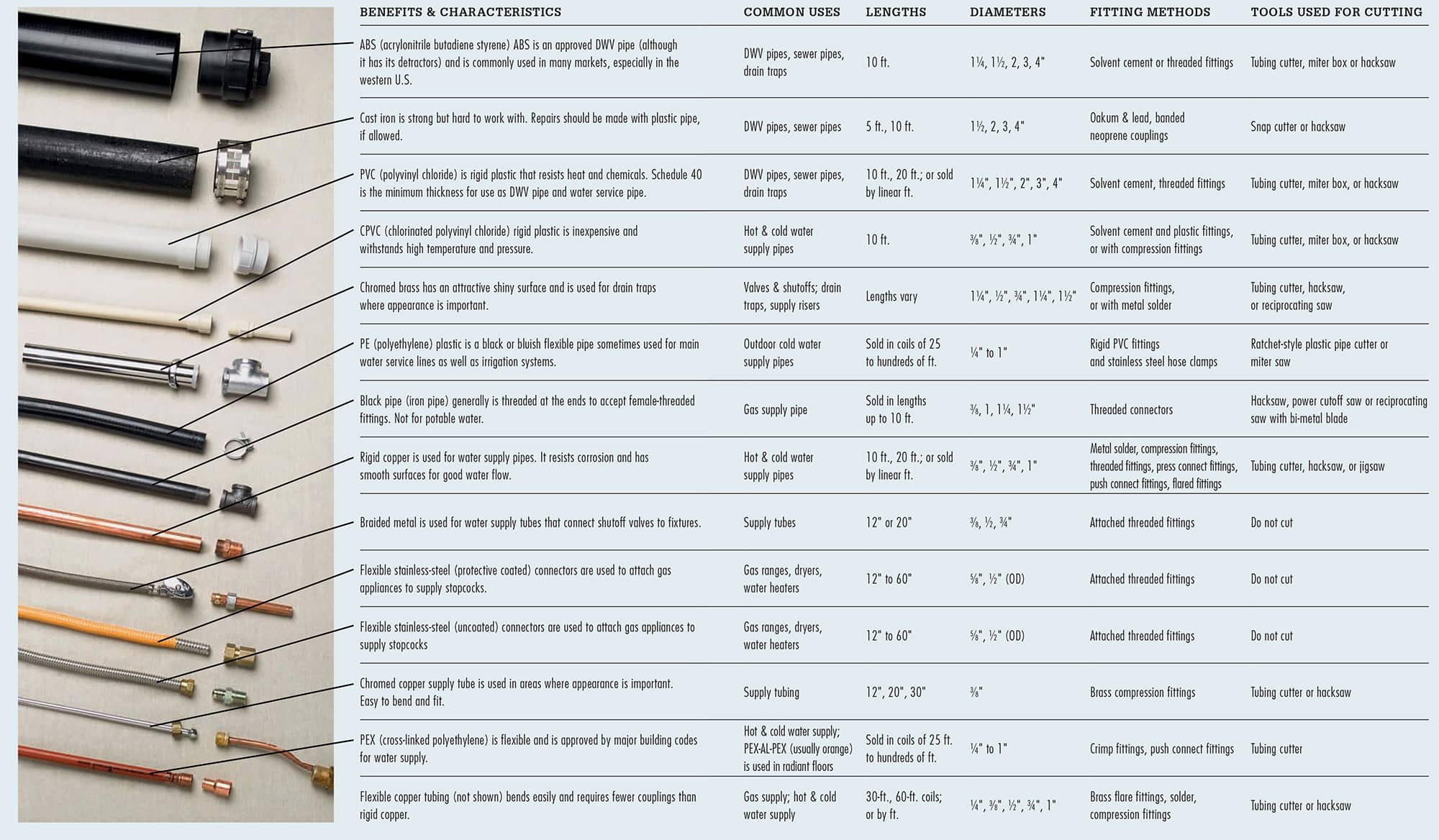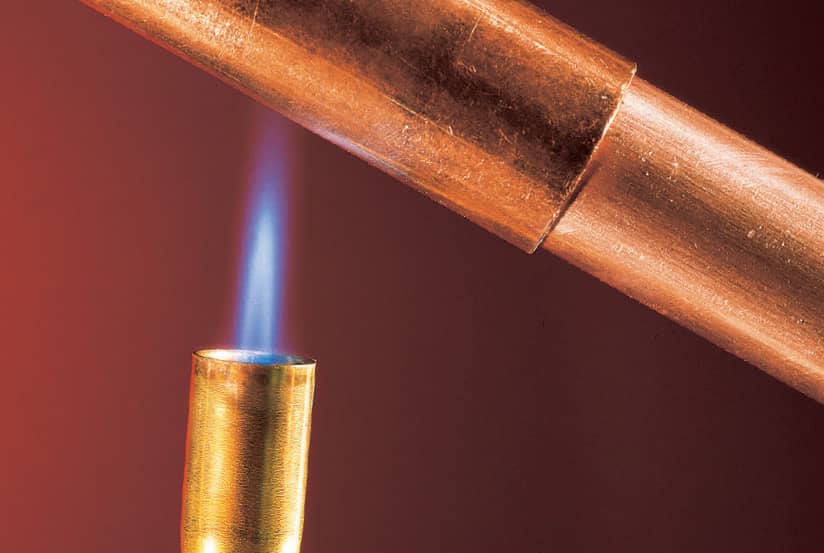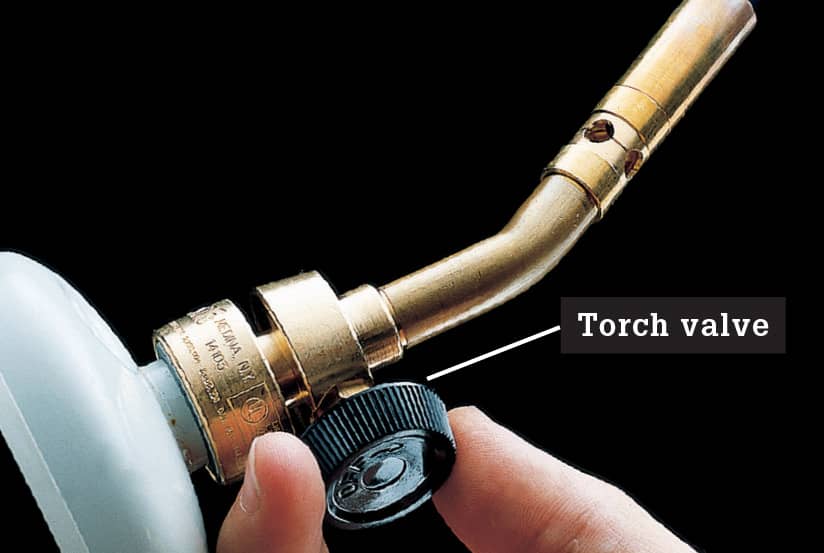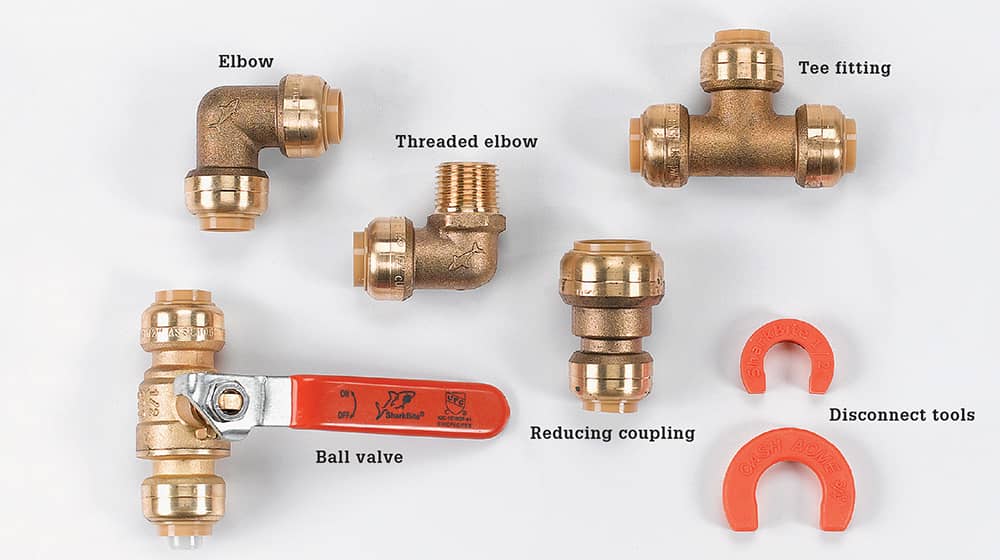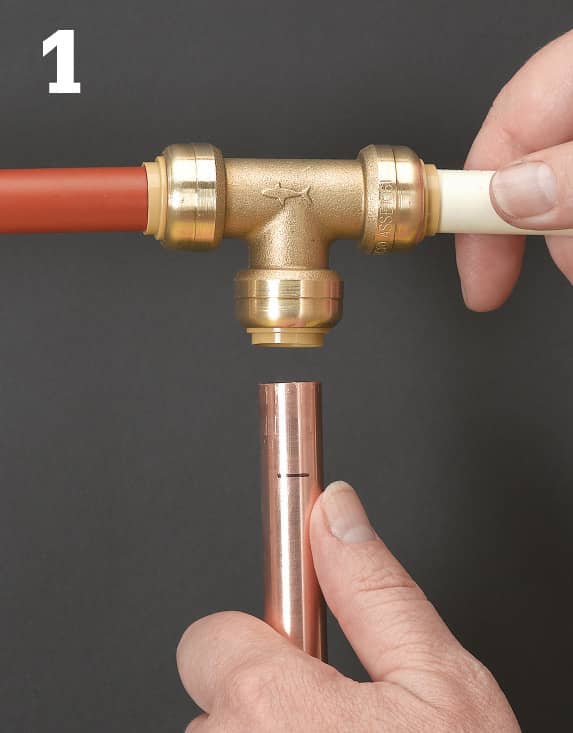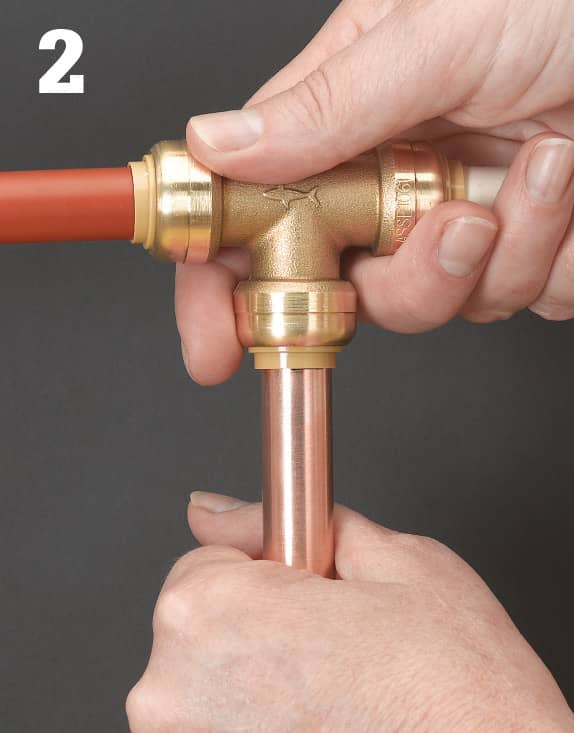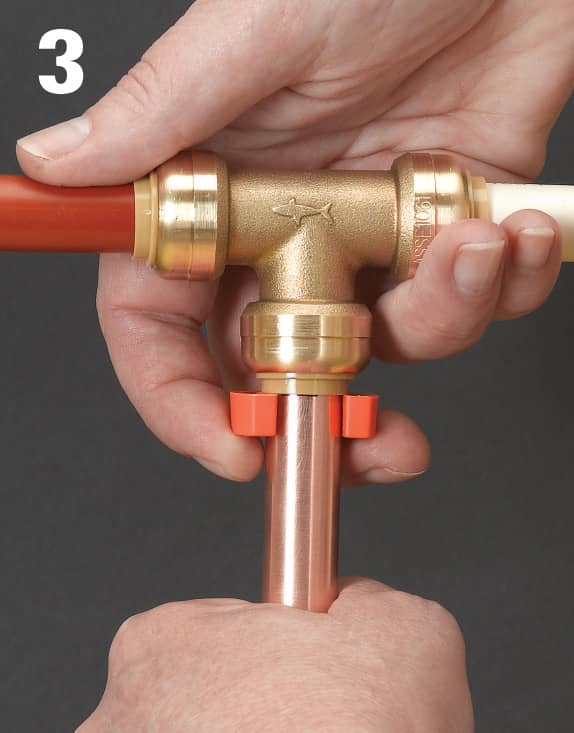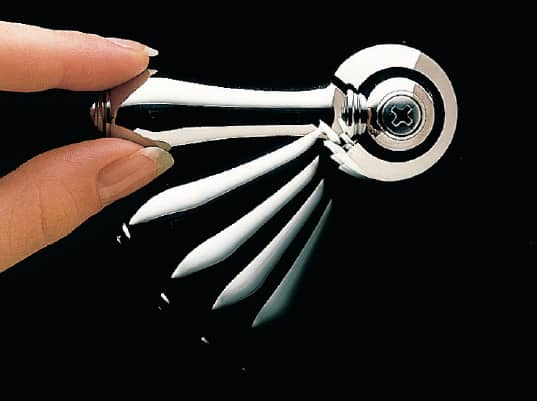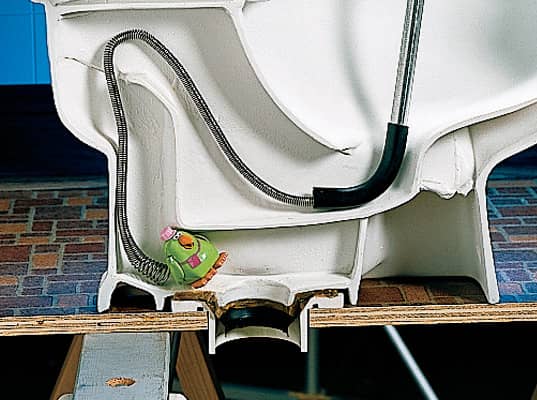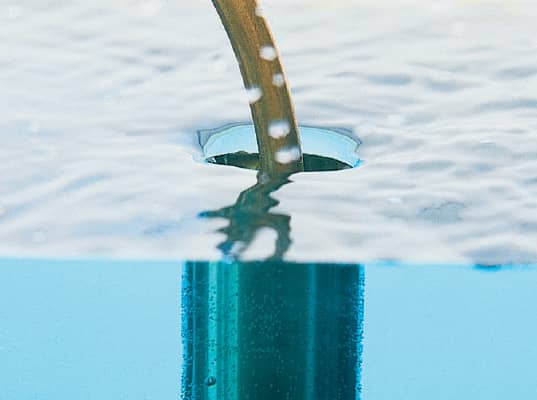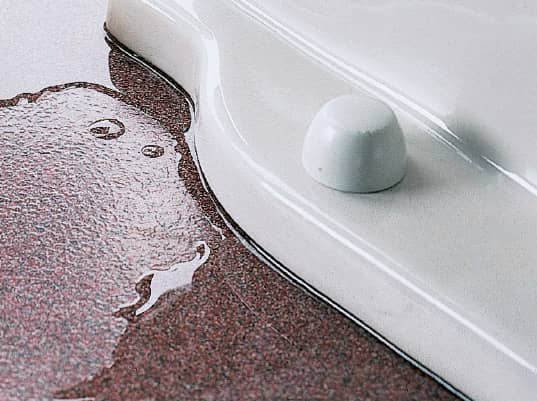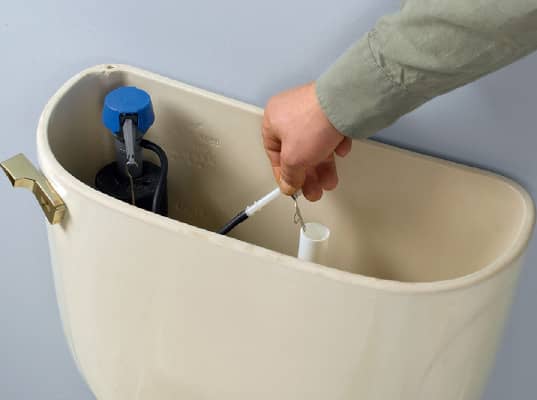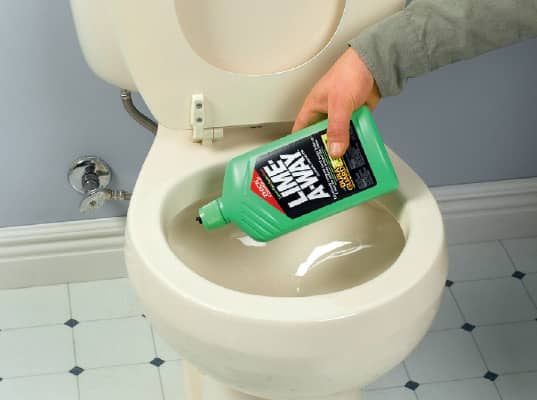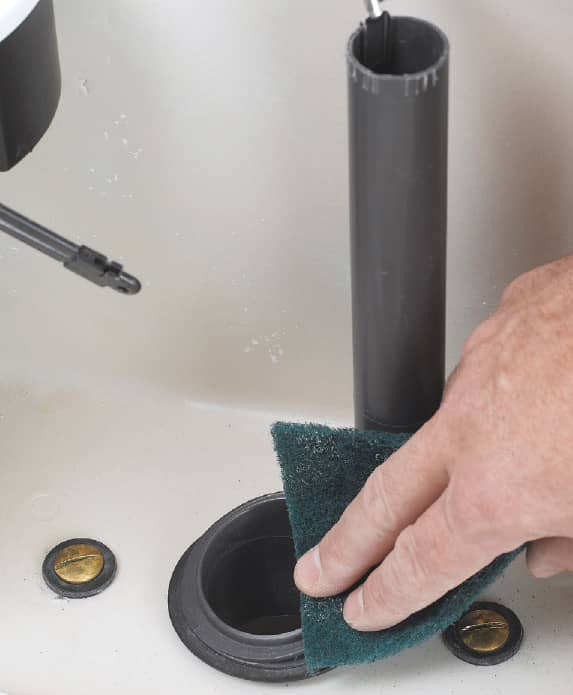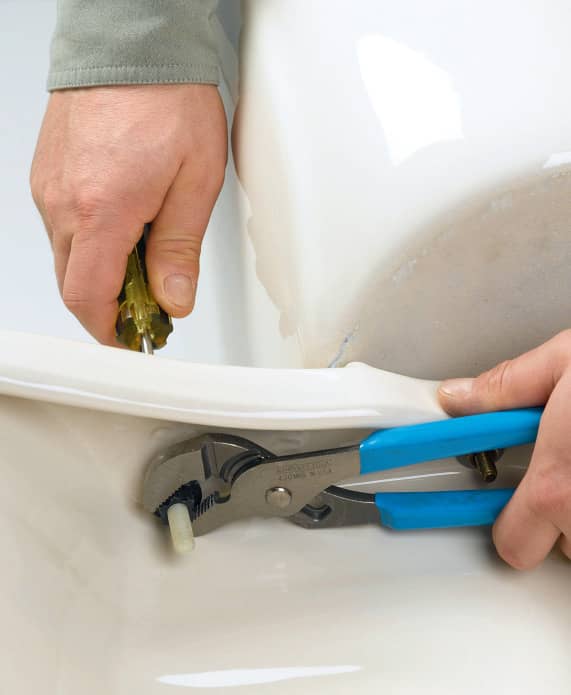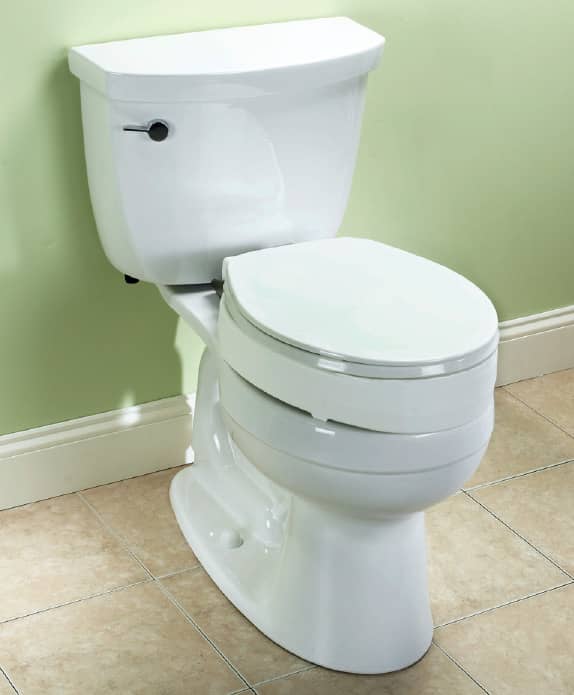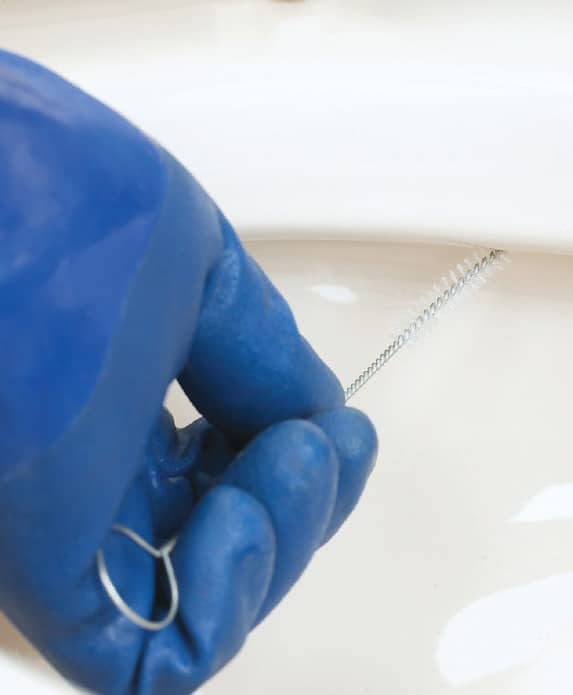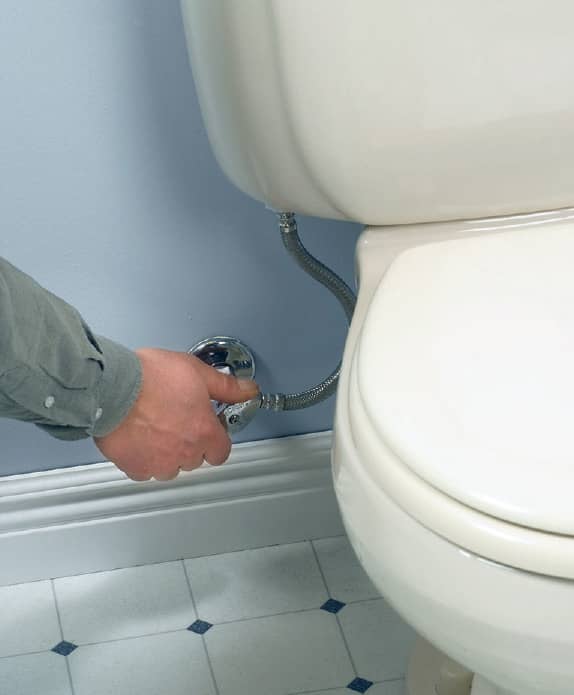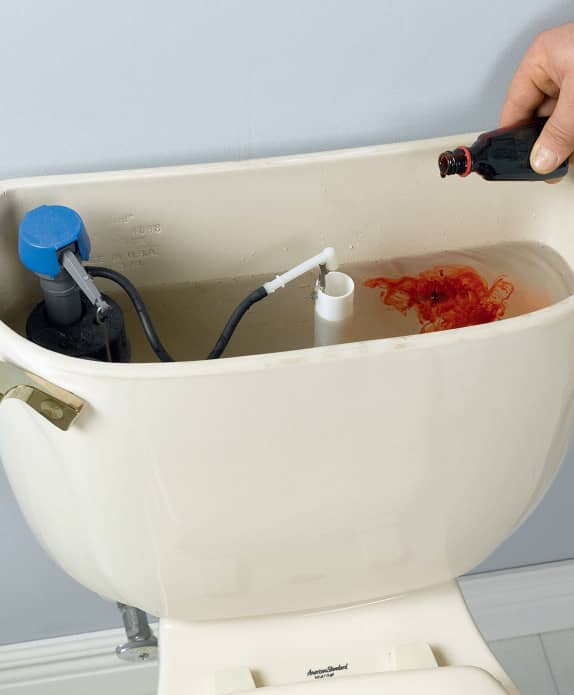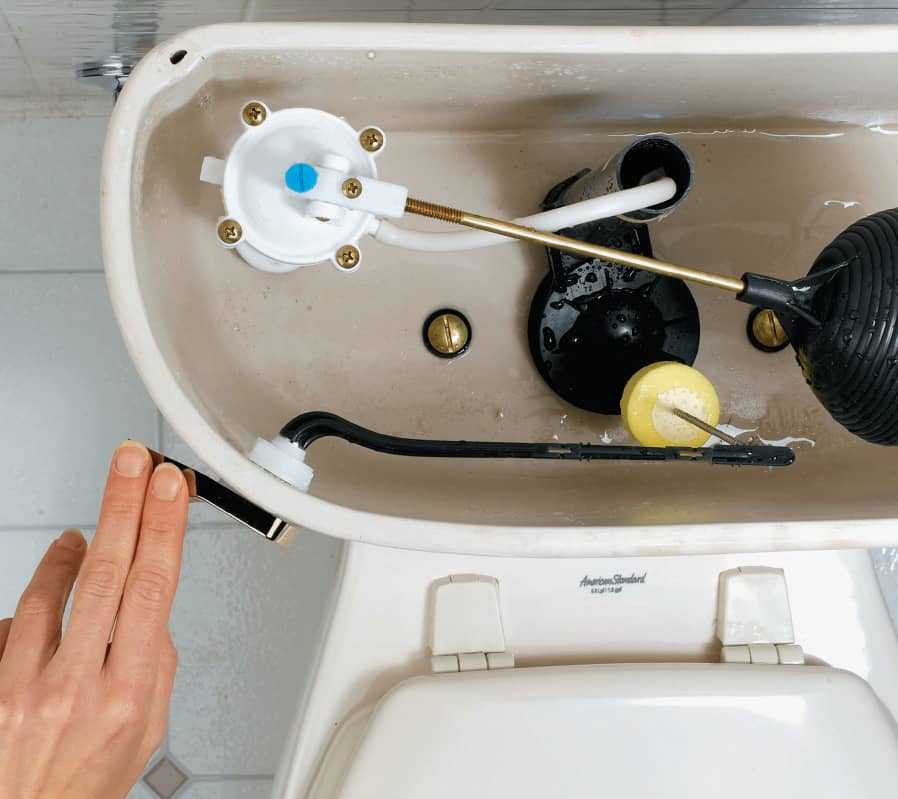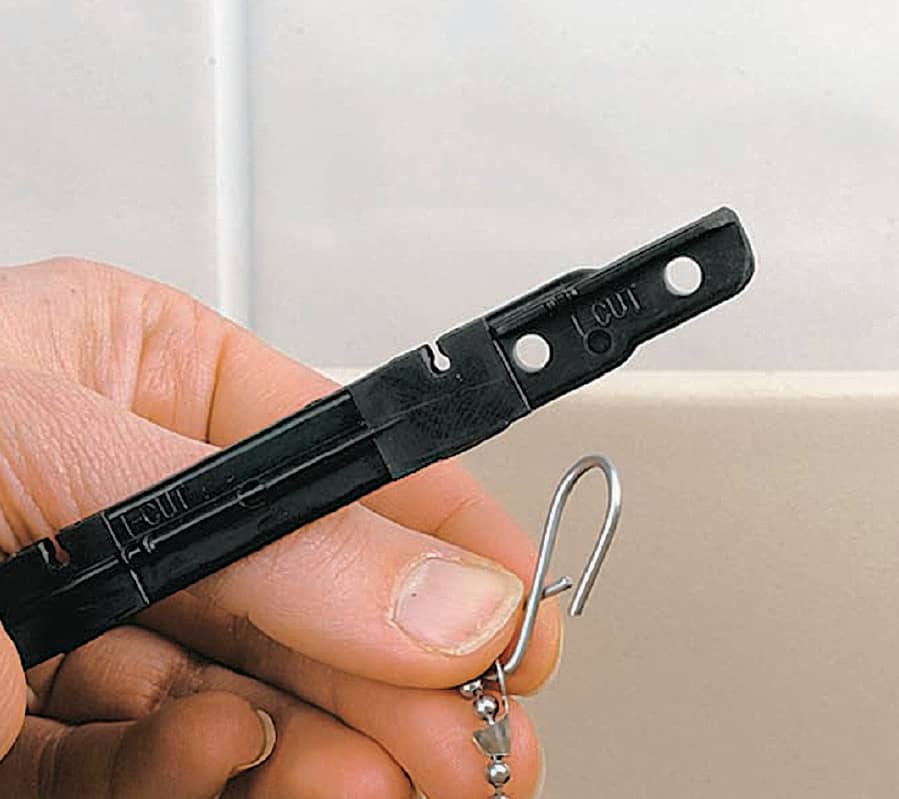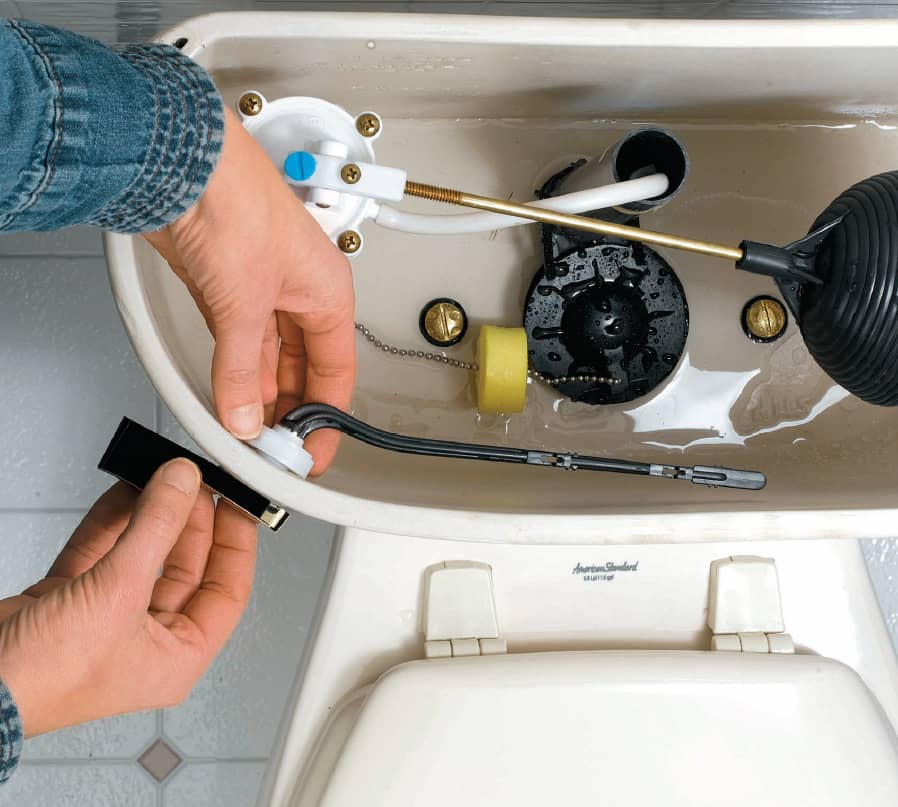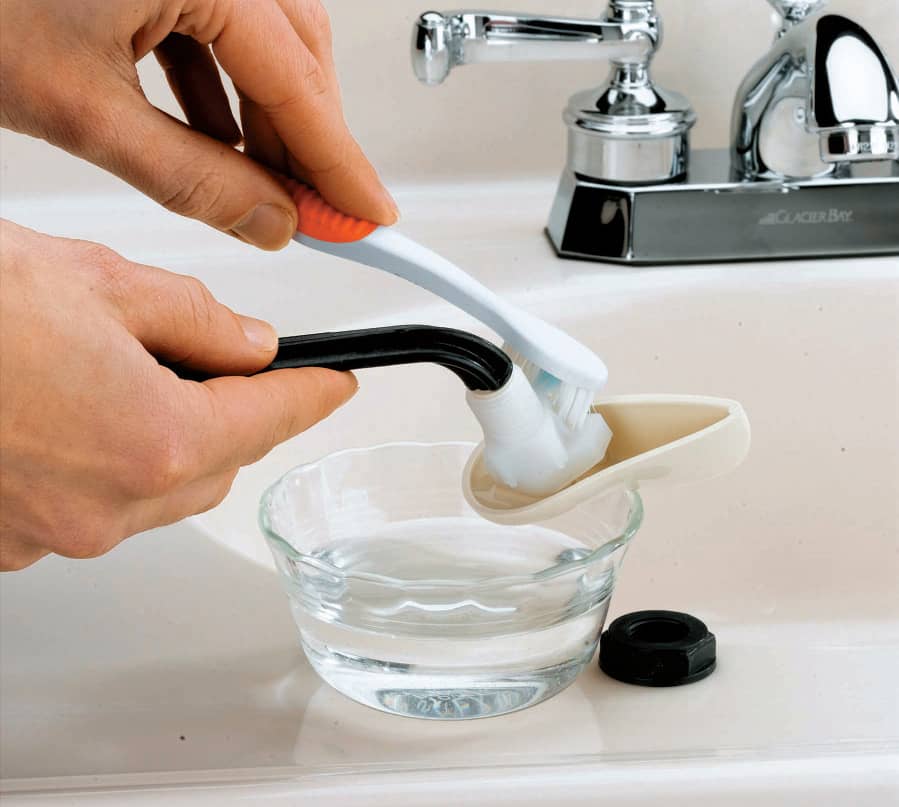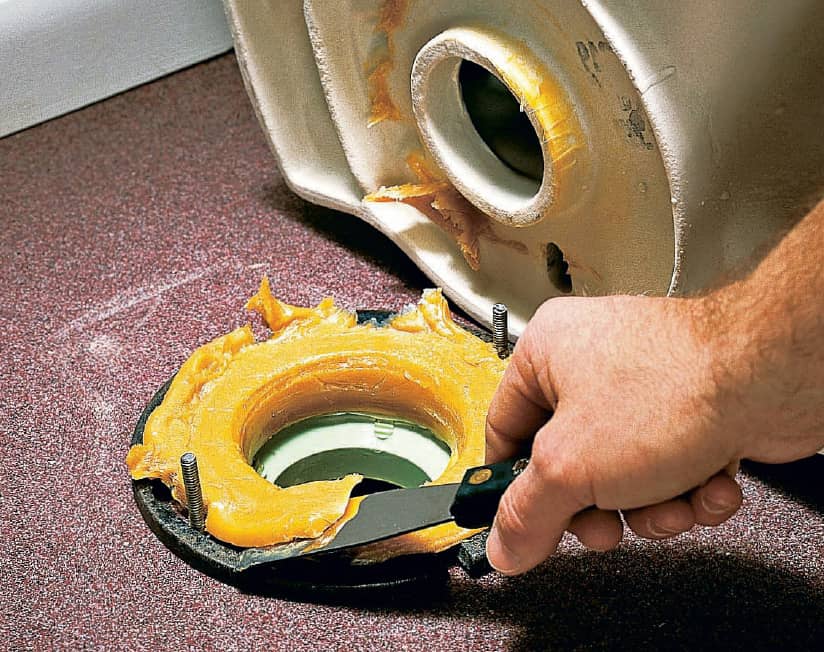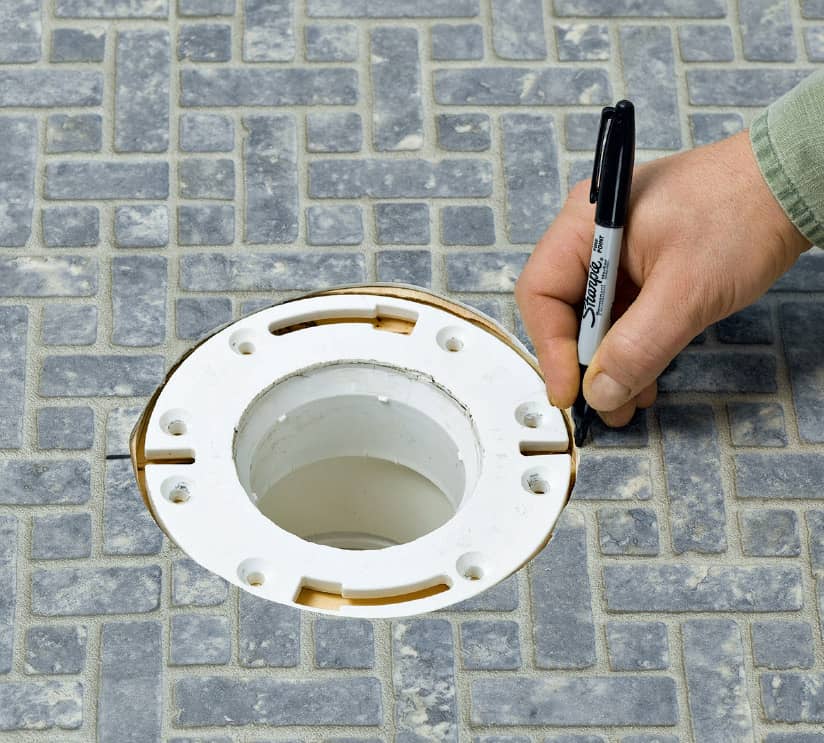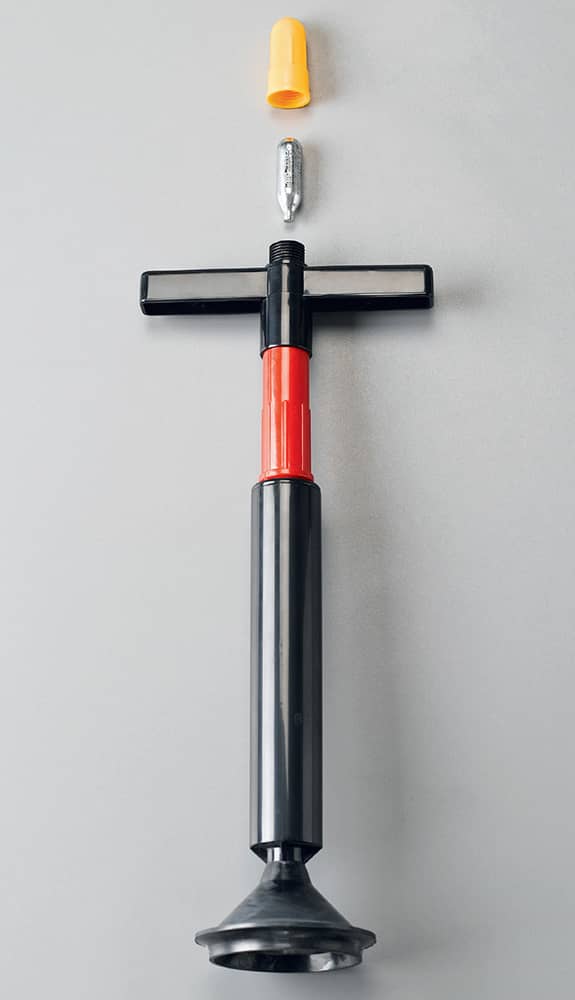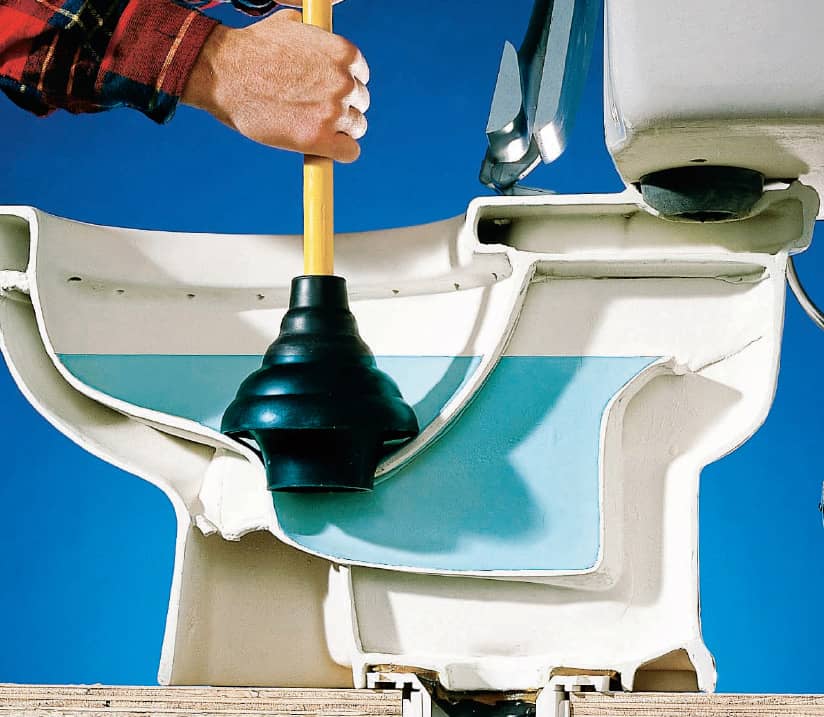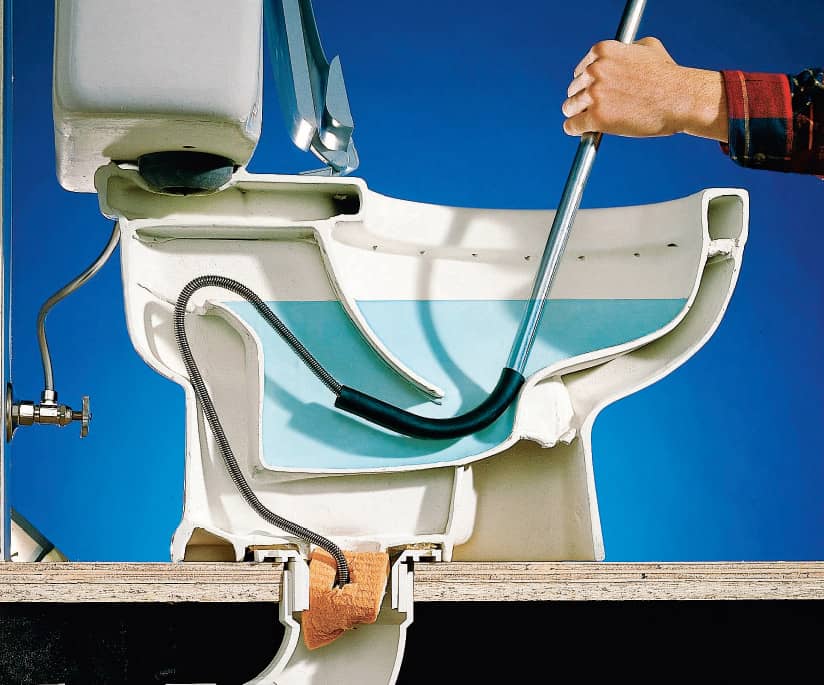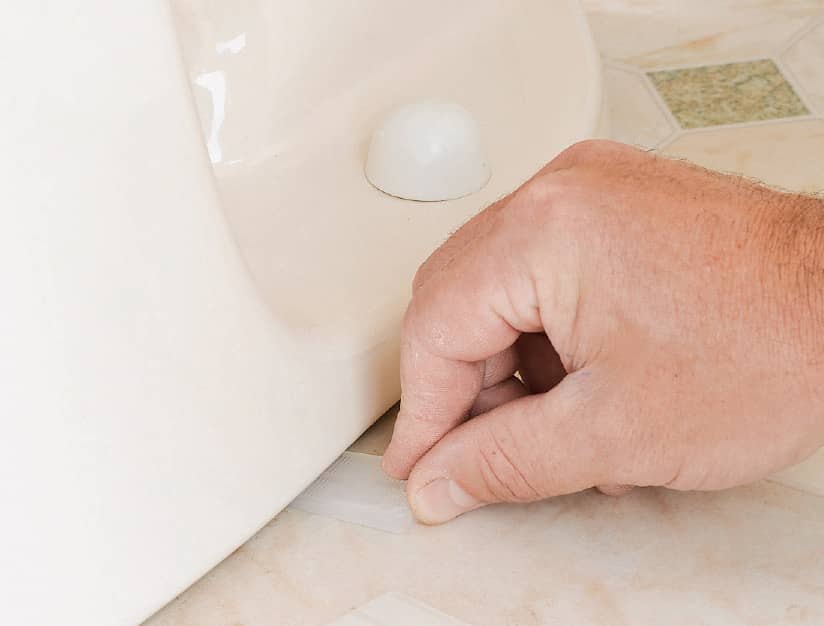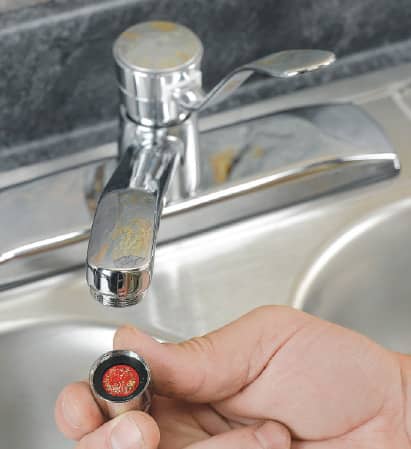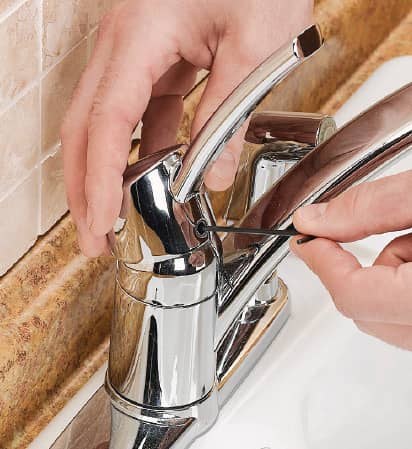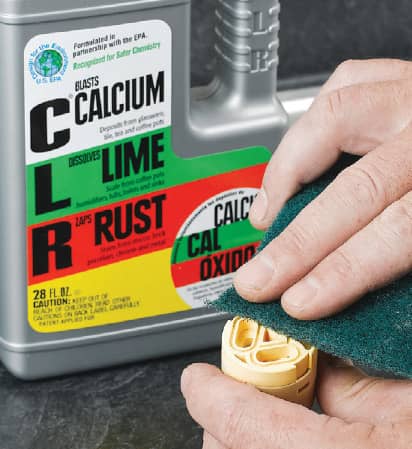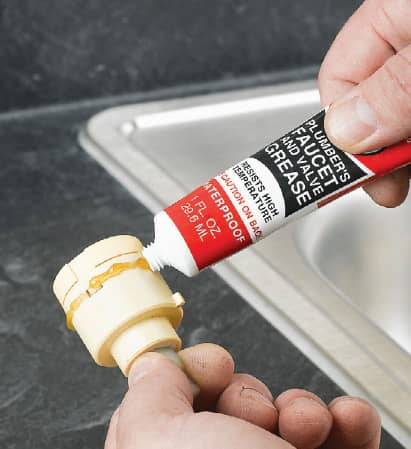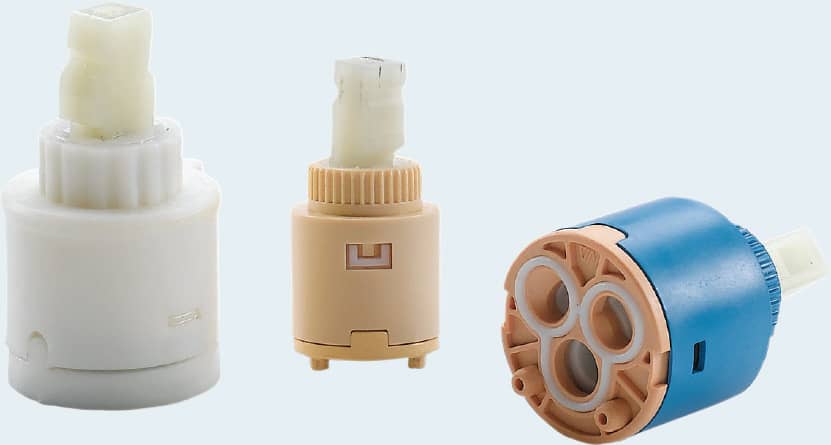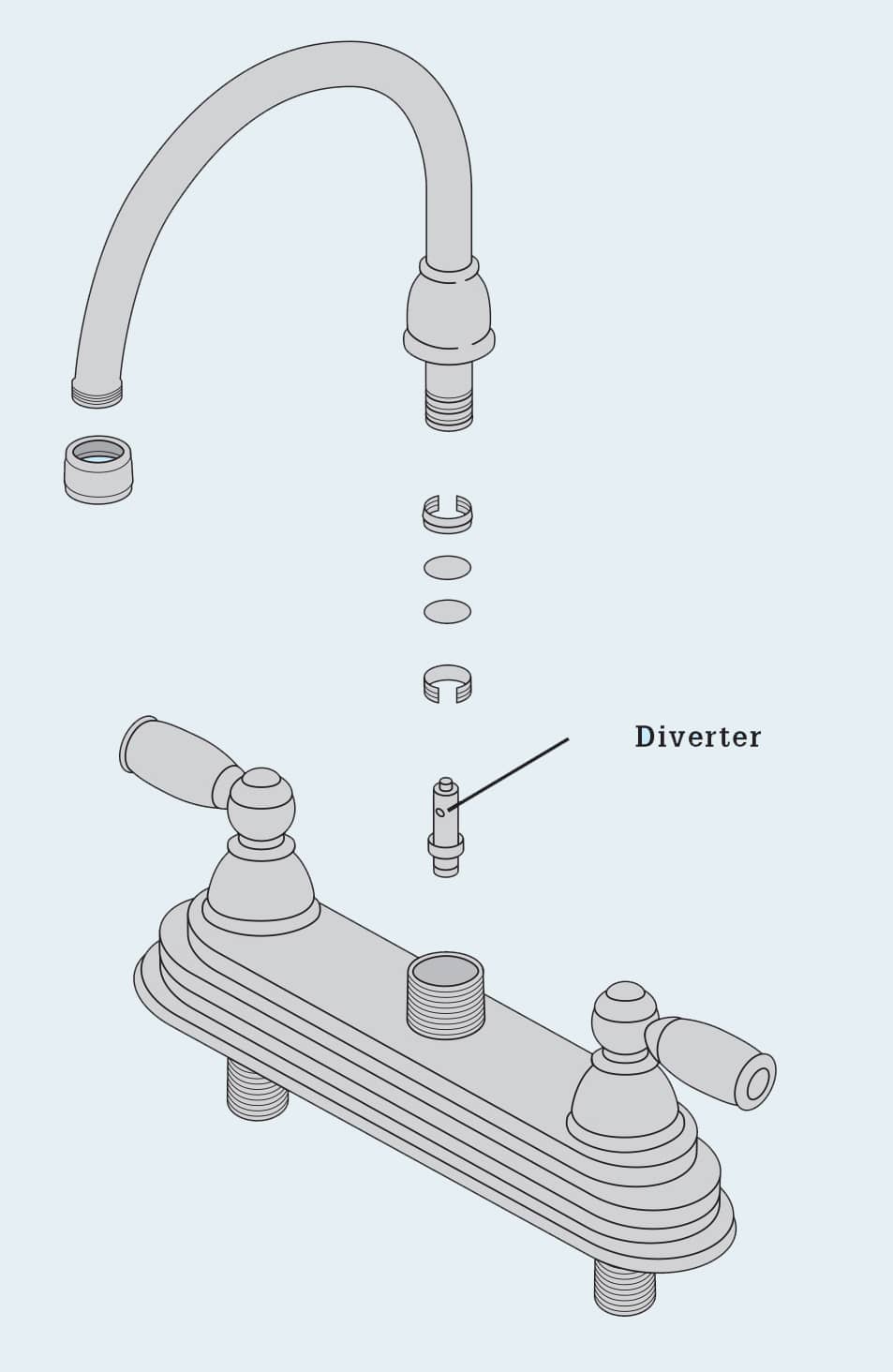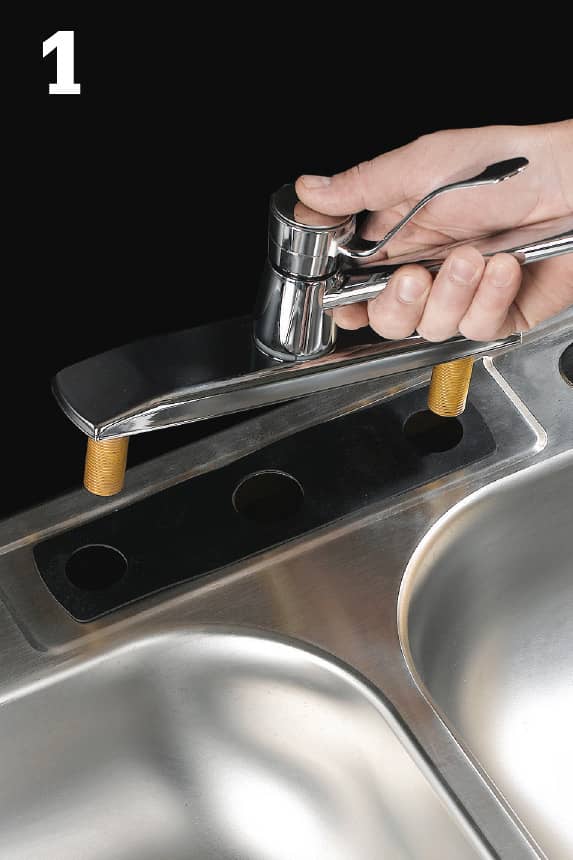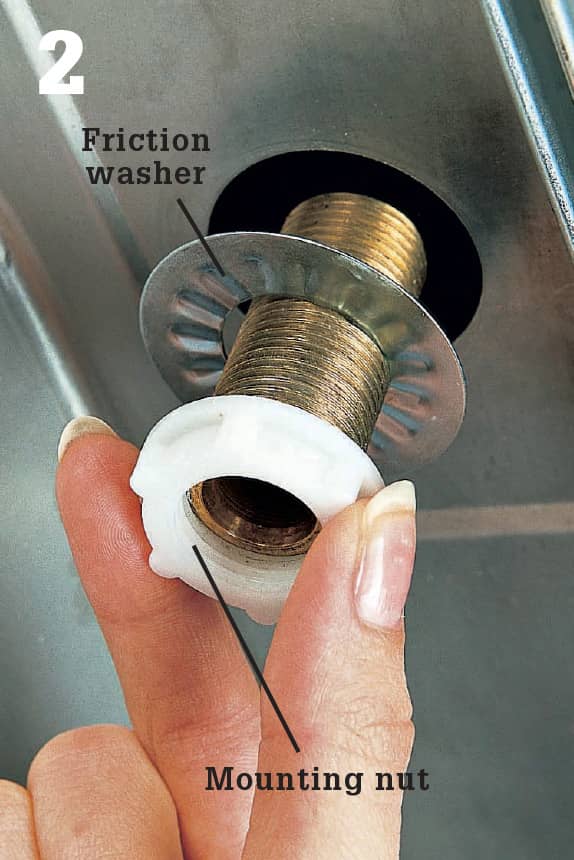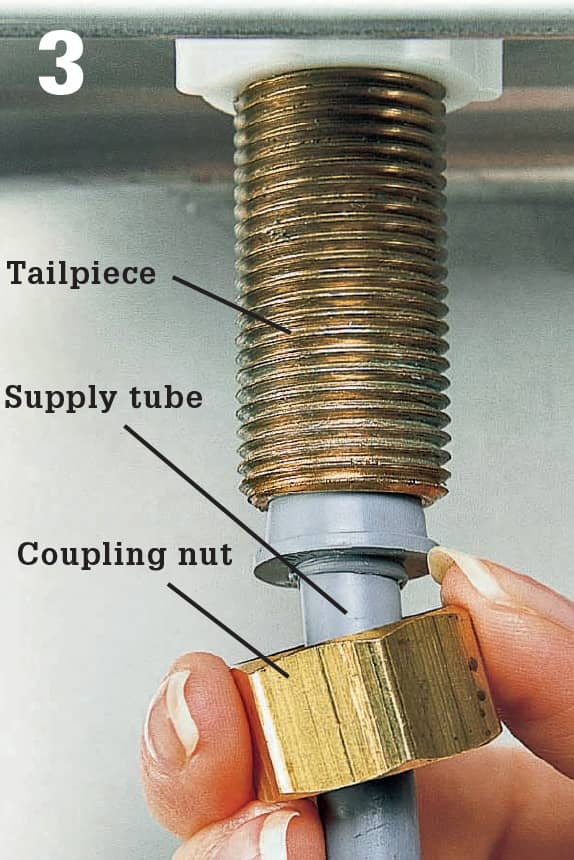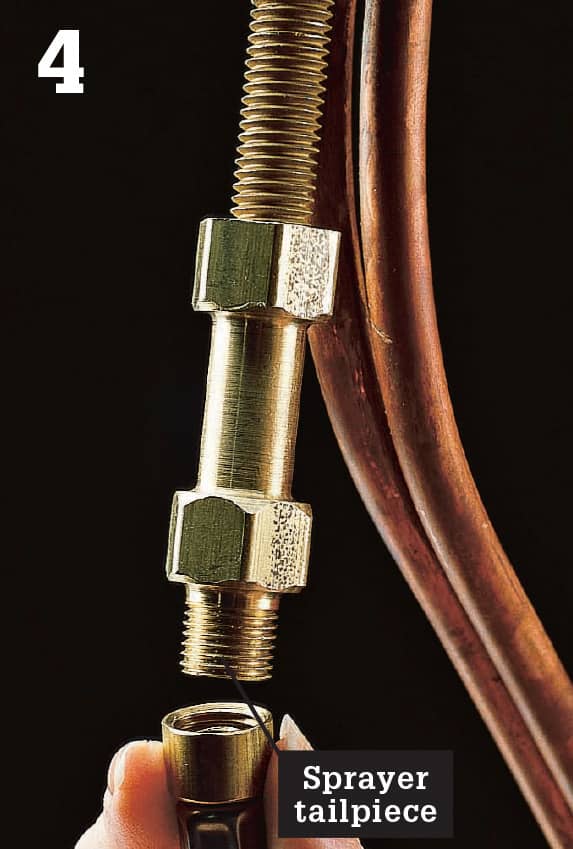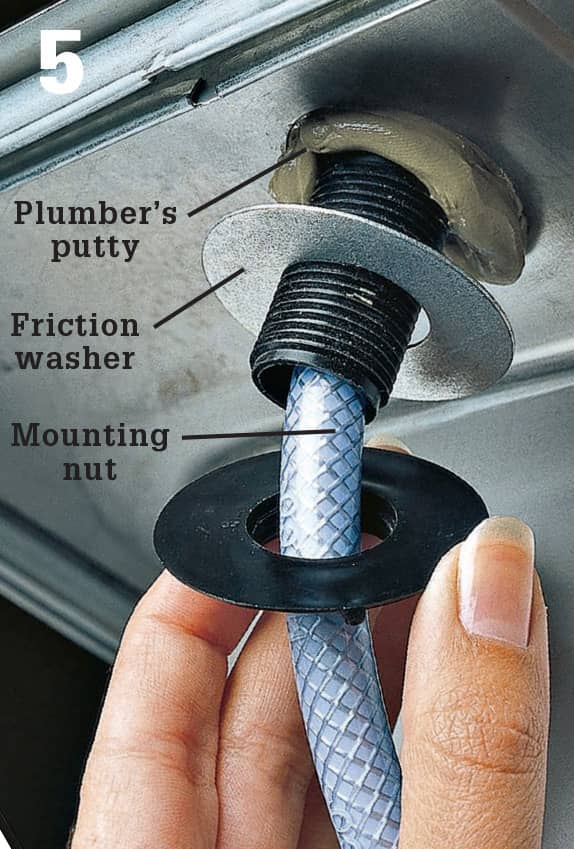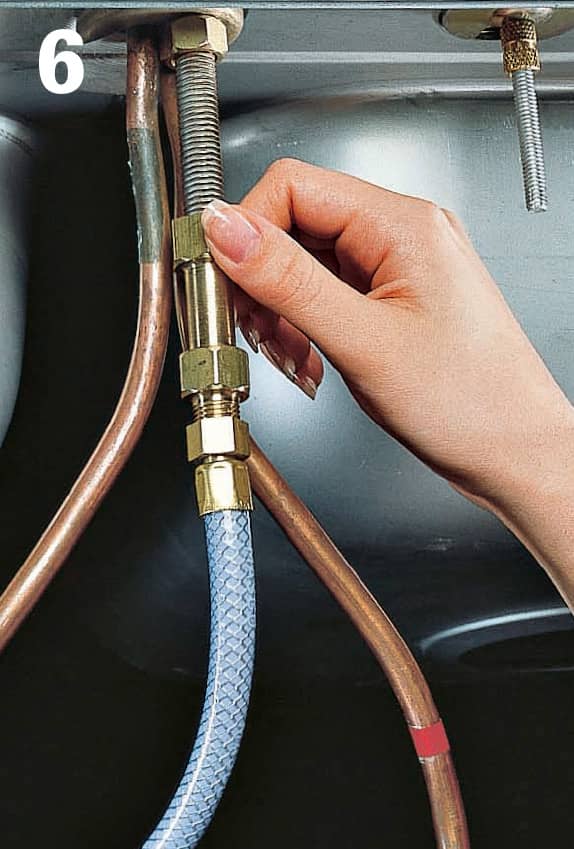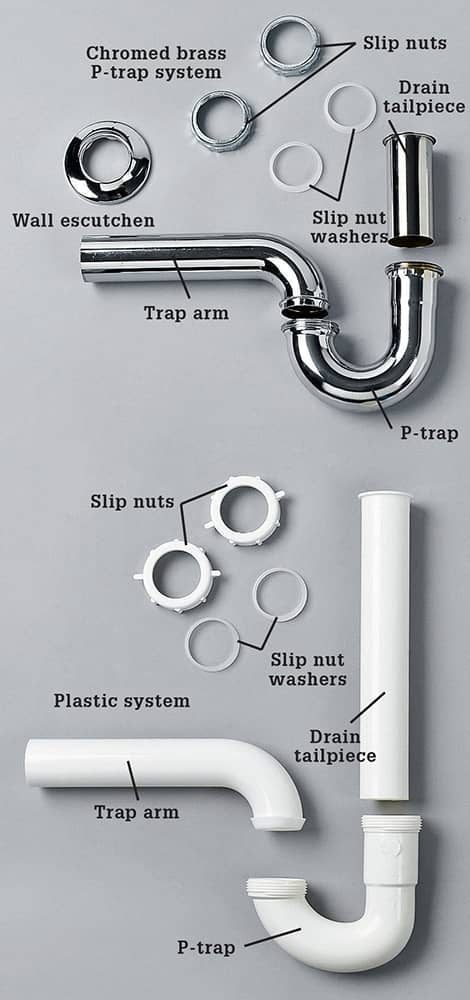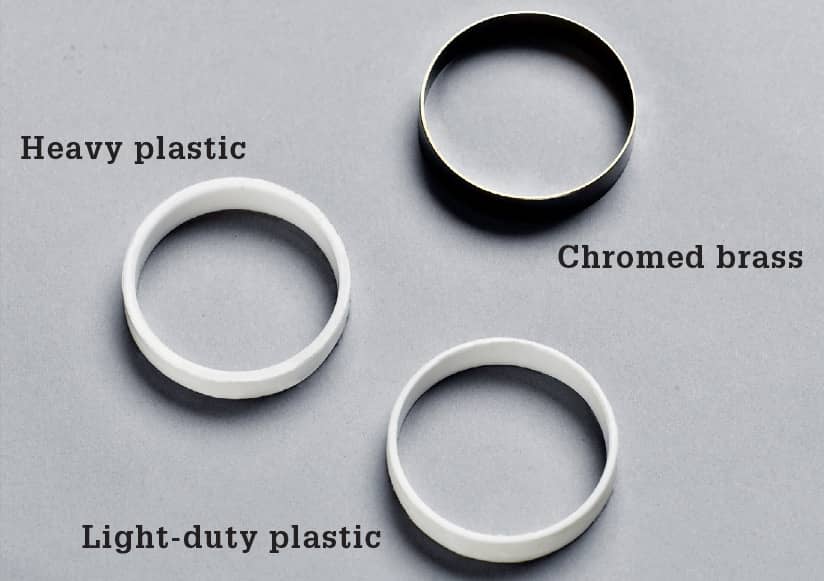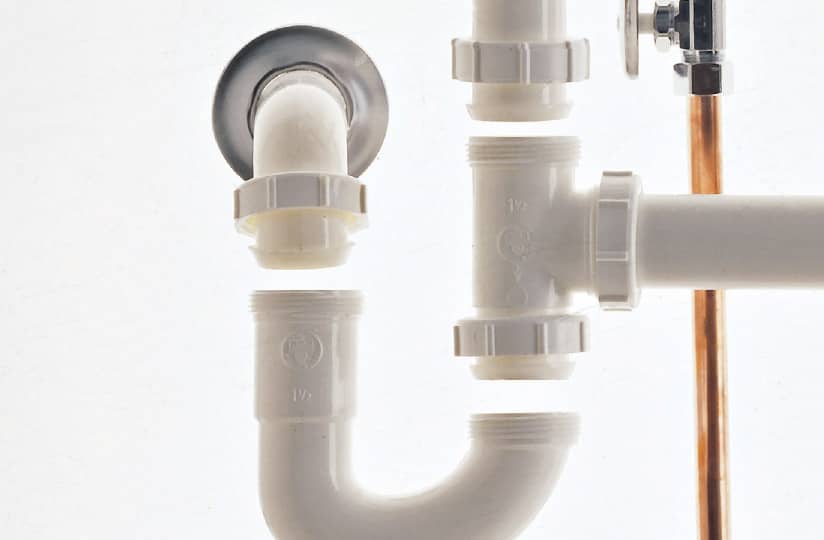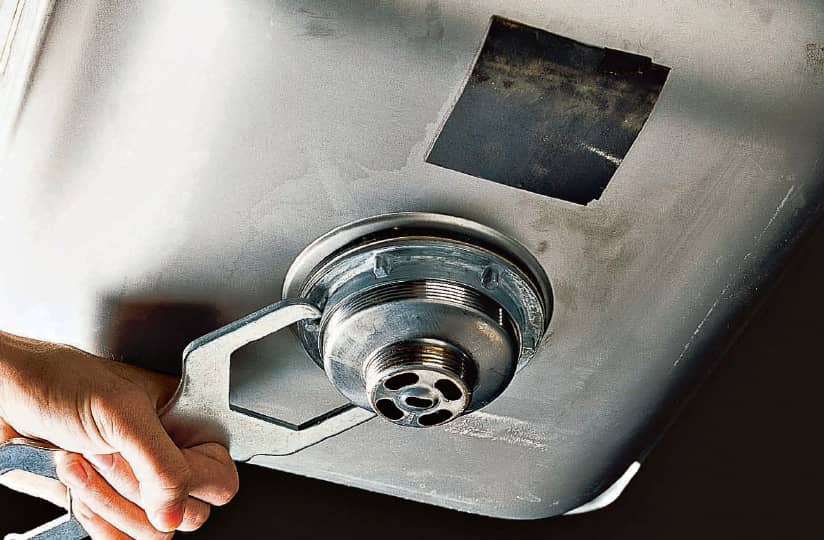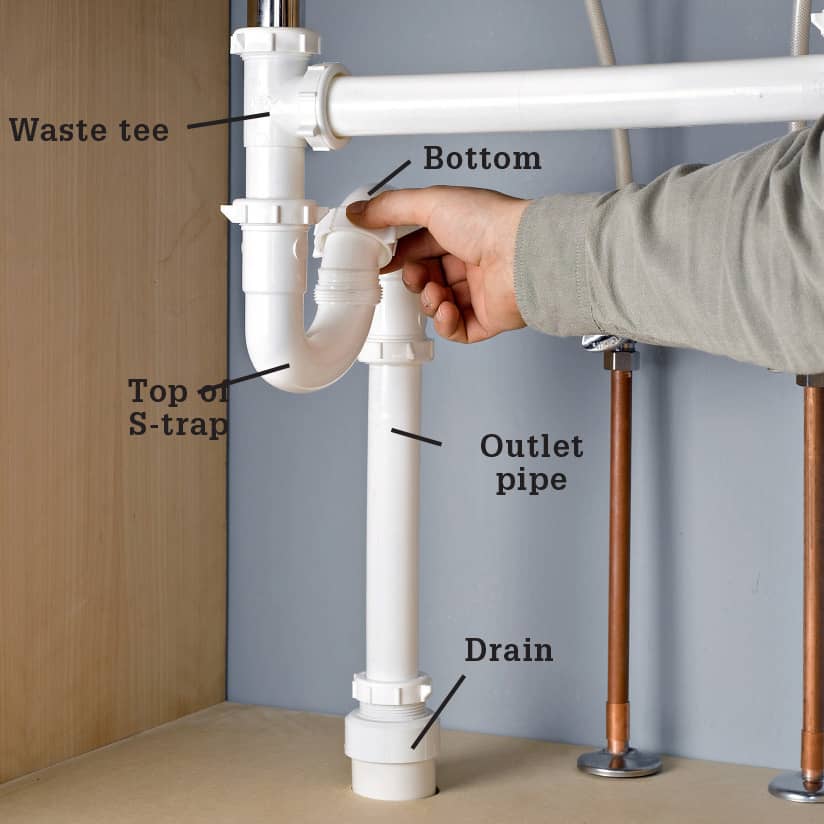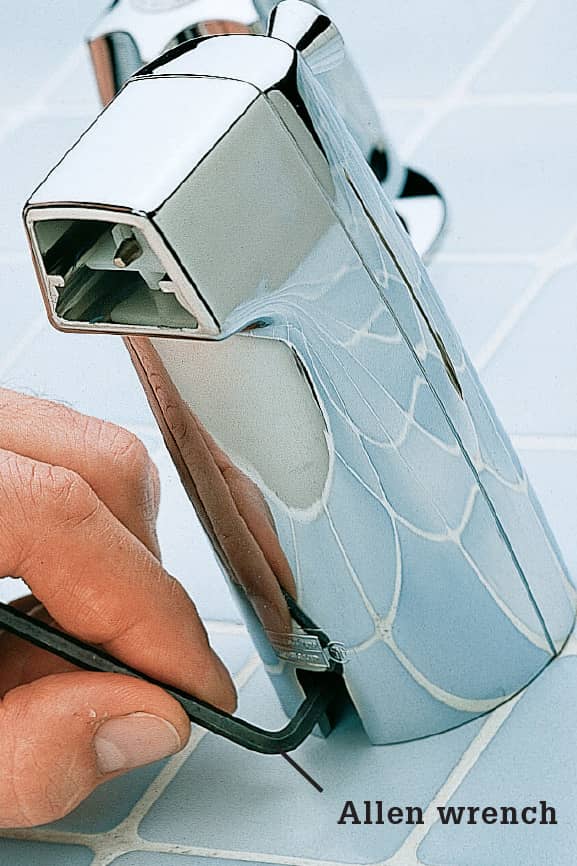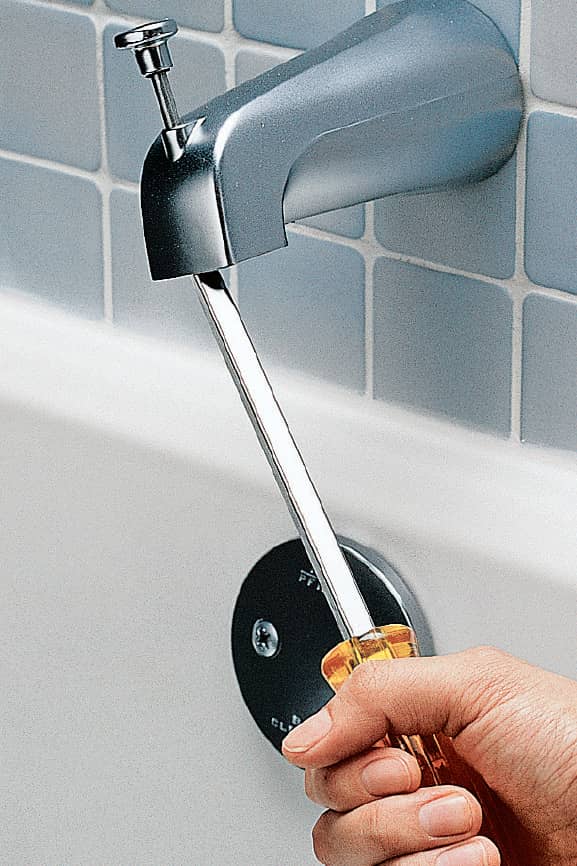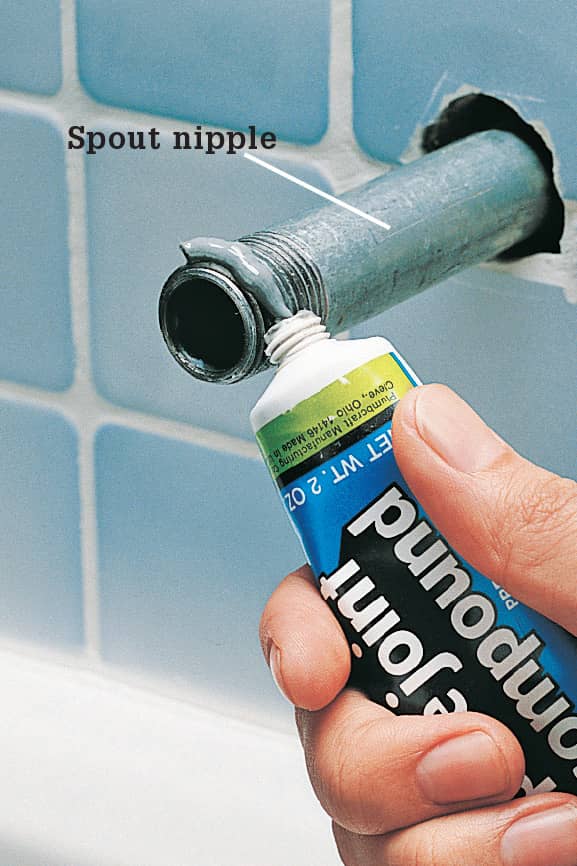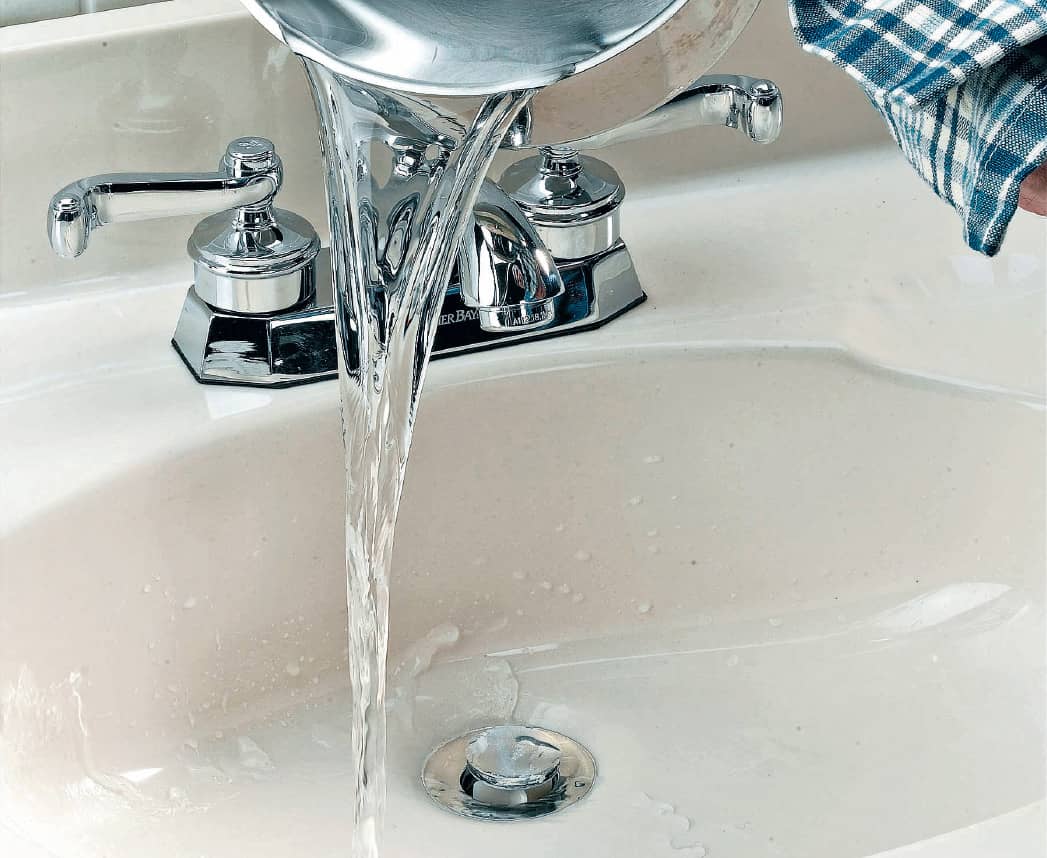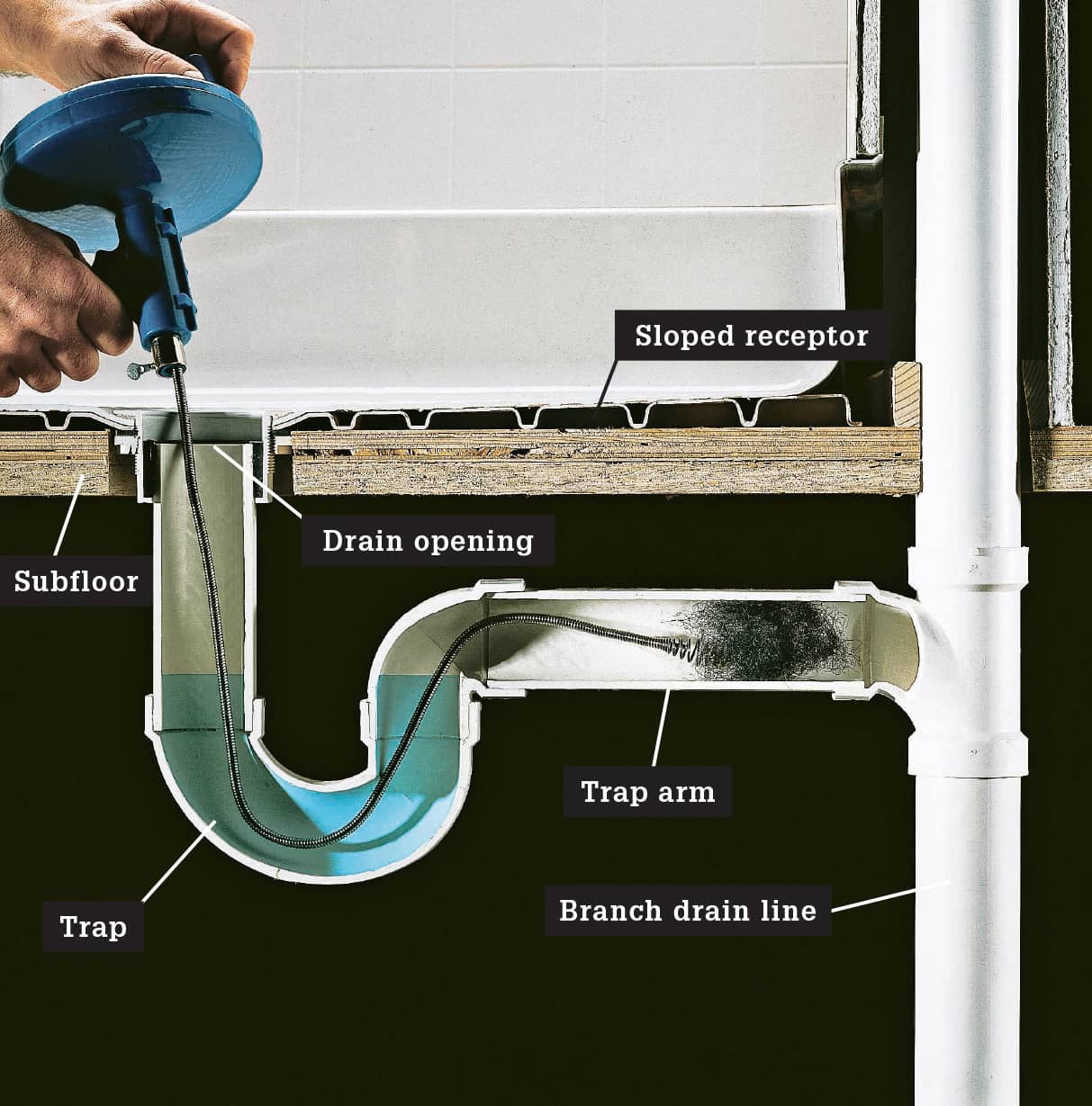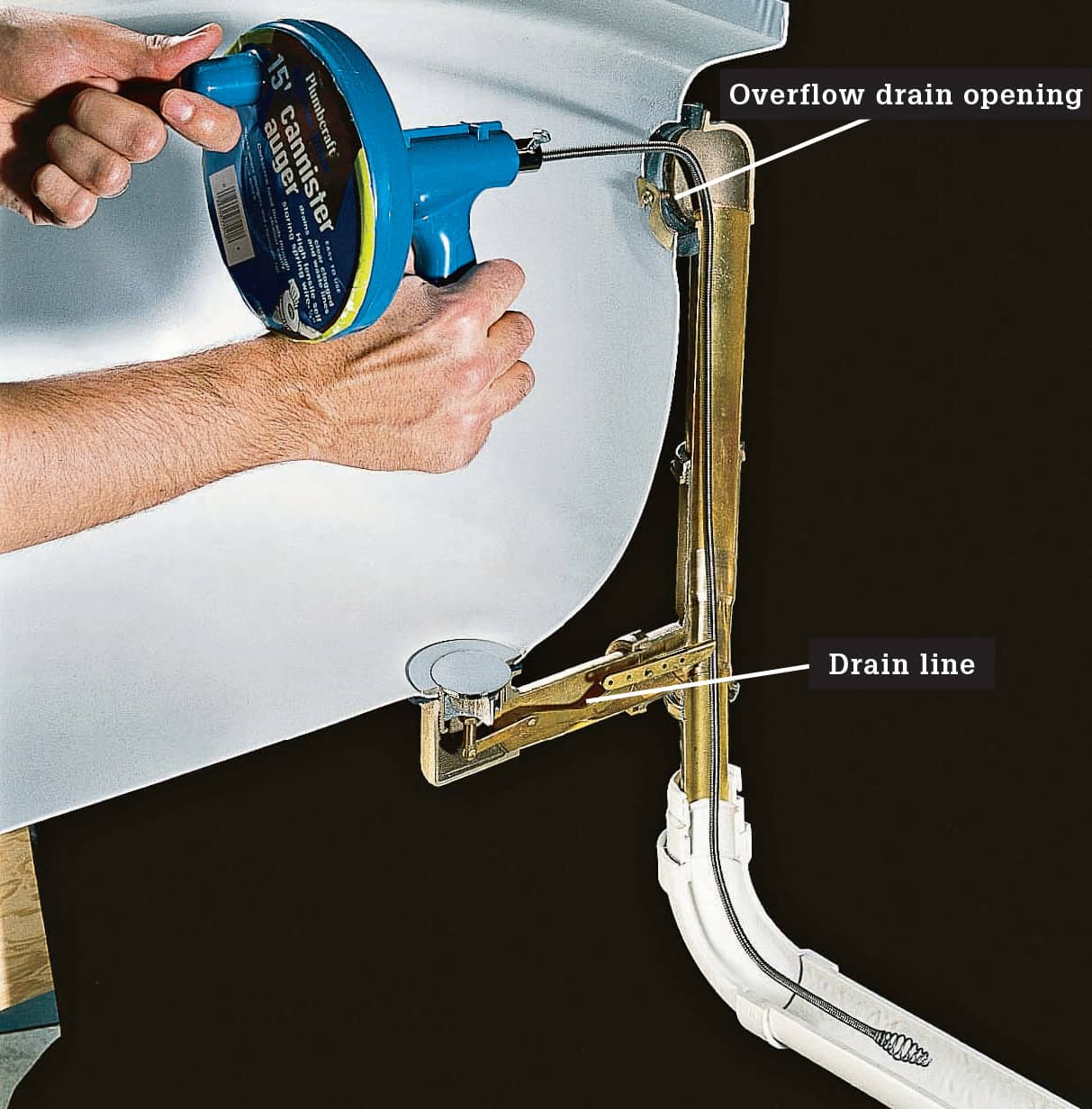
Plumbing
In this chapter:
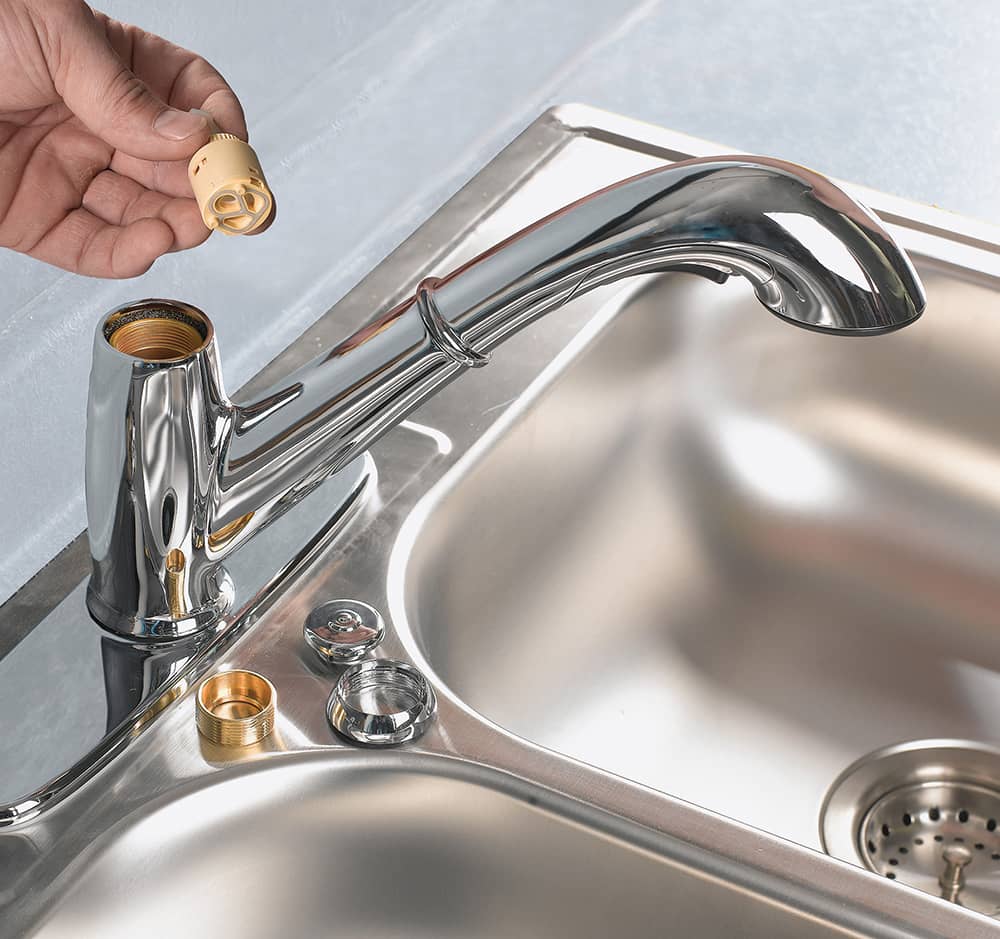
• Fixing Common Toilet Problems
• Replacing Kitchen Sink Sprayers
• Fixing Kitchen Drains & Traps
• Fixing Tub/Shower Faucets & Showerheads
• Unclogging Branch & Main Drains
• Tips for Replacing Supply Pipes
 The Home Plumbing System
The Home Plumbing System
Because most of a plumbing system is hidden inside walls and floors, it may seem to be a complex maze of pipes and fittings. But spend a few minutes with us and you’ll gain a basic understanding of your system. Understanding how home plumbing works is an important first step toward doing routine maintenance and money-saving repairs.
A typical home plumbing system includes three basic parts: a water supply system, a fixture and appliance set, and a drain system. These three parts can be seen clearly in the photograph of the cut-away house on the opposite page.
Fresh water enters a home through a main supply line (1). This fresh water source is provided by either a municipal water company or a private underground well. If the source is a municipal supplier, the water passes through a meter (2) that registers the amount of water used. A family of four uses about 400 gallons of water each day.
Immediately after the main supply enters the house, a branch line splits off (3) and is joined to a water heater (4). From the water heater, a hot water line runs parallel to the cold water line to bring the water supply to fixtures and appliances throughout the house. Fixtures include sinks, bathtubs, showers, and laundry tubs. Appliances include water heaters, dishwashers, clothes washers, and water softeners. Toilets and exterior sillcocks are examples of fixtures that require only a cold water line.
The water supply to fixtures and appliances is controlled with faucets and valves. Faucets and valves have moving parts and seals that eventually may wear out or break, but they are easily repaired or replaced.
Waste water then enters the drain system. It first must flow past a drain trap (5), a U-shaped piece of pipe that holds standing water and prevents sewer gases from entering the home. Every fixture must have a drain trap.
The drain system works entirely by gravity, allowing waste water to flow downhill through a series of large-diameter pipes. These drain pipes are attached to a system of vent pipes. Vent pipes (6) bring air into the drain system to prevent suction or pressure that might allow the trap to lose its water seal. Vent pipes usually exit the house at a roof vent (7).
All waste water eventually reaches a drainage stack or a building drain (8).
NOTE: In a two or more story house there is usually more than one drainage stack. There is no stack in a one-story house. The stack or building drain becomes a sewer line (9) that exits the house near the foundation. In a municipal system, this sewer line joins a main sewer line located near the street. Where sewer service is not available, waste water empties into a septic system.
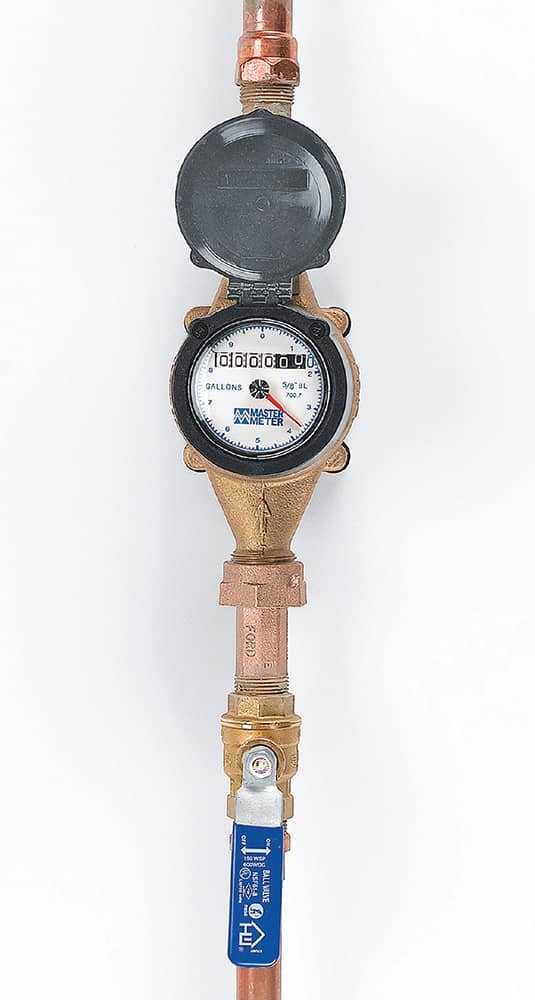
Water meters and main shutoff valves are located where the main water supply pipe enters the house. The water meter is the property of your local municipal water company. If the water meter leaks, or if you suspect it is not functioning properly, call your water company for repairs.
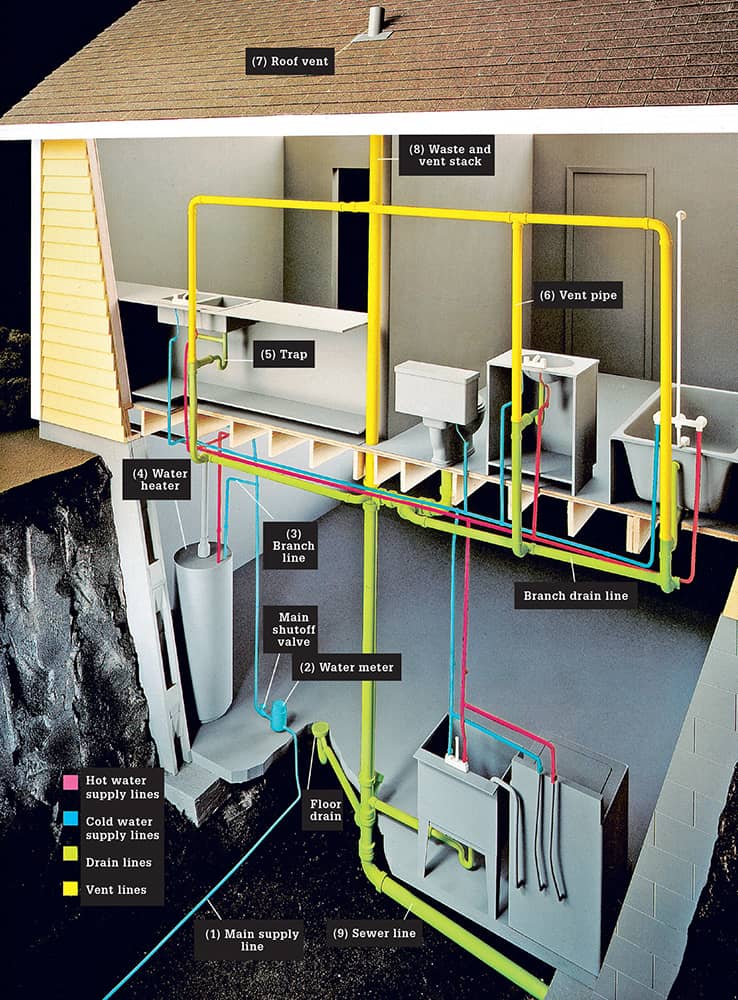
 Shutting Off the Water
Shutting Off the Water
In case an emergency requires you to replace or repair a faucet, fixture, or appliance, knowing how to shut off the water is imperative. The photos on this page show the most common types of shutoffs. If you don’t feel completely confident about finding your home’s shutoff points or how to turn them off, contact your local water company for information.
There are two basic types of valves, which shut off in two different ways. To turn off many older valves, rotate the handle clockwise (remember “lefty loosey; righty tighty”) until it stops. To turn off many newer valves, rotate the handle one-quarter turn only.
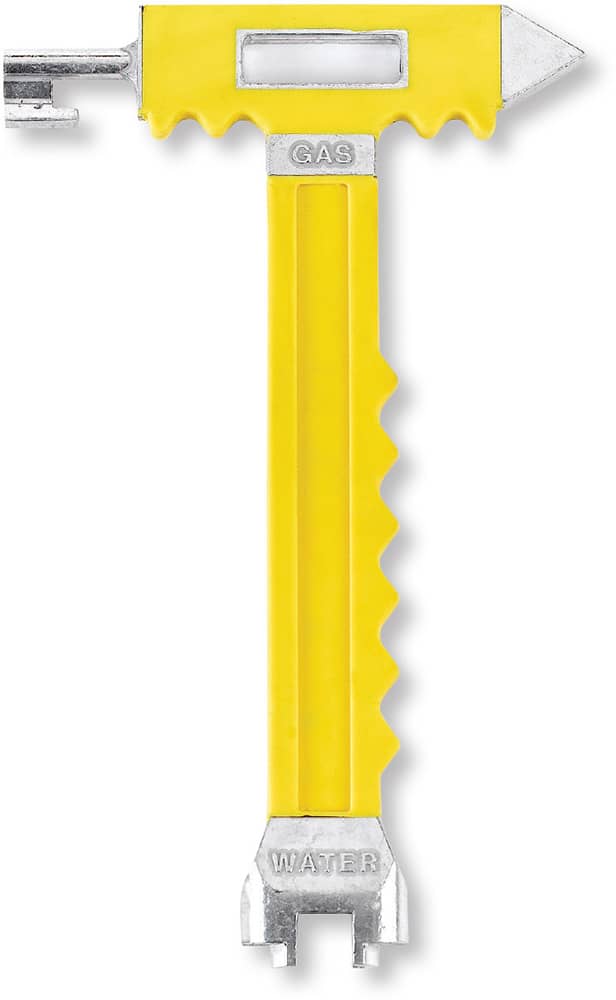
Some outdoor shutoffs require the use of a special tool, often referred to as a “key.” Keep your key within easy reach in case of an emergency. To turn off, slip the key over the valve and rotate one quarter turn, so the handle is at a right angle to the pipe. The outdoor main shutoff shown below is an example of a shutoff that requires a key. If you lack a key, a meter valve can usually be turned with a wrench or channel-type pliers.
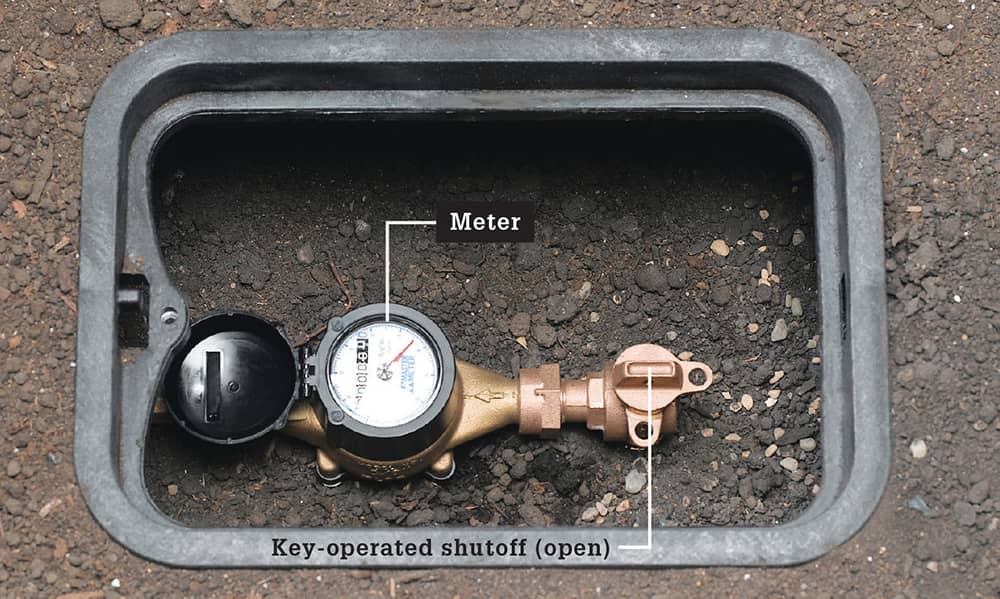
An outdoor main shutoff may be as simple as an exposed valve that you turn by hand. Or it may be buried in a housing that is sometimes called a Buffalo box. In this example, both the meter and the main shutoff are housed in the Buffalo box; in other cases, the meter is located inside the house.
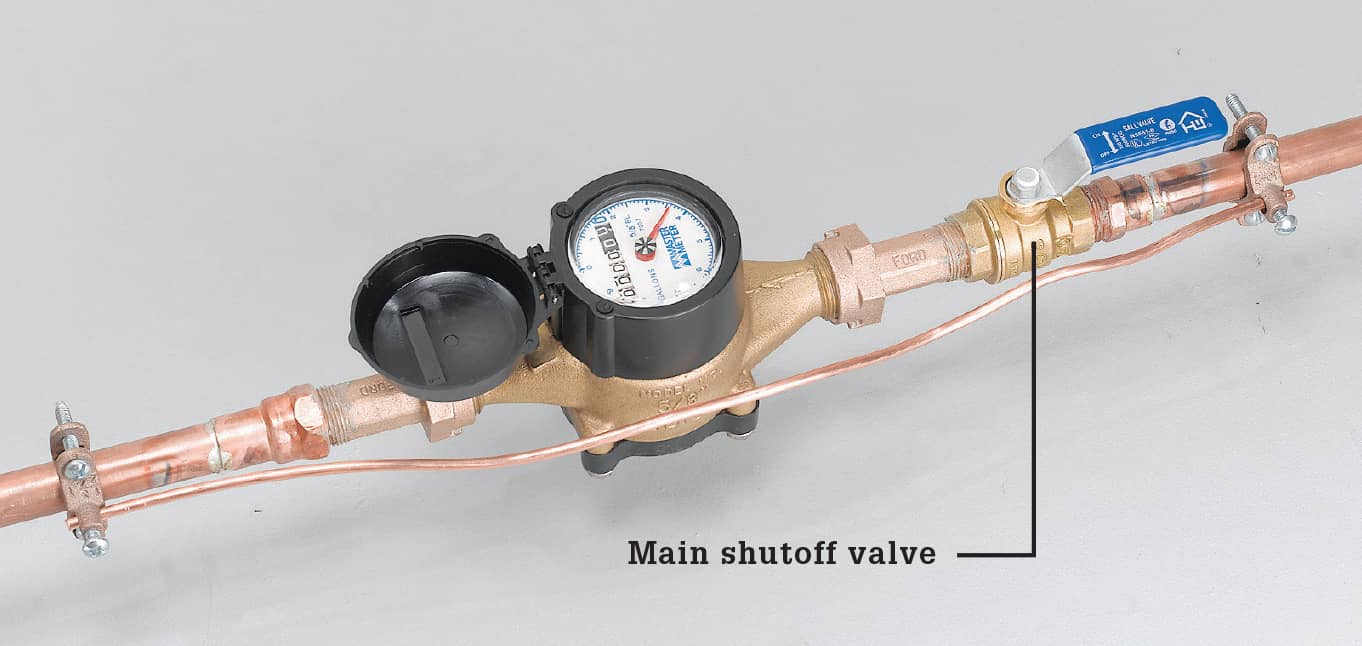
You may have an inside main shutoff, usually located near the point where the main supply pipe enters the house near the water meter. Many homes have both a Buffalo box and an indoor main shutoff. There may be a valve on each side of the meter; turn off either one of them to shut off water to the house.
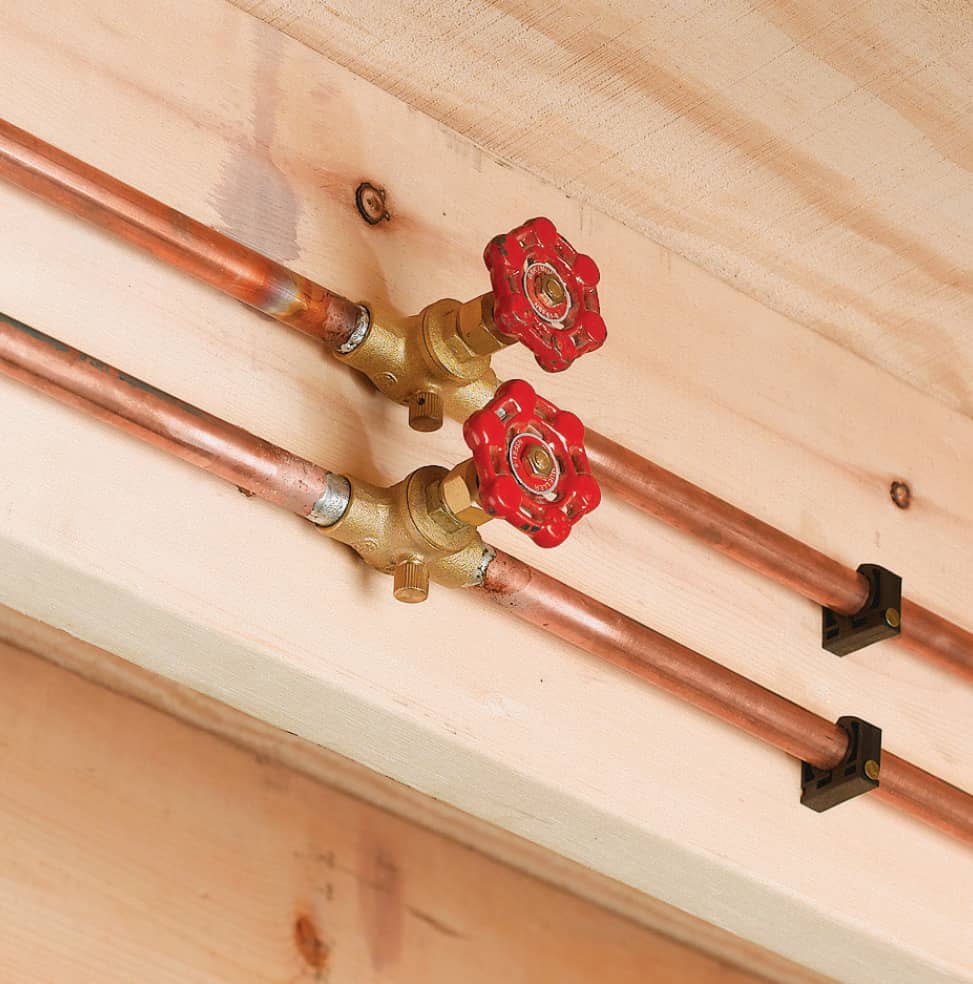
Partial-house shutoffs are often found in medium- to large-size homes. They control water flow to large areas of the house. They are found in pairs, one for hot and one for cold water. Turning off a pair of these may shut off water to a floor or to an entire bathroom or kitchen.
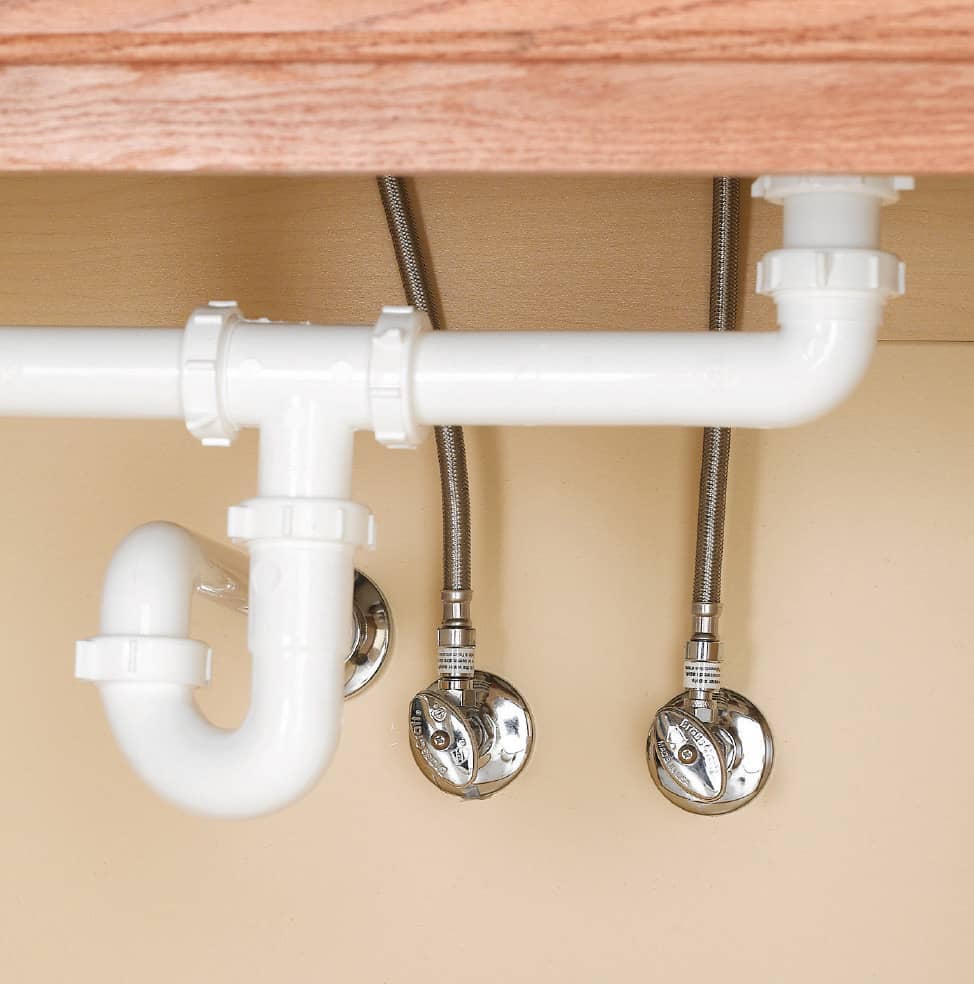
Fixture shutoff valves, also called stop valves, control water to a specific faucet, toilet, or fixture. They are also usually found in pairs, one for hot and one for cold. However, toilets, icemakers, and other cold-water-only fixtures will have only one stop valve. If you live in an older home that lacks stop valves, it’s a good idea to install them.
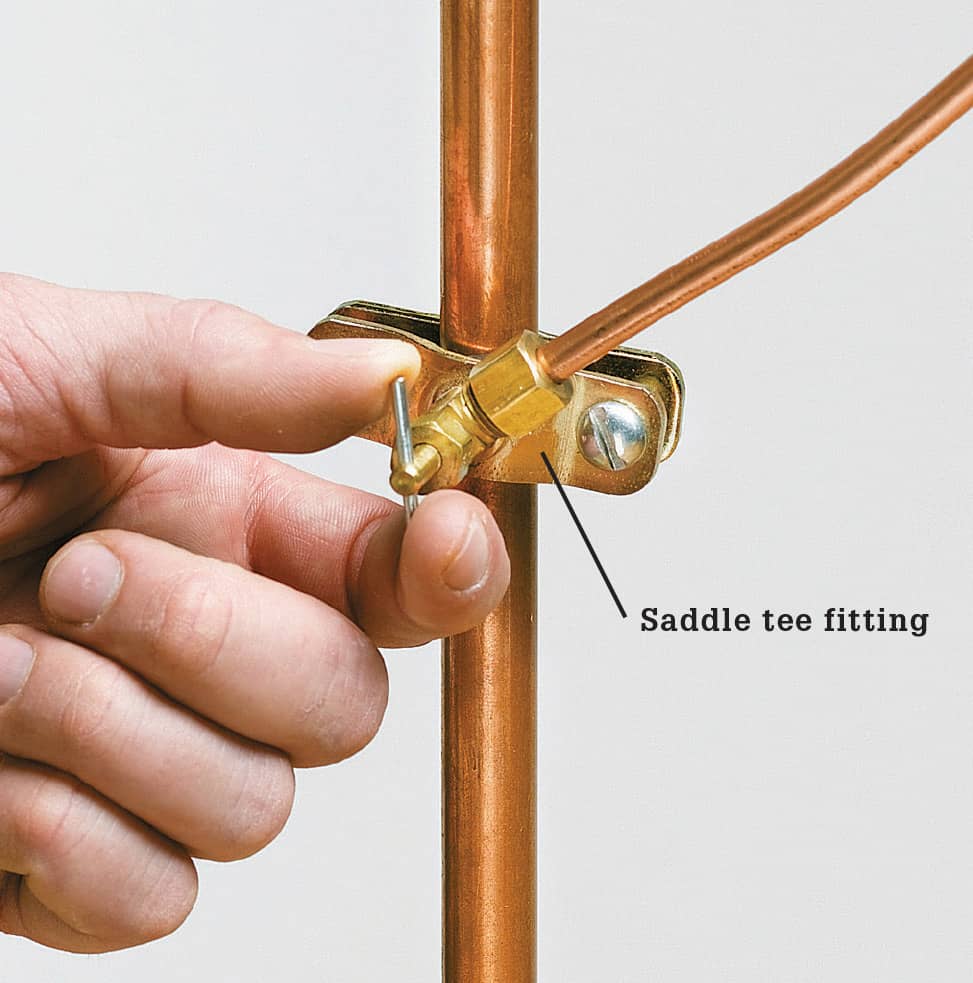
Saddle valves often are used to tap into a water supply pipe to bring water to a low-demand fixture, such as an ice maker or a hot water dispenser. Some municipalities do not endorse saddle valves, but most do (although the vast majority of professional plumbers do not like to install them because they tend to leak). The saddle valve handle appears to be a shutoff but it is not—if a leak develops at or downline from a saddle valve, find the closest shutoff valve between the water supply and the saddle if you need to stop the water flow.
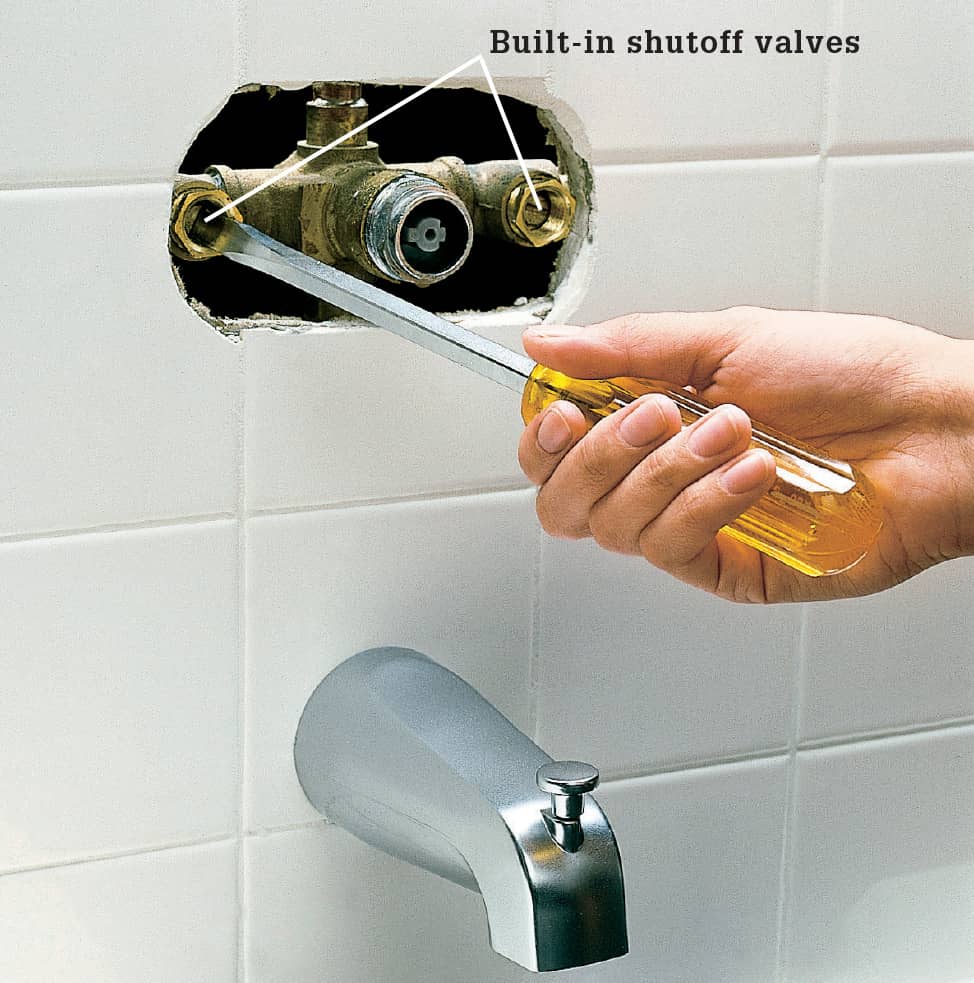
Integral shutoffs are sometimes found on tub-and-shower faucets and other fixtures. This arrangement allows water to be turned off to the fixture only, so water remains available for the rest of the house.
 Plumbing Tools
Plumbing Tools
Many plumbing projects and repairs can be completed with basic hand tools you probably already own. Adding a few simple plumbing tools will prepare you for all the projects in this book. Specialty tools, such as a snap cutter or appliance dolly, are available at rental centers. When buying tools, invest in quality products.
Always care for tools properly. Clean tools after using them, wiping them free of dirt and dust with a soft rag. Prevent rust on metal tools by wiping them with a rag dipped in household oil. If a metal tool gets wet, dry it immediately, and then wipe it with an oiled rag. Keep toolboxes and cabinets organized. Make sure all tools are stored securely.
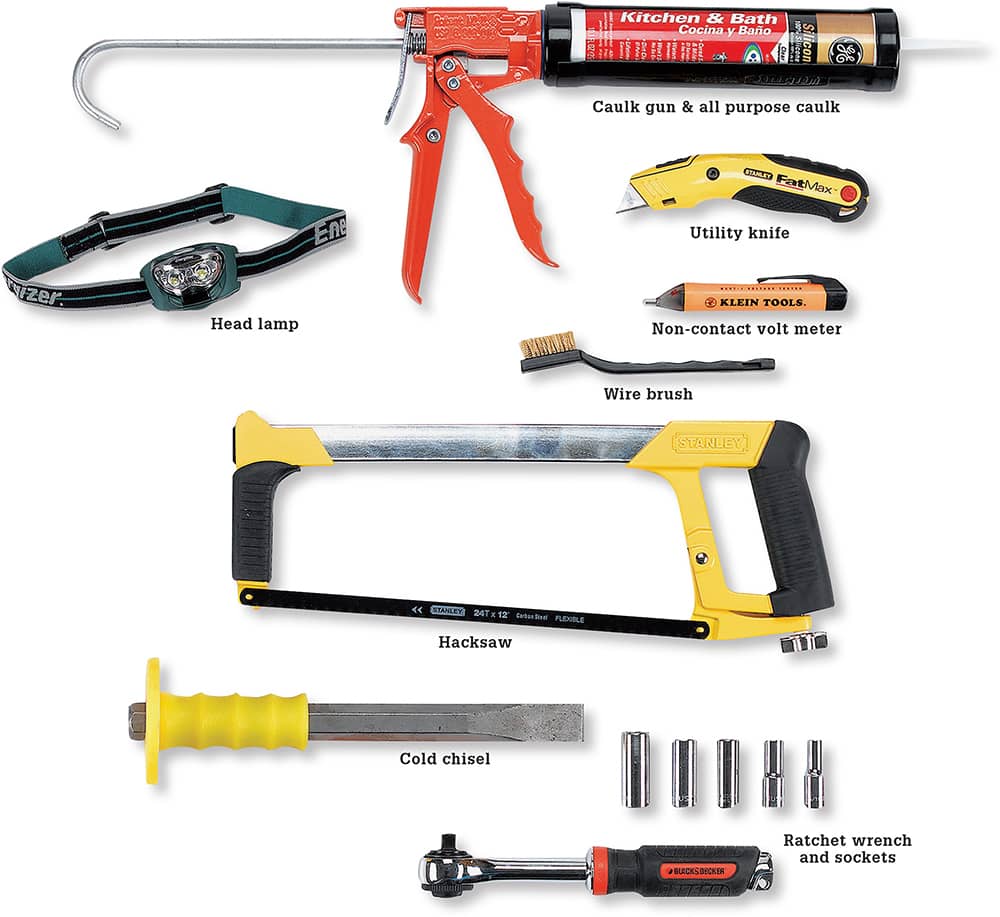
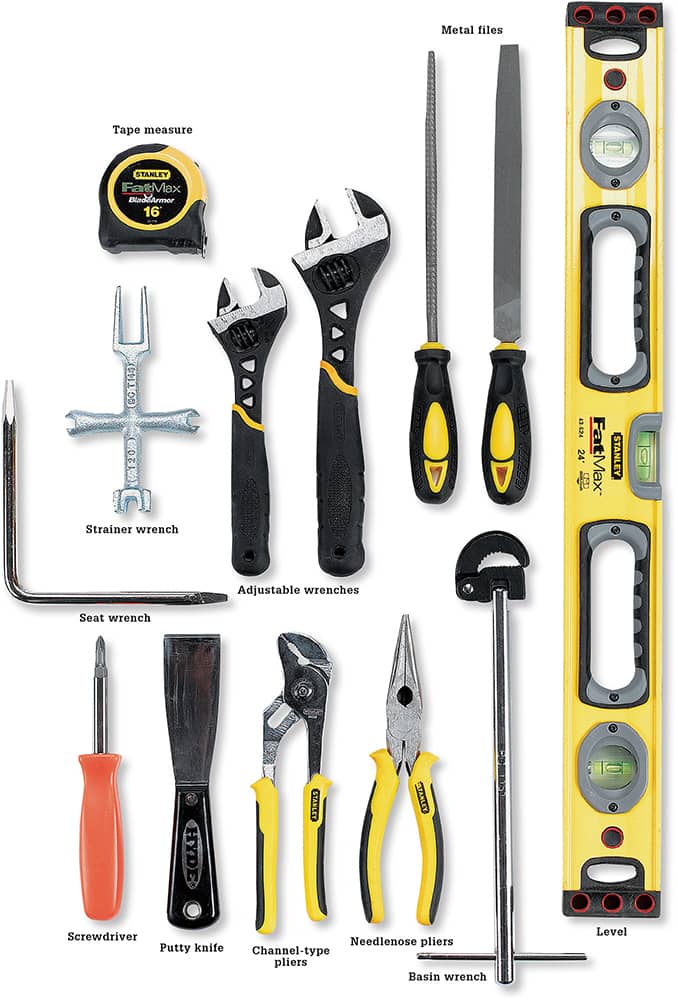
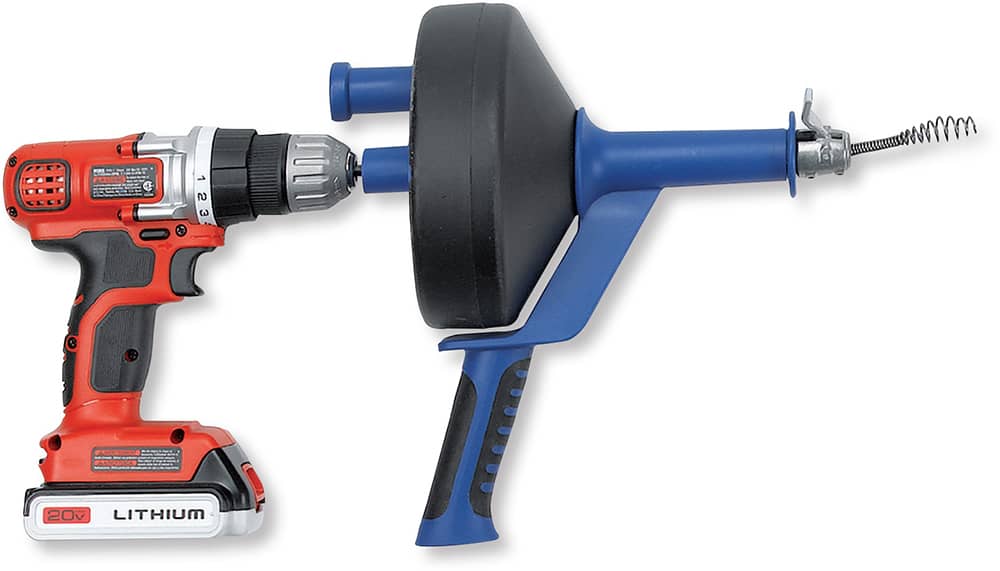
Drill-powered auger is stronger than a hand-crank auger for removing larger pipe obstructions. This auger can be cranked by hand or attached to a standard 3/8" power drill.
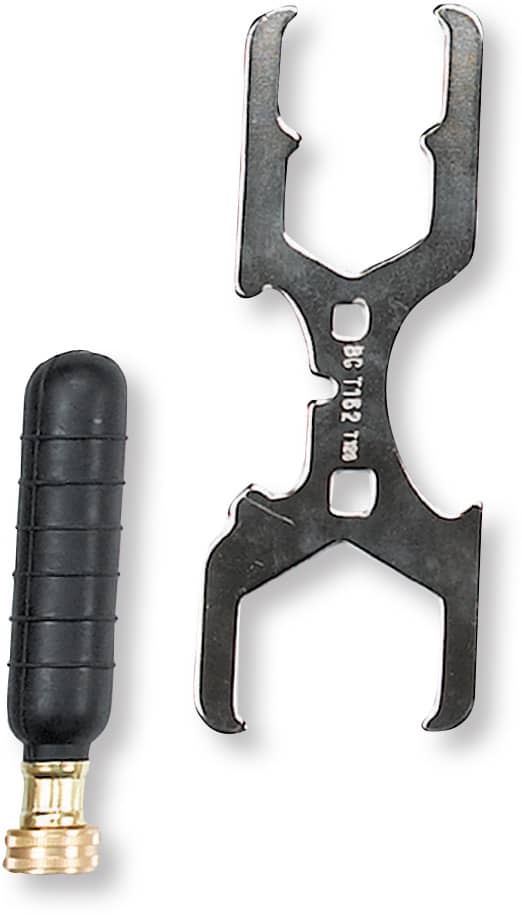
Spud wrench is specially designed for removing or tightening large nuts that are 2" to 4" in diameter. Hooks on the ends of the wrench grab onto the lugs of large nuts for increased leverage.
Blow bag, sometimes called an expansion nozzle, is used to clear drains. It attaches to a garden hose and removes clogs with large spurts of water. The blow bag is best used on floor drains.
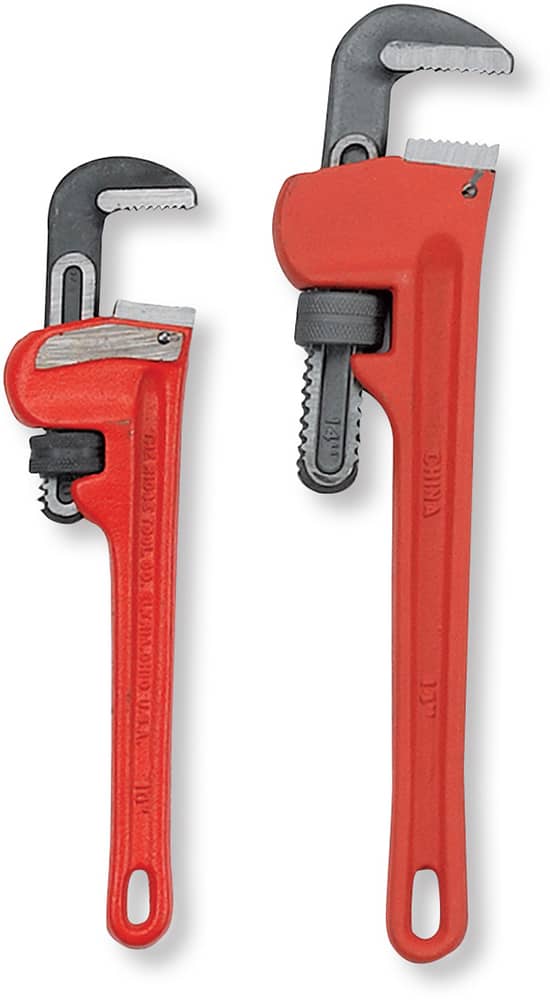
Pipe wrench has a movable jaw that adjusts to fit a variety of pipe diameters. Pipe wrench is used for tightening and loosening pipes, pipe fittings, and large nuts. Two pipe wrenches often are used together to prevent damage to pipes and fittings.
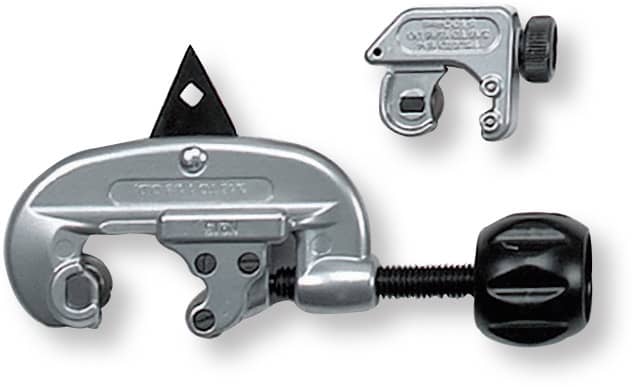
Tubing cutters make straight, smooth cuts in plastic and copper pipe. A tubing cutter usually has a triangular blade for removing burrs from the insides of pipes.
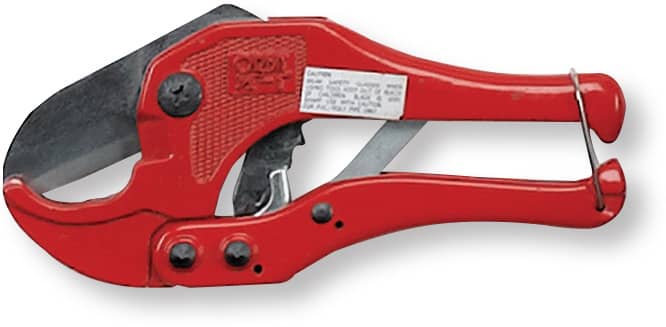
Plastic tubing cutter works like a gardener’s pruners to cut flexible plastic pipes quickly.

Force cup clears drain clogs with water and air pressure. The force cup is used for toilet bowls. The flange usually can be folded up into the cup for use as a standard plunger.
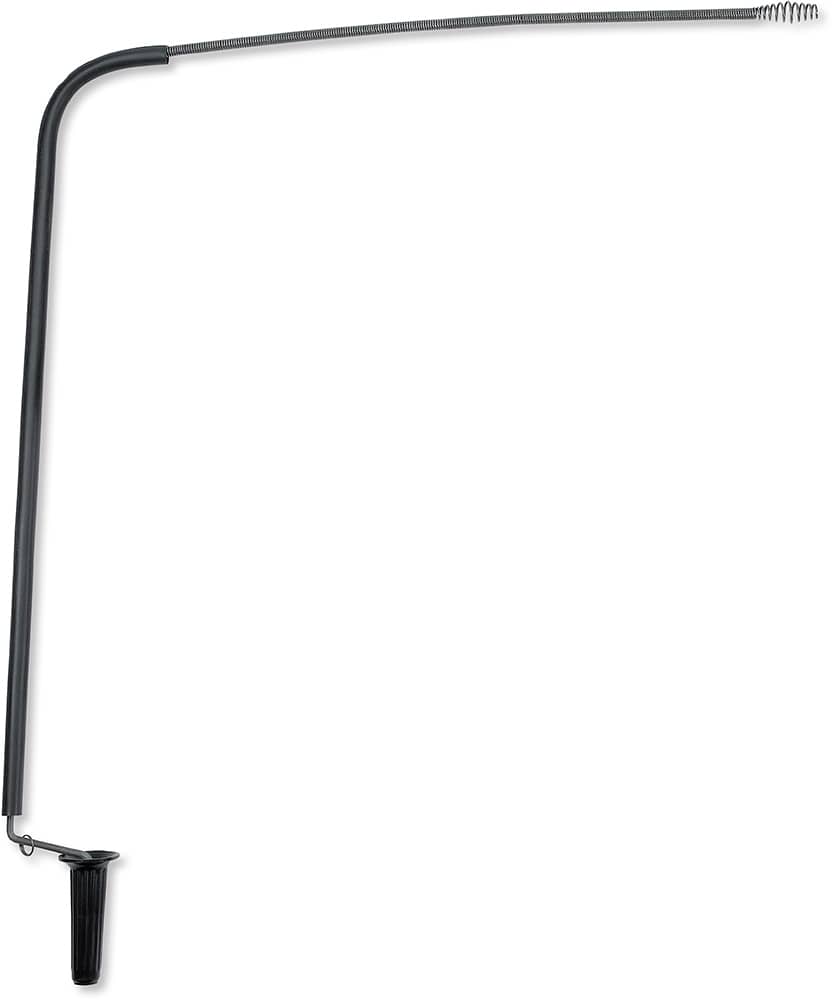
Closet auger is used to clear toilet clogs. It is a slender tube with a crank handle on one end of a flexible auger cable. A special bend in the tube allows the auger to be positioned in the bottom of the toilet bowl. The bend is usually protected with a rubber sleeve to prevent scratching the toilet.

MAPP torch (left) is used for soldering fittings to copper pipes. Light the torch quickly and safely using a spark lighter.
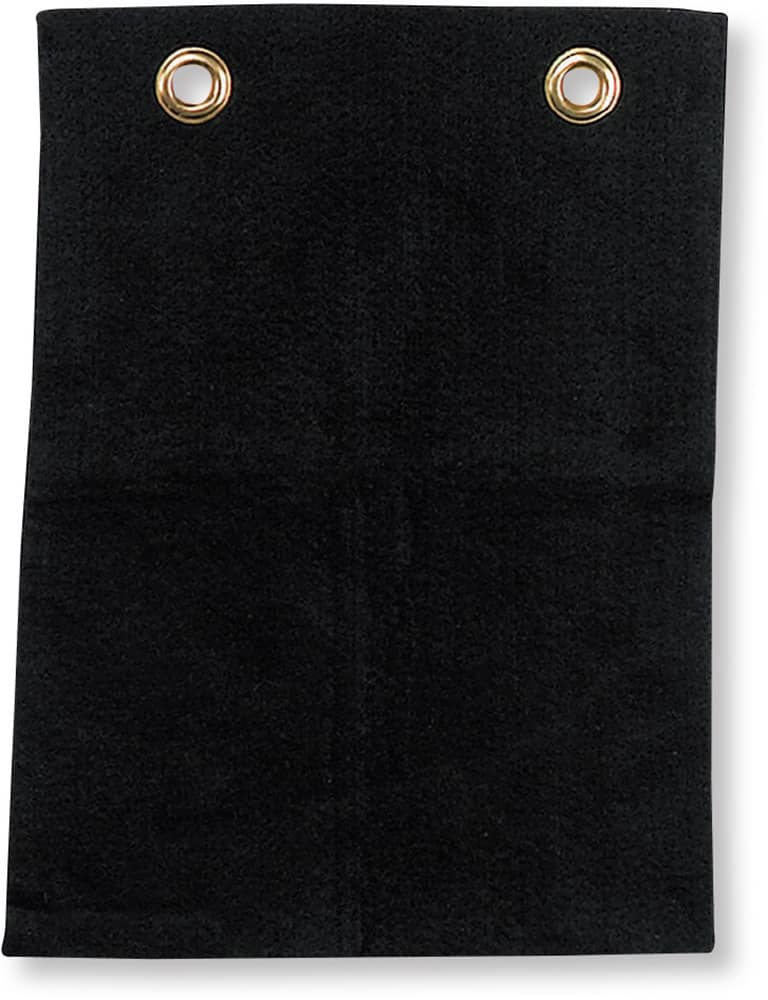
Flame-resistant pad helps keep wood and other underlying materials safe from the torch’s flame.
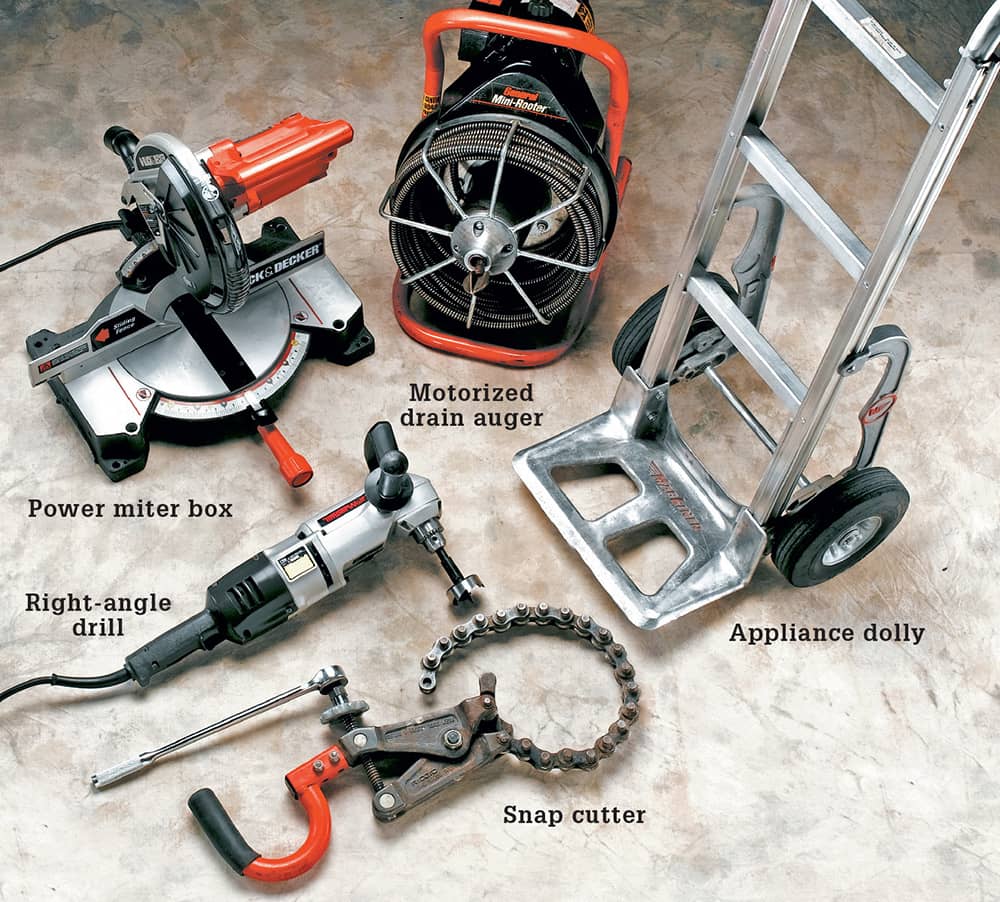
Rental tools may be needed for large jobs and special situations. A power miter saw makes fast, accurate cuts in a wide variety of materials, including plastic pipes. A motorized drain auger clears tree roots from sewer service lines. Use an appliance dolly to move heavy objects like water heaters. A snap cutter is designed to cut tough cast-iron pipes. The right-angle drill is useful for drilling holes in hard-to-reach areas.
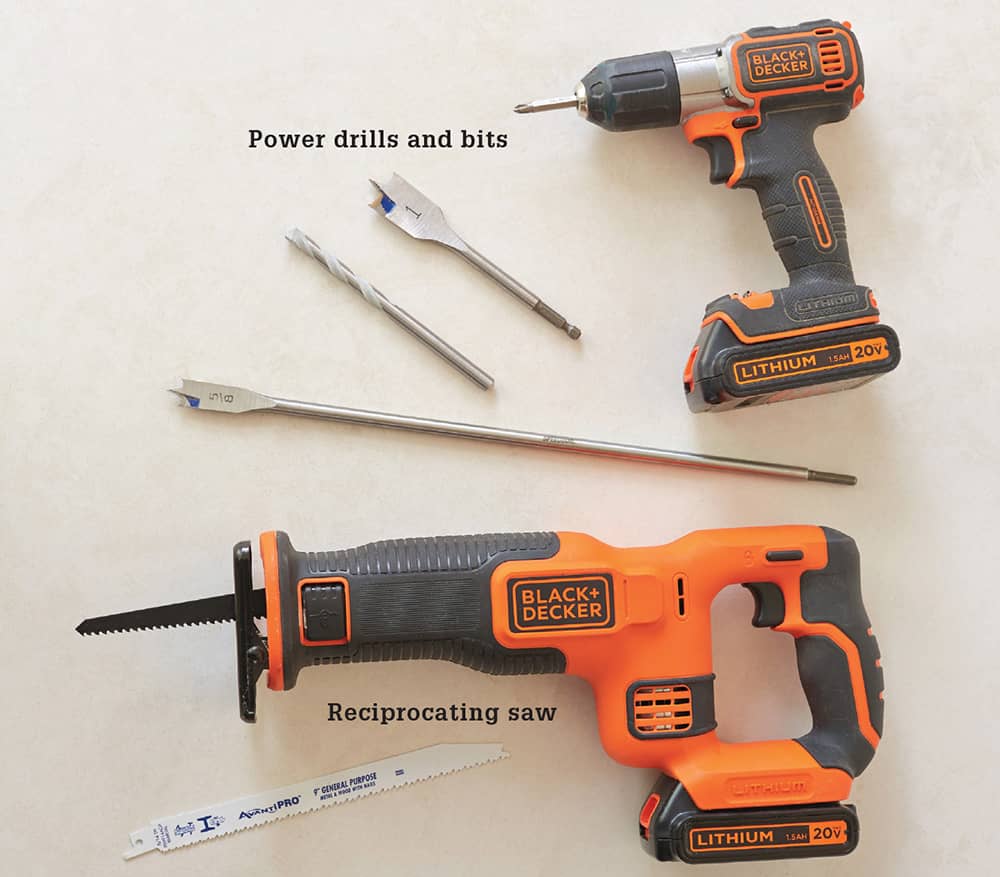
Power hand tools can make any job faster, easier, and safer. Cordless power tools offer added convenience. Use a cordless 3/8" power drill for virtually any drilling task.
 Plumbing Materials
Plumbing Materials
 Copper Tubing
Copper Tubing
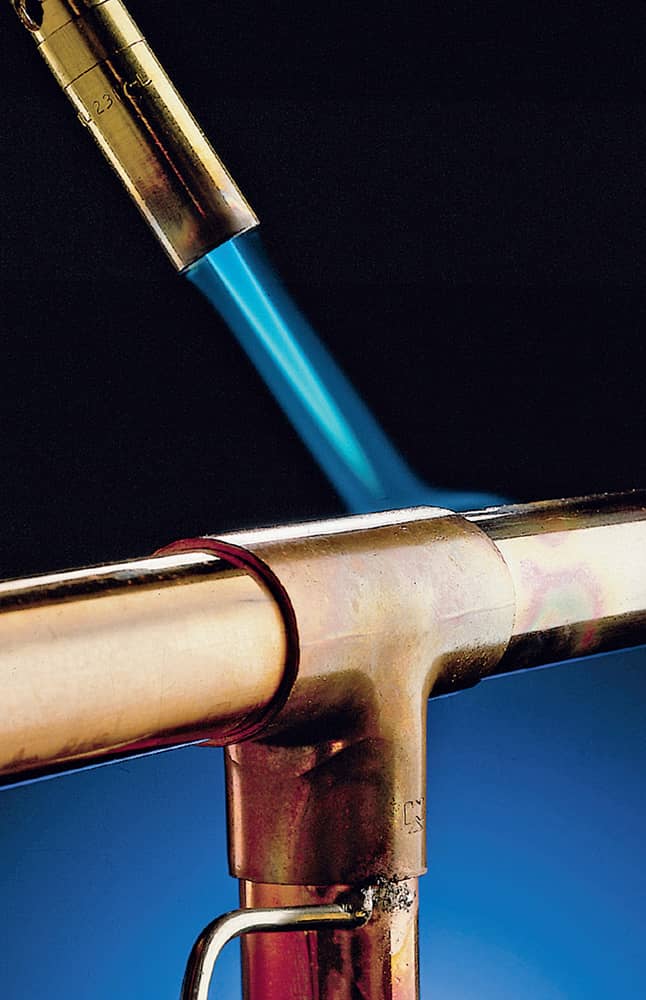
Soldered fittings, also called sweat fittings, often are used to join copper pipes. Correctly soldered fittings are strong and trouble-free. Copper pipe can also be joined with compression fittings or flare fittings. See chart below.
Copper is an ideal material for water supply pipes. It resists corrosion and has smooth surfaces that provide good water flow. Copper pipes are available in several diameters, but most home water supply systems use 1/2" or 3/4" pipe. Copper pipe is manufactured in rigid and flexible forms.
Rigid copper, sometimes called hard copper, is approved for home water supply systems by all local codes. It comes in three wall-thickness grades: Types M, L, and K. Type M is the thinnest, the least expensive, and a good choice for do-it-yourself home plumbing.
Rigid Type L usually is required by code for commercial plumbing systems. Because it is strong and solders easily, Type L may be preferred by some professional plumbers and do-it-yourselfers for home use. Type K has the heaviest wall thickness and is used most often for underground water service lines.
Flexible copper, also called soft copper, comes in two wall-thickness grades: Types L and K. Both are approved for most home water supply systems, although flexible Type L copper is used primarily for gas service lines. Because it is bendable and will resist a mild frost, Type L may be installed as part of a water supply system in unheated indoor areas, like crawl spaces. Type K is used for underground water service lines.
A third form of copper, called DWV, is used for drain systems. Because most codes now allow low-cost plastic pipes for drain systems, DWV copper is seldom used.
Copper pipes are connected with soldered, compression, or flare fittings (see chart below). Always follow your local code for the correct types of pipes and fittings allowed in your area.
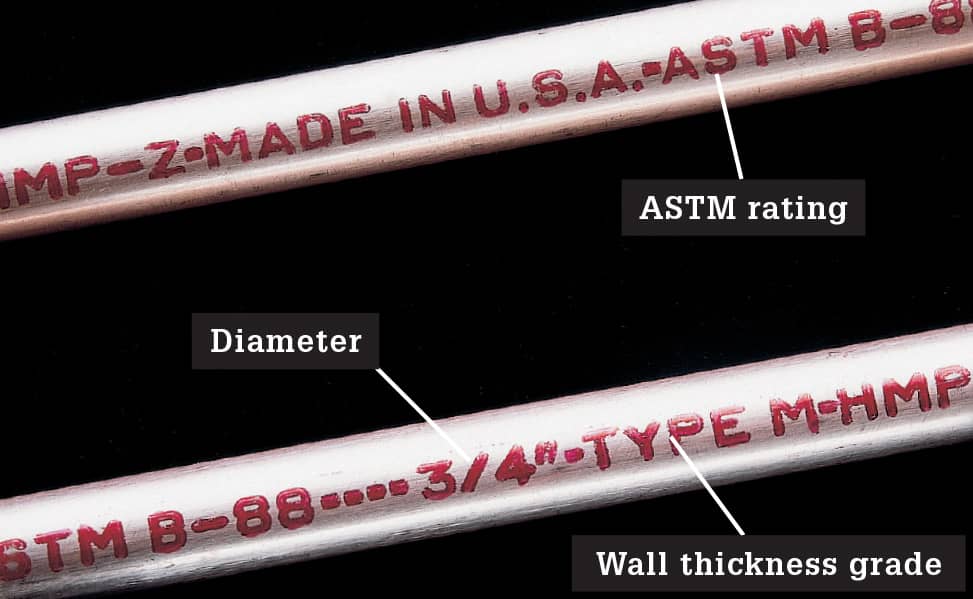
Grade stamp information includes the pipe diameter, the wall-thickness grade, and a stamp of approval from the ASTM (American Society for Testing and Materials). Type M pipe is identified by red lettering, Type L by blue lettering.
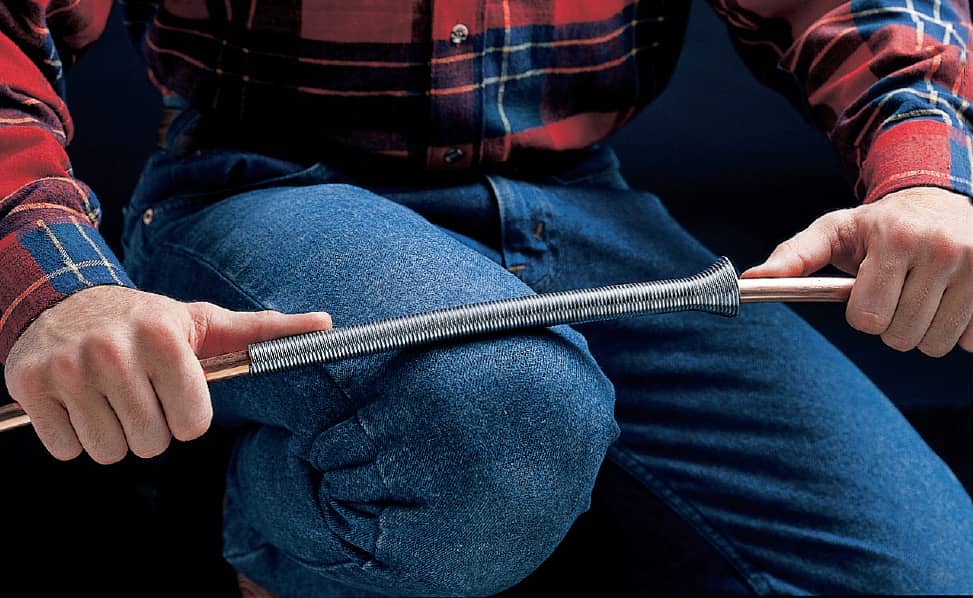
Bend flexible copper pipe with a coil-spring tubing bender to avoid kinks. Select a bender that matches the outside diameter of the pipe. Slip bender over pipe using a twisting motion. Bend pipe slowly until it reaches the correct angle, but not more than 90°.
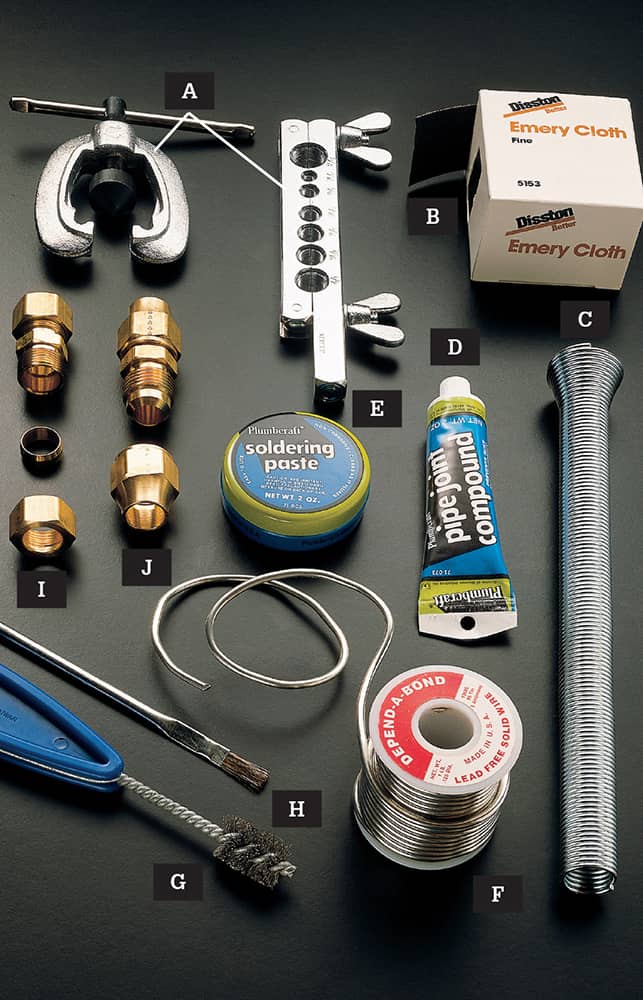
Specialty tools and materials for working with copper include: flaring tools (A), emery cloth (B), coil-spring tubing bender (C), pipe joint compound (D), soldering paste (flux) (E), lead-free solder (F), wire brush (G), flux brush (H), compression fitting (I), flare fitting (J).
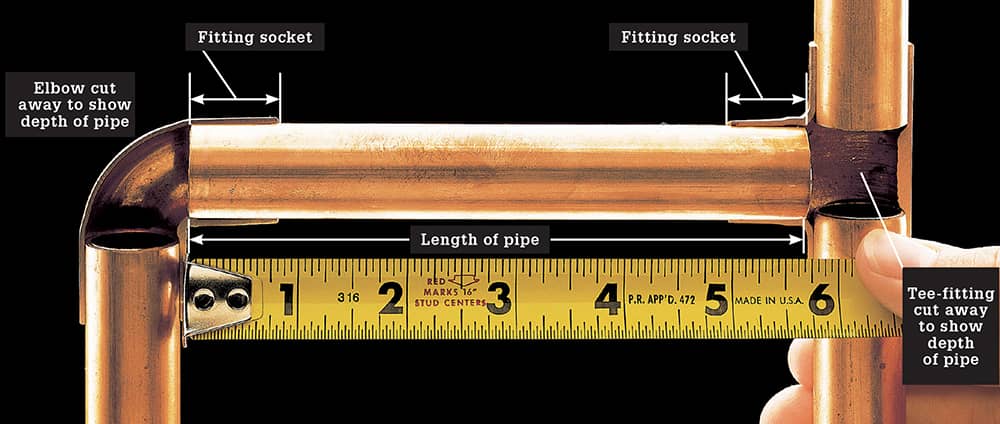
Find the length of copper pipe needed by measuring between the bottom of the copper fitting sockets (fittings shown in cutaway). Mark the length on the pipe with a felt-tipped pen.
Cutting & Soldering Copper
The best way to cut rigid and flexible copper pipe is with a tubing cutter. A tubing cutter makes a smooth, straight cut, an important first step toward making a watertight joint. Remove any metal burrs on the cut edges with a reaming tool or round file.
Copper can be cut with a hacksaw. A hacksaw is useful in tight areas where a tubing cutter will not fit. Take care to make a smooth, straight cut when cutting with a hacksaw.
A soldered pipe joint, also called a sweated joint, is made by heating a copper or brass fitting with a propane torch until the fitting is just hot enough to melt metal solder. The heat draws the solder into the gap between the fitting and pipe to form a watertight seal. A fitting that is overheated or unevenly heated will not draw in solder. Copper pipes and fittings must be clean and dry to form a watertight seal.
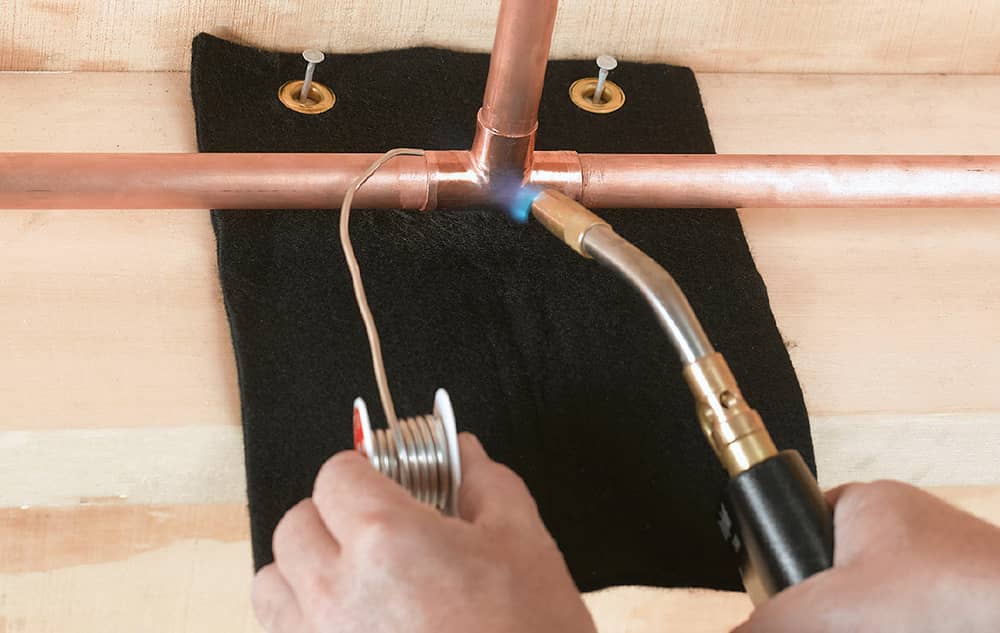
Protect wood from the heat of the torch flame while soldering. Use an old cookie sheet, two sheets of 26-gauge metal, or a fiber shield, as shown.
How to Cut Rigid & Flexible Copper Pipe
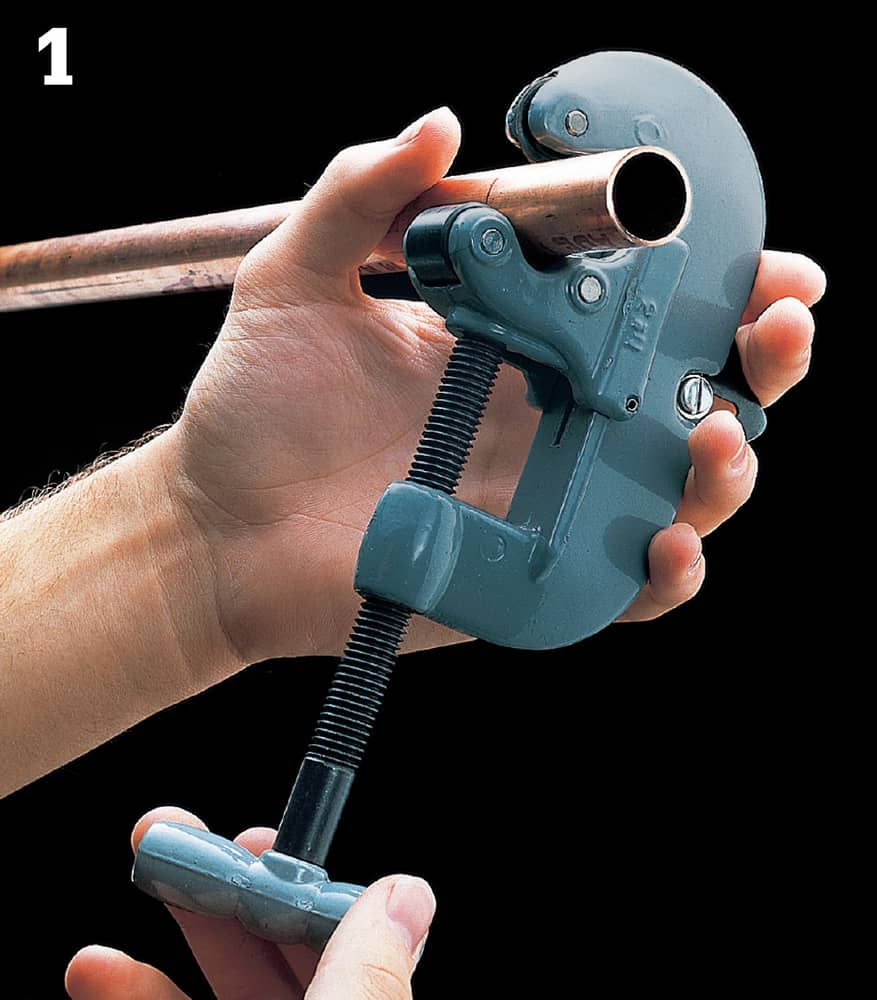
Place the tubing cutter over the pipe and tighten the handle so that the pipe rests on both rollers and the cutting wheel is on the marked line.
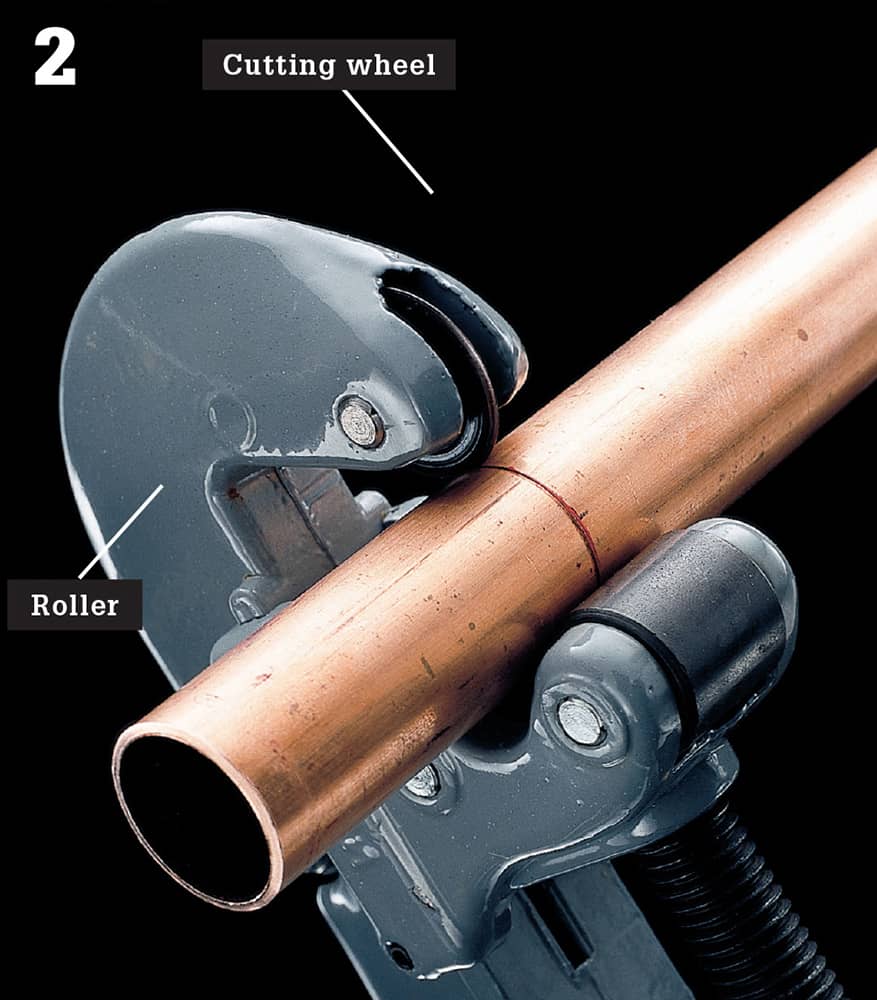
Turn the tubing cutter one rotation so that the cutting wheel scores a continuous straight line around the pipe.
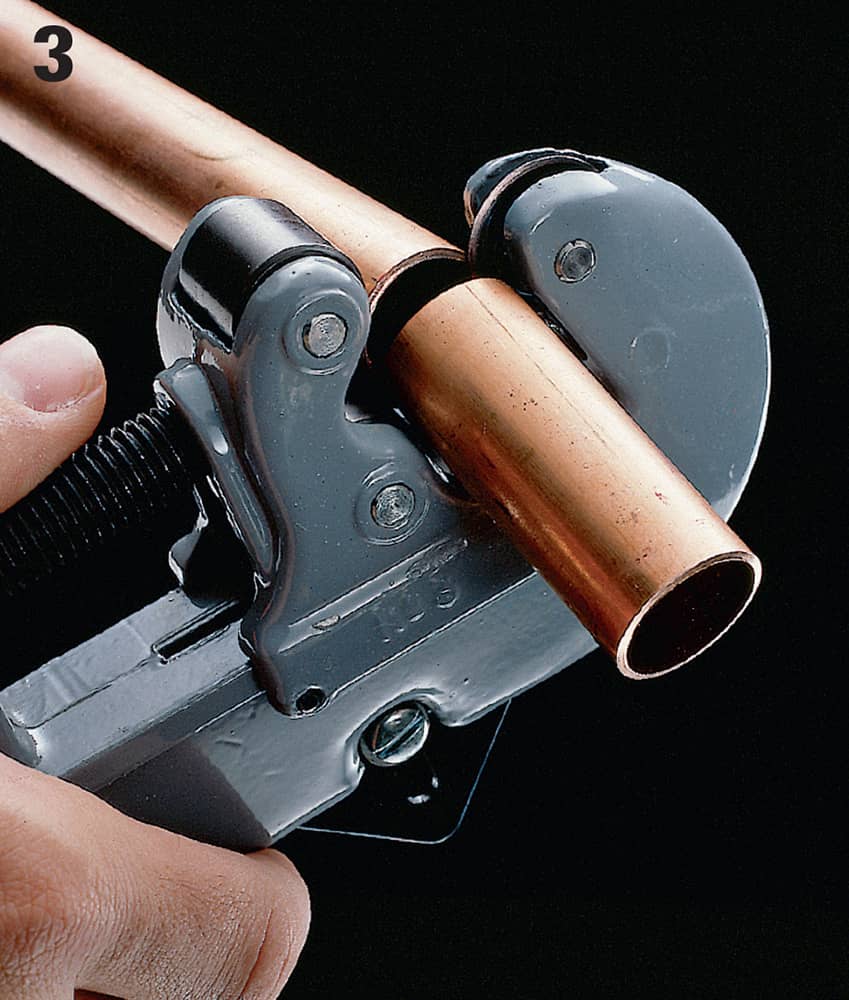
Rotate the cutter in the opposite direction, tightening the handle slightly after every two rotations, until the cut is complete.
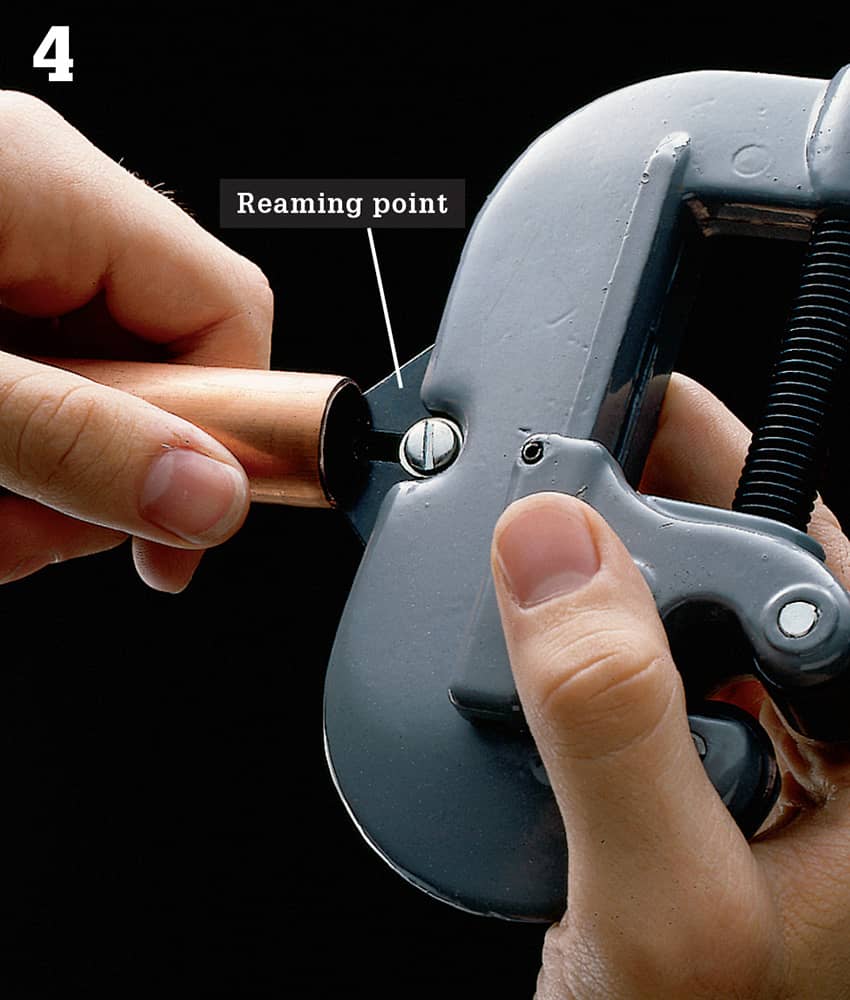
Remove sharp metal burrs from the inside edge of the cut pipe, using the reaming point on the tubing cutter, or a round file.
How to Solder Copper Pipes & Fittings
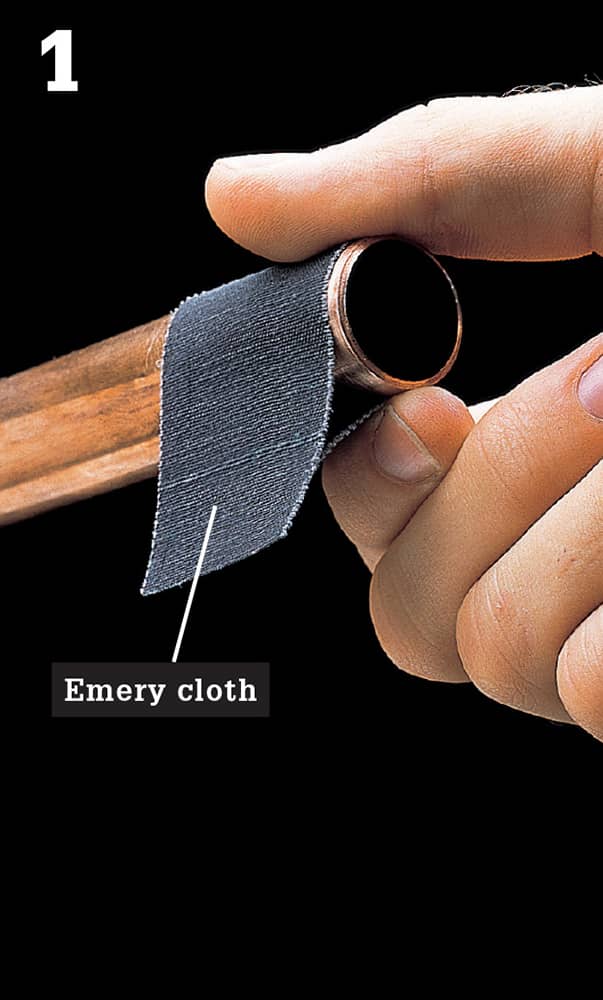
Clean the end of each pipe by sanding with emery cloth. Ends must be free of dirt and grease to ensure that the solder forms a good seal.
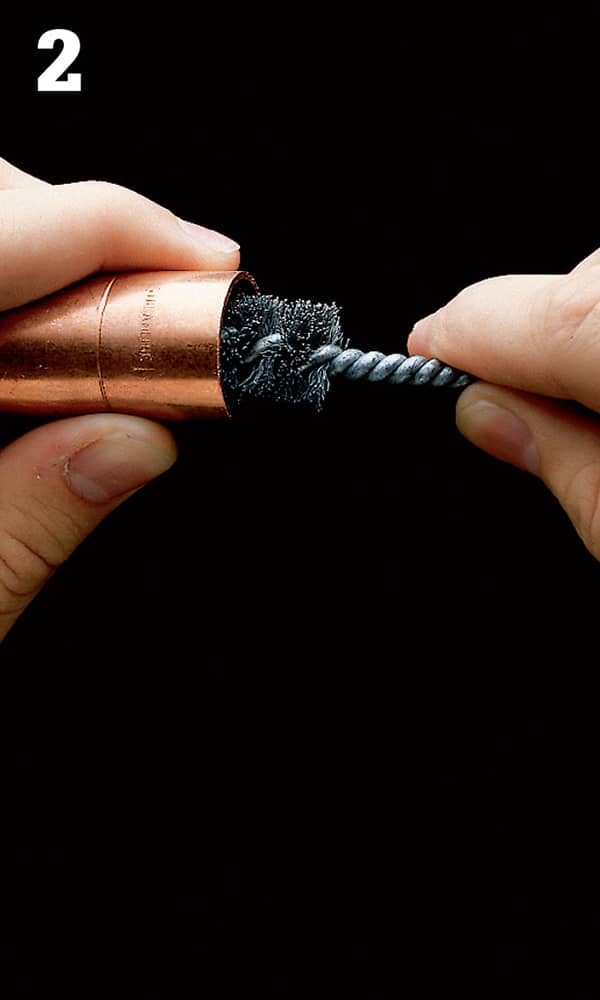
Clean the inside of each fitting by scouring with a wire brush or emery cloth.
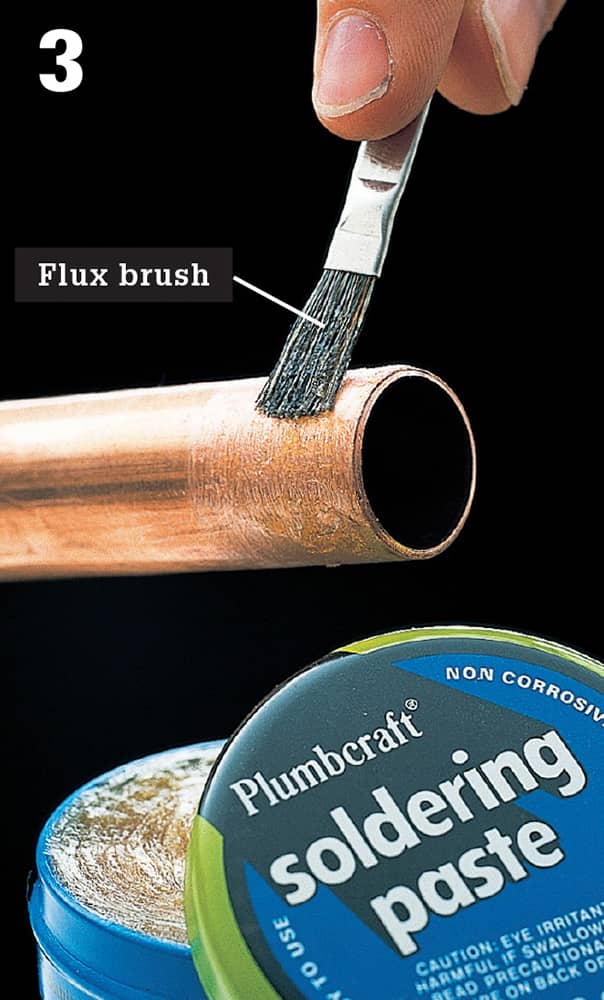
Apply a thin layer of soldering paste (flux) to end of each pipe, using a flux brush. Soldering paste should cover about 1" of pipe end. Don’t use too much flux.
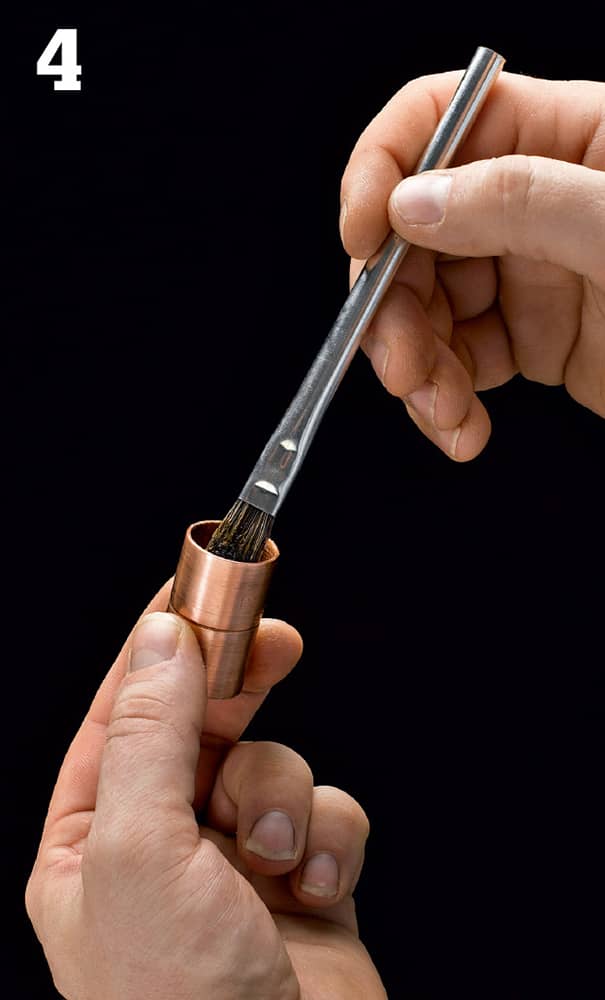
Apply a thin layer of flux to the inside of the fitting.
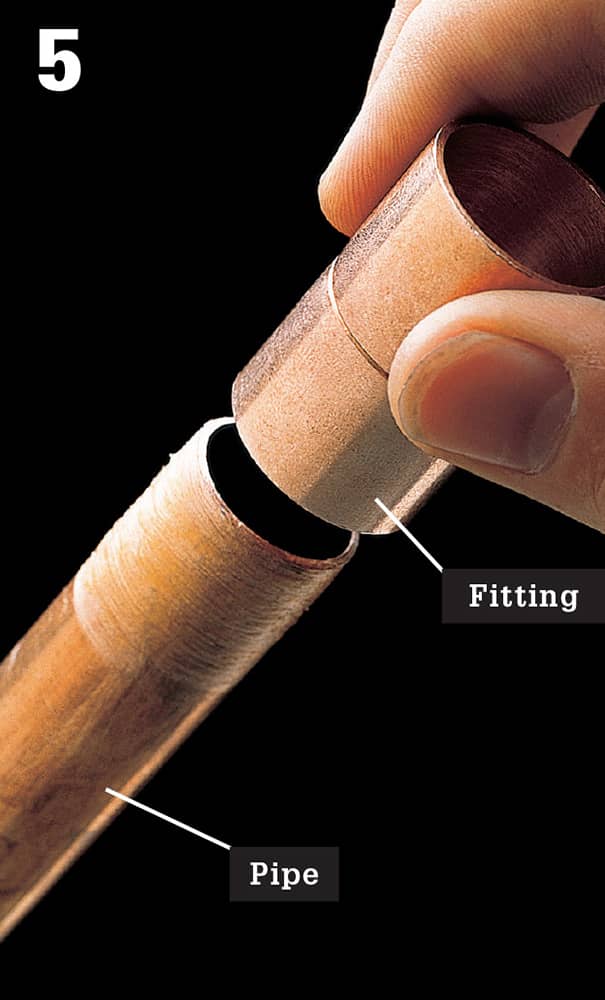
Assemble each joint by inserting the pipe into the fitting so it is tight against the bottom of the fitting sockets. Twist each fitting slightly to spread soldering paste.
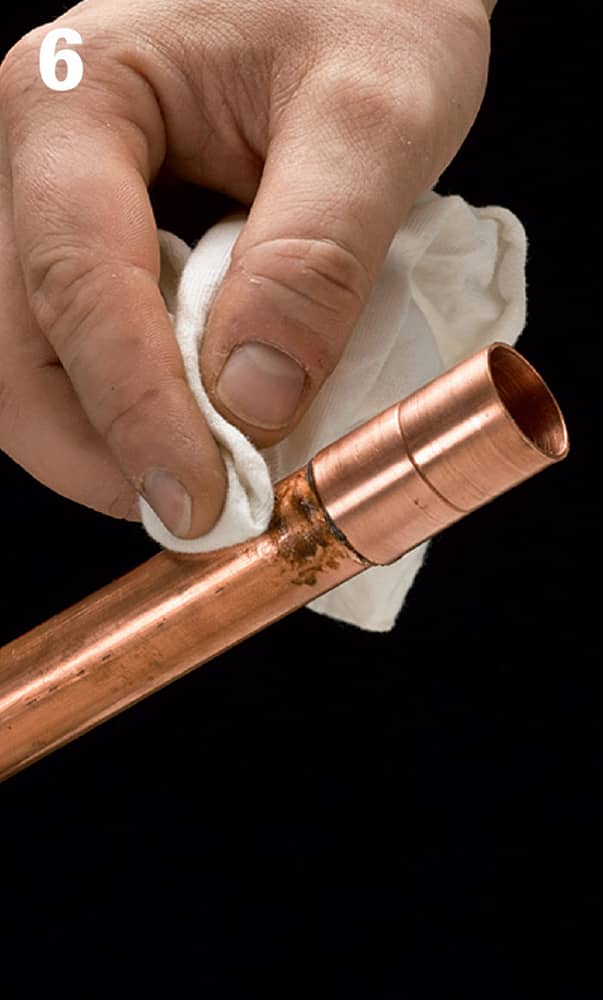
Use a clean dry cloth to remove excess flux before soldering the assembled fitting.
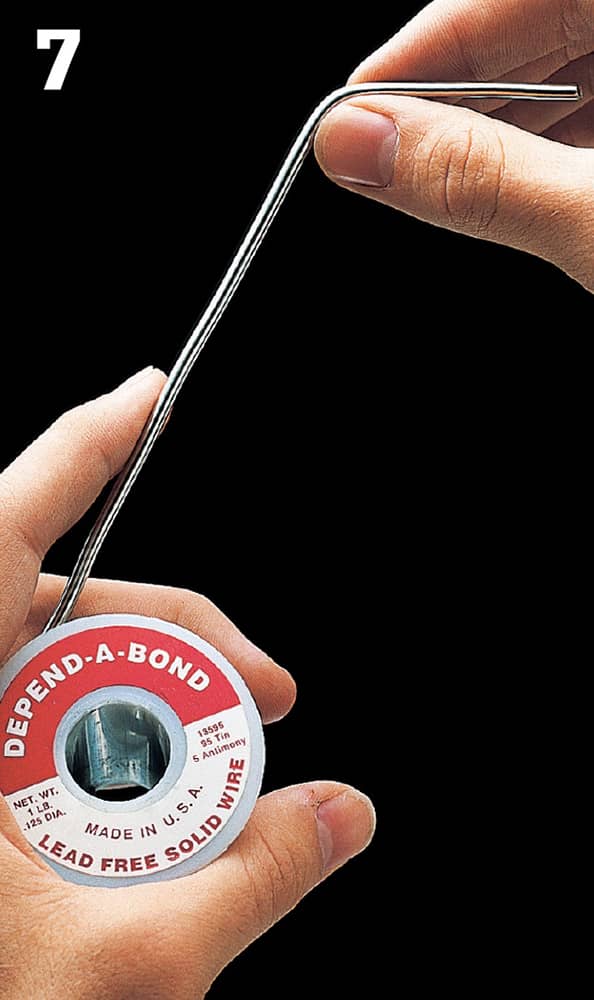
Prepare the wire solder by unwinding 8" to 10" of wire from spool. Bend the first 2" of the wire to a 90° angle.
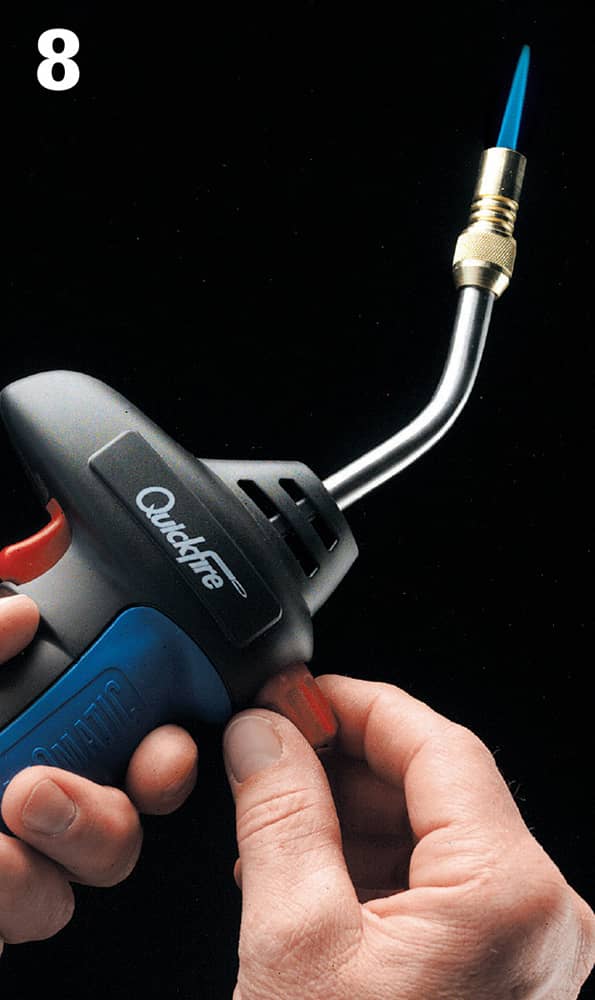
Open the gas valve and trigger the spark lighter to ignite the torch. Adjust the torch valve until the inner portion of the flame is 1" to 2" long.
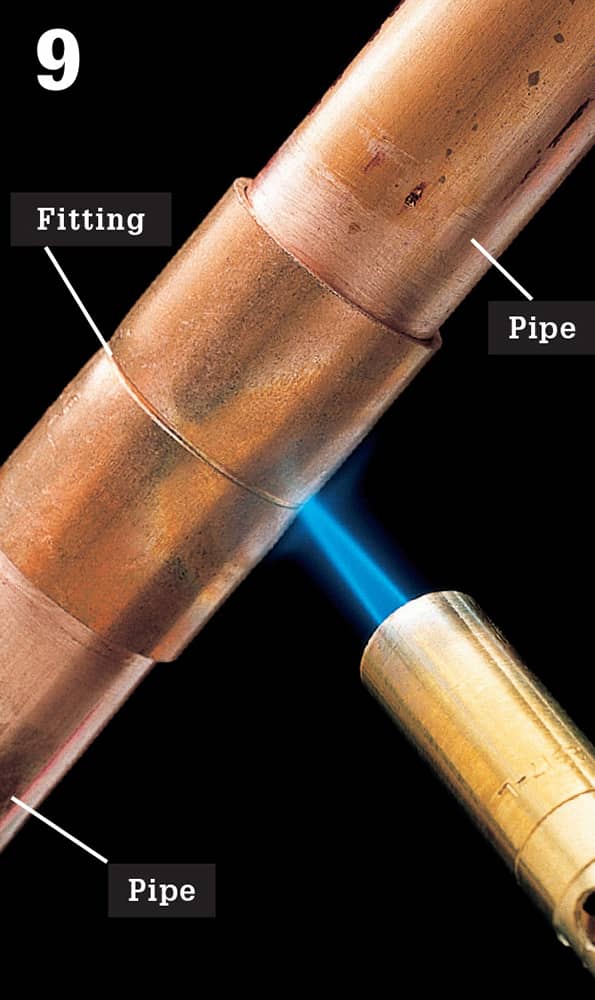
Move the torch flame back and forth and around the pipe and the fitting to heat the area evenly.
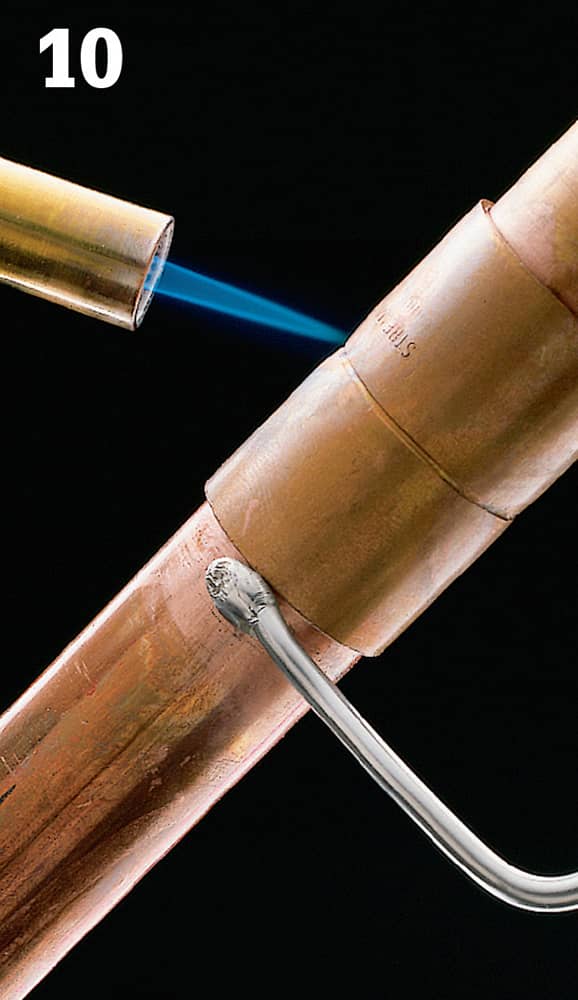
Heat the other side of the copper fitting to ensure that heat is distributed evenly. Touch solder to pipe. Solder will melt when the pipe is at the right temperature.
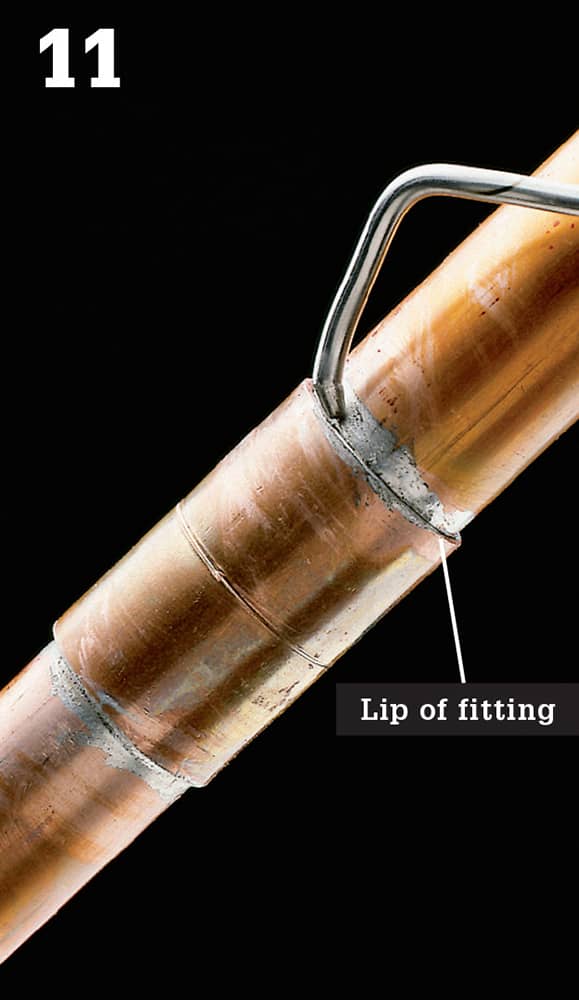
When solder melts, remove the torch and quickly push 1/2" to 3/4" of solder into each joint. Capillary action fills the joint with liquid solder. A correctly soldered joint should show a thin bead of solder around the lips of the fitting.
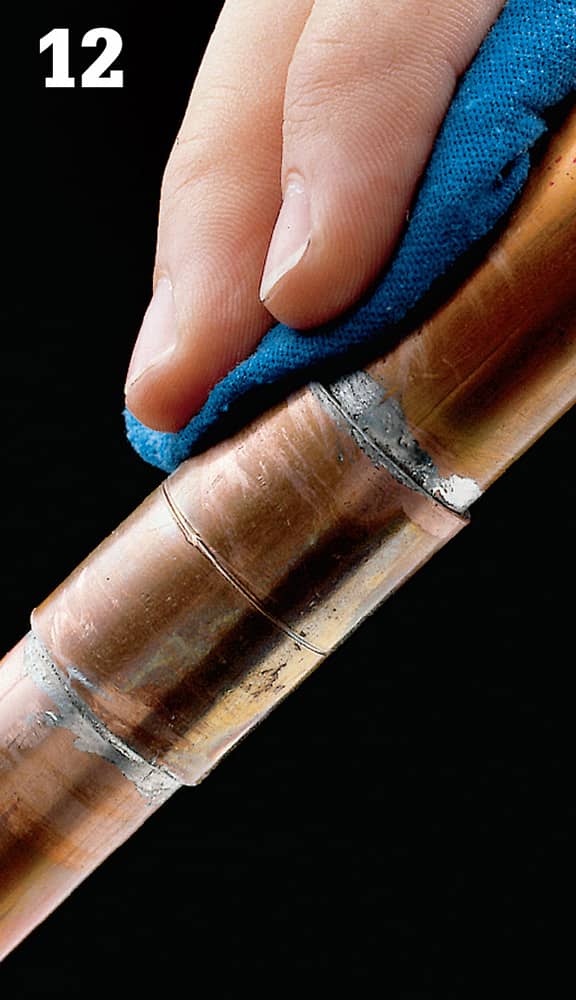
Allow the joint to cool briefly, then wipe away excess solder with a dry rag. CAUTION: Pipes will be hot. If joints leak after water is turned on, disassemble and resolder.
How to Solder Brass Valves
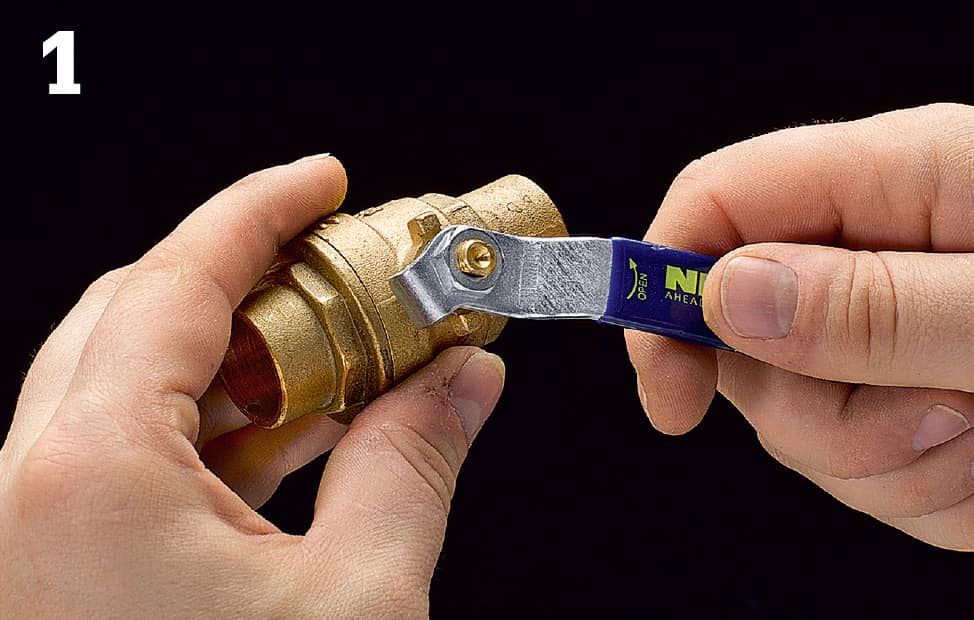
Valves should be fully open during all stages of the soldering process. If a valve has any plastic or rubber parts, remove them prior to soldering.
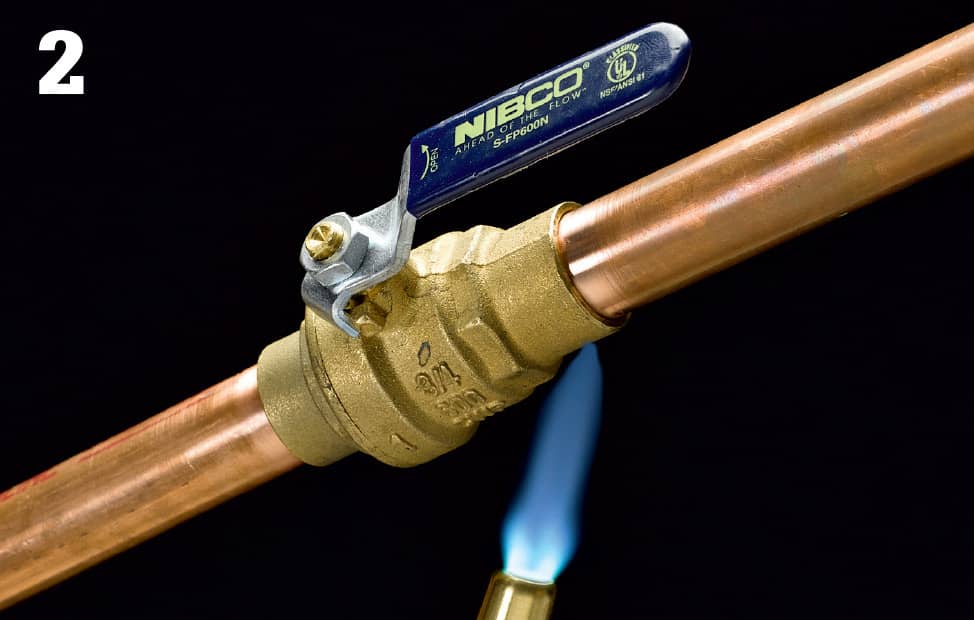
To prevent valve damage, quickly heat the pipe and the flanges of the valve, not the valve body. After soldering, cool the valve by spraying with water.
How to Take Apart Soldered Joints
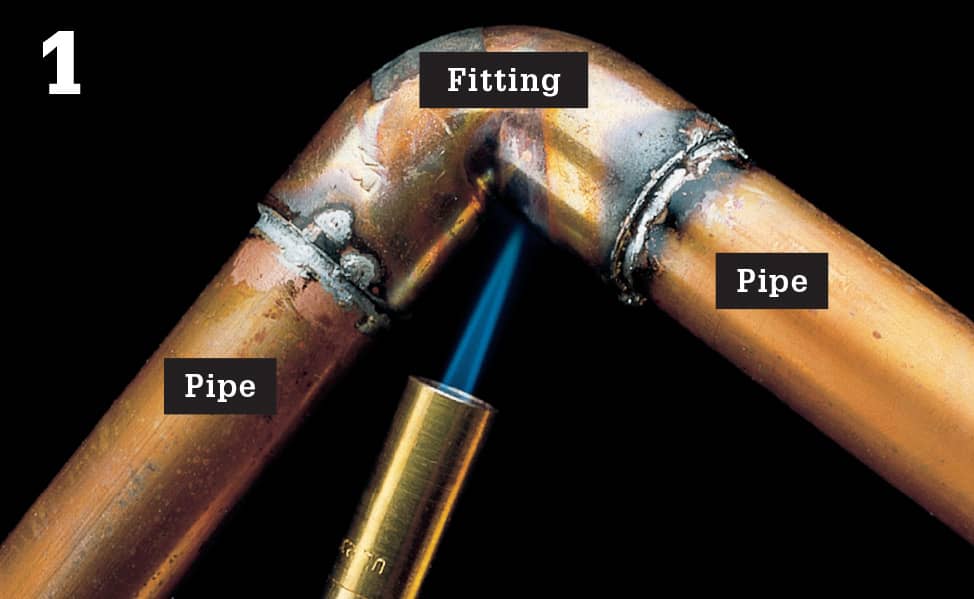
Turn off the water and drain the pipes by opening the highest and lowest faucets in the house. Light your torch. Hold the flame tip to the fitting until the solder becomes shiny and begins to melt.
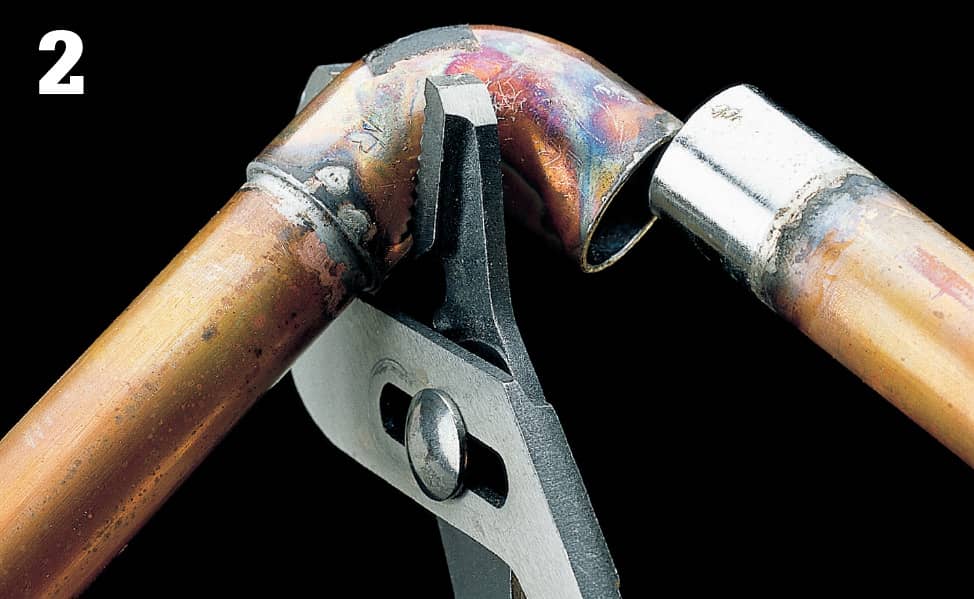
Use channel-type pliers to separate the pipes from the fitting.
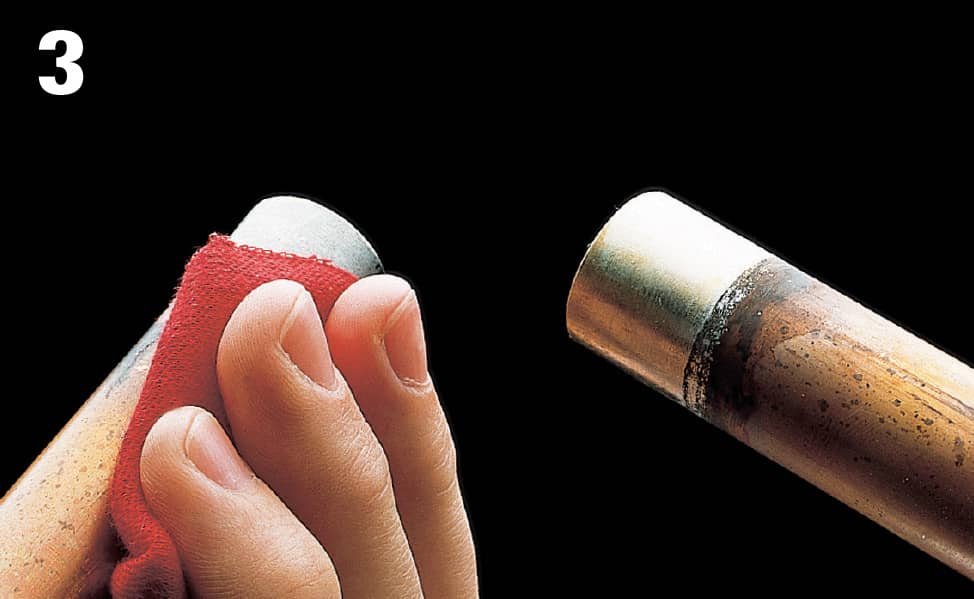
Remove old solder by heating the ends of the pipe with your torch. Use a dry rag to wipe away melted solder quickly. Caution: Pipes will be hot.
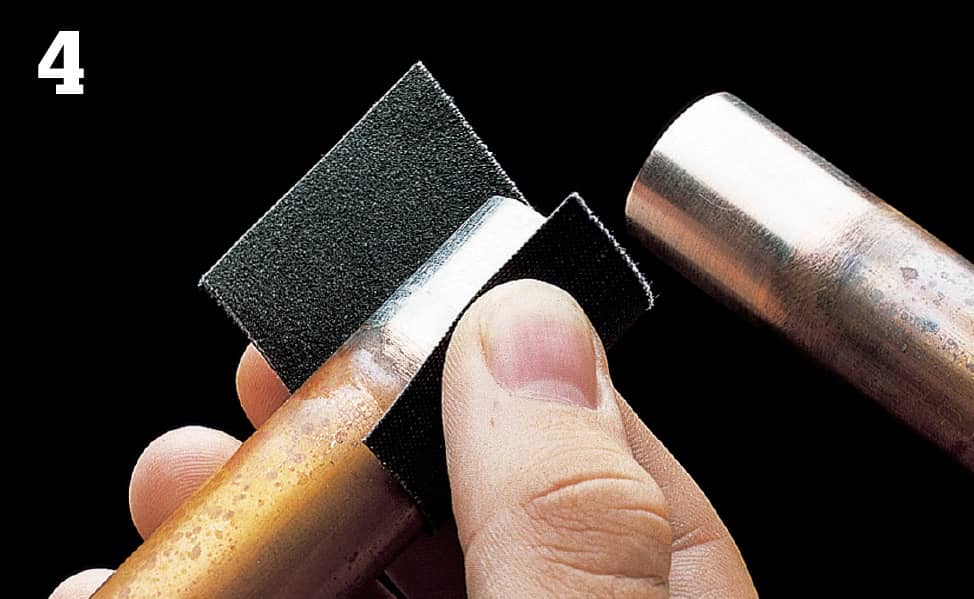
Use emery cloth to polish the ends of the pipe down to bare metal. Never reuse fittings.
 Rigid Plastic Pipe
Rigid Plastic Pipe
Cut rigid ABS, PVC, or CPVC plastic pipes with a tubing cutter or with any saw. Cuts must be straight to ensure watertight joints.
Rigid plastics are joined with plastic fittings and solvent cement. Use a solvent cement that is made for the type of plastic pipe you are installing. For example, do not use ABS solvent on PVC pipe. Some solvent cements, called “all-purpose” or “universal” solvents, may be used on all types of plastic pipe.
Solvent cement hardens in about 30 seconds, so test-fit all plastic pipes and fittings before cementing the first joint. For best results, the surfaces of plastic pipes and fittings should be dulled with emery cloth and liquid primer before they are joined.
Liquid solvent cements and primers are toxic and flammable. Provide adequate ventilation when fitting plastics, and store the products away from any source of heat.
Plastic grip fittings can be used to join rigid or flexible plastic pipes to copper plumbing pipes.
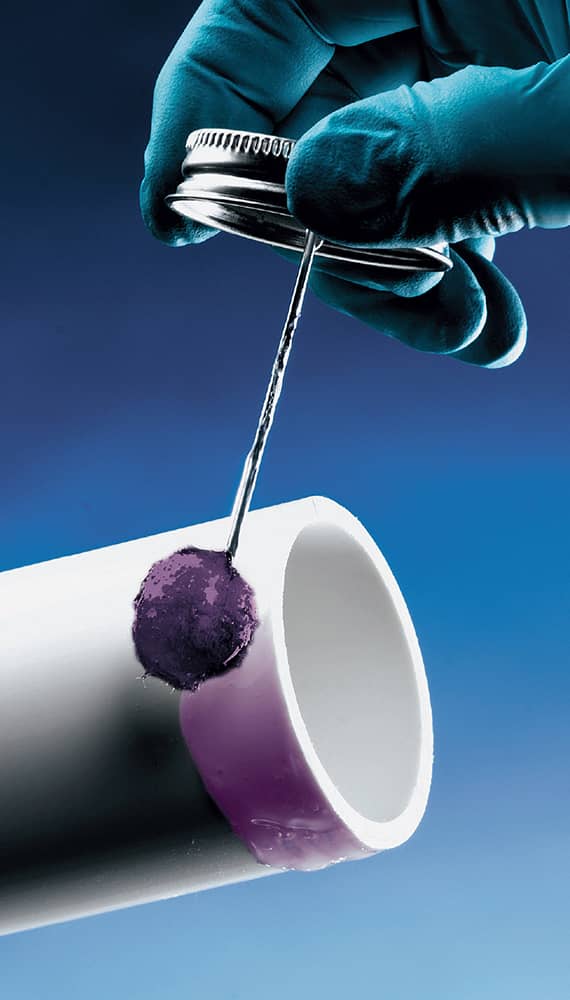
Solvent welding is a chemical bonding process used to permanently join PVC pipes and fittings.
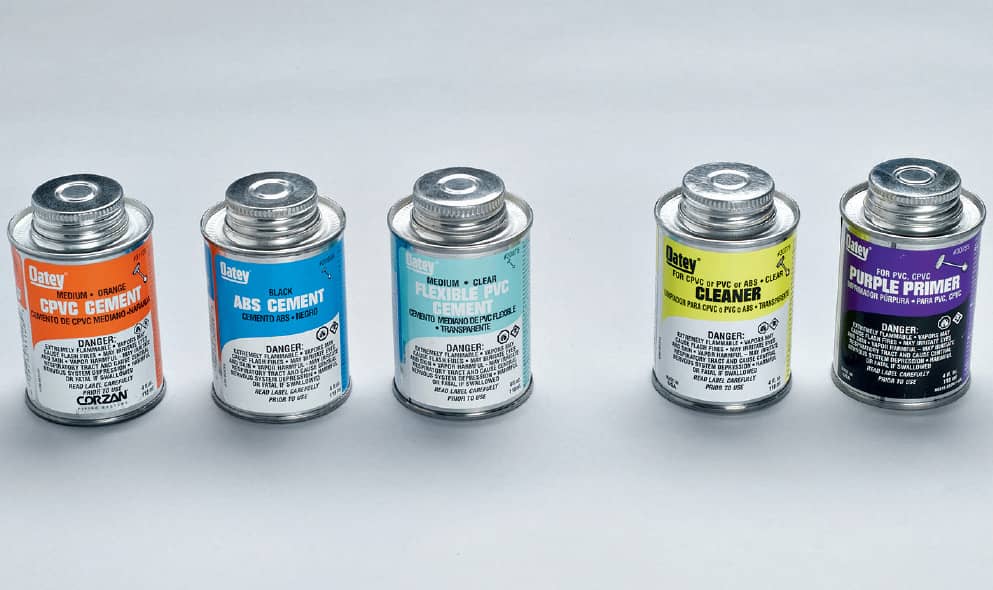
Primer and solvent cement are specific to the plumbing material being used. Do not use all-purpose or multipurpose products. Light to medium body cements are appropriate for DIYers as they allow the longest working time and are easiest to use. When working with large pipe, 3 or 4" in diameter, buy a large-size can of cement, which has a larger dauber. If you use the small dauber (which comes with the small can), you may need to apply twice, which will slow you down and make connections difficult. (The smaller can of primer is fine for any other size pipe, since there’s no rush in applying primer.) Cement (though not primer) goes bad in the can within a month or two after opening, so you may need to buy a new can for a new project.
How to Cut Rigid Plastic Pipe
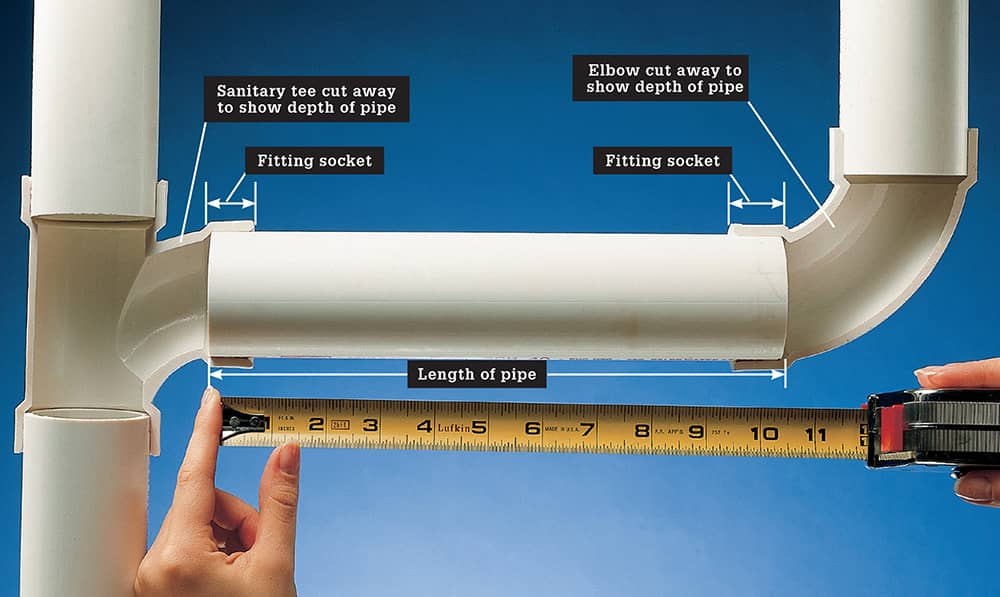
Find the length of plastic pipe needed by measuring between the bottoms of the fitting sockets (fittings shown in cutaway). Mark the length on the pipe with a felt-tipped pen.
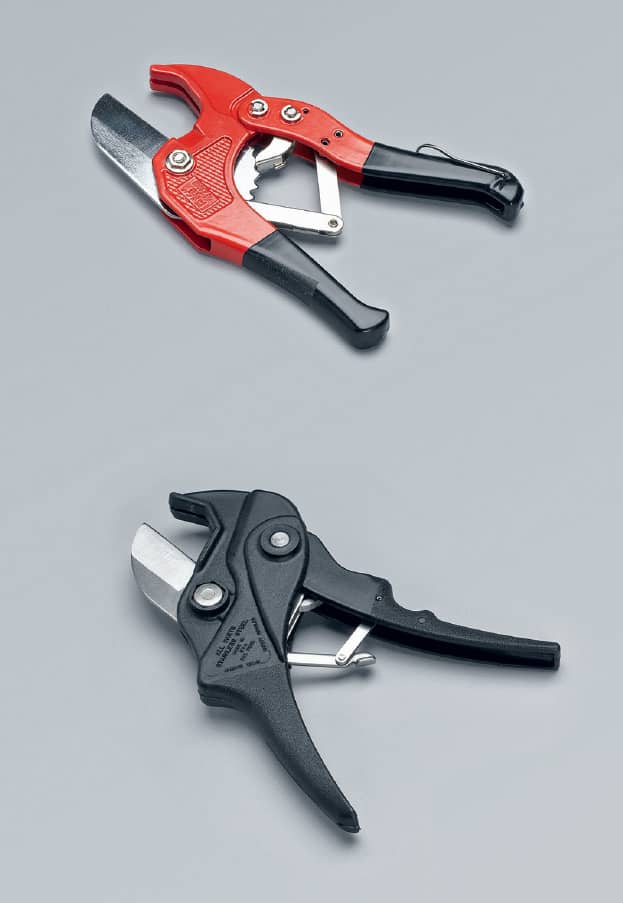
Plastic tubing cutters do a fast, neat job of cutting. You’ll probably have to go to a professional plumbing supply store to find one, however. They are not interchangeable with metal tubing cutters.
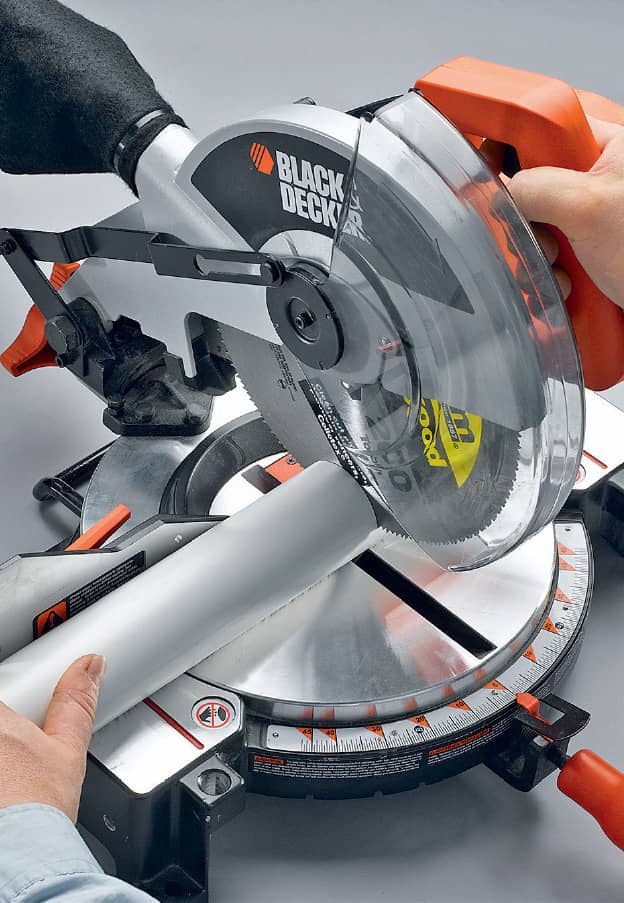
The best cutting tool for plastic pipe is a power miter saw with a fine tooth woodworking blade or a plastic-specific blade.
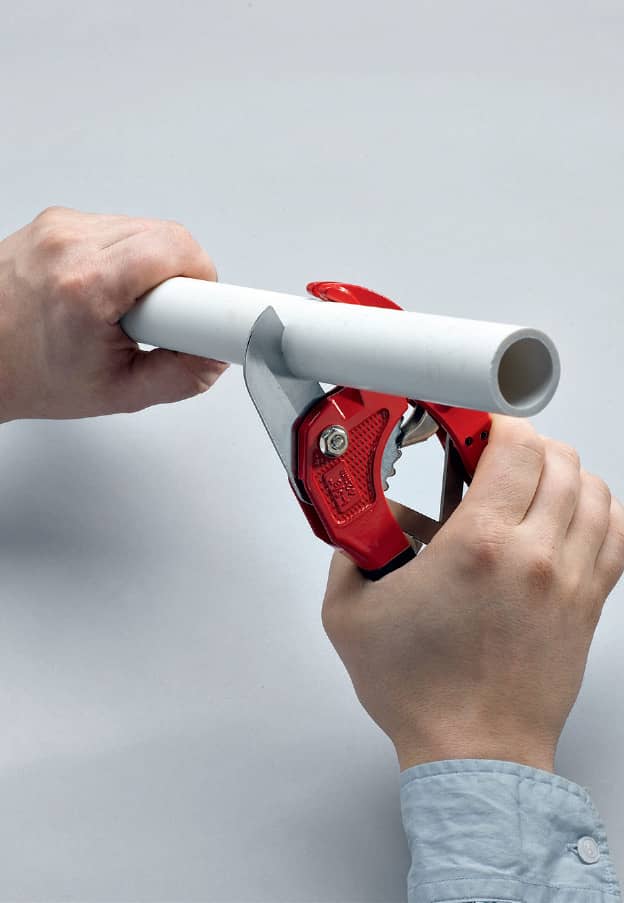
A ratcheting plastic-pipe cutter can cut smaller diameter PVC and CPVC pipe in a real hurry. They also are sold only at plumbing supply stores.
How to Solvent-Cement Rigid PVC Pipe
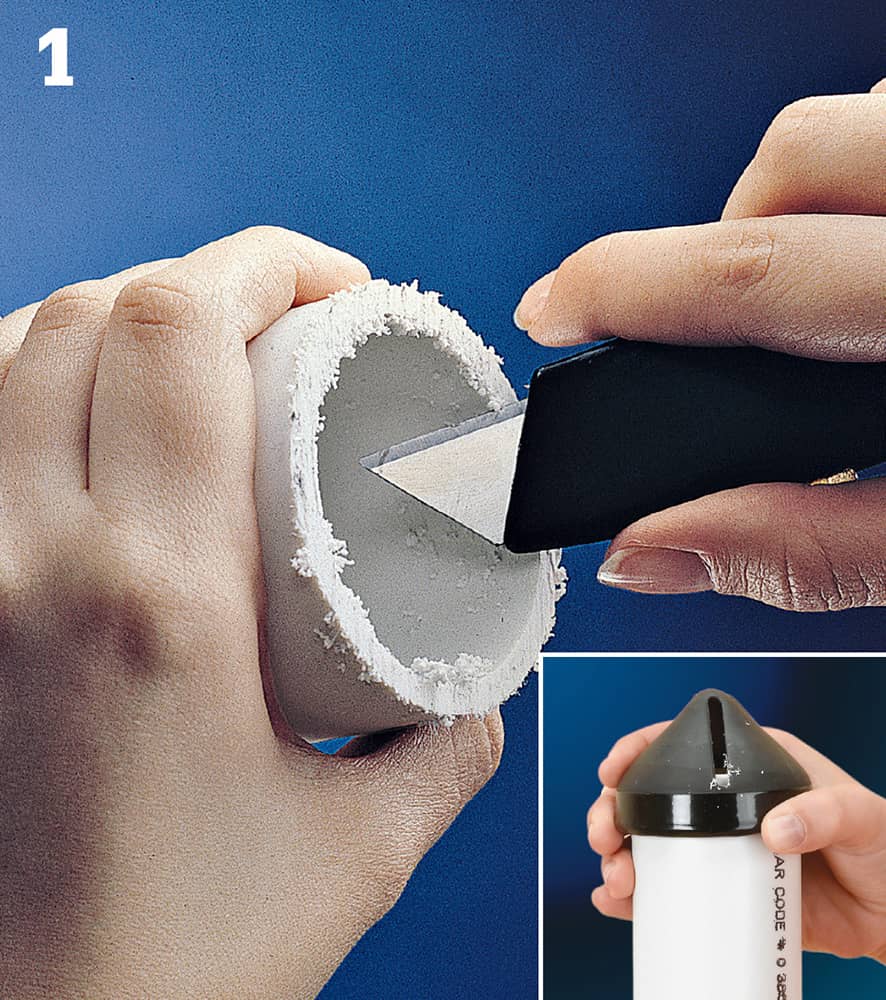
Remove rough burrs on cut ends of plastic pipe, using a utility knife or deburring tool (inset).
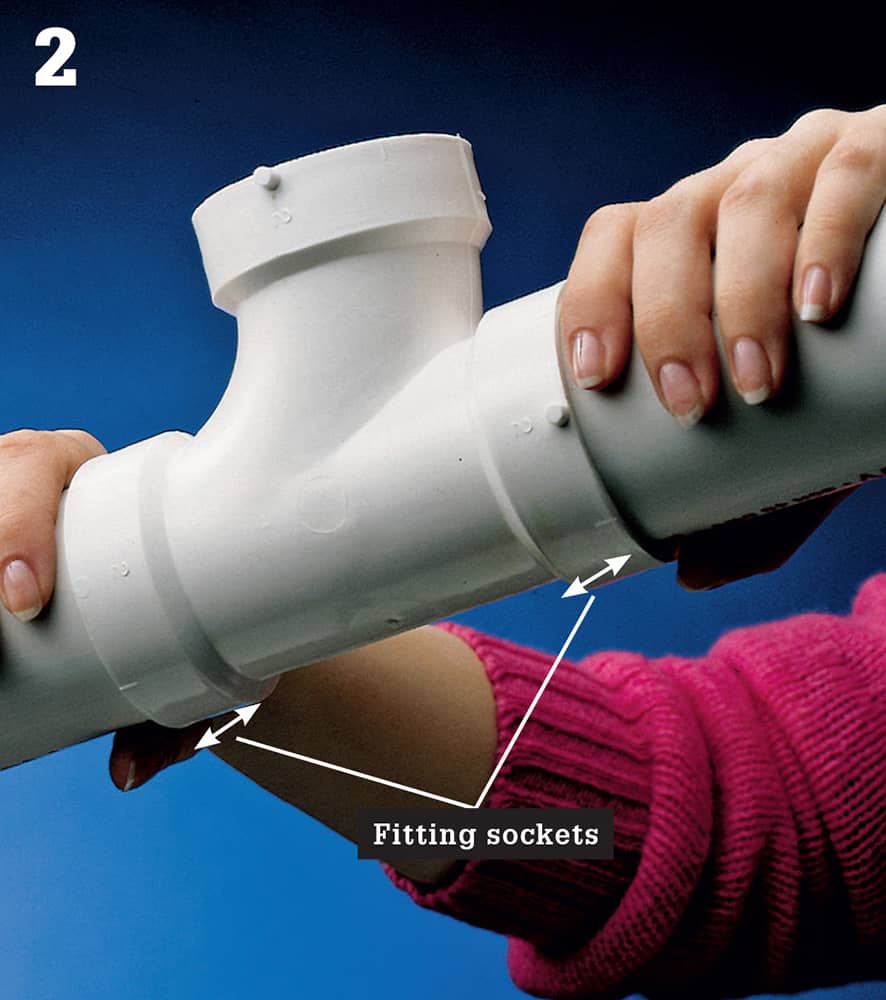
Test-fit all pipes and fittings. Pipes should fit tightly against the bottom of the fitting sockets.
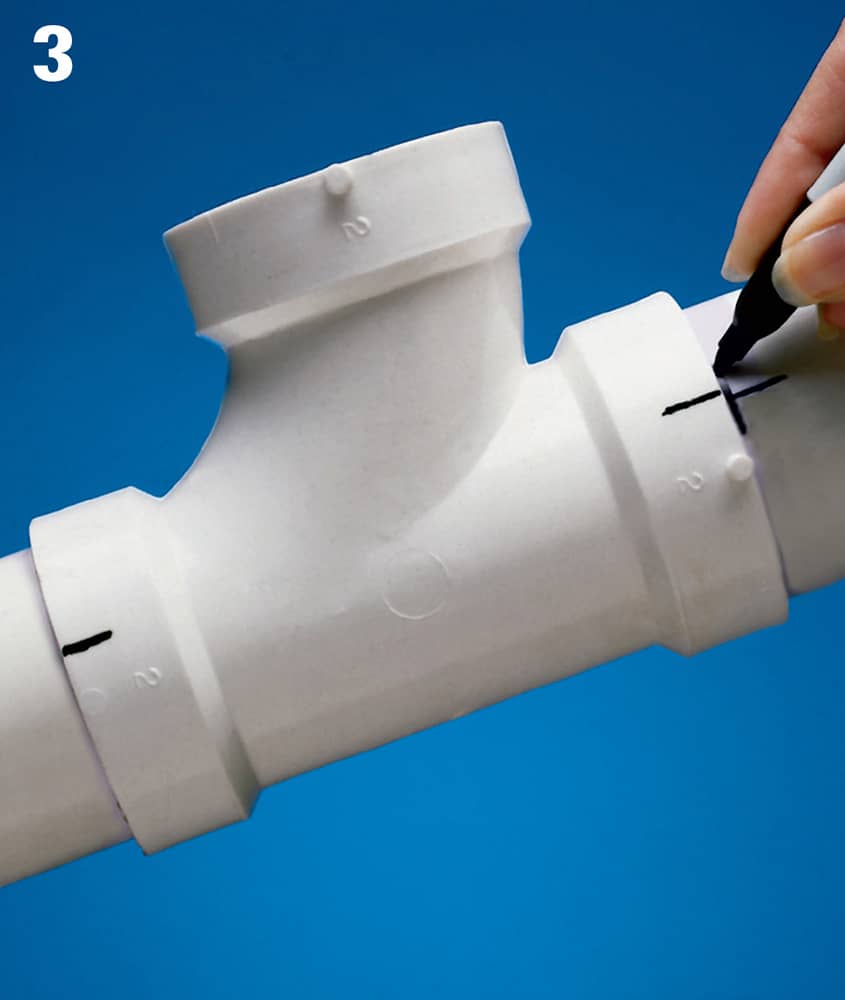
Mark the depth of the fitting sockets on the pipes. Take pipes apart. Clean the ends of the pipes and fitting sockets with emery cloth.
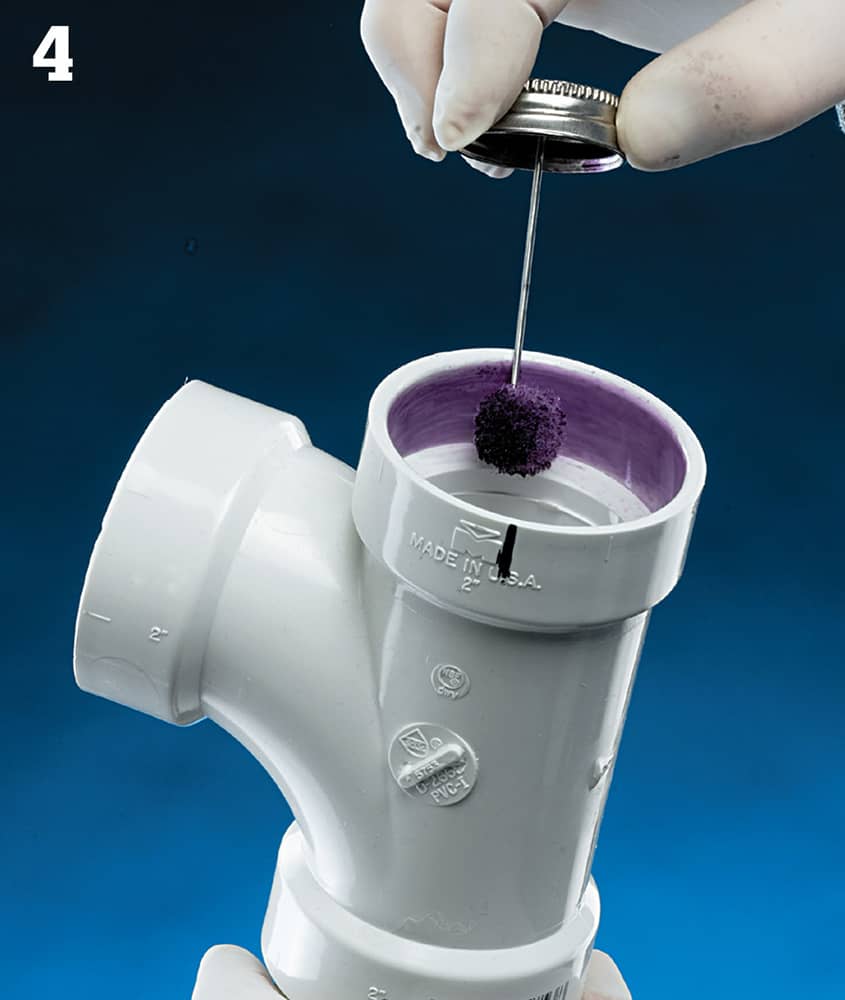
Apply a light coat of plastic pipe primer to the ends of the pipes and to the insides of the fitting sockets. Primer dulls glossy surfaces and ensures a good seal.
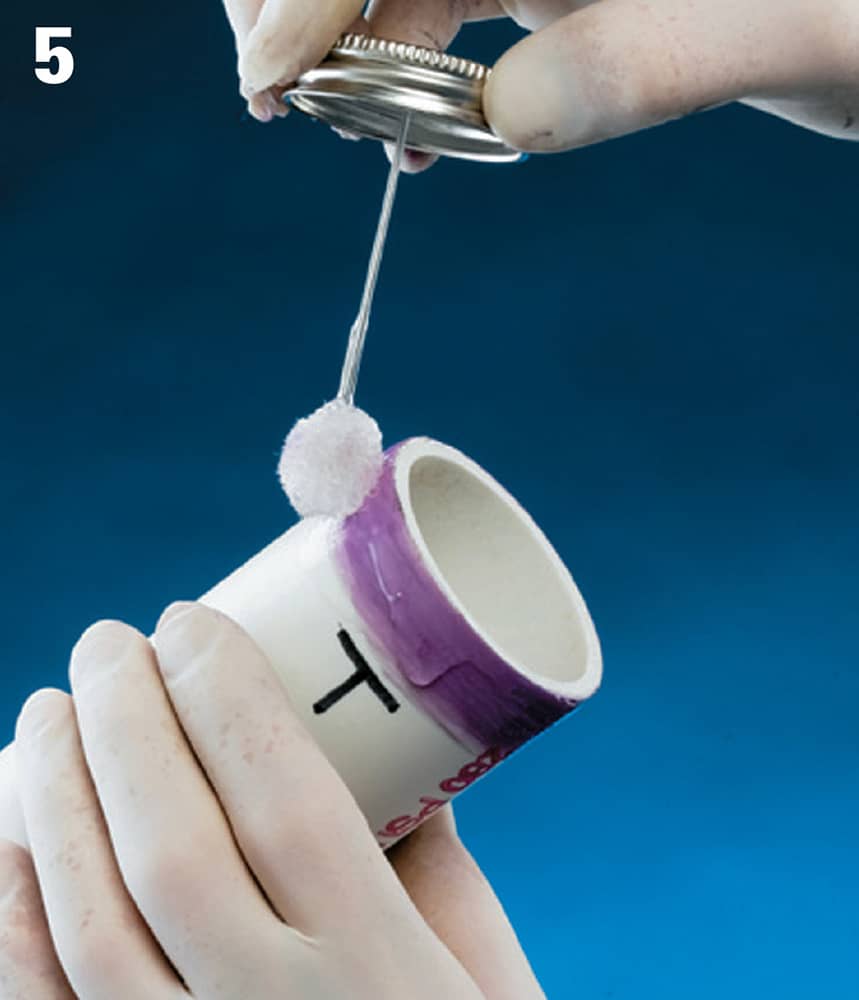
Solvent-cement each joint by applying a thick coat of solvent cement to the end of the pipe. Apply a thin coat of solvent cement to the inside surface of the fitting socket. Work quickly: solvent cement hardens in about 30 seconds.
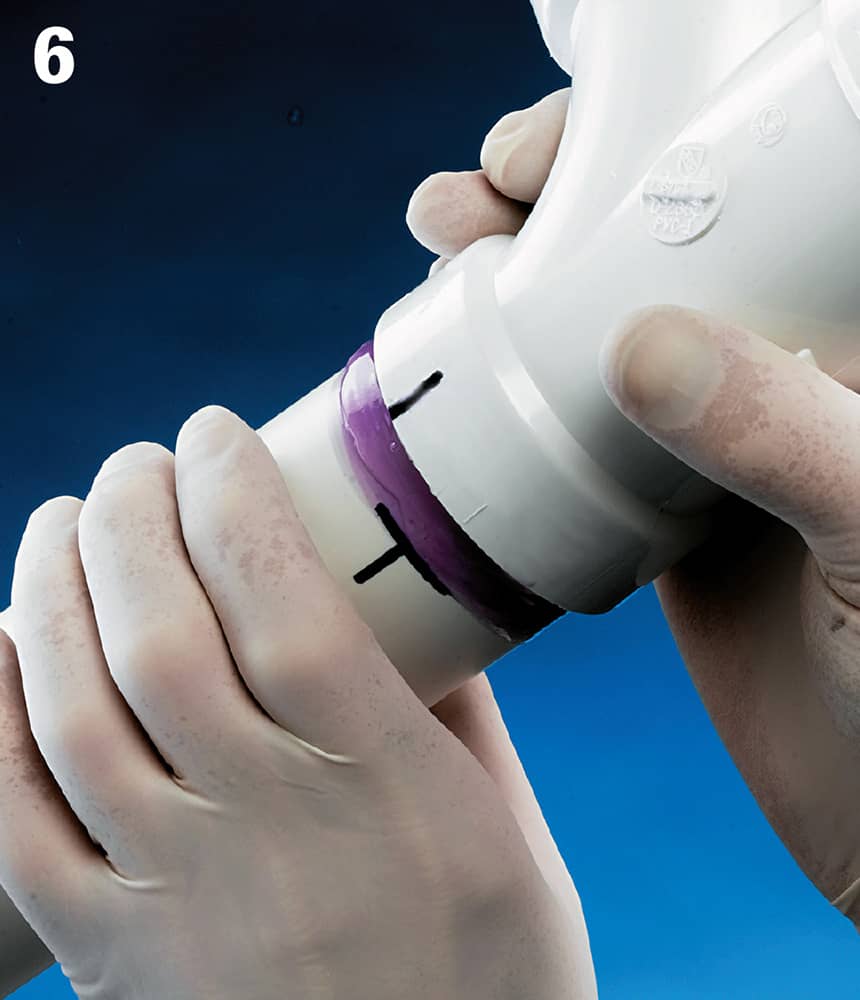
Quickly position the pipe and fitting so that the alignment marks are offset by about 2". Force the pipe into the fitting until the end fits flush against the bottom of the socket.
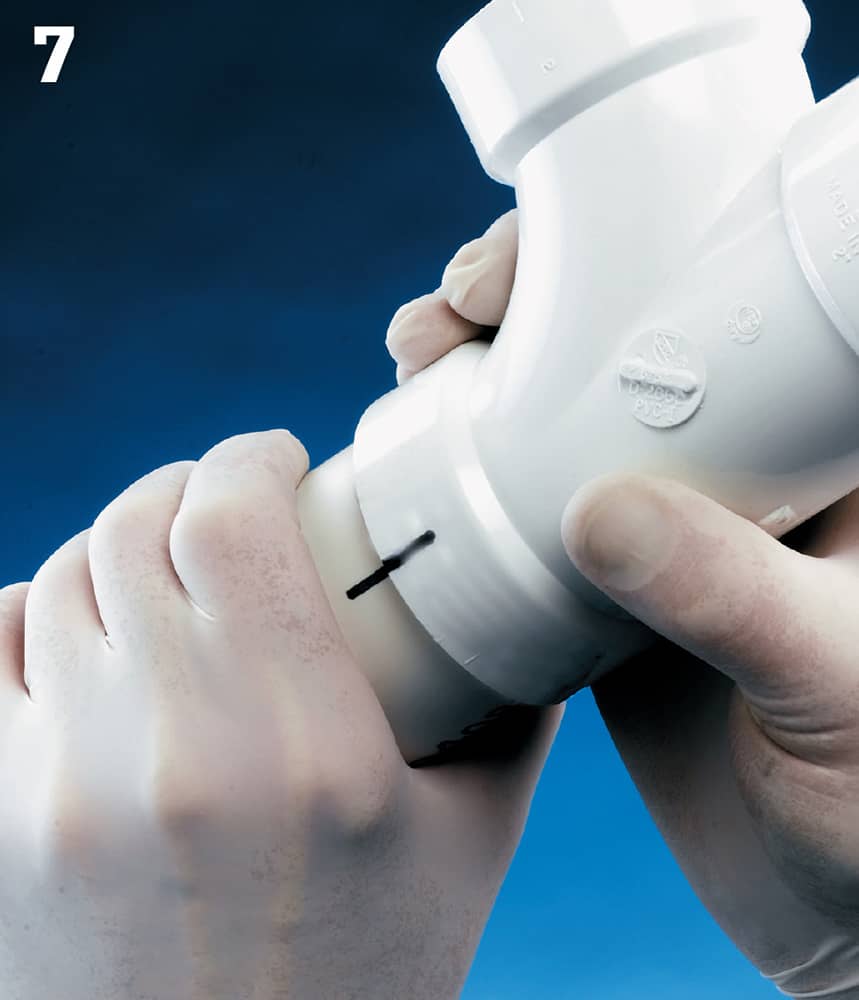
Spread solvent by twisting the pipe until the marks are aligned. Hold the pipe in place for about 20 seconds to prevent the joint from slipping.
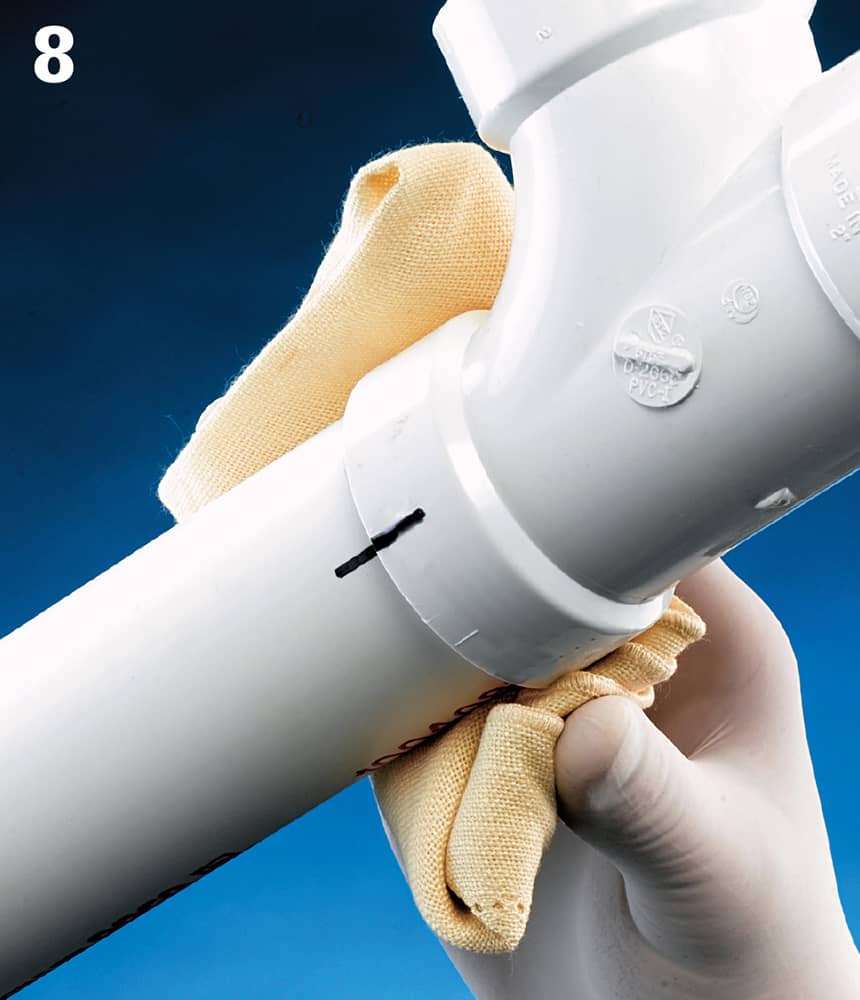
Wipe away excess solvent cement with a rag. Do not disturb the joint for 30 minutes after gluing.
 Shutoff Valves
Shutoff Valves
Worn-out shutoff valves or supply tubes can cause water to leak underneath a sink or other fixture. First, try tightening the fittings with an adjustable wrench. If this does not fix the leak, replace the shutoff valves and supply tubes.
Shutoff valves are available in several fitting types. For copper pipes, valves with compression-type fittings are easiest to install. For plastic pipes, use grip-type valves. For galvanized steel pipes, use valves with female threads.
Older plumbing systems often were installed without fixture shutoff valves. When repairing or replacing plumbing fixtures, you may want to install shutoff valves if they are not already present.
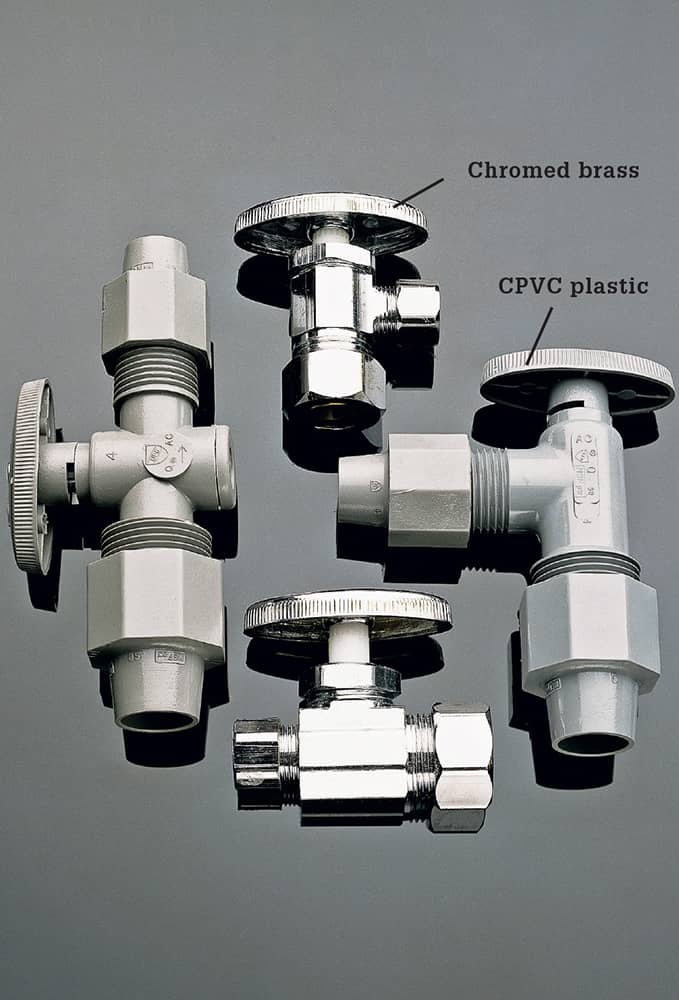
Shutoff valves allow you to shut off the water to an individual fixture so it can be repaired. They can be made from durable chromed brass or lightweight plastic. Shutoff valves come in 1/2" and 3/4" diameters to match common water pipe sizes.
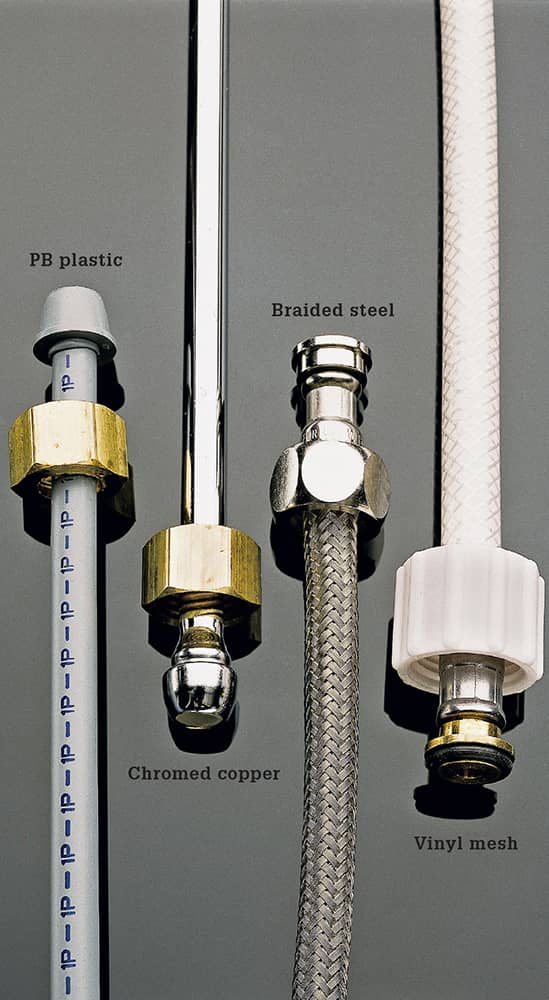
Supply tubes are used to connect water pipes to faucets, toilets, and other fixtures. They come in 12", 20", and 30" lengths. PB plastic and chromed copper tubes are inexpensive. Braided steel and vinyl mesh supply tubes are easy to install.
How to Install Shutoff Valves & Supply Tubes
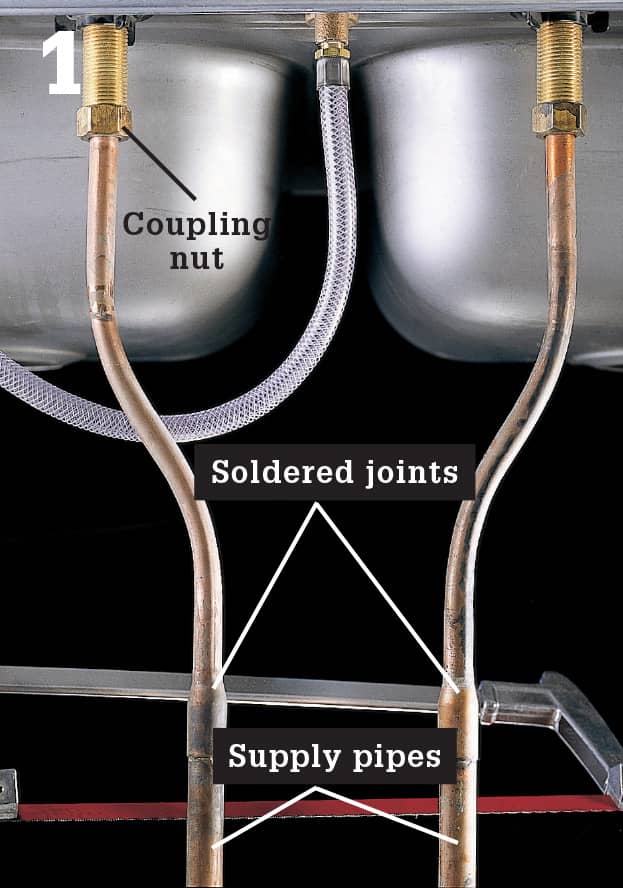
Turn off water at the main shutoff valve. Remove old supply pipes. If pipes are soldered copper, cut them off just below the soldered joint, using a hacksaw or tubing cutter. Make sure the cuts are straight. Unscrew the coupling nuts and discard the old pipes.
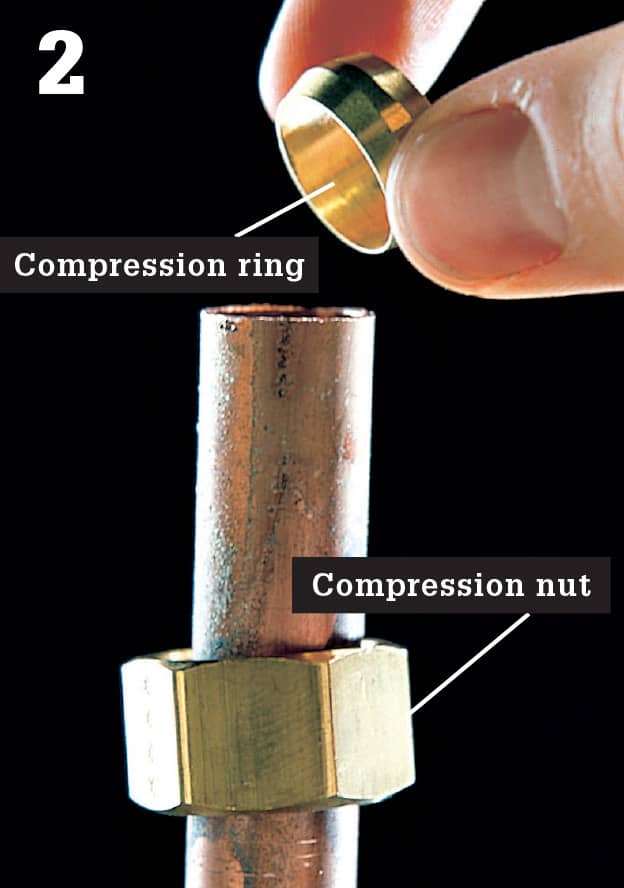
Slide a compression nut and a compression ring over the copper water pipe. Threads of the nut should face the end of the pipe.
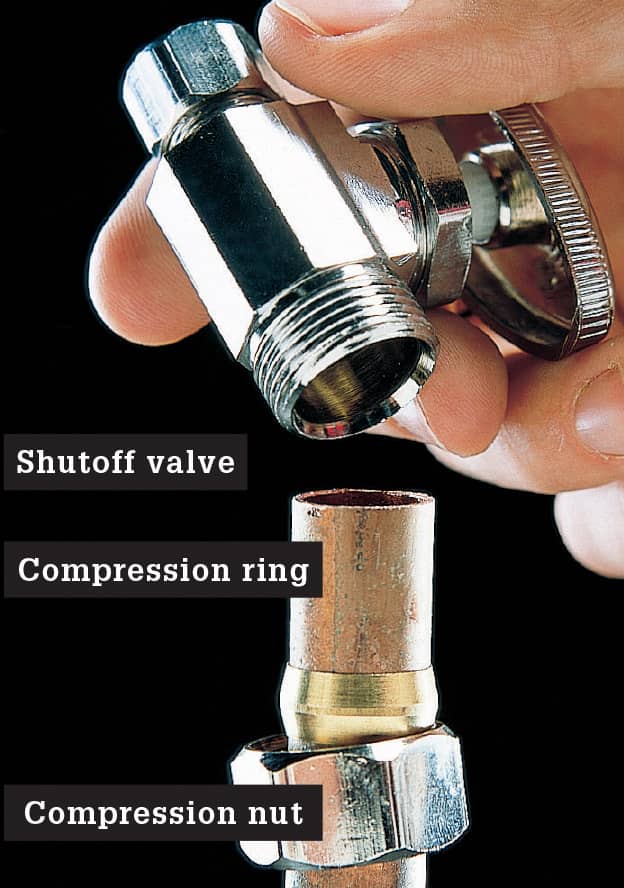
Apply pipe joint compound to the threads of the shutoff valve or compression nut. Screw the compression nut onto the shutoff valve and tighten with an adjustable wrench.
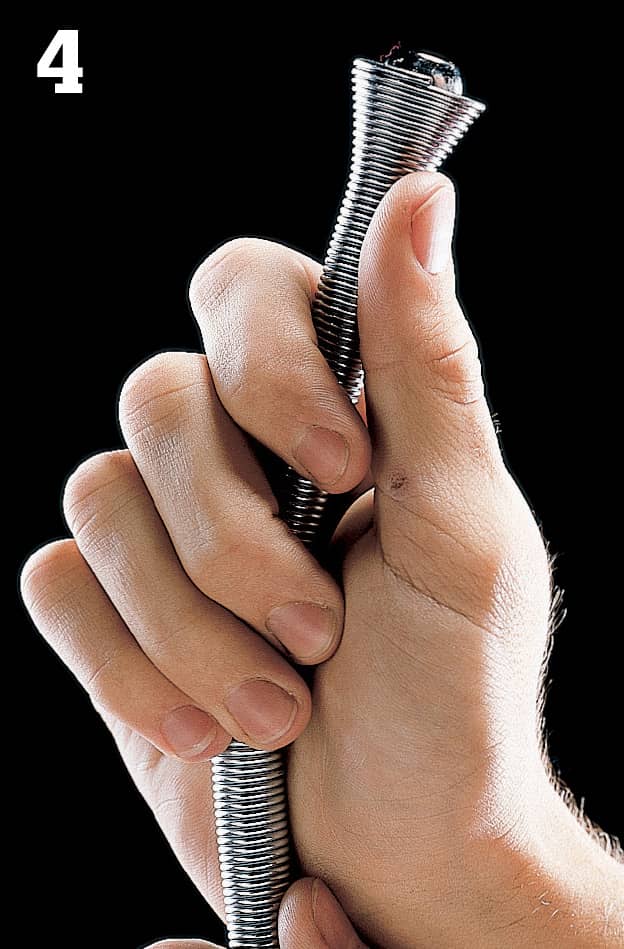
Bend chromed copper supply tube to reach from the tailpiece of the fixture to the shutoff valve, using a tubing bender. Bend the tube slowly to avoid kinking the metal.
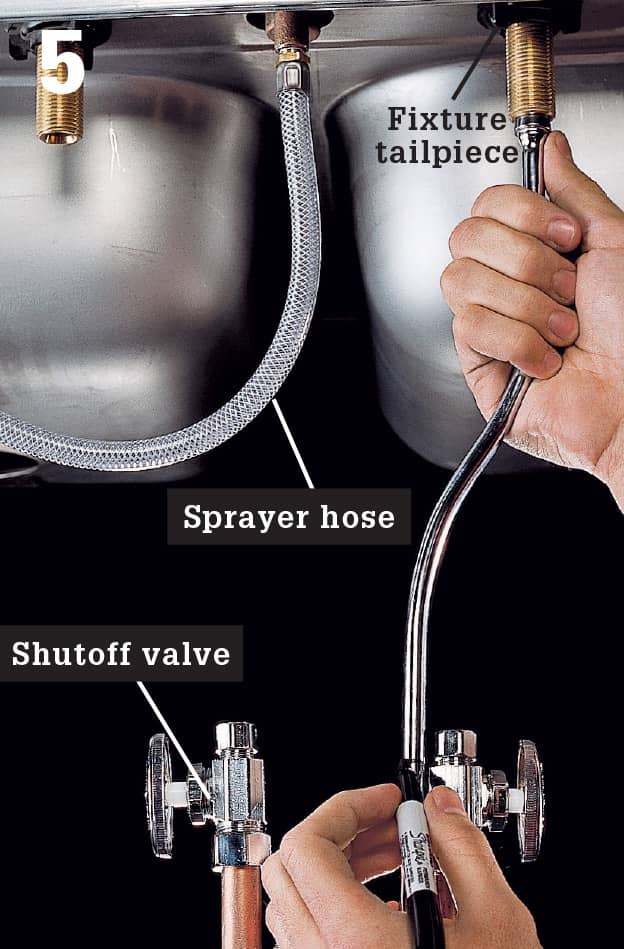
Position the supply tube between fixture tailpiece and the shutoff valve, and mark the tube to length. Cut the supply tube with a tubing cutter.
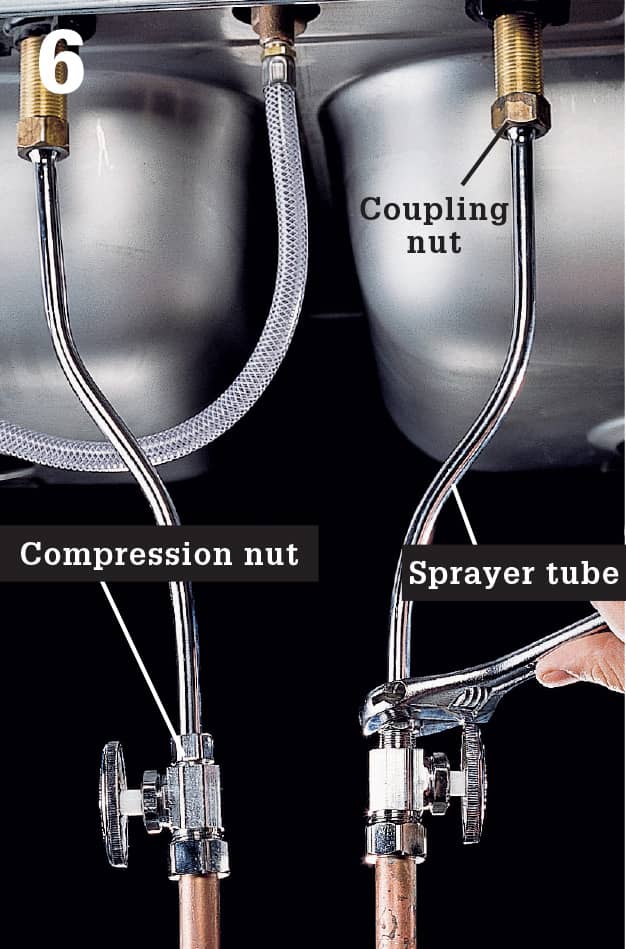
Attach the bell-shaped end of the supply tube to the fixture tailpiece with a coupling nut, then attach the other end to the shutoff valve with compression ring and nut. Tighten all fittings with an adjustable wrench.
 Compression Fittings
Compression Fittings
Compression fittings are used to make connections that may need to be taken apart. Compression fittings are easy to disconnect and are often used to install supply tubes and fixture shutoff valves. Use compression fittings in places where it is unsafe or difficult to solder, such as in crawl spaces.
Compression fittings are used most often with flexible copper pipe. Flexible copper is soft enough to allow the compression ring to seat snugly, creating a watertight seal. Compression fittings also may be used to make connections with Type M rigid copper pipe.
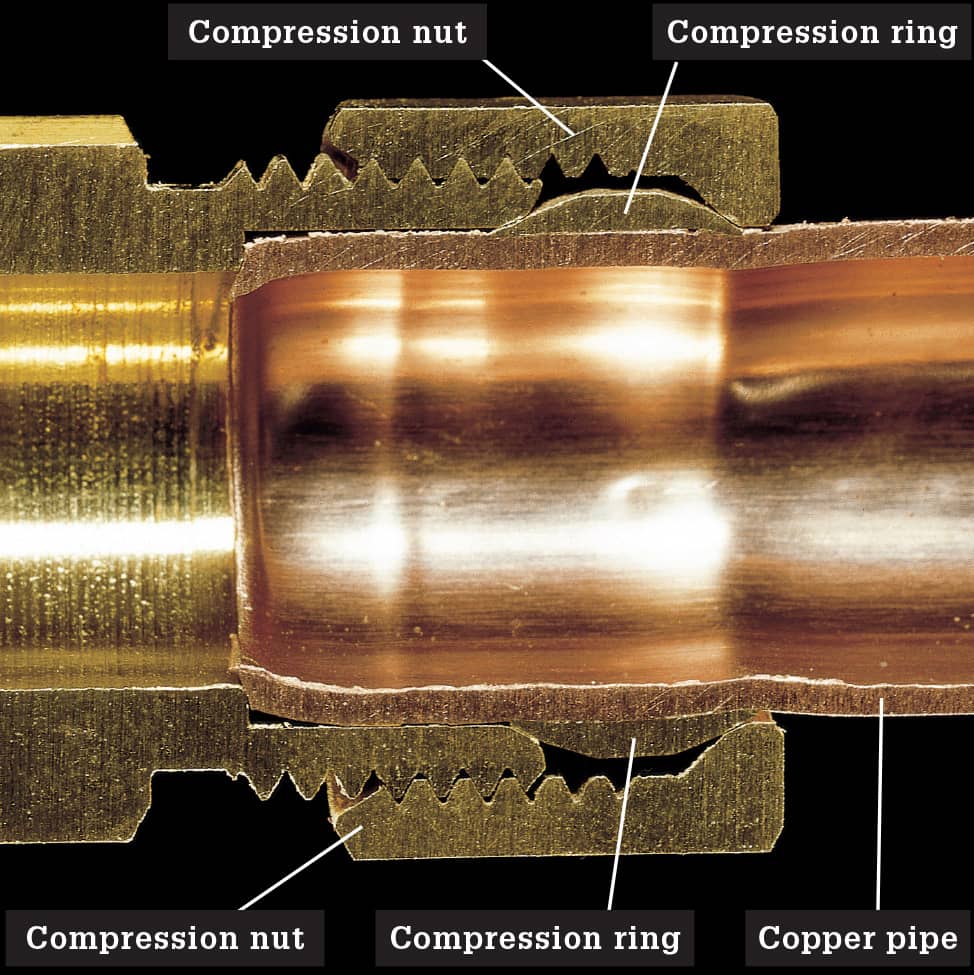
Compression fitting (shown in cutaway) shows how threaded compression nut forms seal by forcing the compression ring against the copper pipe. Compression ring is covered with pipe joint compound before assembling to ensure a perfect seal.
How to Attach Supply Tubes to Fixture Shutoff Valves with Compression Fittings
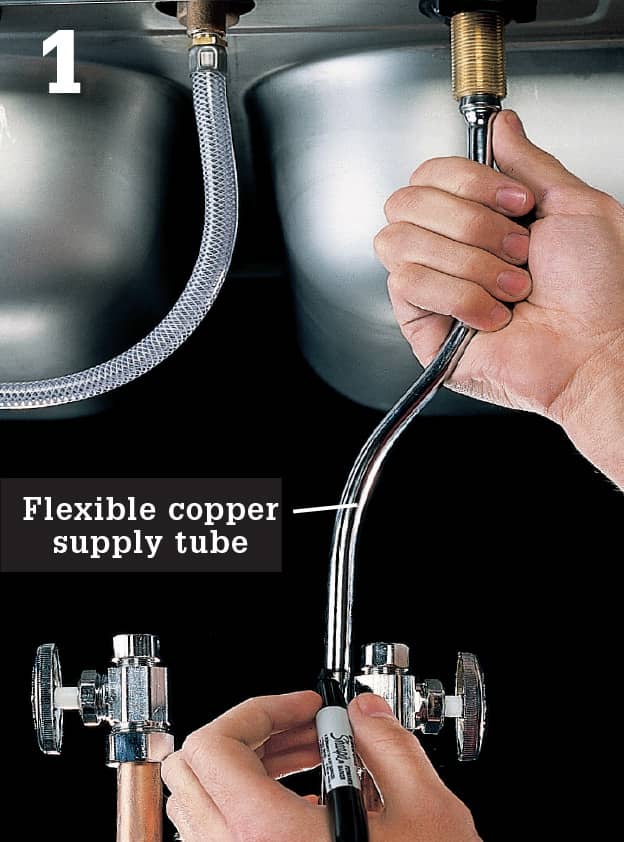
Bend flexible copper supply tube and mark to length. Include 1/2" for portion that will fit inside valve. Cut tube.
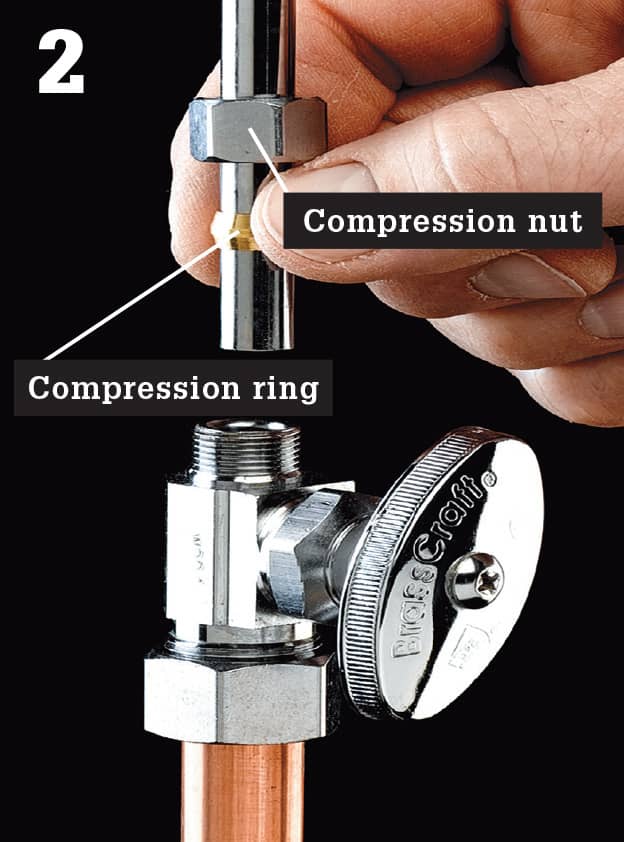
Slide the compression nut and then the compression ring over the end of the pipe. The threads of the nut should face the valve.
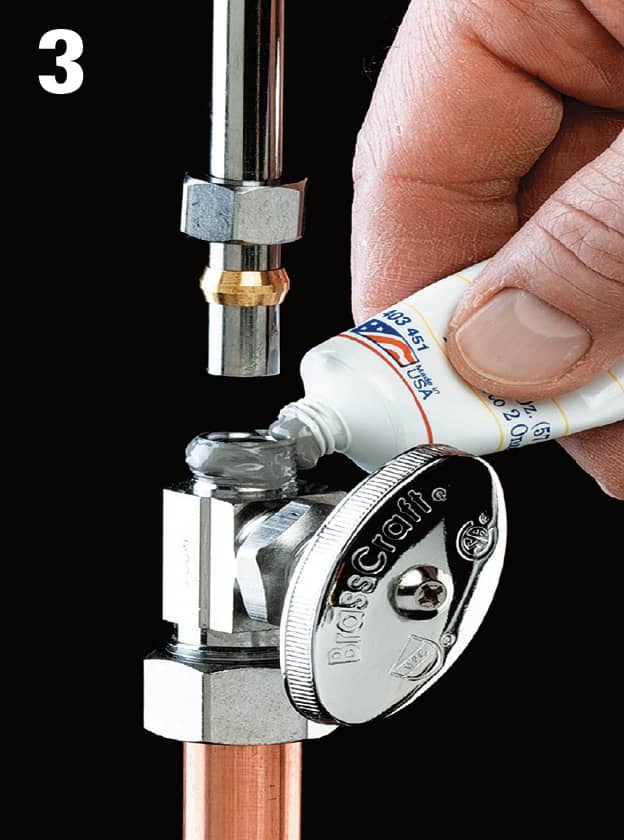
Apply a small amount of pipe joint compound to the threads. This lubricates the threads.
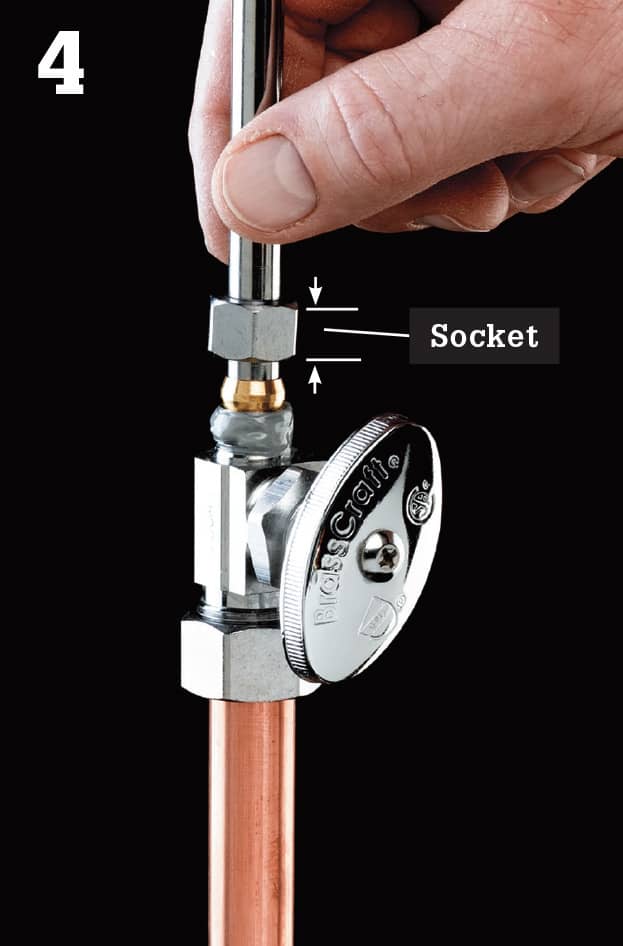
Insert the end of the pipe into the fitting so it fits flush against the bottom of the fitting socket.
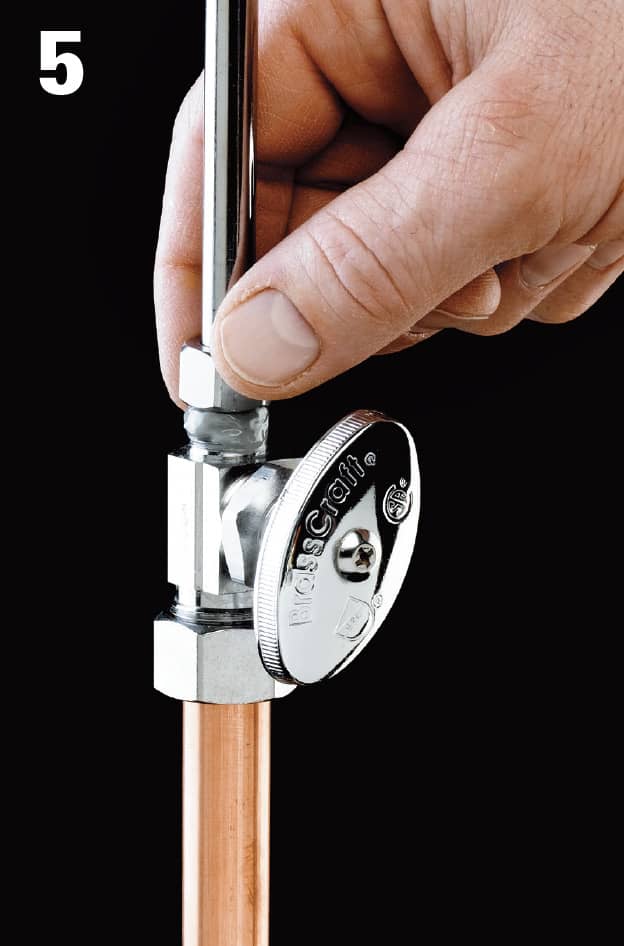
Slide the compression ring and nut against the threads of the valve. Hand tighten the nut onto the valve.
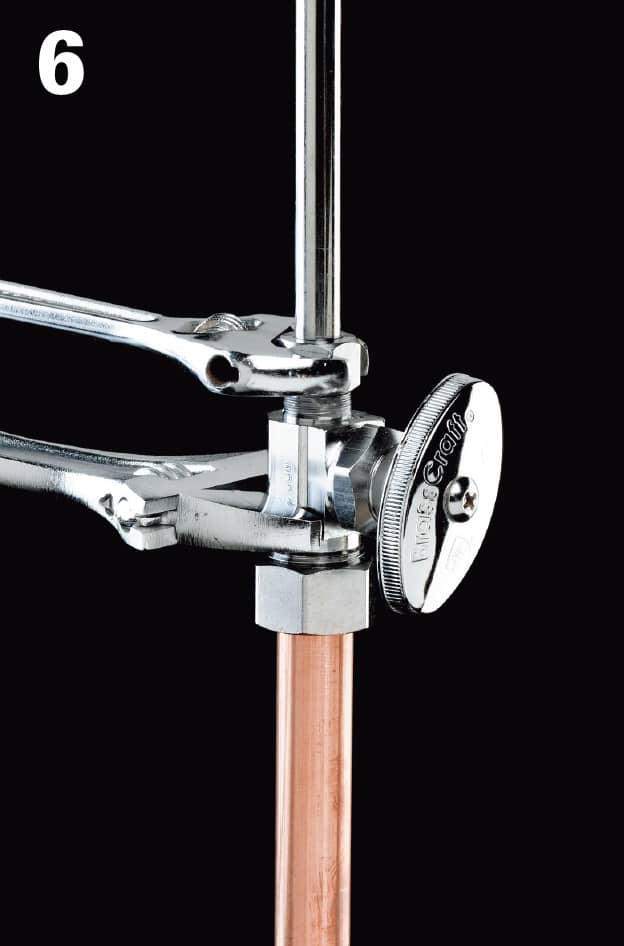
Tighten the compression nut with adjustable wrenches. Do not overtighten. Turn on the water and watch for leaks. If the fitting leaks, tighten the nut gently.
How to Join Two Copper Pipes with a Compression Union Fitting
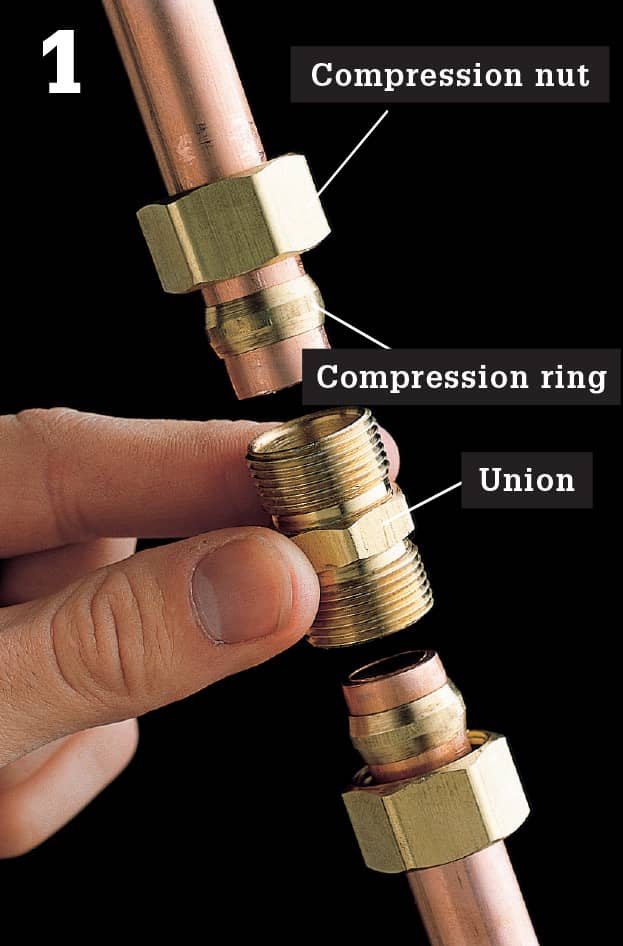
Slide compression nuts and rings over the ends of pipes. Place a threaded union between the pipes.
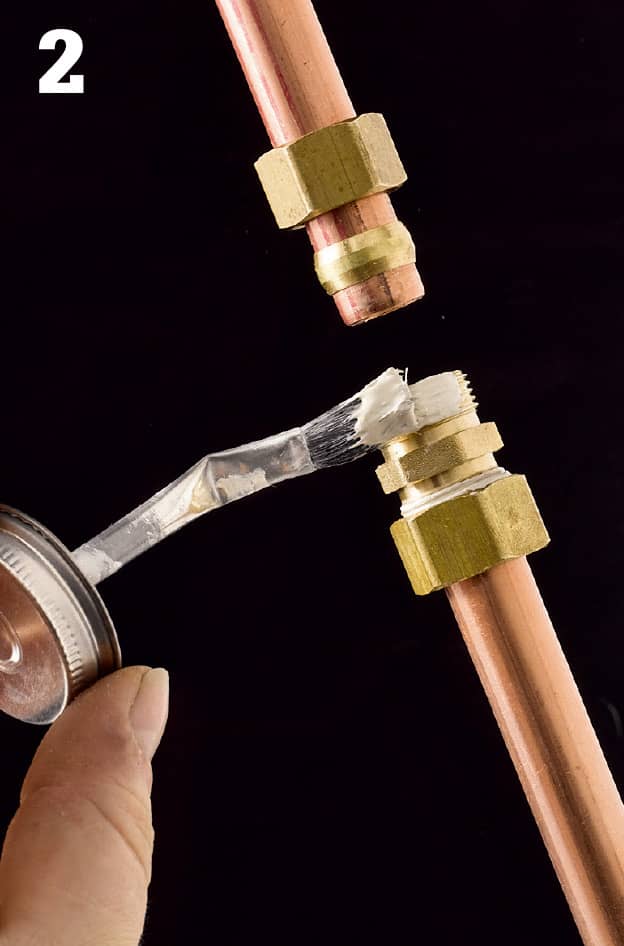
Apply a layer of pipe joint compound or Teflon tape to the union’s threads, then screw compression nuts onto the union.
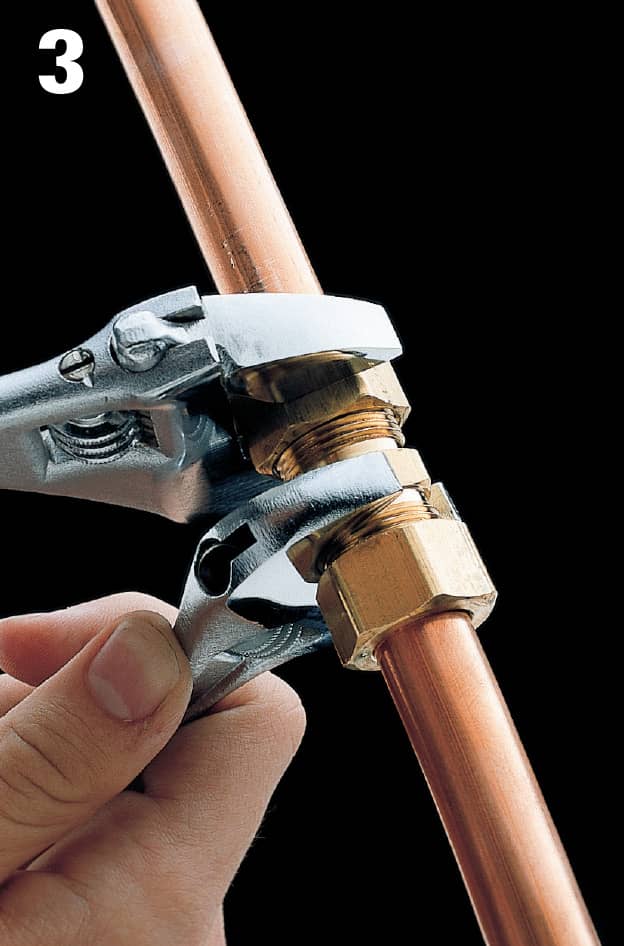
Hold the center of the union fitting with an adjustable wrench and use another wrench to tighten each compression nut one complete turn. Turn on the water. If the fitting leaks, tighten the nuts gently.
 Fixing Common Toilet Problems
Fixing Common Toilet Problems
A clogged toilet is one of the most common plumbing problems. If a toilet overflows or flushes sluggishly, clear the clog with a plunger or closet auger. If the problem persists, the clog may be in a branch drain or a drainage stack (pages 292 to 293).
Most other toilet problems are fixed easily with minor adjustments that require no disassembly or replacement parts. You can make these adjustments in a few minutes, using simple tools (page 299).
If minor adjustments do not fix the problem, further repairs will be needed. The parts of a standard toilet are not difficult to take apart, and most repair projects can be completed in less than an hour.
A recurring puddle of water on the floor around a toilet may be caused by a crack in the toilet base or in the tank. A damaged toilet should be replaced. Installing a new toilet is an easy project that can be finished in three or four hours.
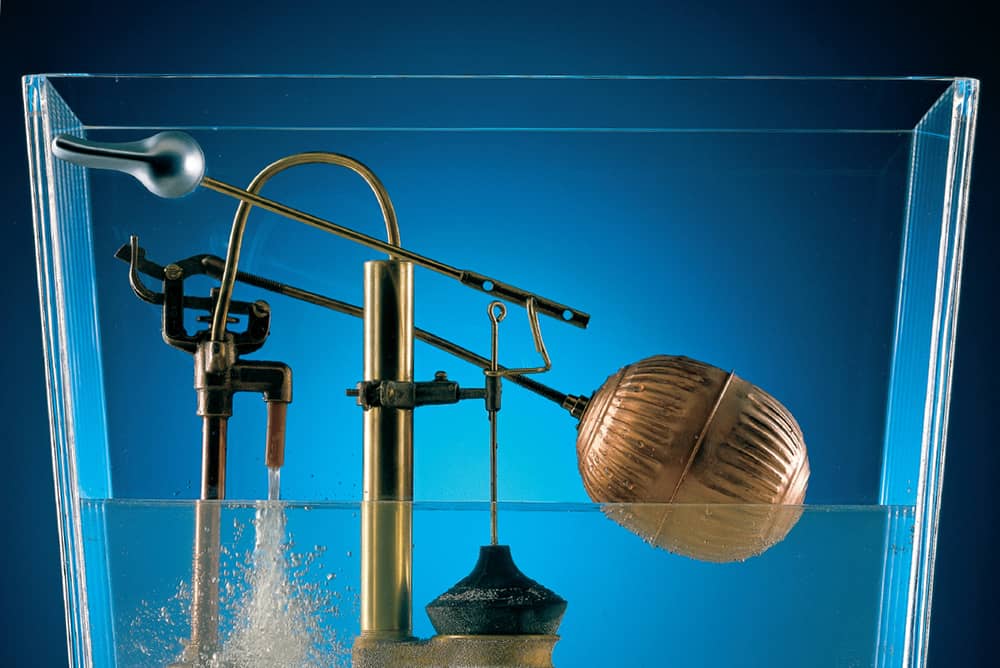
An older toilet may have a tank ball that settles onto the flush valve to stop the flow of water into the bowl. The ball is attached to a lift wire, which is in turn attached to the lift rod. A ballcock valve is usually made of brass, with rubber washers that can wear out. If the ballcock valve malfunctions, you might be able to find old washers to repair it, but replacing both the ballcock and the tank ball with a float-cup assembly and flapper is easier and makes for a more durable repair.
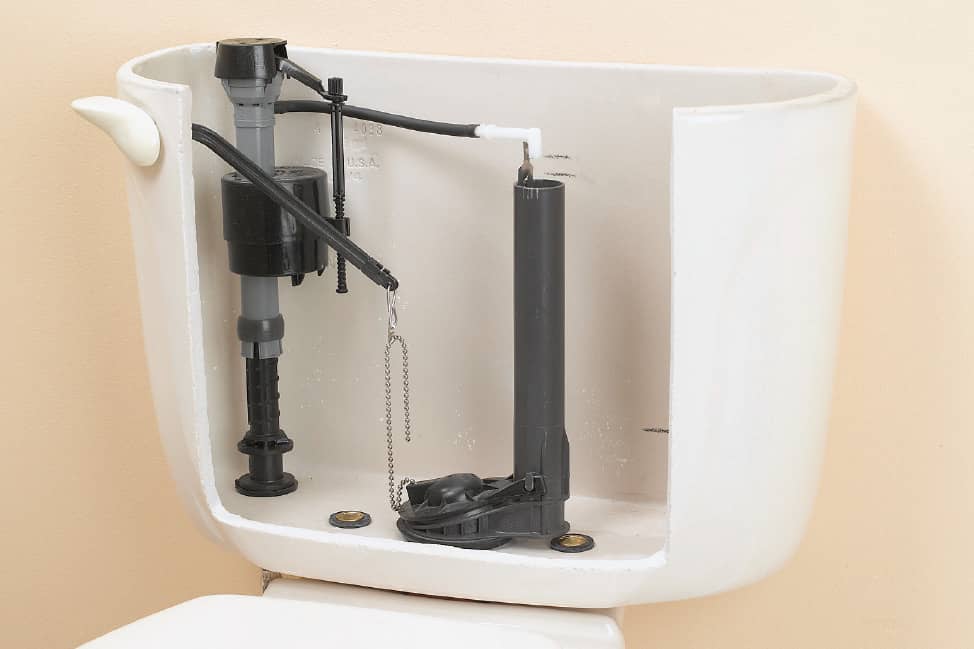
A modern float-cup valve with flapper is inexpensive and made of plastic, but is more reliable than an old ballcock valve and ball.
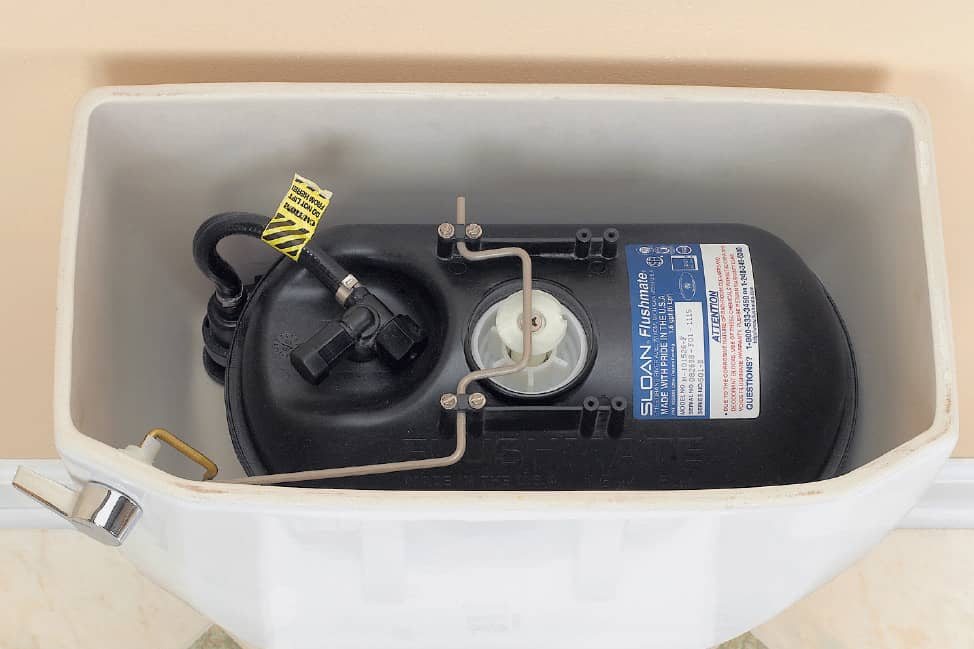
A pressure-assist toilet has a large vessel that nearly fills the tank. As water enters the vessel, pressure builds up. When the toilet is flushed, this pressure helps push water forcefully down into the bowl. As a result, a pressure-assist toilet provides strong flushing power with minimal water consumption.
Making Minor Adjustments
Many common toilet problems can be fixed by making minor adjustments to the handle and the attached lift chain (or lift wires).
If the handle sticks or is hard to push, remove the tank cover and clean the handle-mounting nut. Make sure the lift wires are straight.
If the toilet will not flush completely unless the handle is held down, you may have to remove excess slack in the lift chain.
If the toilet will not flush at all, the lift chain may be broken or may have to be reattached to the handle lever.
A continuously running toilet (opposite page) can be caused by bent lift wires, kinks in a lift chain, or lime buildup on the handle mounting nut. Clean and adjust the handle and the lift wires or chain to fix the problem.
How to Adjust a Toilet Handle & Lift Chain (or Lift Wires)
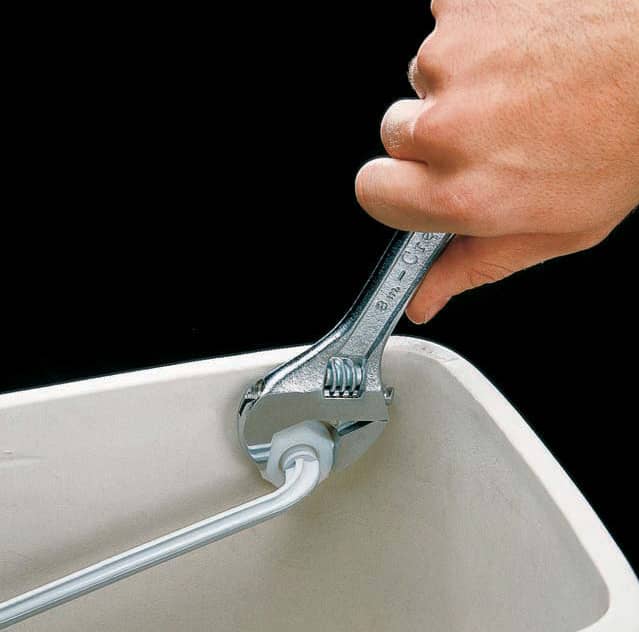
Clean and adjust handle-mounting nut so handle operates smoothly. Mounting nut has reversed threads. Loosen nut by turning clockwise; tighten by turning counterclockwise. Remove lime buildup with a brush dipped in vinegar.
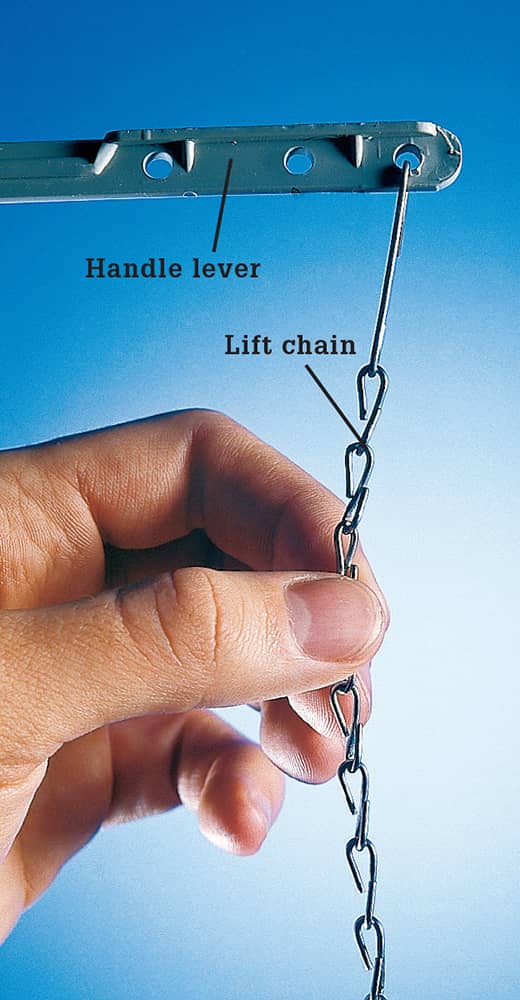
Adjust lift chain so it hangs straight from handle lever, with about 1/2" of slack. Remove excess slack in chain by hooking the chain in a different hole in the handle lever or by removing links with needlenose pliers. A broken lift chain must be replaced.
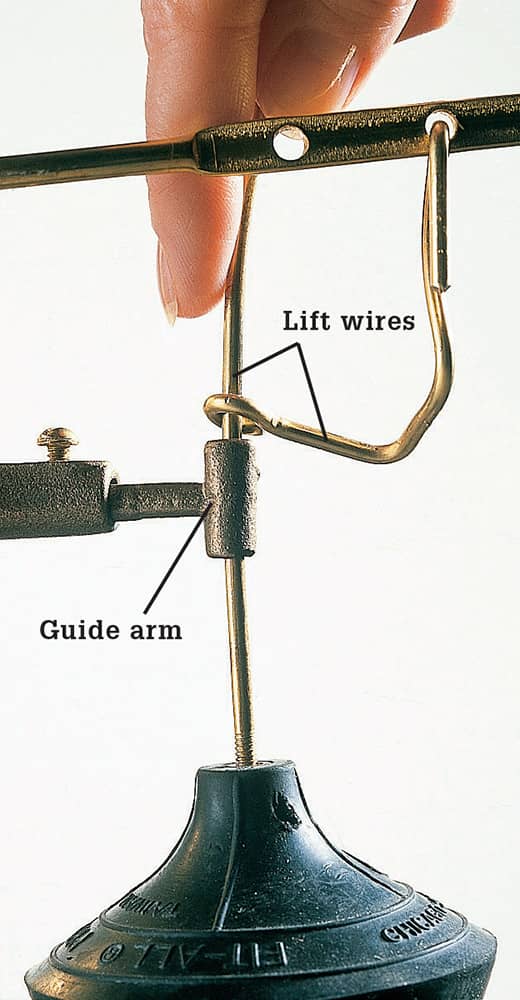
Adjust lift wires (found on older toilets without lift chains) so that wires are straight and operate smoothly when handle is pushed. A sticky handle often can be fixed by straightening bent lift wires. You can also buy replacement wires, or replace the whole assembly with a float cup.
Reset Tank Water Level
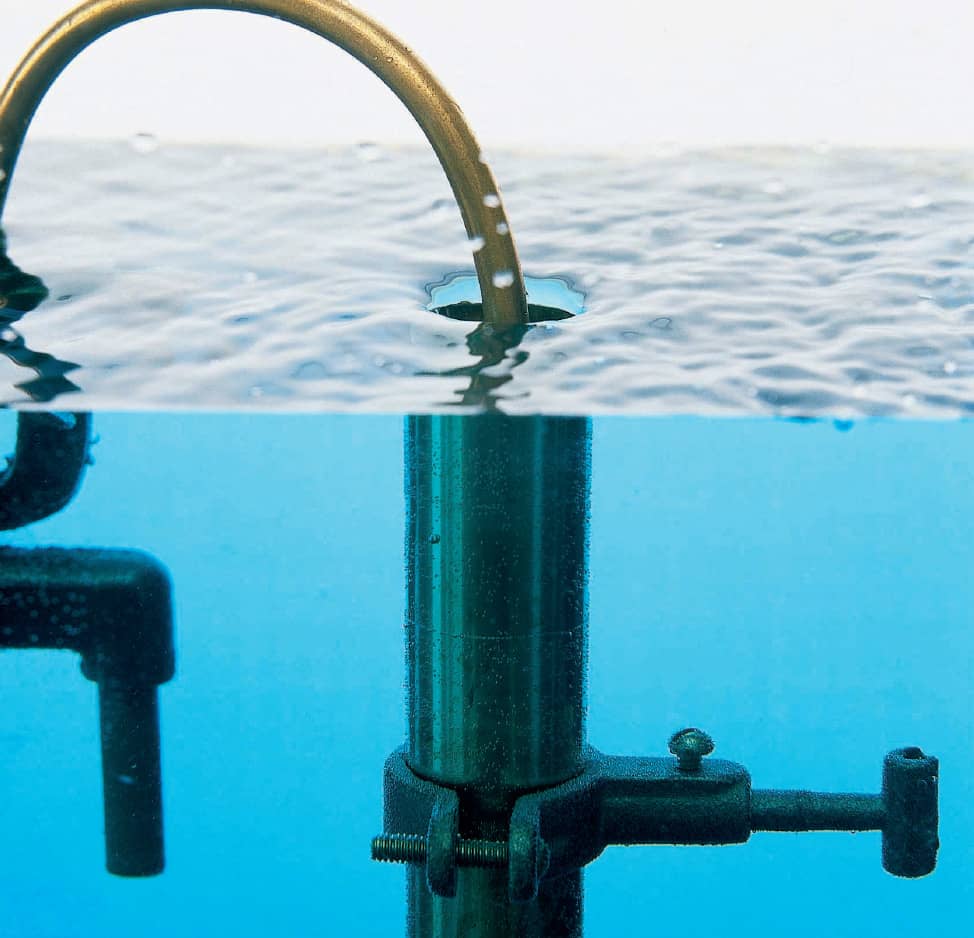
Tank water flowing into the overflow pipe is the sound we hear when a toilet is running. Usually, this is caused by a minor misadjustment that fails to tell the water to shut off when the toilet tank is full. The culprit is a float ball or cup that is adjusted to set a water level in the tank that’s higher than the top of the overflow pipe, which serves as a drain for excess tank water. The other photos on this page show how to fix the problem.
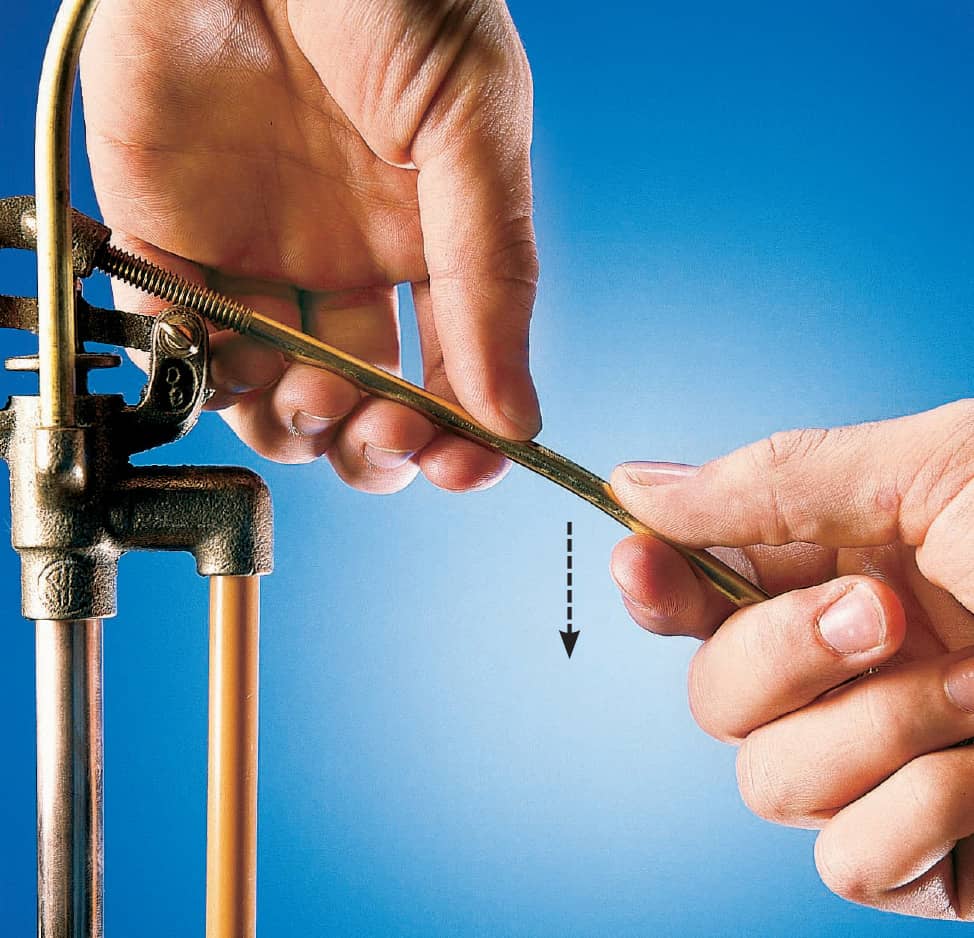
A ball float is connected to a float arm that’s attached to a plunger on the other end. As the tank fills, the float rises and lifts one end of the float arm. At a certain point, the float arm depresses the plunger and stops the flow of water. By simply bending the float arm downward a bit, you can cause it to depress the plunger at a lower tank water level, solving the problem.
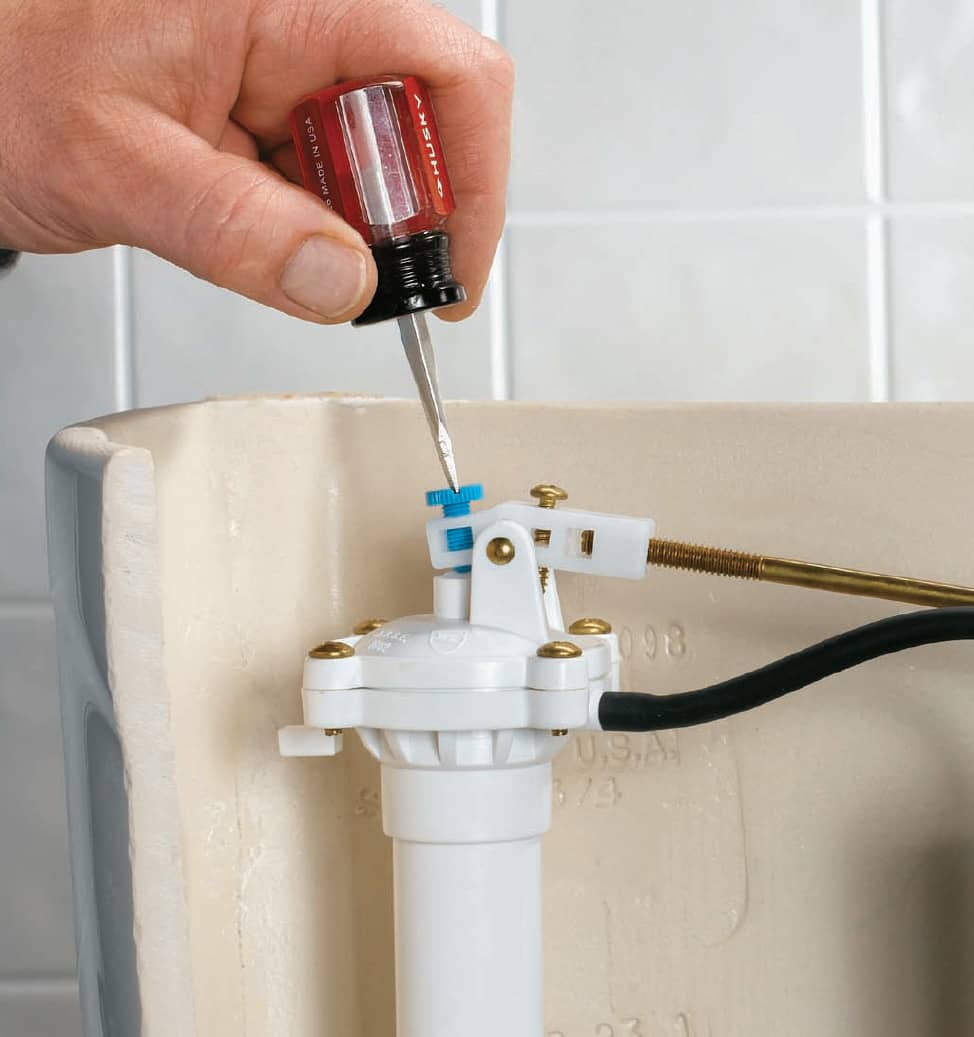
A diaphragm fill valve usually is made of plastic and has a wide bonnet that contains a rubber diaphragm. Turn the adjustment screw clockwise to lower the water level and counterclockwise to raise it.
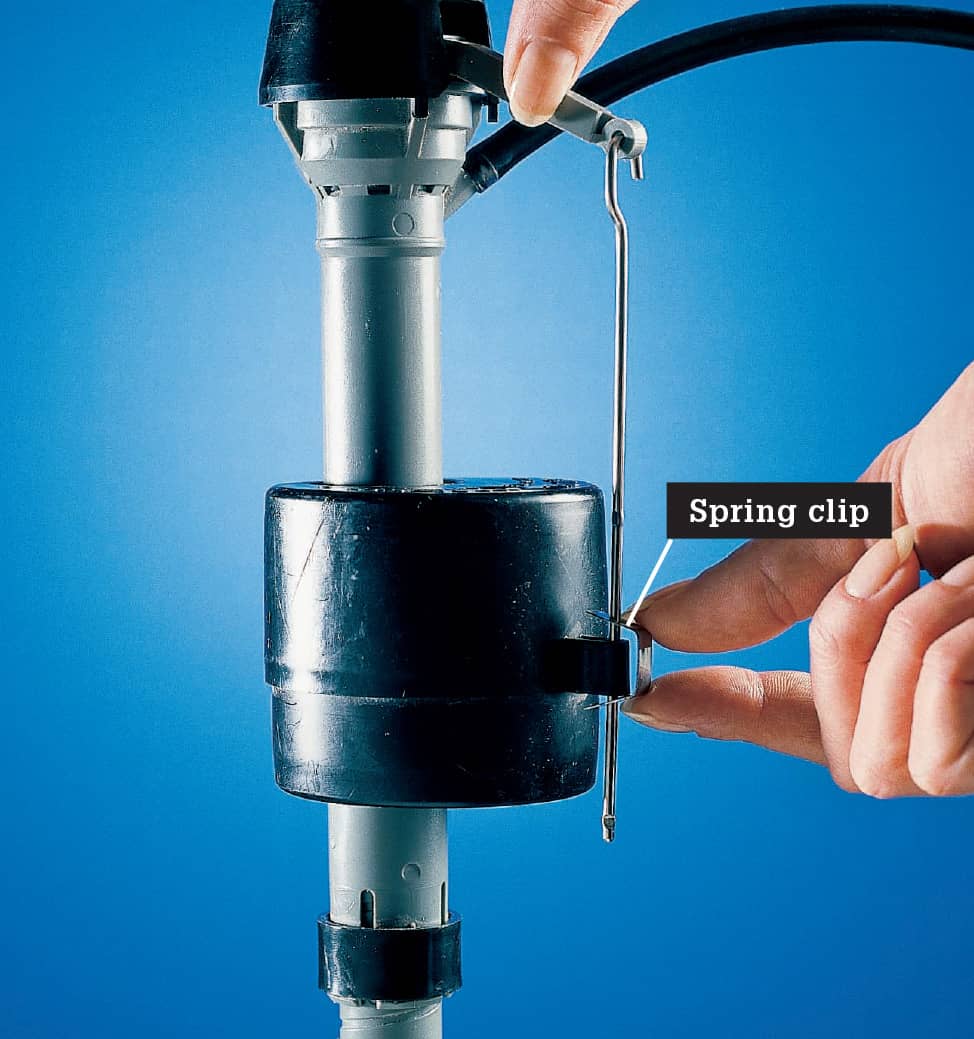
A float cup fill valve is made of plastic and is easy to adjust. Lower the water level by pinching the spring clip with fingers or pliers and moving the clip and cup down the pull rod and shank. Raise the water level by moving the clip and cup upward.
How to Replace a Fill Valve
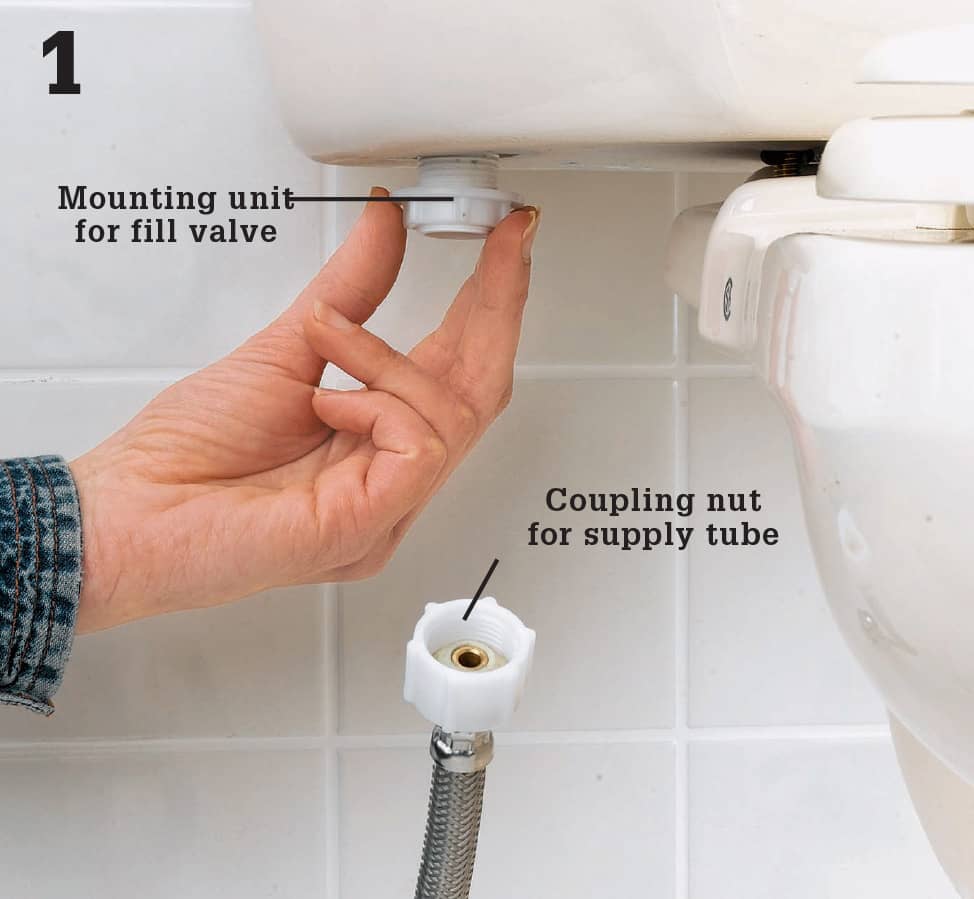
Toilet fill valves wear out eventually. They can be repaired, but it’s easier and a better fix to just replace them. Before removing the old fill valve, shut off the water supply at the fixture stop valve located on the tube that supplies water to the tank. Flush the toilet and sponge out the remaining water. Loosen the nut and disconnect the supply tube, then loosen and remove the mounting nut.
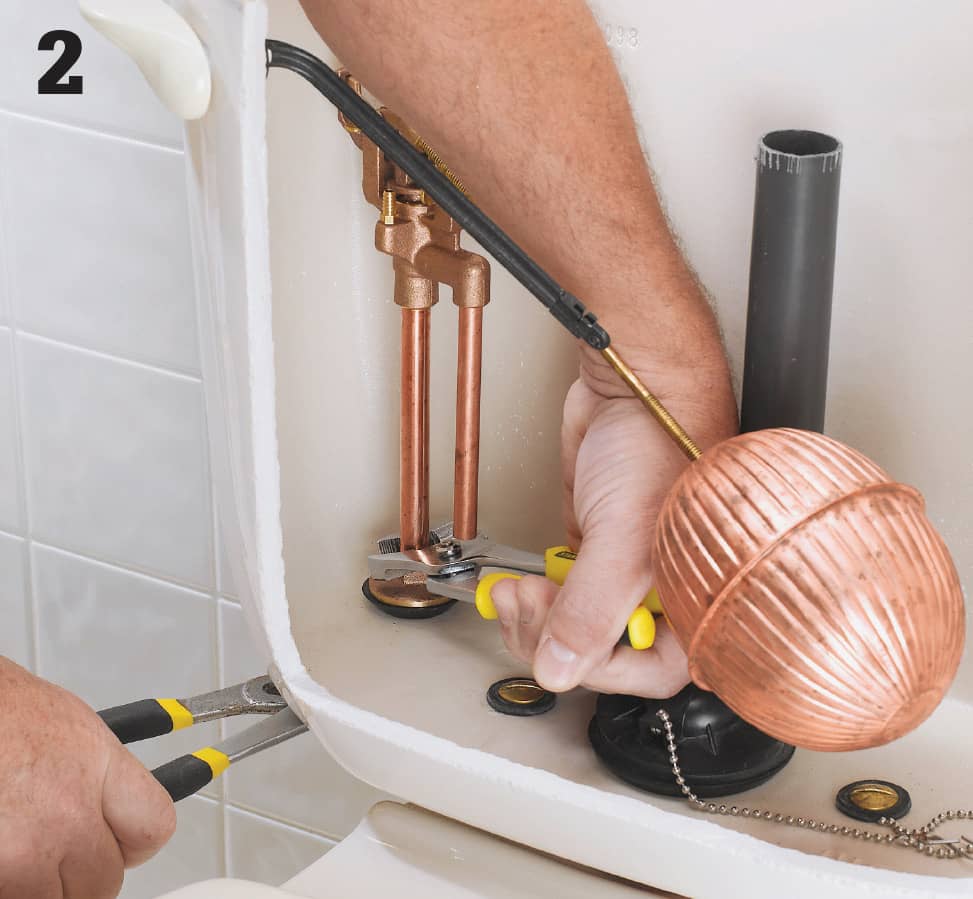
If the fill valve spins while you turn the mounting nut, you may need to hold it still with locking pliers. Lift out the fill valve. In the case of an old ballcock valve, the float ball will likely come out as well. When replacing an old valve like this, you will likely also need to replace the flush valve (see page 326).
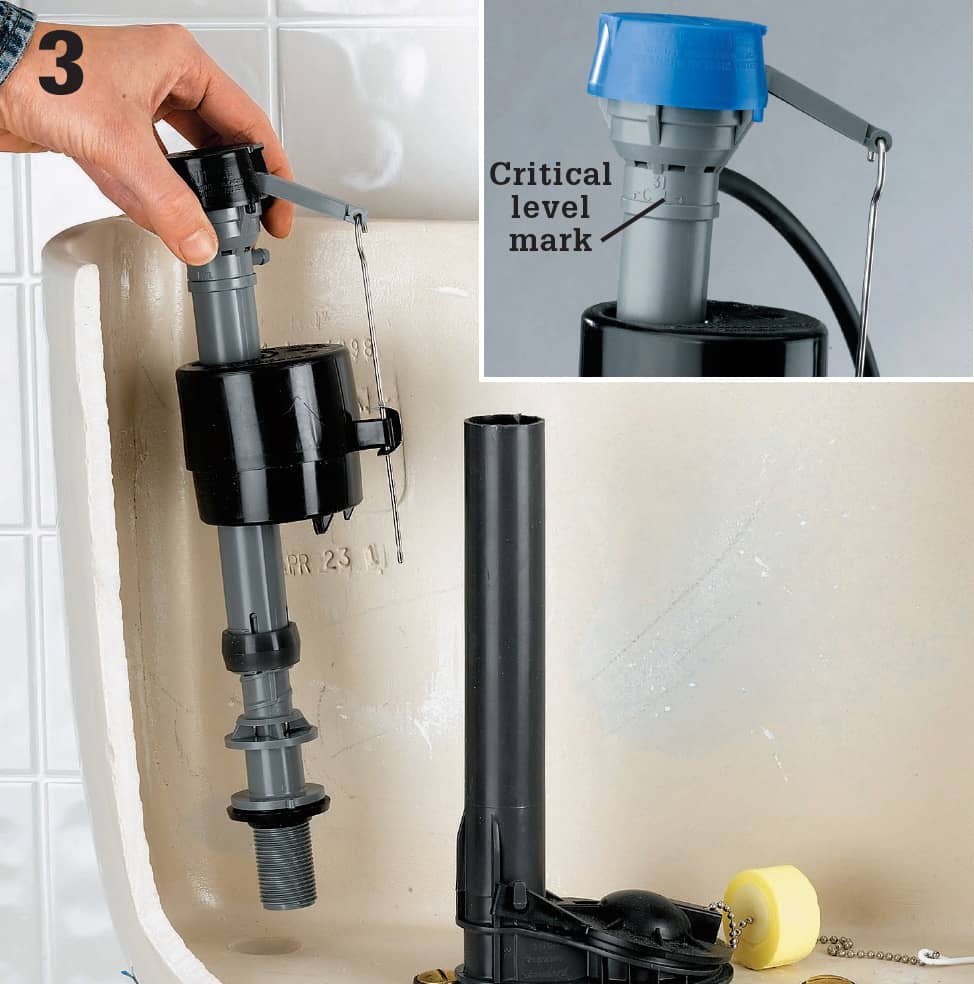
The new fill valve must be installed so the critical level (“CL”) mark is at least 1" above the overflow pipe (see inset). Slip the shank washer on the threaded shank of the new fill valve and place the valve in the hole so the washer is flat on the tank bottom. Compare the locations of the “CL” mark and the overflow pipe.
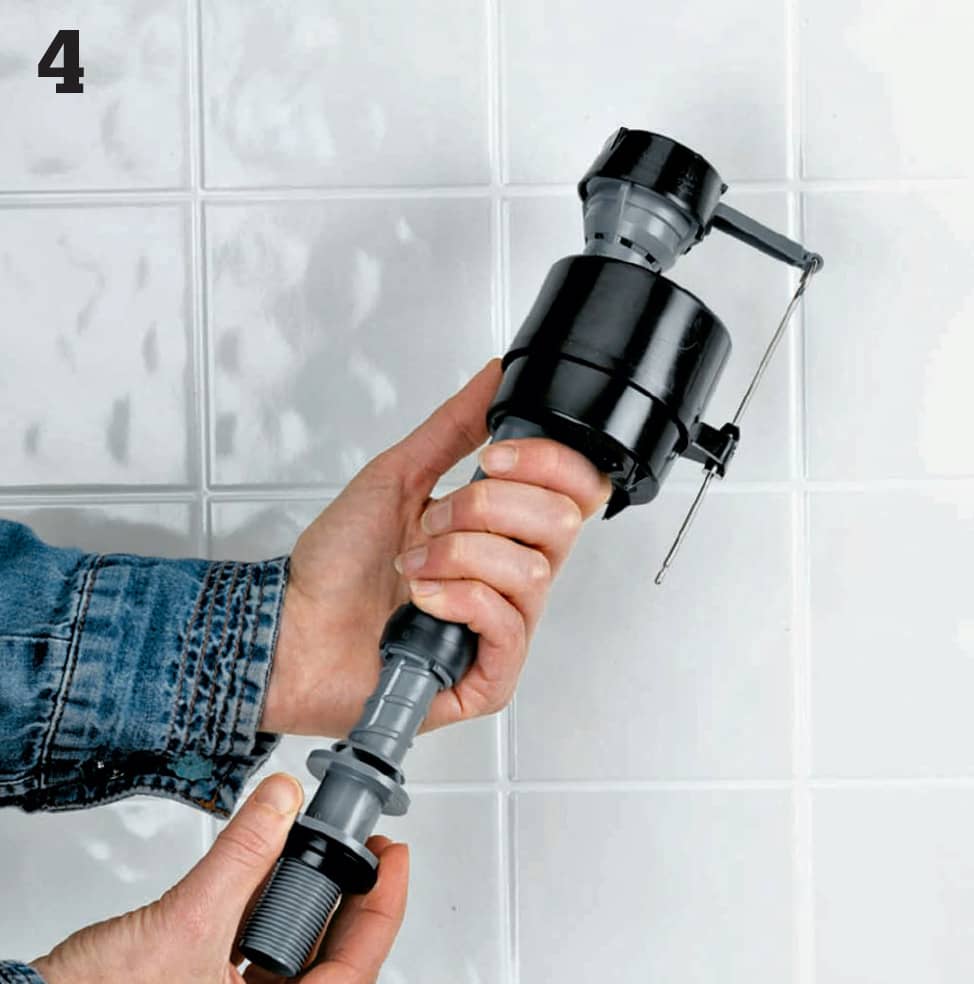
Adjust the height of the fill valve shank so the “CL” line and overflow pipe will be correctly related. Different products are adjusted in different ways—the fill valve shown here telescopes when it’s twisted.
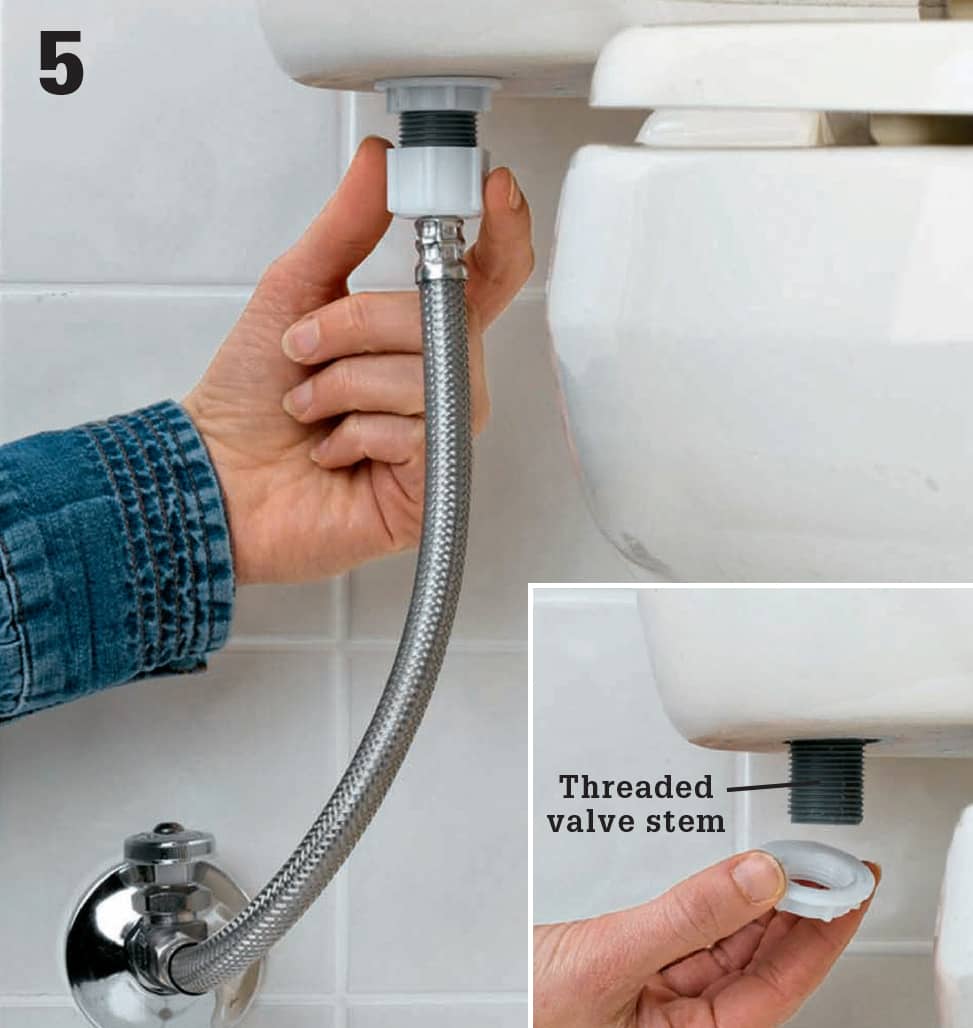
Slip the valve’s threaded end down through the tank. Push down on its shank (not the top) while tightening the locknut (inset). Hand tighten, then use a wrench to make an extra 1/4 turn. Hook up the water supply tube, and tighten in the same way.
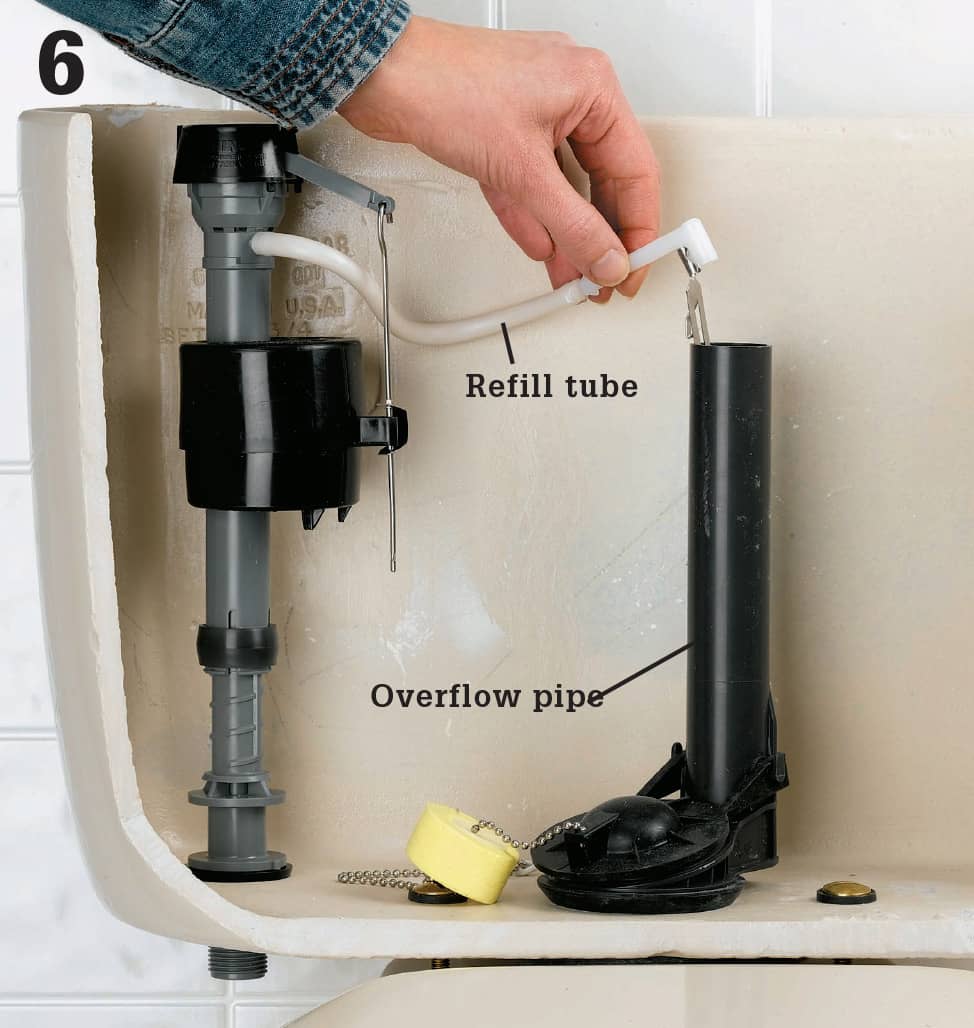
If the overflow pipe has a cap, remove it. Attach one end of the refill tube from the new valve to the plastic angle adapter and the other end to the refill nipple near the top of the valve. Attach the angle adapter to the overflow pipe. Cut off excess tubing with scissors to prevent kinking. WARNING: Don’t insert the refill tube into the overflow pipe. The outlet of the refill tube needs to be above the top of the pipe for it to work properly.
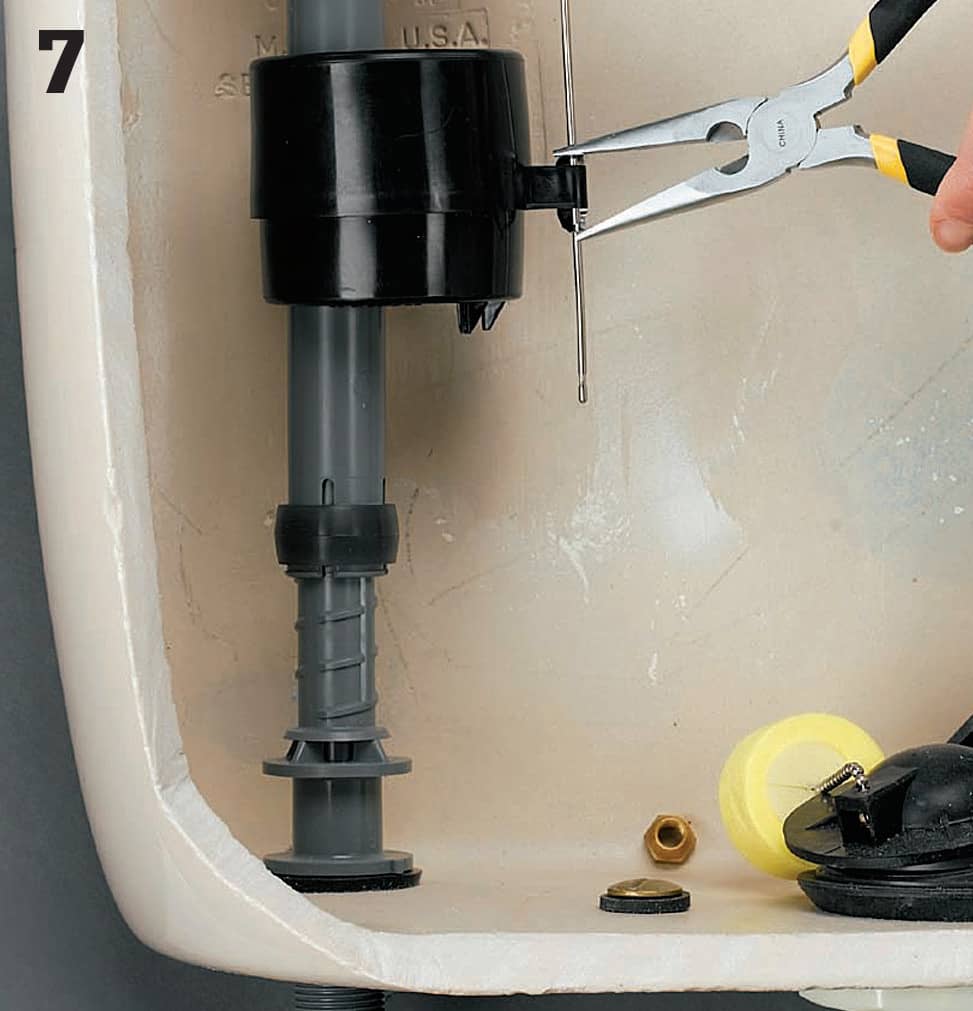
Turn the water on fully. Slightly tighten any fitting that drips water. Adjust the water level in the tank by squeezing the spring clip on the float cup with needlenose pliers and moving the cup up or down on the link bar. Test the flush.
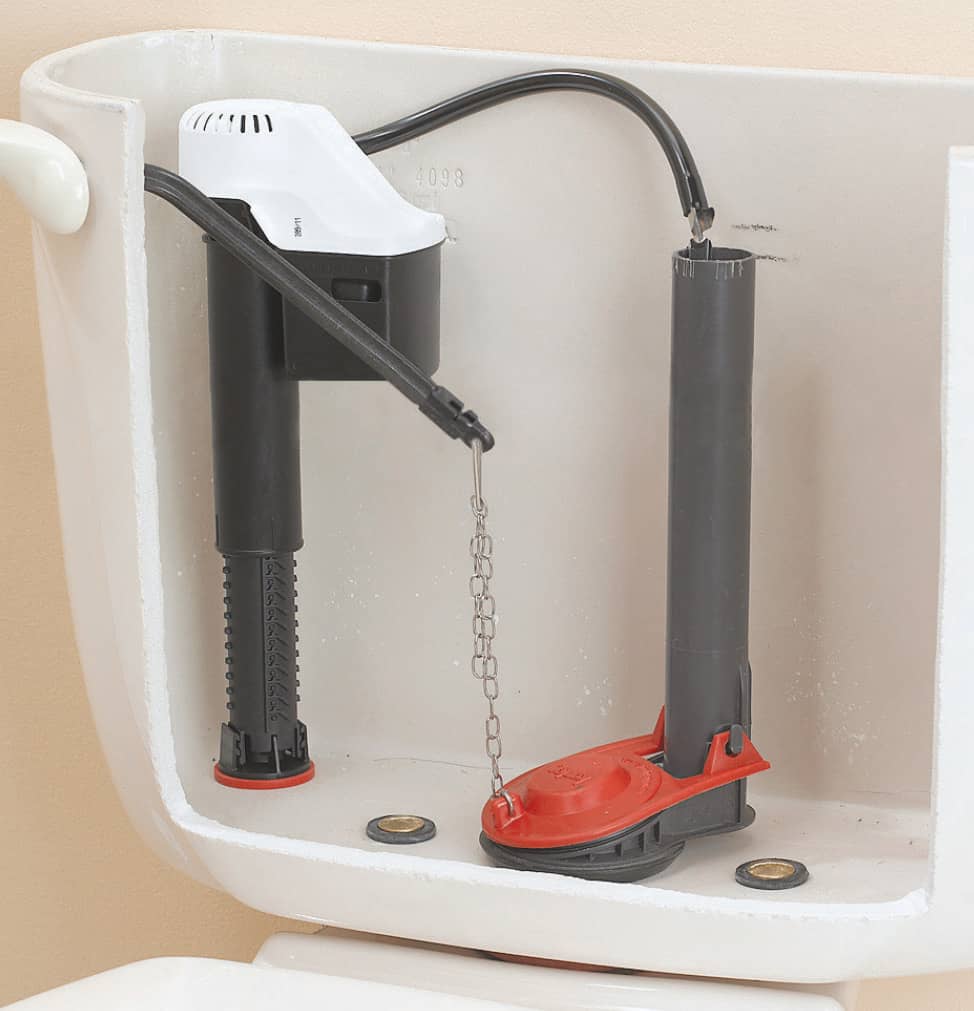
OPTION: Newer diaphragm valves cost a bit more than float cups, but they boast quieter water flow. Install one the same way you would a float cup.
How to Replace a Flush Valve
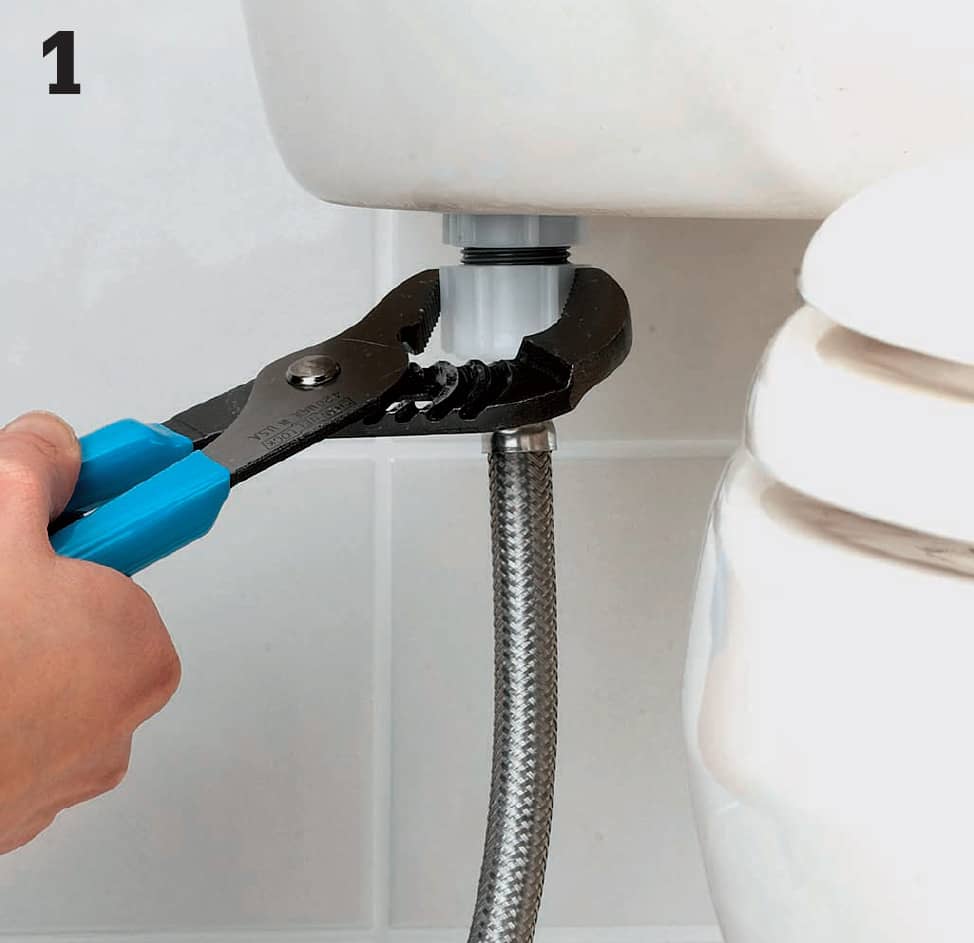
Before removing the old flush valve, shut off the water supply at the fixture stop valve located on the tube that supplies water to the tank. Flush the toilet and sponge out the remaining water. To make this repair you’ll need to remove the tank from the bowl. Start by unscrewing the water supply coupling nut from the bottom of the tank.
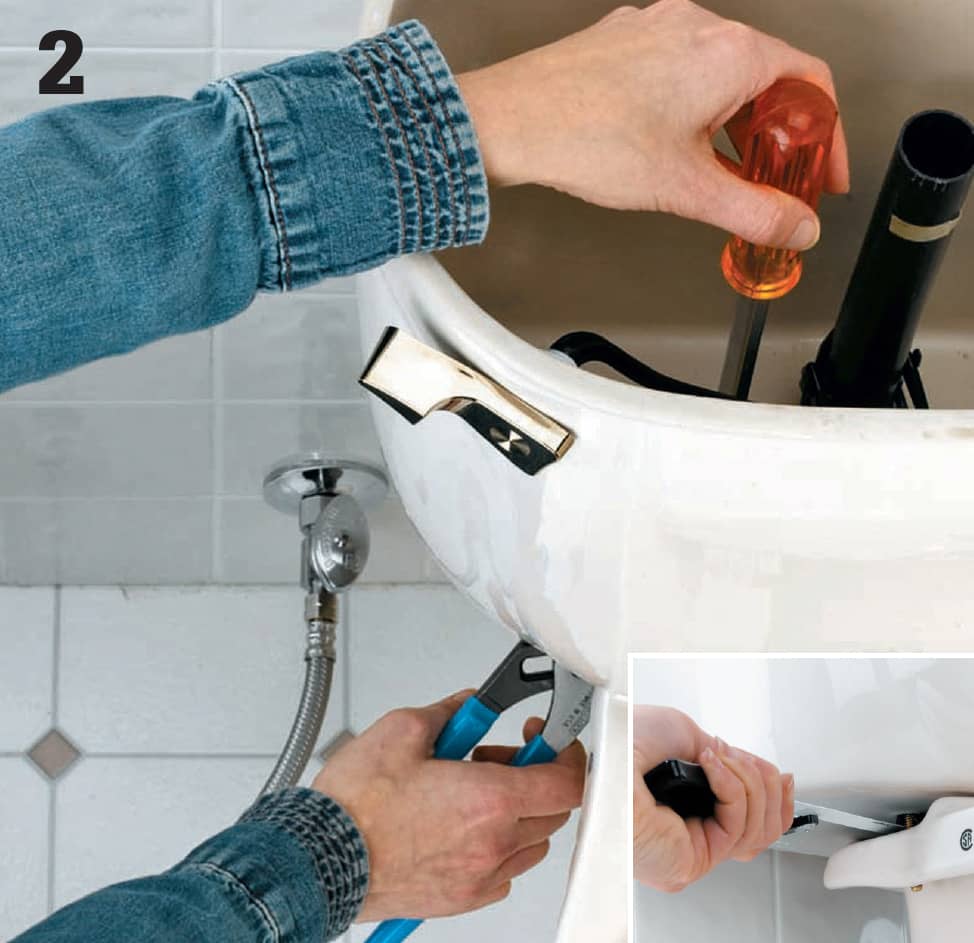
Unscrew the bolts holding the toilet tank to the bowl by loosening the nuts from below. If you are having difficulty unscrewing the tank bolts and nuts because they are fused together by rust or corrosion, apply penetrating oil or spray lubricant to the threads, give it a few minutes to penetrate, and then try again. If that fails, slip an open-ended hacksaw (or plain hacksaw blade) between the tank and bowl and saw through the bolt (inset photo).
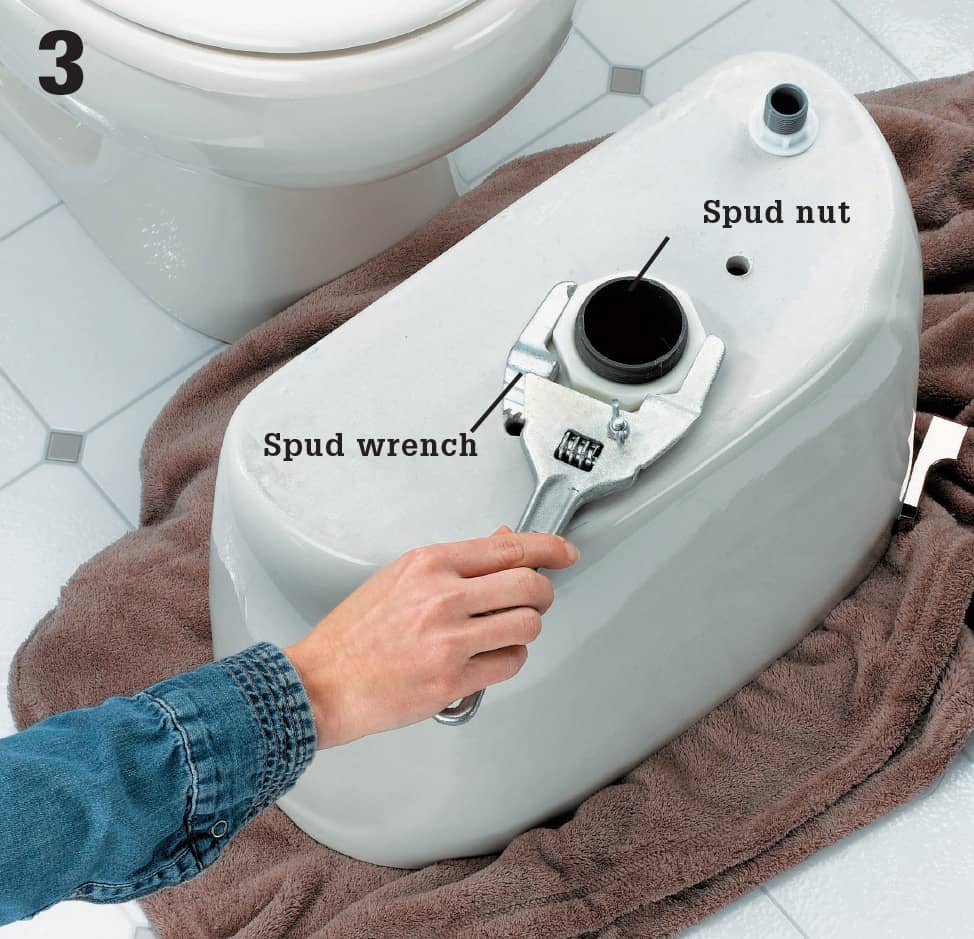
Unhook the chain from the handle lever arm. Remove the tank and carefully place it upside-down on an old towel. Remove the spud washer and spud nut from the base of the flush valve using a spud wrench or large channel-type pliers. Remove the old flush valve.
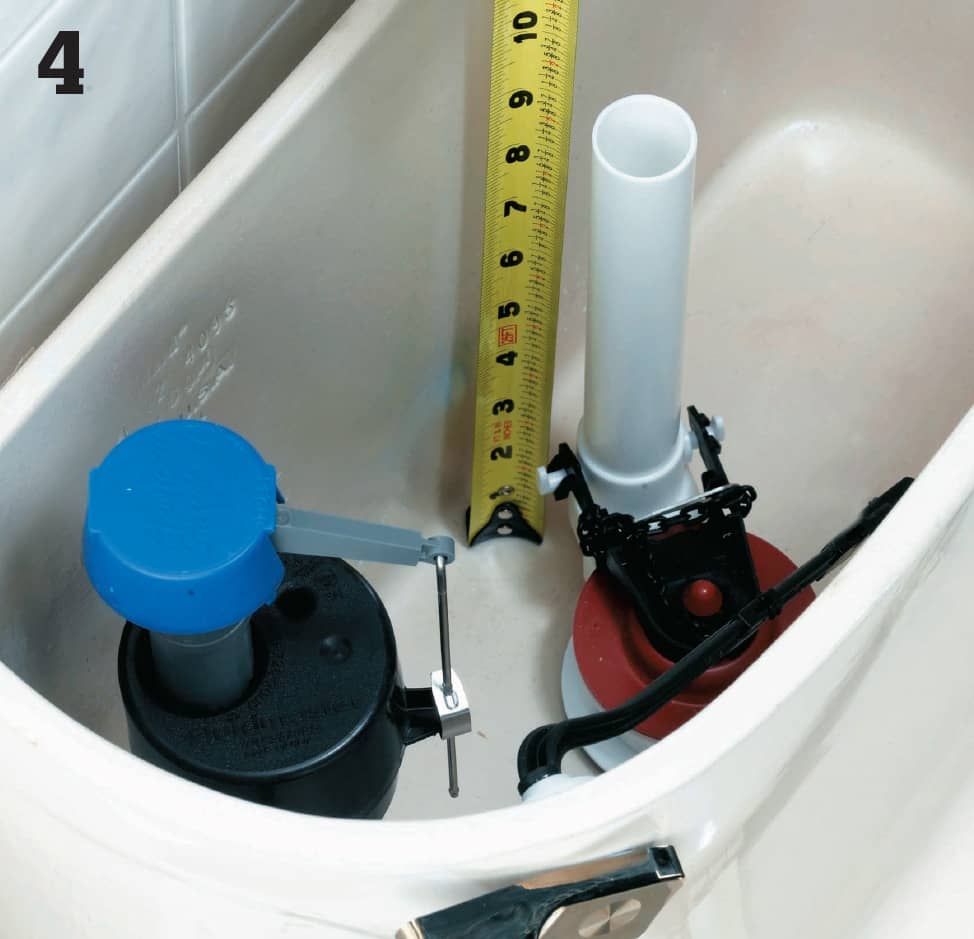
Place the new flush valve in the valve hole and check to see if the top of the overflow pipe is at least 1" below the critical level line (see page 324) and the tank opening where the handle is installed. If the pipe is too tall, cut it to length with a hacksaw.
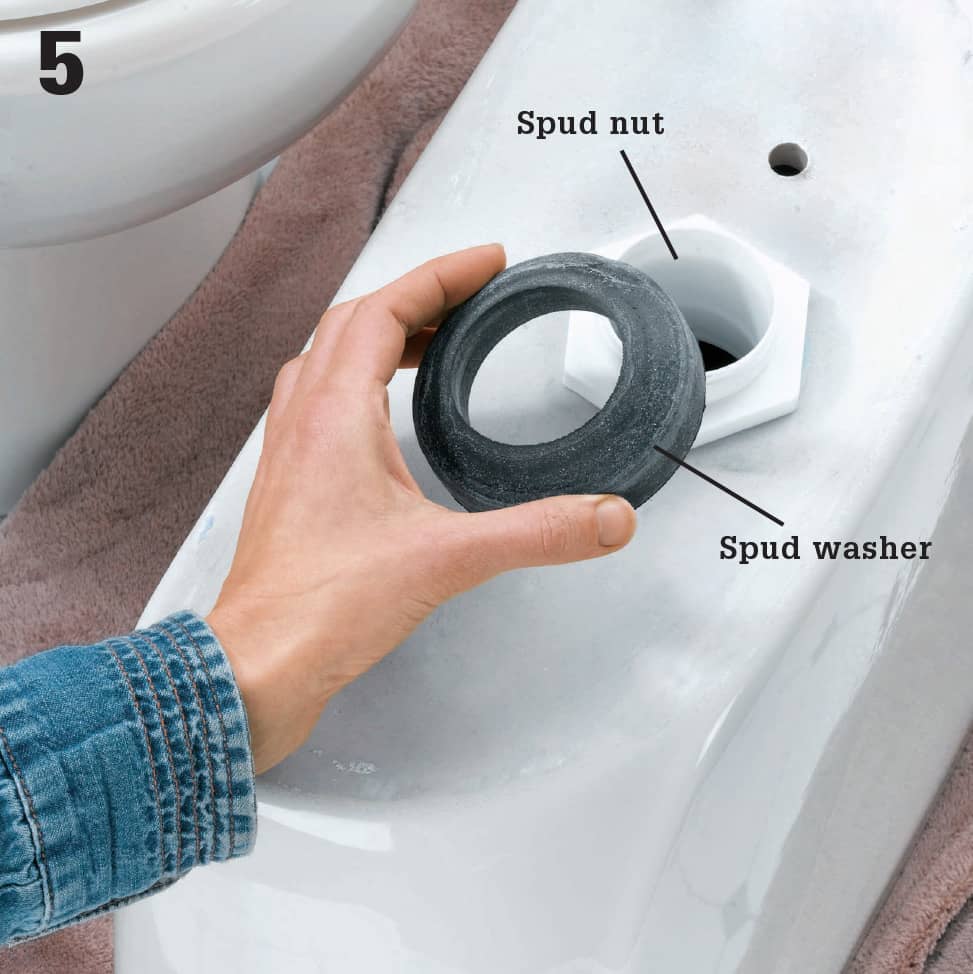
Position the flush valve flapper below the handle lever arm and secure it to the tank from beneath with the spud nut. Tighten the nut one-half turn past hand tight with a spud wrench or large channel-type pliers. Overtightening may cause the tank to break. Put the new spud washer over the spud nut, small side down.
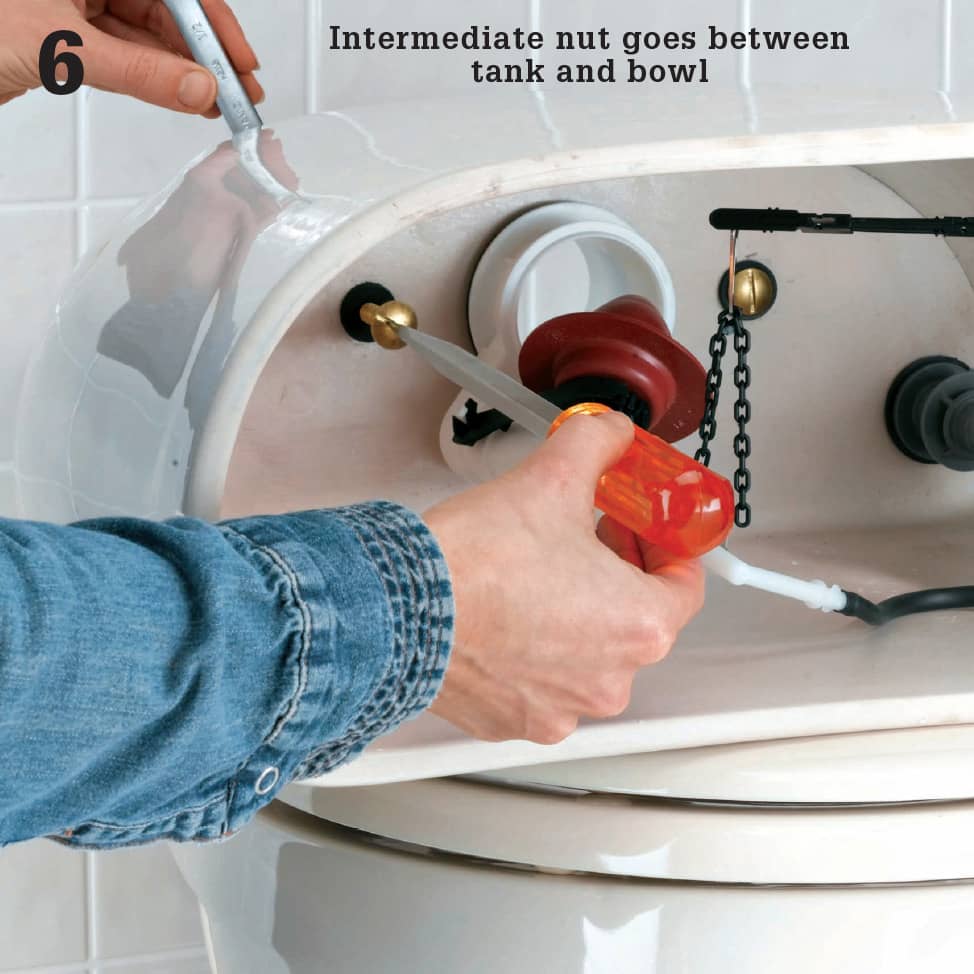
With the tank lying on its back, thread a rubber washer onto each tank bolt and insert it into the bolt holes from inside the tank. Then, thread a brass washer and hex nut onto the tank bolts from below and tighten them to a quarter turn past hand tight. Do not overtighten.
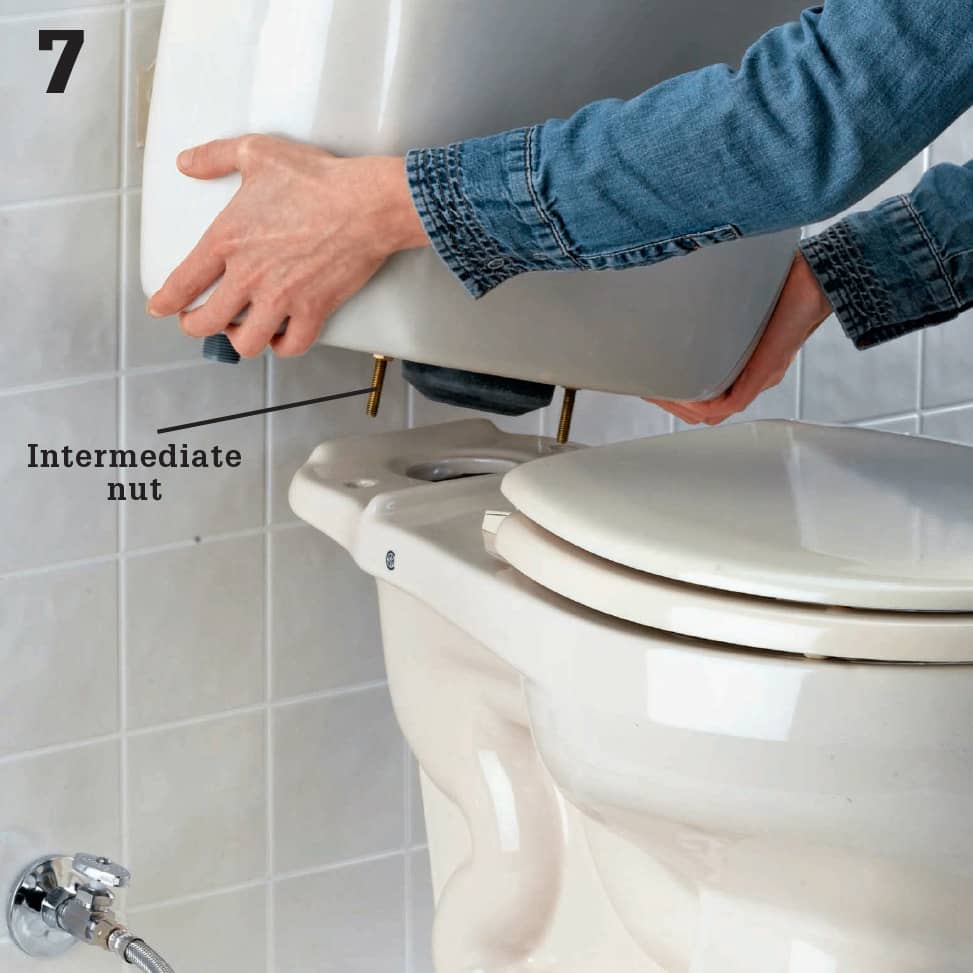
With the hex nuts tightened against the tank bottom, carefully lower the tank over the bowl and set it down so the spud washer seats neatly over the water inlet in the bowl and the tank bolts fit through the holes in the bowl flange. Secure the tank to the bowl with a rubber washer, brass washer, and nut or wing nut at each bolt end. Press the tank to level as you hand-tighten the nuts. Hook up the water supply at the fill valve inlet.
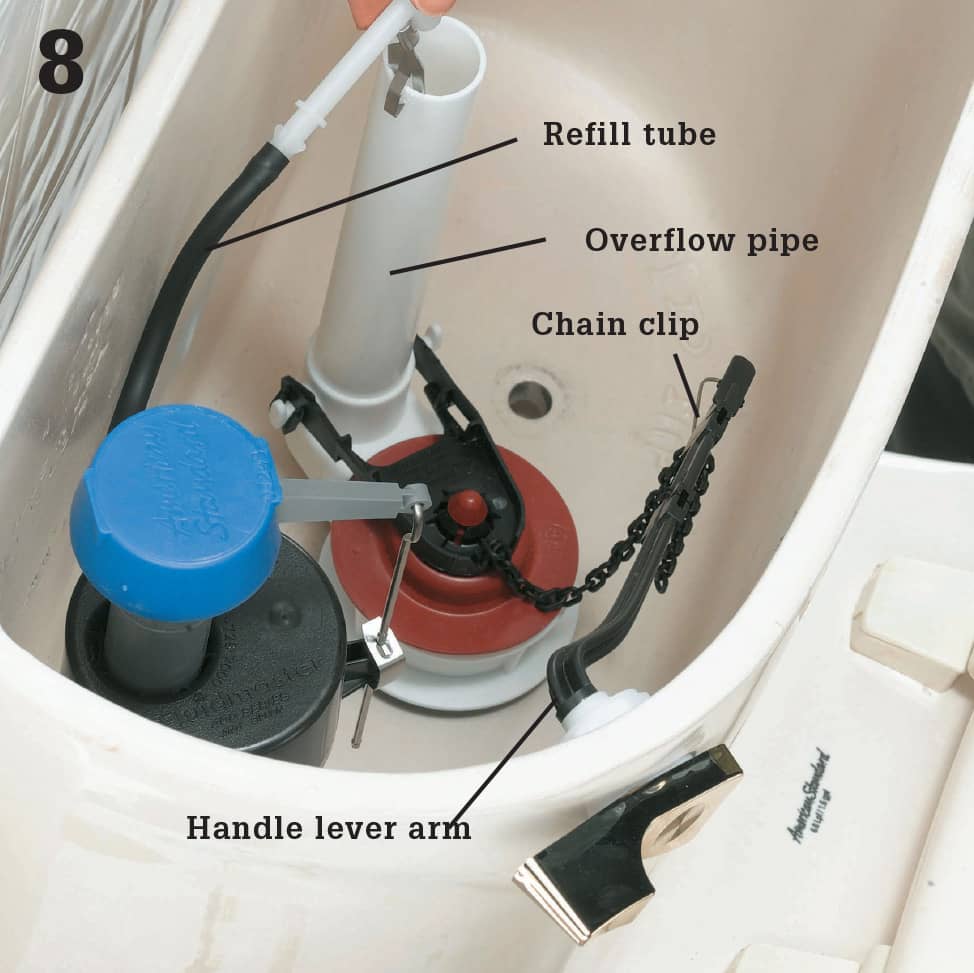
Connect the chain clip to the handle lever arm and adjust the number of links to allow for a little slack in the chain when the flapper is closed. Leave a little tail on the chain for adjusting, cutting off remaining excess. Attach the refill tube to the top of the overflow pipe the same way it had been attached to the previous refill pipe. Turn on the water supply at the stop valve and test the flush. (Some flush valve flappers are adjustable.)
 Installing Toilets
Installing Toilets
You can replace a poorly functioning or inefficient toilet with a high-efficiency, high-quality new toilet in just a single afternoon. All toilets made since 1994 have been required to use 1.6 gallons or less per flush, which has been a huge challenge for the industry. Today, the most evolved water-saving toilets have wide passages behind the bowl and wide (3") flush valve openings—features that facilitate short, powerful flushes. This means fewer second flushes and fewer clogged toilets. These problems were common complaints of the first generation of 1.6-gallon toilets and continue to beleaguer inferior models today. See which toilets are available at your local home center in your price range, then go online and see what other consumers’ experiences with those models have been. New toilets often go through a “de-bugging” stage when problems with leaks and malfunctioning parts are more common. Your criteria should include ease of installation, good flush performance, and reliability. With a little research, you should be able to purchase and install a high-functioning, economical toilet that will serve you well for years to come.
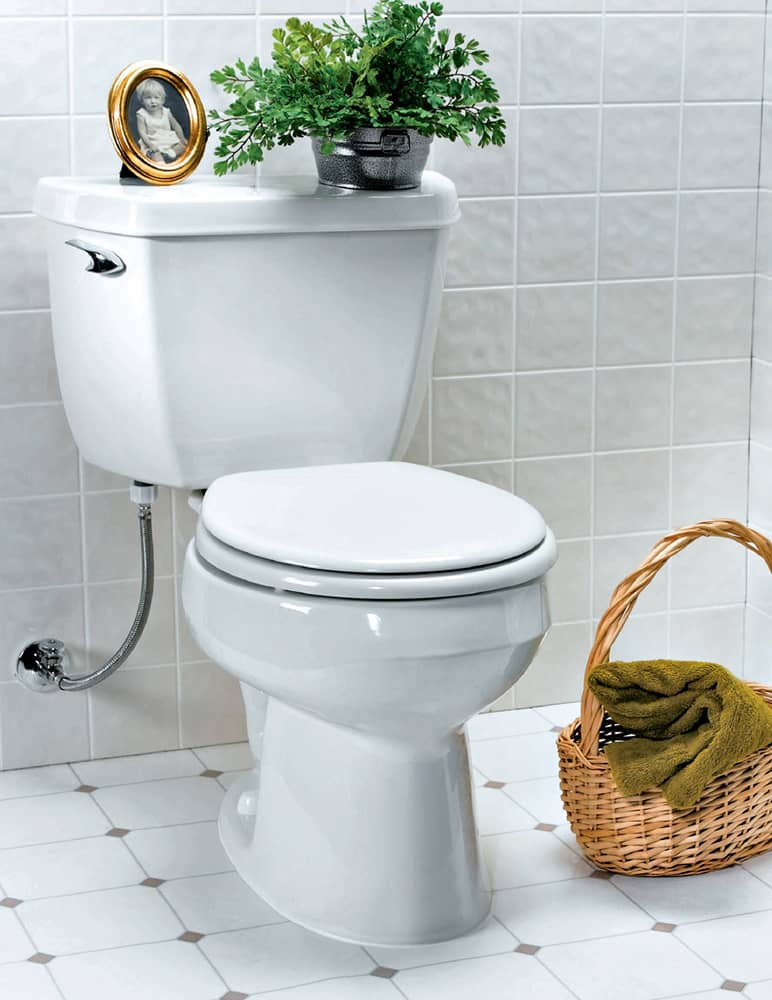
Replacing a toilet is simple, and the newer models of water-saving toilets have overcome the performance problems of earlier models.
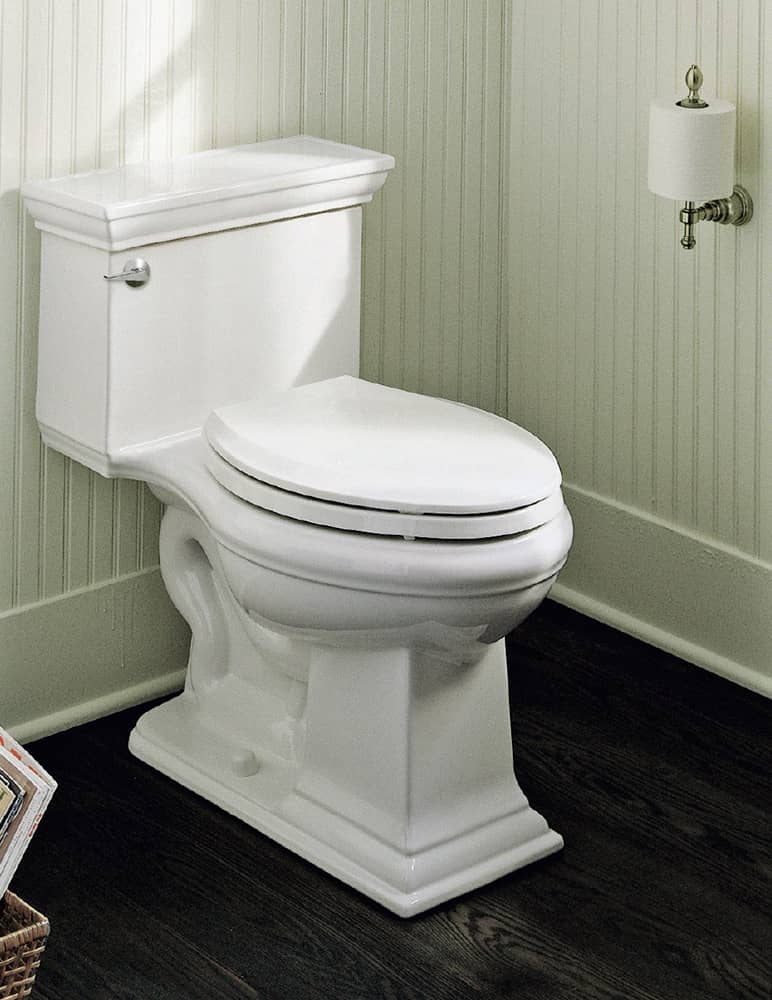
Gravity-assisted toilets are now designed with taller tanks and steeper bowl walls to increase the effects of gravity.
Choosing a New Toilet
Toilets have changed in recent years. There’s a toilet to fit every style. You can even buy a square or stainless-steel toilet, among many other new options. The new designs are efficient, durable, and less susceptible to clogs.
A toilet’s style is partly affected by the way it’s built. You have a number of options from which to choose:
Two-piece toilets have a separate water tank and bowl.
One-piece toilets have a tank and bowl made of one seamless unit.
Elongated bowls are roughly 2" longer than regular bowls.
Elevated toilets have higher seats, generally 18", rather than the standard 15".
You have a choice of two basic types of flush mechanisms: gravity- and pressure-assisted.
Gravity-assisted toilets allow water to rush down from an elevated tank into the toilet bowl. Federal law mandates that new toilets consume no more than 1.6 gallons of water per flush, less than half the volume used by older styles.
Pressure-assisted toilets rely on either compressed air or water pumps to boost flushing power.
Dual-flush systems feature two flush buttons on the top of the tank, allowing you to select either an 8-ounce flush for liquids or a 1.6-gallon flush for solids.
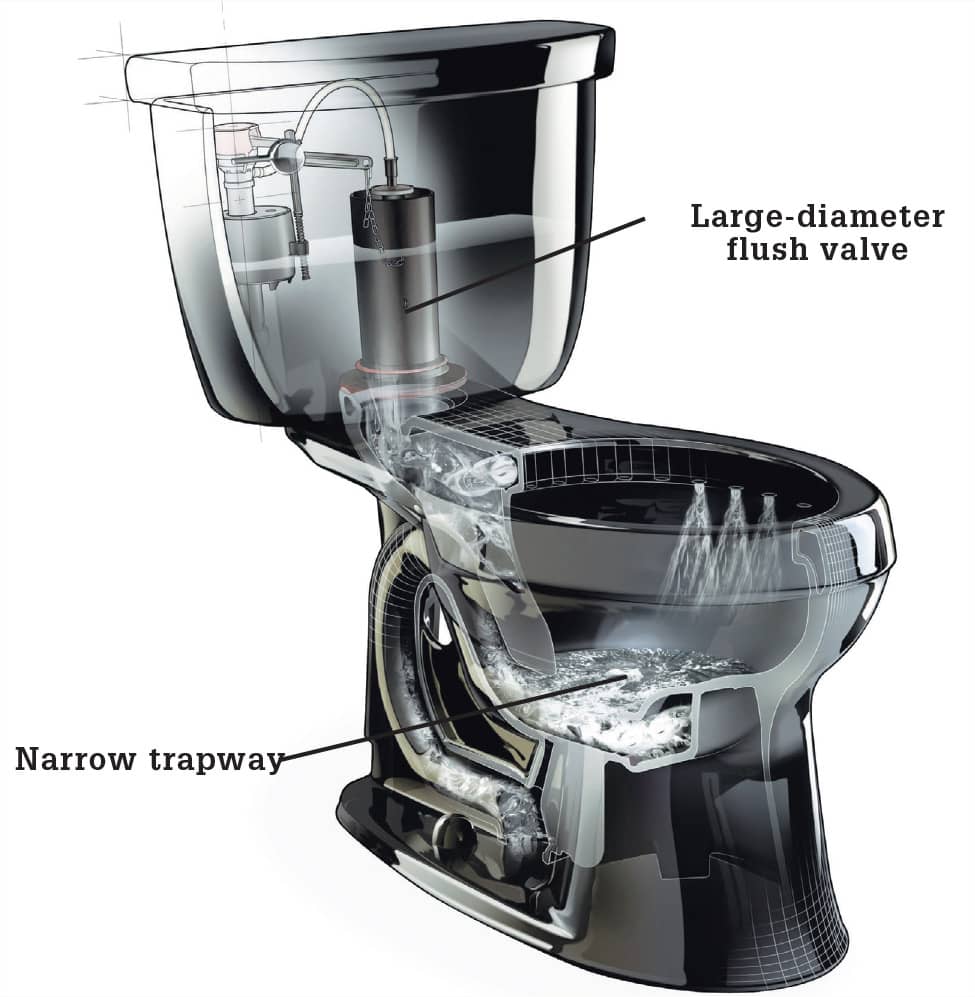
Some high-end toilets are designed to get maximum pressure out of a small amount of water. Many employ narrower trapways (the path water travels through the bowl) in conjunction with large-diameter flush valves. Some models use as little as 1.2 gallons of water.
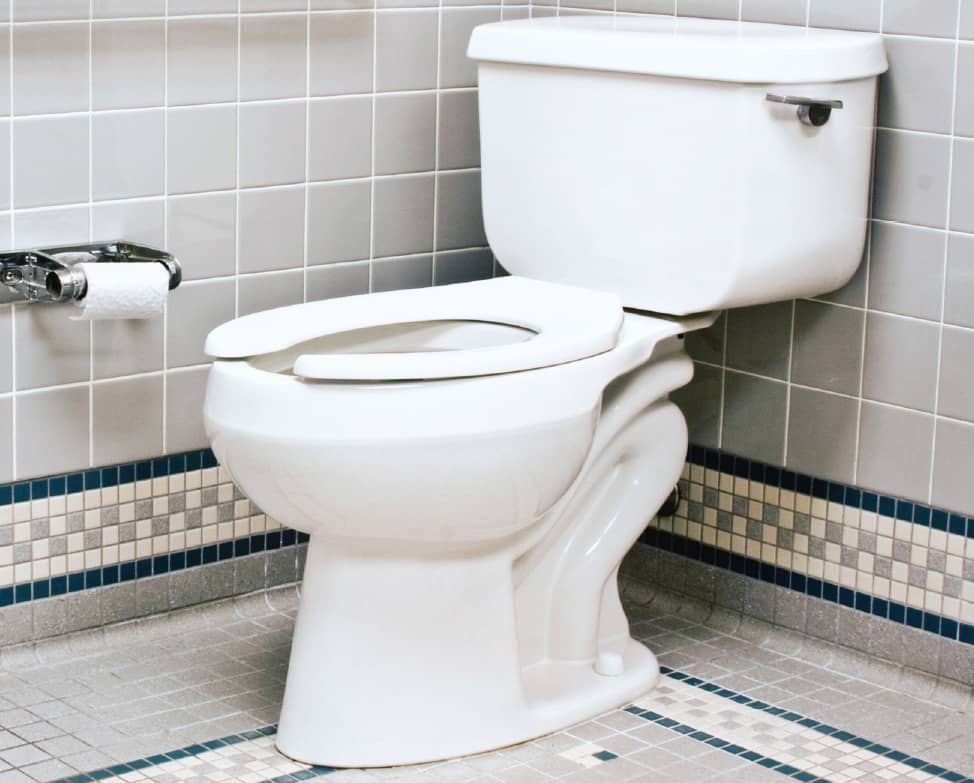
Two-piece toilets with a separate tank and bowl are much more common than one-piece models, and usually a lot less costly. The cheapest models are compact with a seat that is not as high above the floor as a full-size model. This can create access difficulty for some users. Round-bowl models usually cost less than models with a larger, elongated bowl.
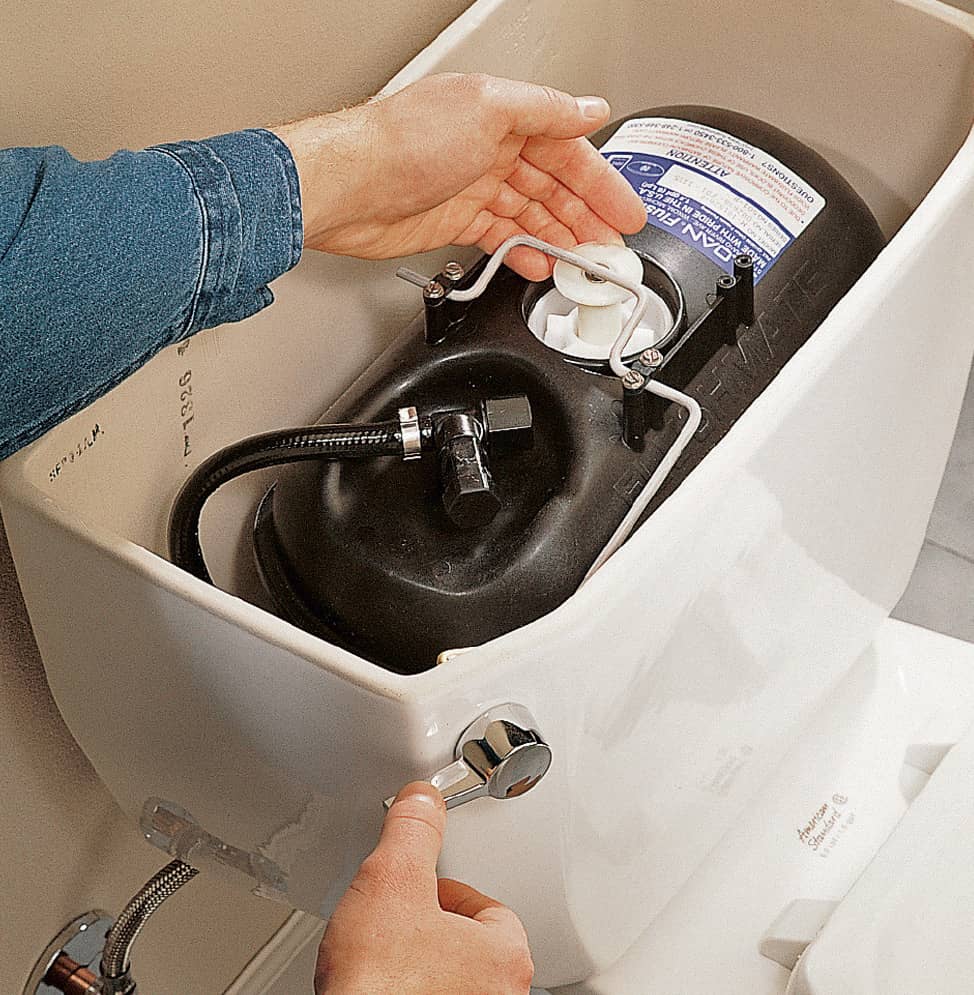
Pressure-assisted toilets are relatively expensive, but they can reduce your water usage significantly by eliminating multiple flushes. The flush mechanism of a pressure-assisted toilet boosts the flushing power by using either compressed air or water pumps.
How to Remove a Toilet
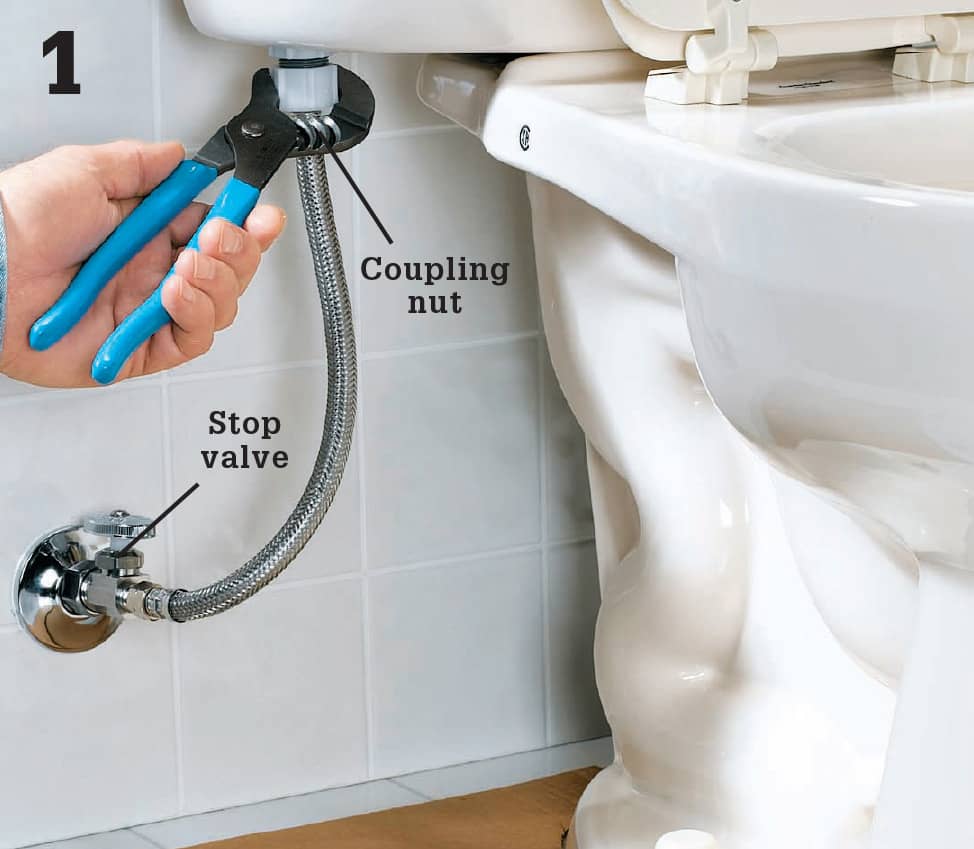
Remove the old supply tube. First, turn off the water at the stop valve. Flush the toilet, holding the handle down for a long flush, and sponge out the tank. Use a wet/dry vac to clear any remaining water out of the tank and bowl. Unthread the coupling nut for the water supply below the tank using channel-type pliers.
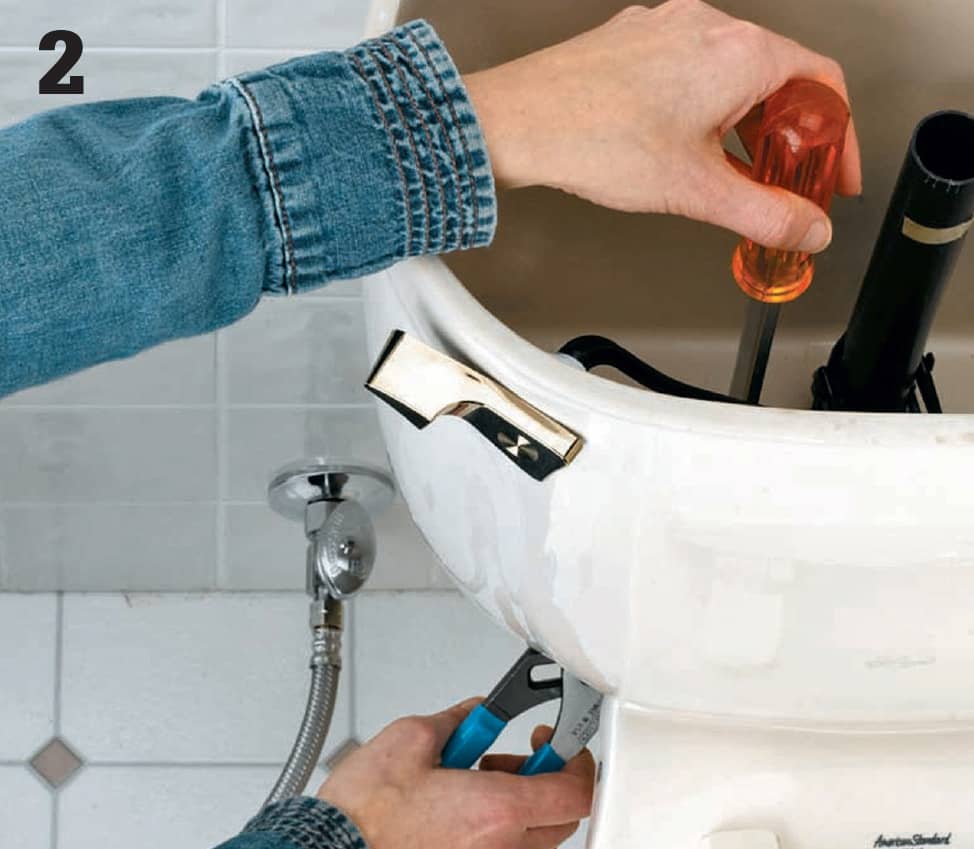
Grip each tank bolt nut with a box wrench or pliers and loosen it as you stabilize each tank bolt from inside the tank with a large slotted screwdriver. If the nuts are stuck, apply penetrating oil to the nut and let it sit before trying to remove them again. You may also cut the tank bolts between the tank and the bowl with an open-ended hacksaw. Remove and discard the tank.
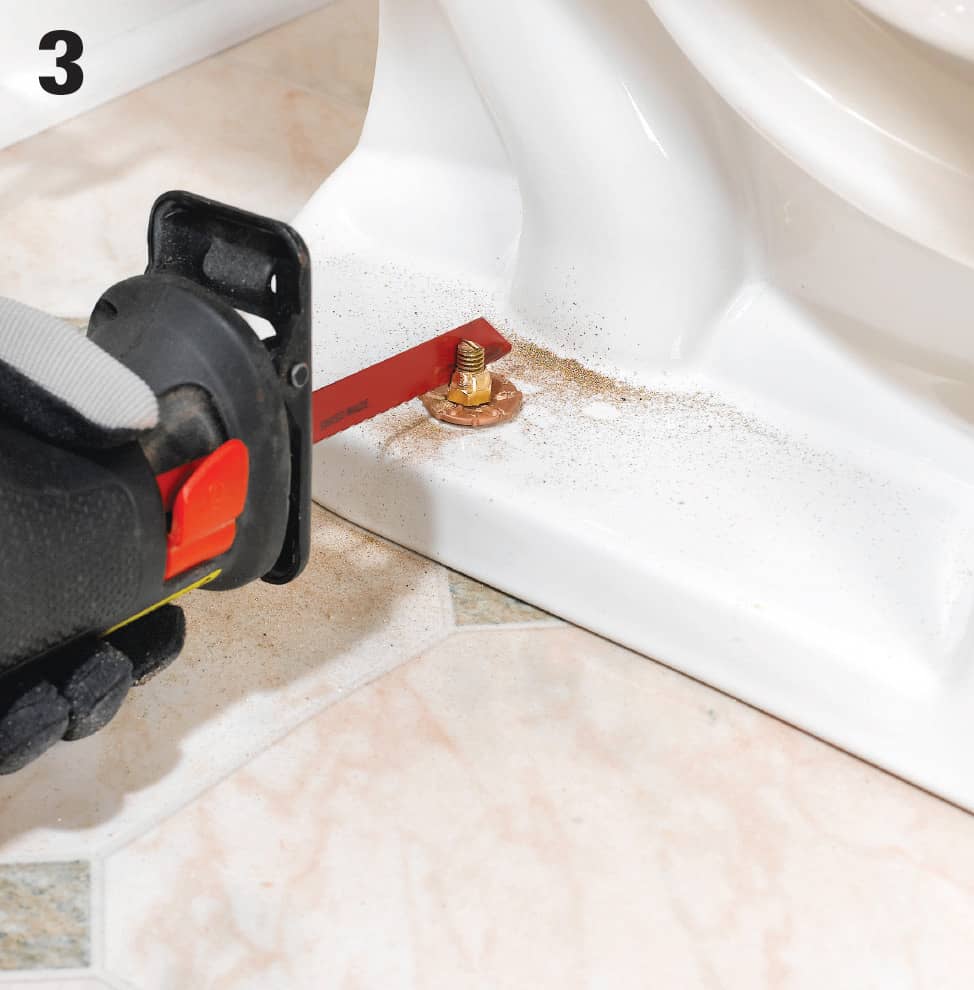
Remove the nuts that hold the bowl to the floor. First, pry off the bolt covers with a screwdriver. Use a socket wrench, locking pliers, or your channel-type pliers to loosen the nuts on the tank bolts. Apply penetrating oil and let it sit if the nuts are stuck, then take them off. As a last resort, cut the bolts off with a hacksaw by first cutting down through one side of the nut. Tilt the toilet bowl over and remove it.
How to Install a Toilet
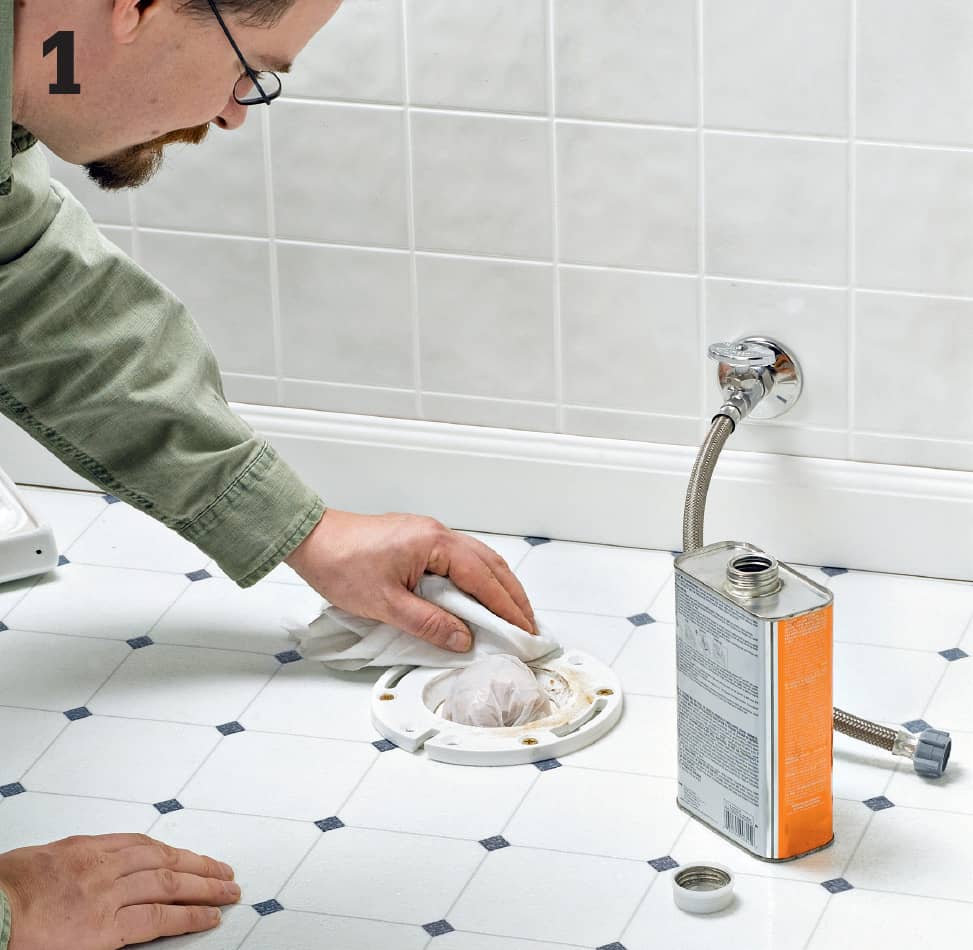
Clean and inspect the old closet flange. Look for breaks or wear. Also inspect the flooring around the flange. If either the flange or floor is worn or damaged, repair the damage. Use a rag and mineral spirits to completely remove residue from the old wax ring. Place a rag-in-a-bag into the opening to block odors.
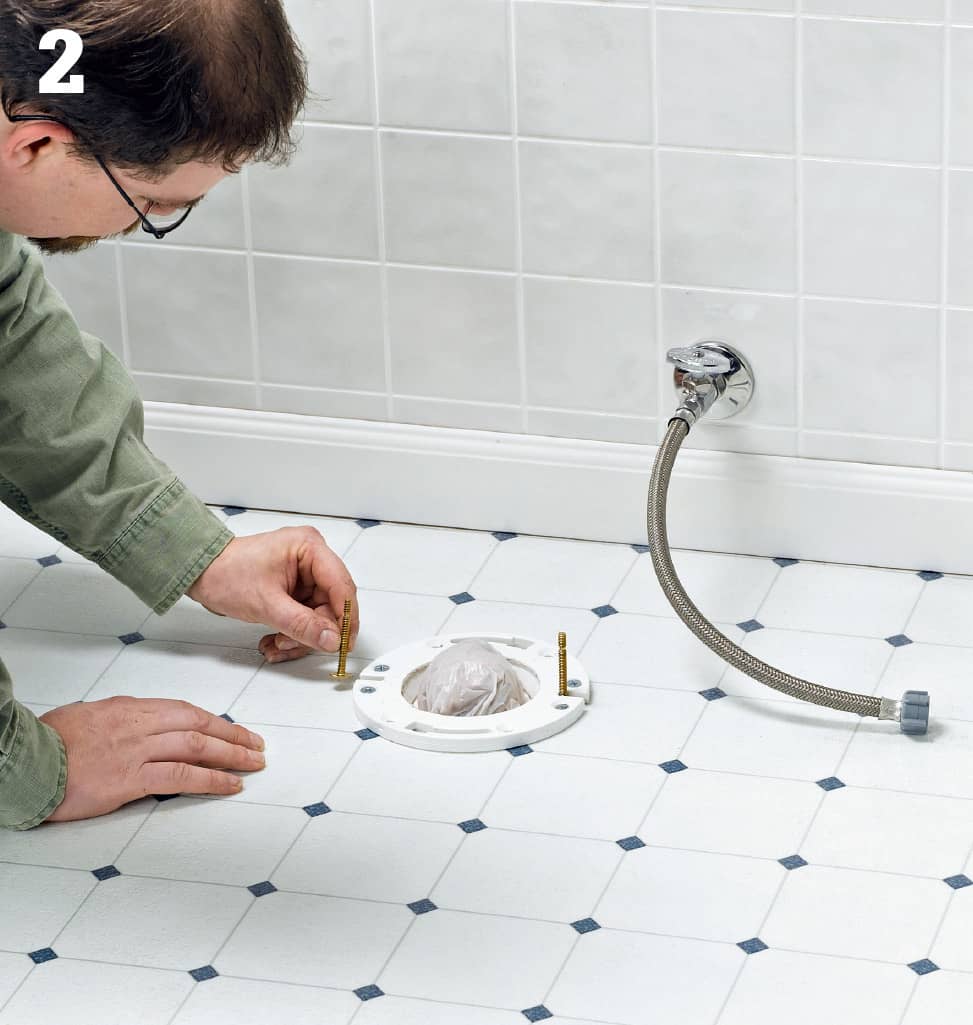
Insert new tank bolts (don’t reuse old ones) into the openings in the closet flange. Make sure the heads of the bolts are oriented to catch the maximum amount of flange material. To firmly hold the bolts upright, slide on the plastic washers and press them down.
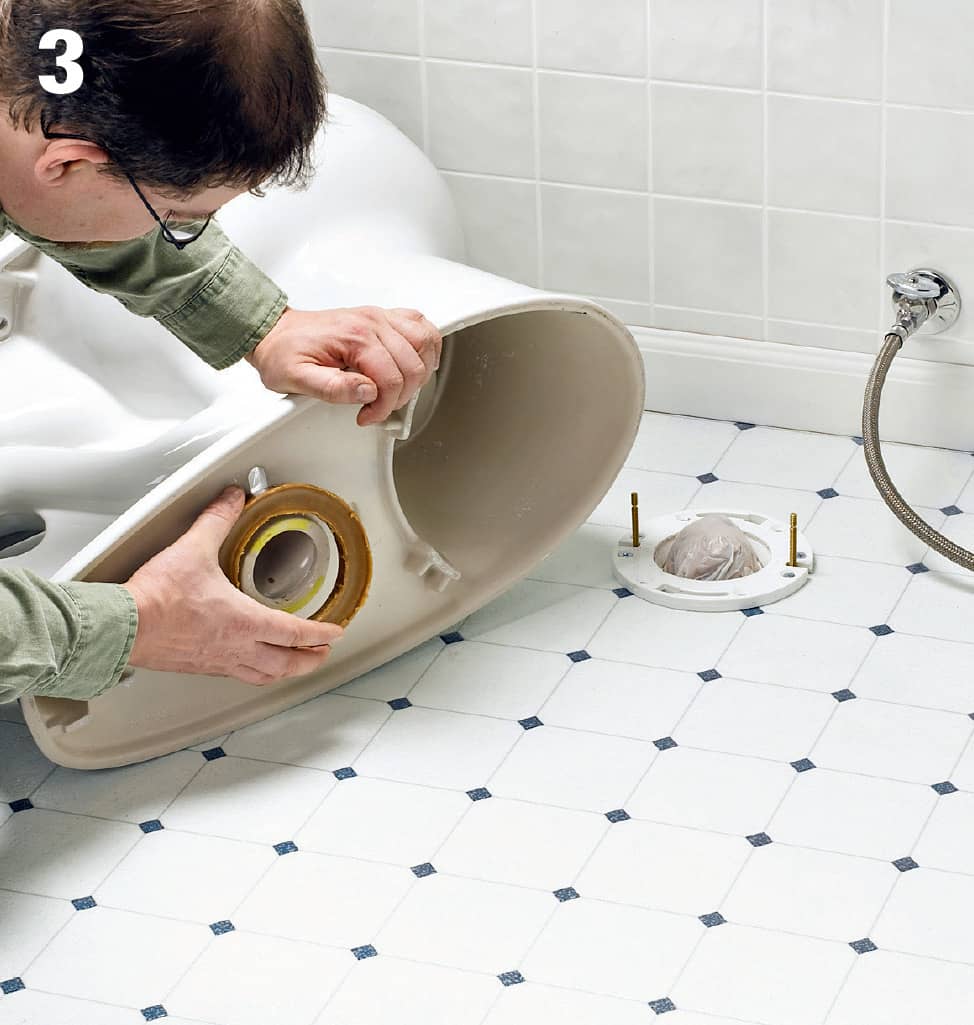
Remove the wax ring and apply it to the underside of the bowl, around the horn. Remove the protective covering. Do not touch the wax ring. It is very sticky. Remove the rag-in-a-bag. If you have an older 4-inch flange, place the ring on the flange rather than the toilet to make sure it is centered.
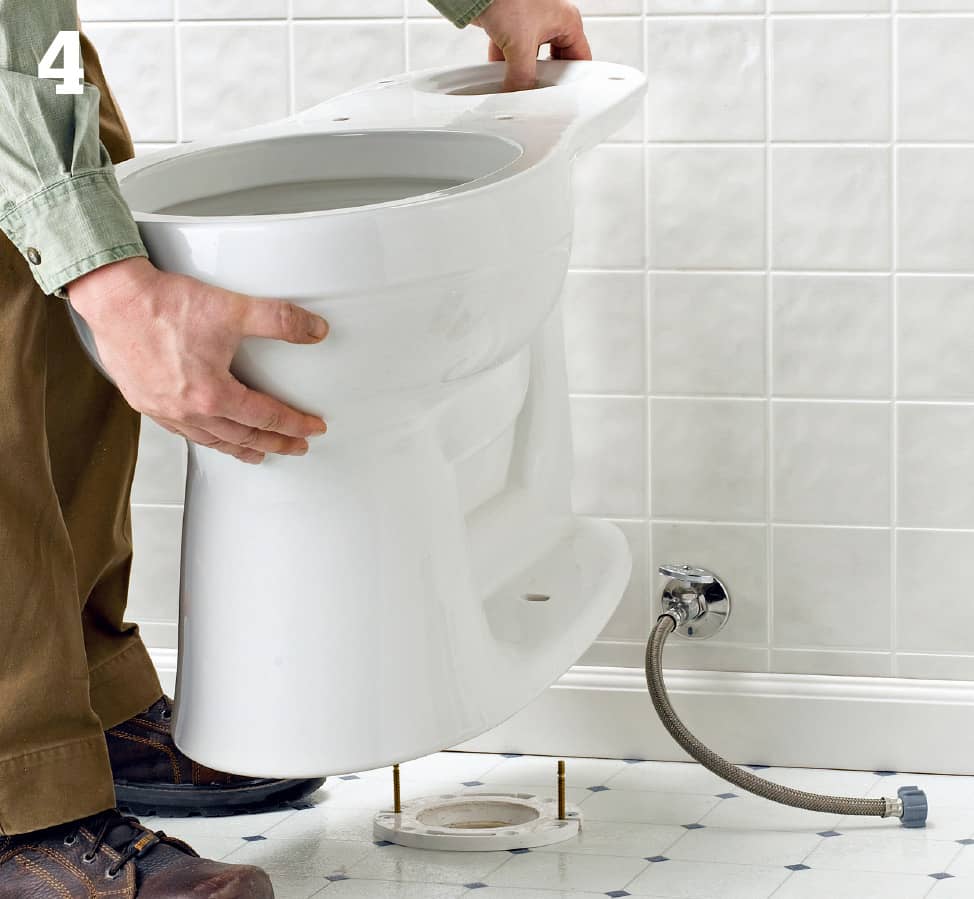
Lower the bowl onto the flange, taking care not to disturb the wax ring. The holes in the bowl base should align perfectly with the tank bolts. Add a washer and tighten a nut onto each bolt. Hand-tighten each nut and then use channel-type pliers to further tighten the nuts. Alternate tightening the nuts until the bowl is secure. Do not overtighten. NOTE: Some disagreement exists among plumbers as to whether you should seal the joint between the bowl and the floor. Most codes require that you do. The easiest and least visible way to seal it is to apply a thick bead of clear silicone caulk to the bottom rim of the bowl before you set it on the floor. Another option is to apply a bead of caulk between the bowl and the floor after the toilet is installed.
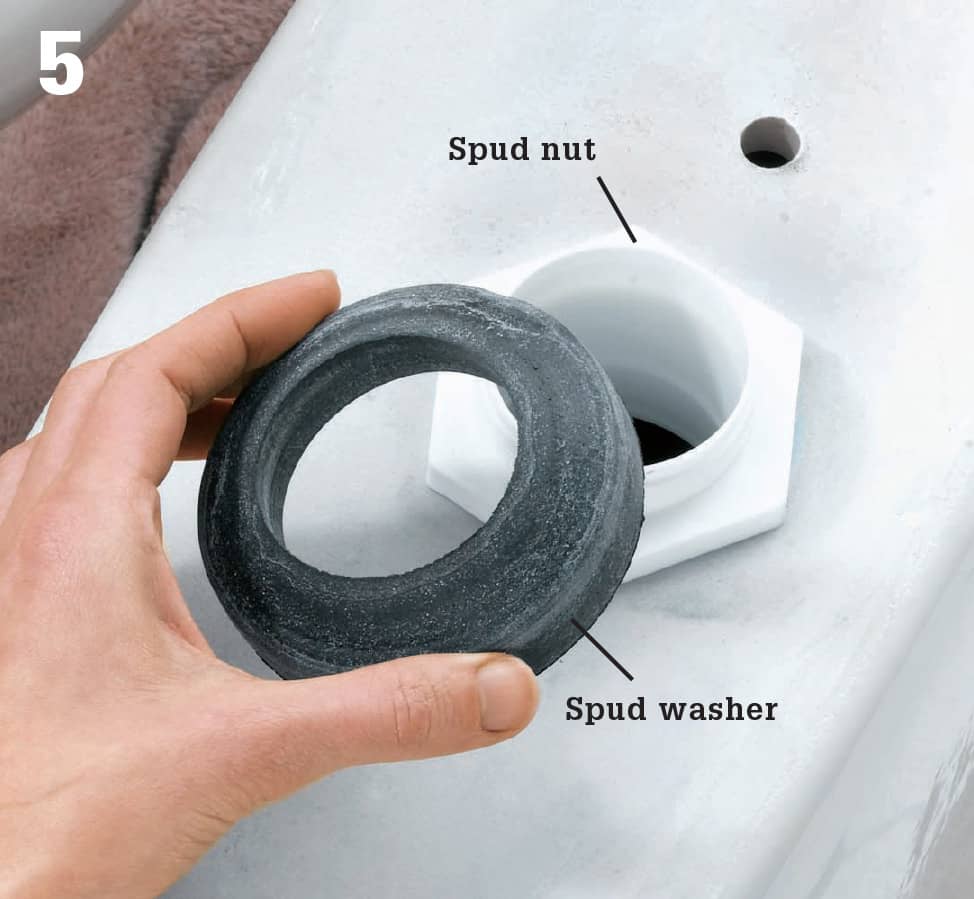
Install the flush valve. Some tanks come with a flush valve and a fill valve preinstalled. For models that do not have this, insert the flush valve through the tank opening and tighten a spud nut over the threaded end of the valve. Place a foam spud washer on top of the spud nut.
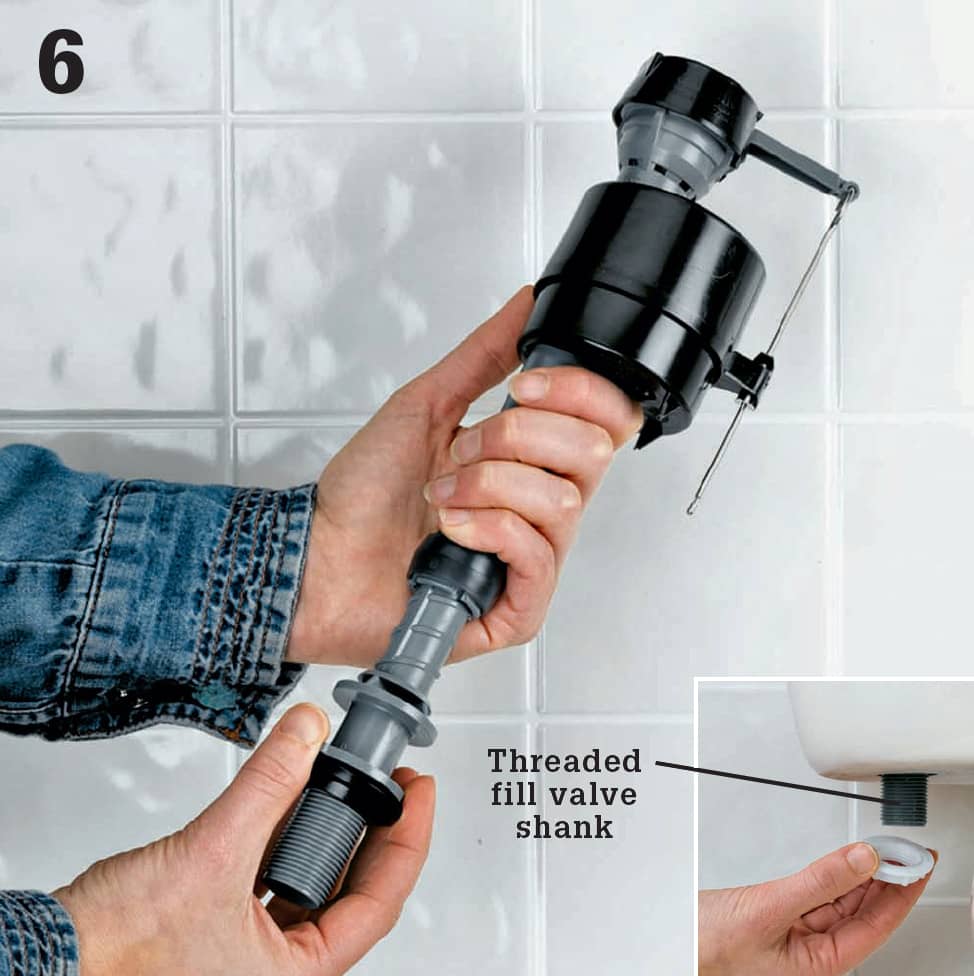
Adjust the fill valve as directed by the manufacturer to set the correct tank water level height and install the valve inside the tank. Hand tighten the nylon lock nut that secures the valve to the tank (inset photo) and then tighten it further with channel-type pliers.
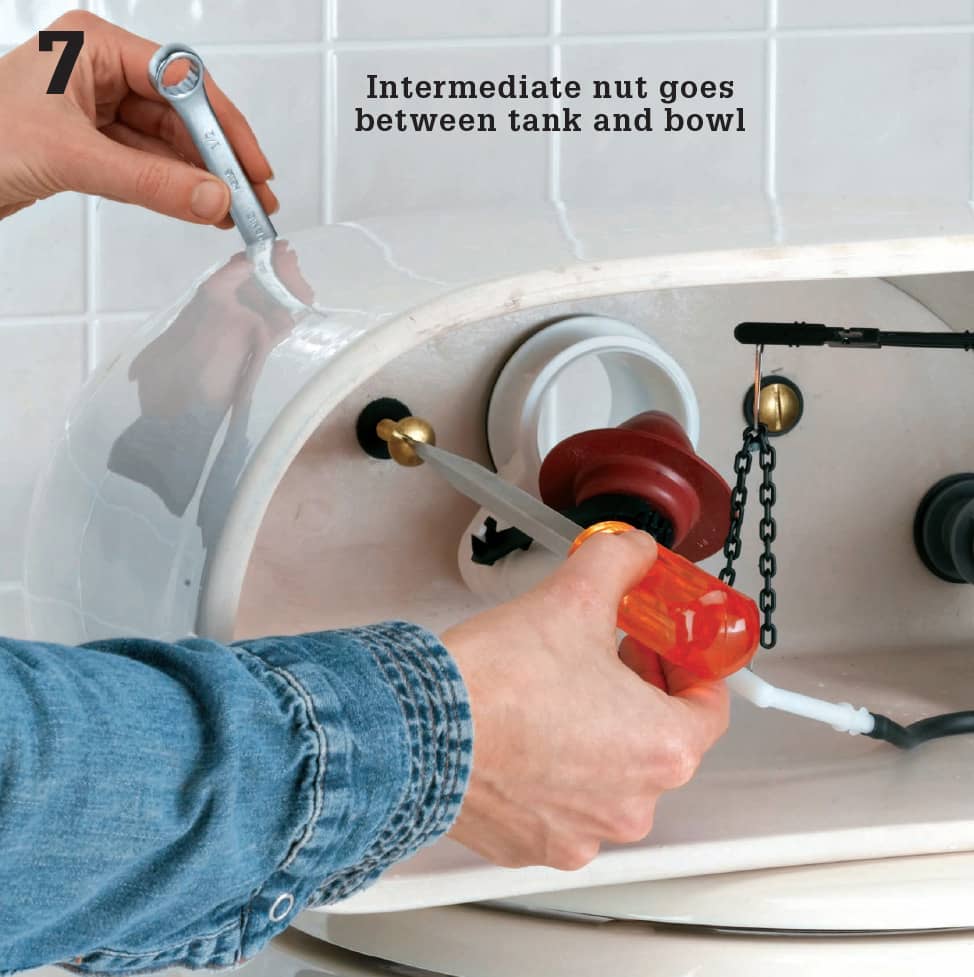
With the tank lying on its back, thread a rubber washer onto each tank bolt and insert it into the bolt holes from inside the tank. Then, thread a brass washer and hex nut onto the tank bolts from below and tighten them to a quarter turn past hand tight. Do not overtighten.
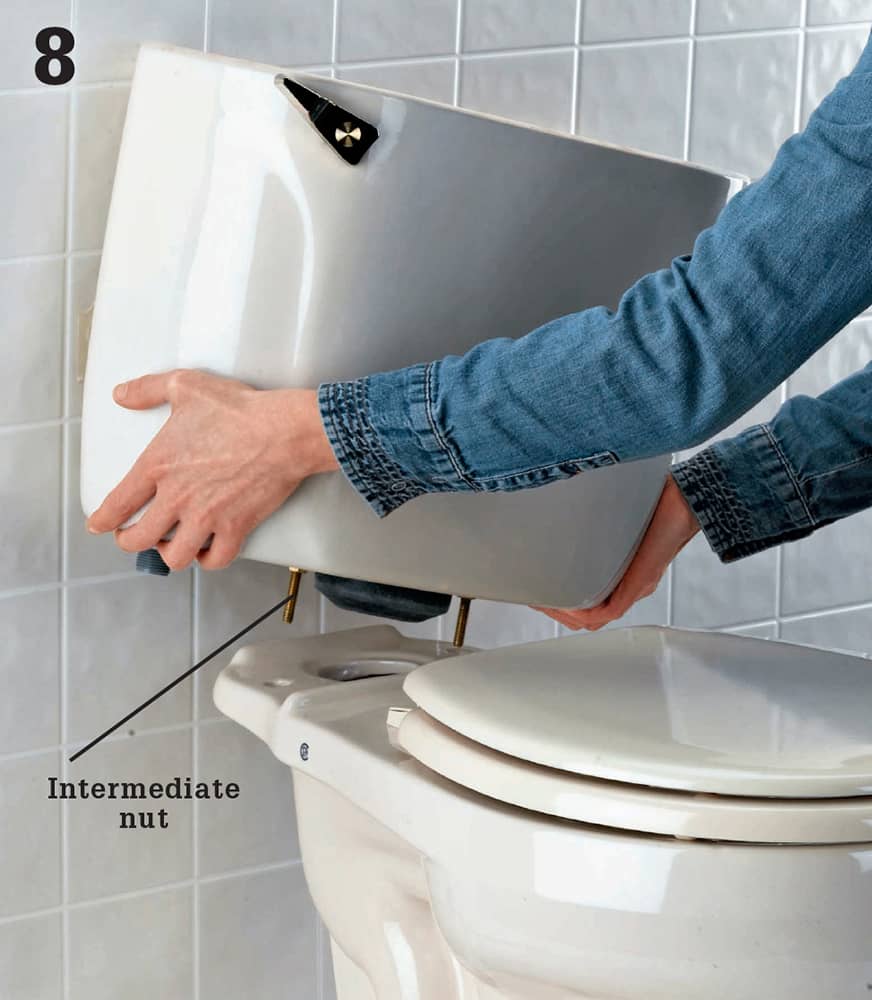
Position the tank on the bowl, spud washer on opening, bolts through bolt holes. Put a rubber washer, followed by a brass washer and a wing nut, on each bolt and tighten these up evenly.
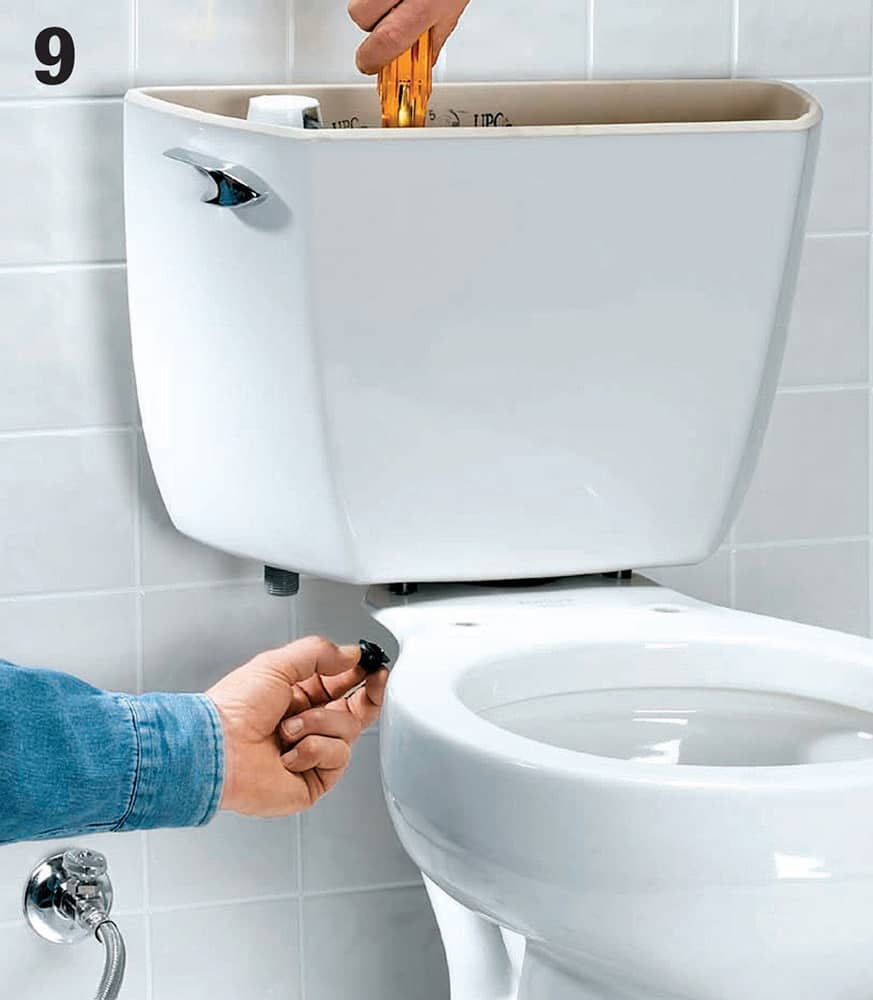
You may stabilize the bolts with a large slotted screwdriver from inside the tank, but tighten the nuts, not the bolts. You may press down a little on a side, the front, or the rear of the tank to level it as you tighten the nuts by hand. Do not overtighten and crack the tank. The tank should be level and stable when you’re done.
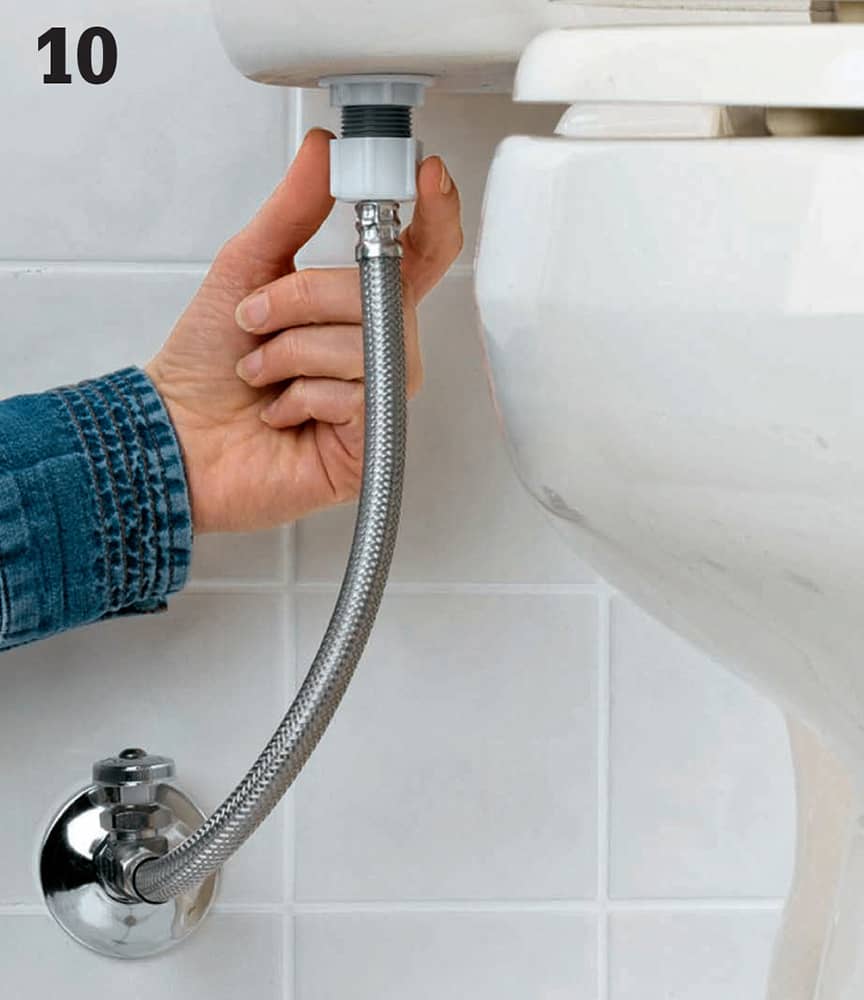
Hook up the water supply by connecting the supply tube to the threaded fill valve with the coupling nut provided. Turn on the water and test for leaks. Do not overtighten.
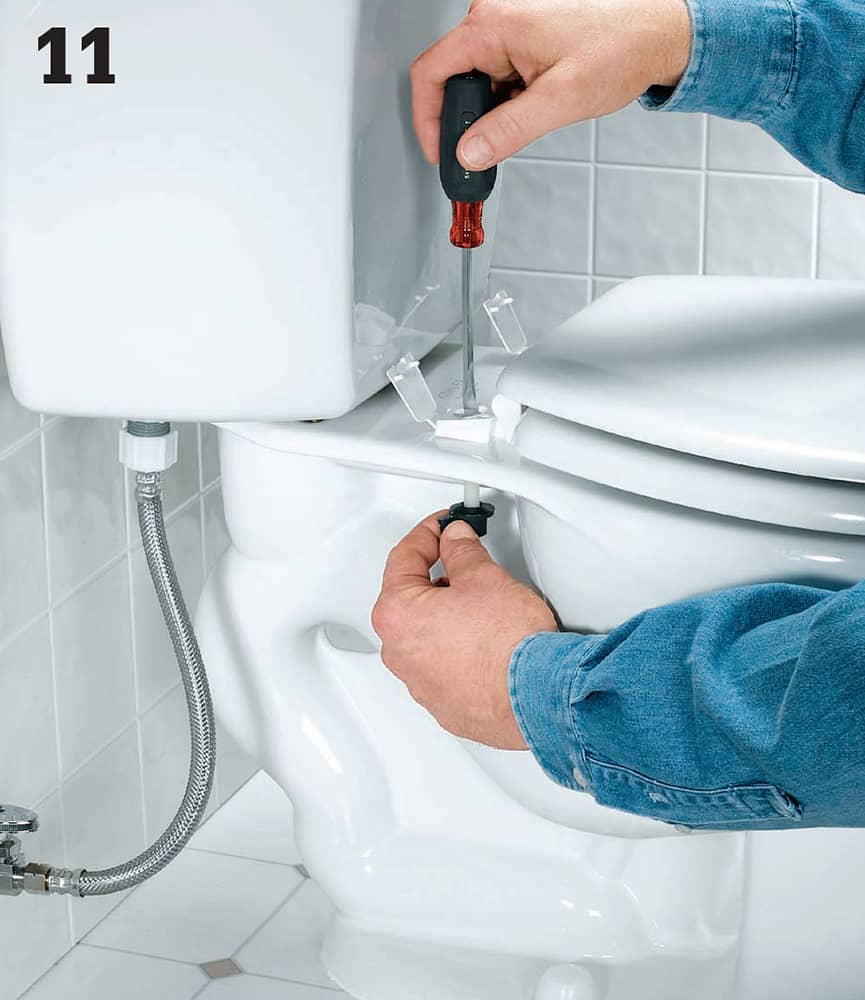
Attach the toilet seat by threading the plastic or brass bolts provided with the seat through the openings on the back of the rim and attaching nuts.
 Fixing Clogged Toilets
Fixing Clogged Toilets
The toilet is clogged and has overflowed. Have patience. Now is the time for considered action. A second flush is a tempting but unnecessary gamble. First, do damage control. Mop up the water if there’s been a spill. Next, consider the nature of the clog. Is it entirely “natural” or might a foreign object be contributing to the congestion? Push a natural blockage down the drain with a plunger. A foreign object should be removed, if possible, with a closet auger. Pushing anything more durable than toilet paper into the sewer may create a more serious blockage in your drain and waste system.
If the tub, sink, and toilet all back up at once, the branch drainline that serves all the bathroom fixtures is probably blocked and your best recourse is to call a drain clearing service.
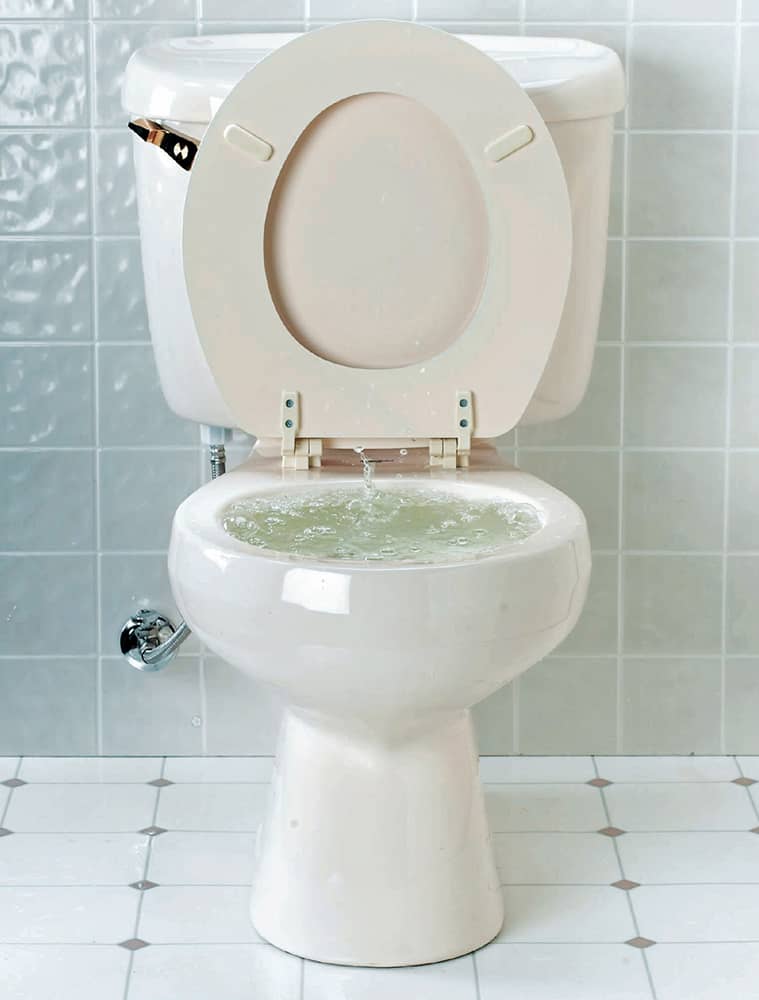
A blockage in the toilet bowl leaves flush water from the tank nowhere to go but on the floor.
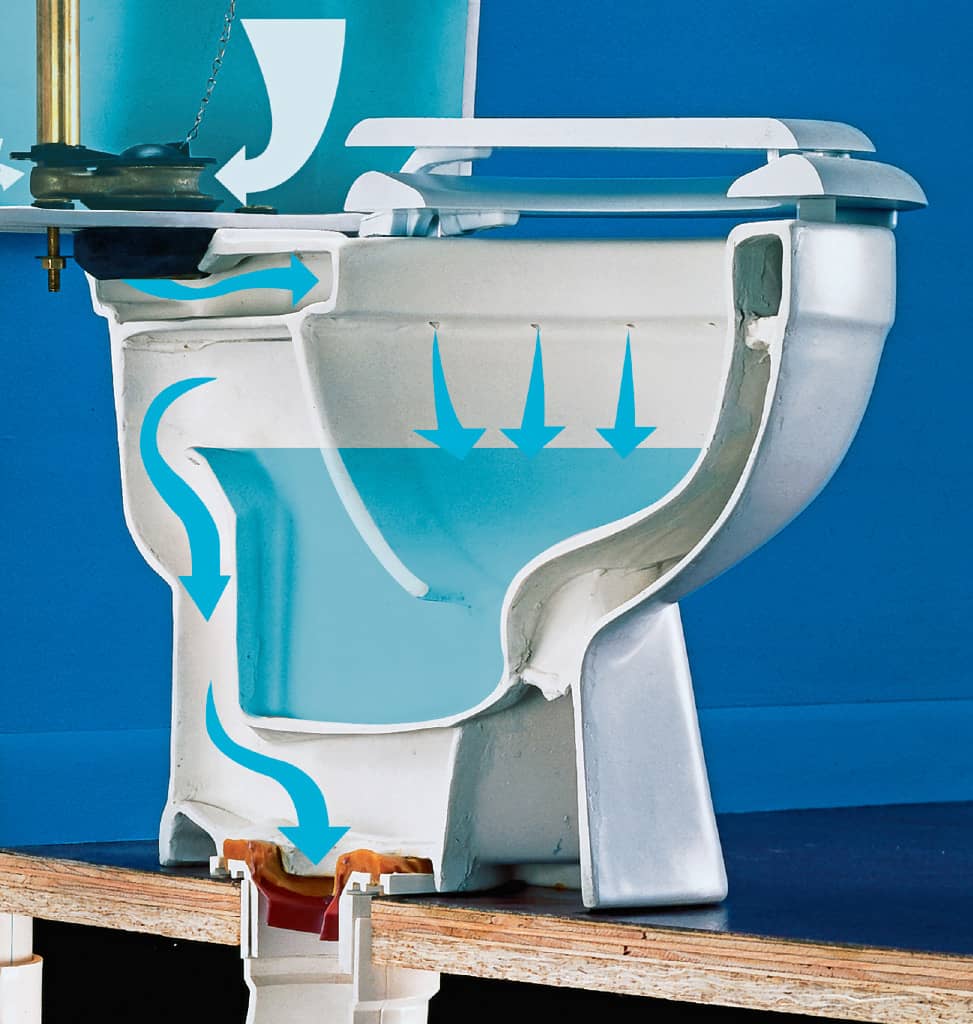
The trap is the most common catching spot for toilet clogs. Once the clog forms, flushing the toilet cannot generate enough water power to clear the trap, so flush water backs up. Traps on modern 1.6-gallon toilets have been redesigned to larger diameters and are less prone to clogs than the first generation of 1.6-gallon toilets.
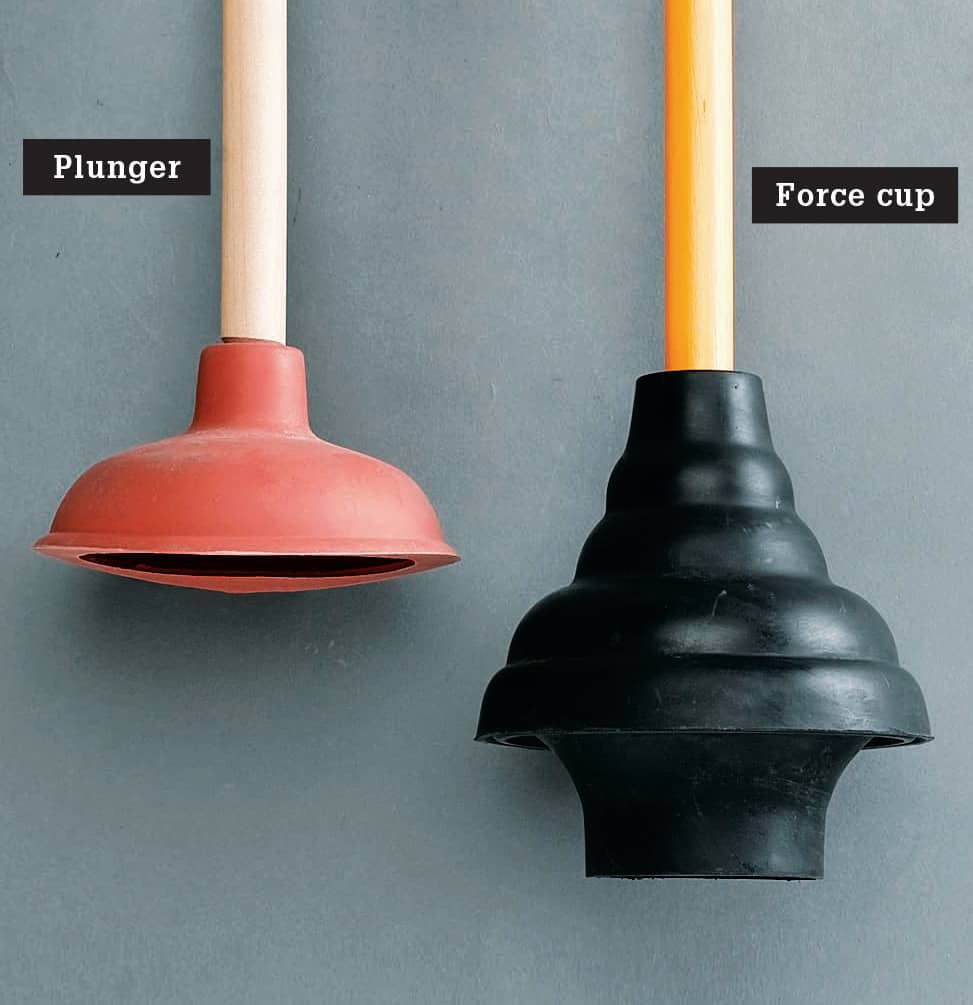
Not all plungers were created equal. The standard plunger (left) is simply an inverted rubber cup and is used to plunge sinks, tubs, and showers. The flanged plunger, also called a force cup, is designed to get down into the trap of a toilet drain. You can fold the flange up into the flanged plunger cup and use it as a standard plunger.
How to Plunge a Clogged Toilet
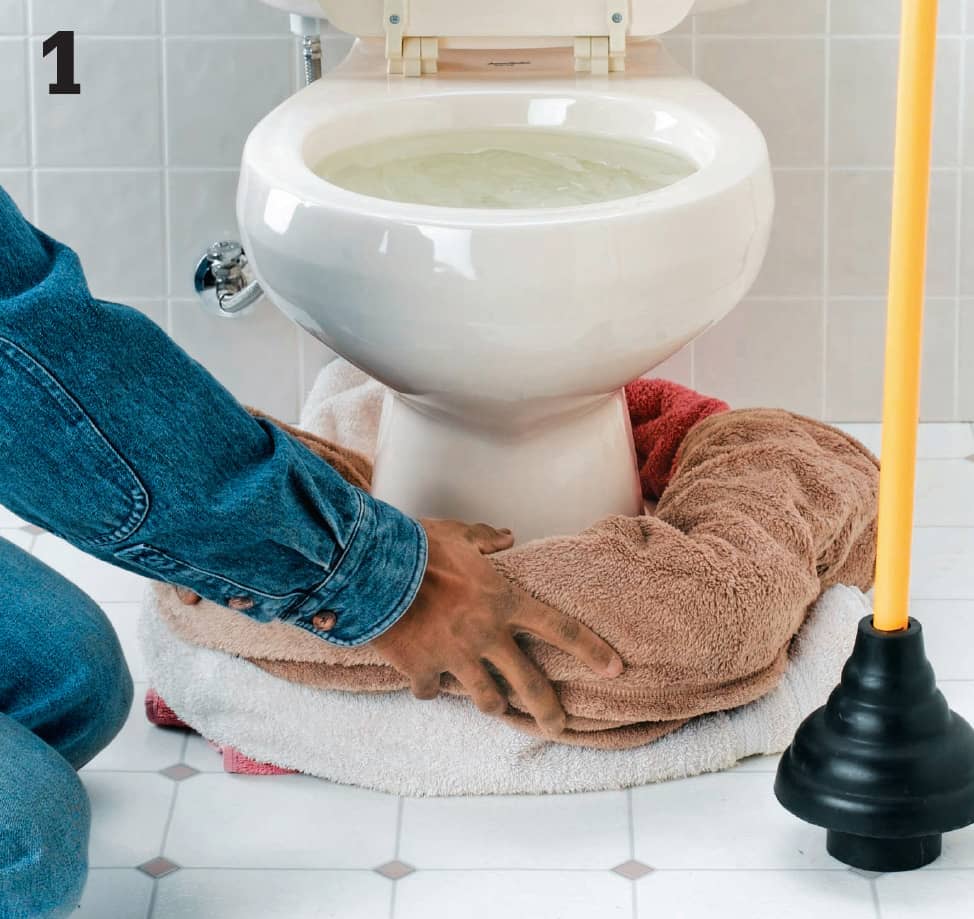
Plunging is the easiest way to remove “natural” blockages. Take time to lay towels around the base of the toilet and remove other objects to a safe, dry location, since plunging may result in splashing. Often, allowing a very full toilet to sit for 20 or 30 minutes will permit some of the water to drain to a less precarious level.
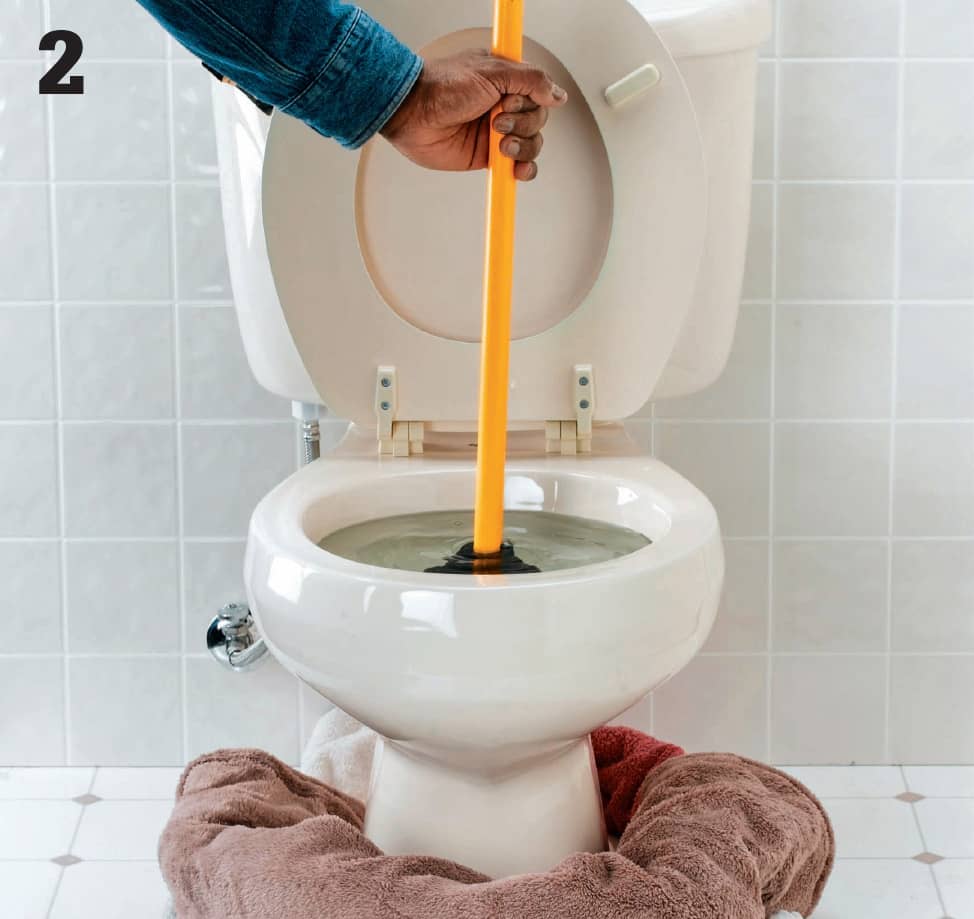
There should be enough water in the bowl to completely cover the plunger. Fold out the skirt from inside the plunger to form a better seal with the opening at the base of the bowl. Pump the plunger vigorously half-a-dozen times, take a rest, and then repeat. Try this for four to five cycles.
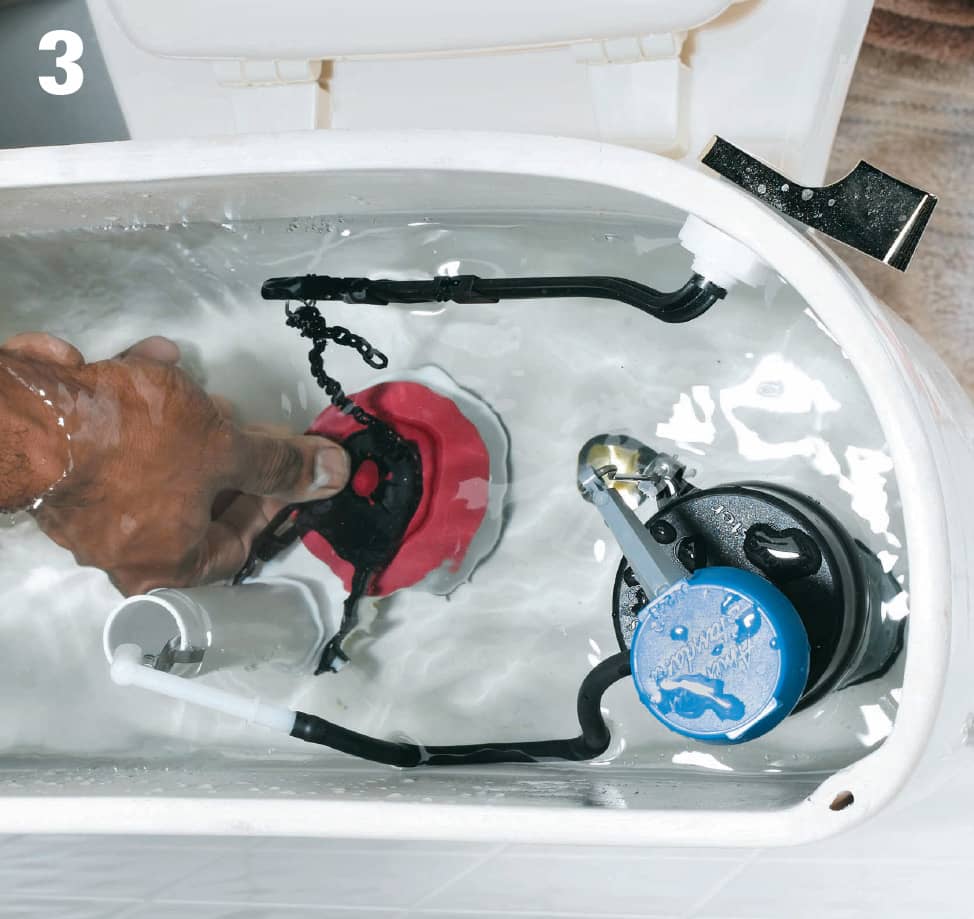
If you force enough water out of the bowl that you are unable to create suction with the plunger, put a controlled amount of water in the bowl by lifting up on the flush valve in the tank. Resume plunging. When you think the drain is clear, you can try a controlled flush, with your hand ready to close the flush valve should the water threaten to spill out of the bowl. Once the blockage has cleared, dump a 5-gallon pail of water into the toilet to blast away any residual debris.
How to Clear Clogs with a Closet Auger
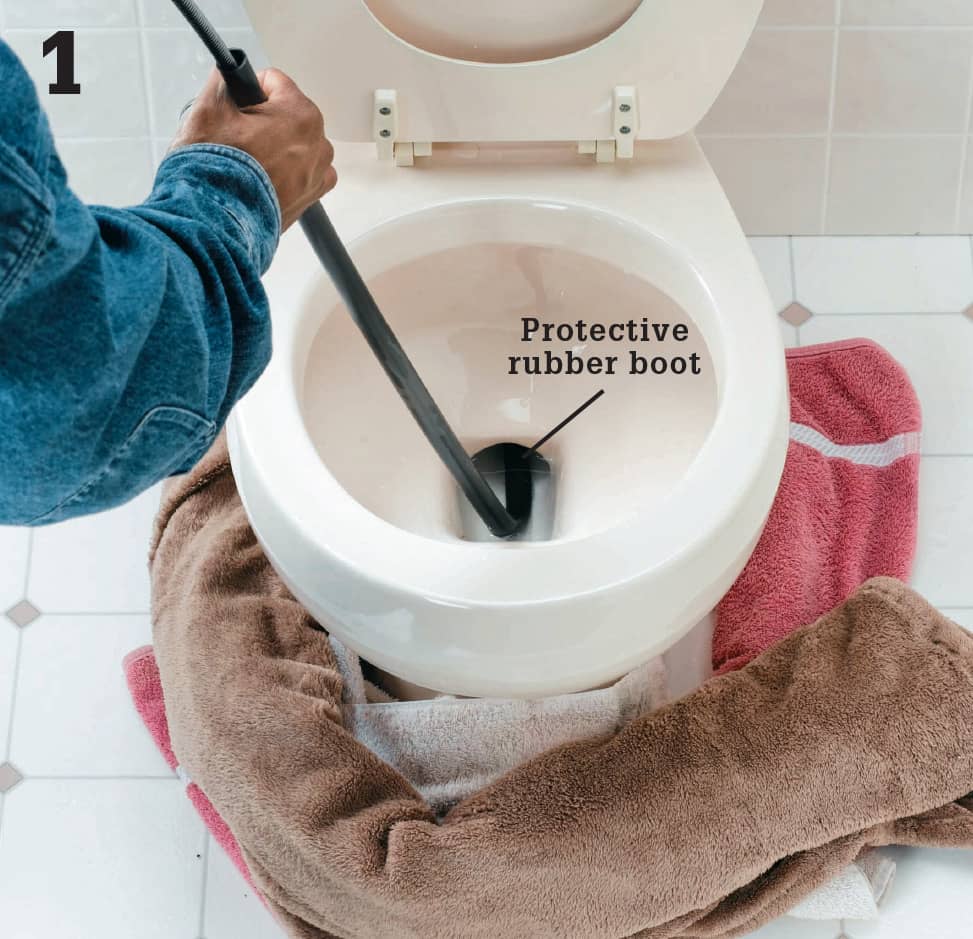
Place the business end of the auger firmly in the bottom of the toilet bowl with the auger tip fully withdrawn. A rubber sleeve will protect the porcelain at the bottom bend of the auger. The tip will be facing back and up, which is the direction the toilet trap takes.
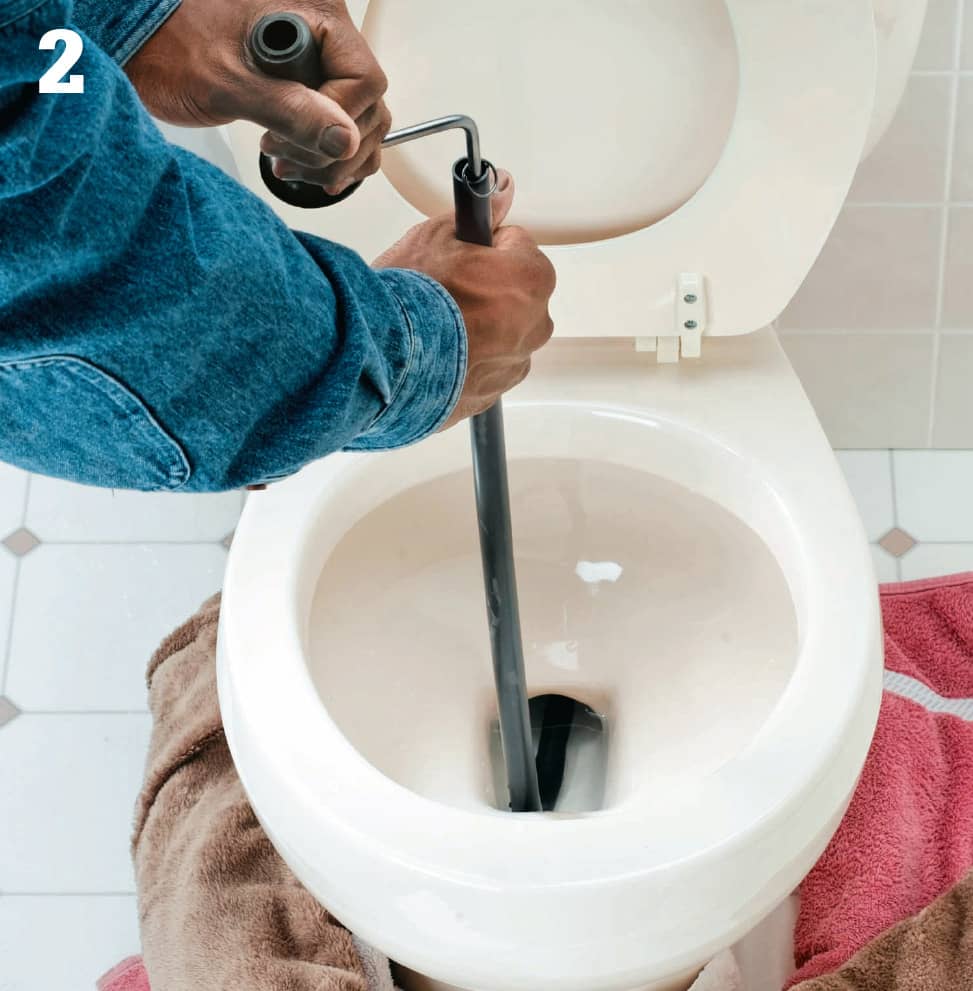
Rotate the handle on the auger housing clockwise as you push down on the rod, advancing the rotating auger tip up into the back part of the trap. You may work the cable backward and forward as needed, but keep the rubber boot of the auger firmly in place in the bowl. When you feel resistance, indicating you’ve snagged the object, continue rotating the auger counterclockwise as you withdraw the cable and the object.
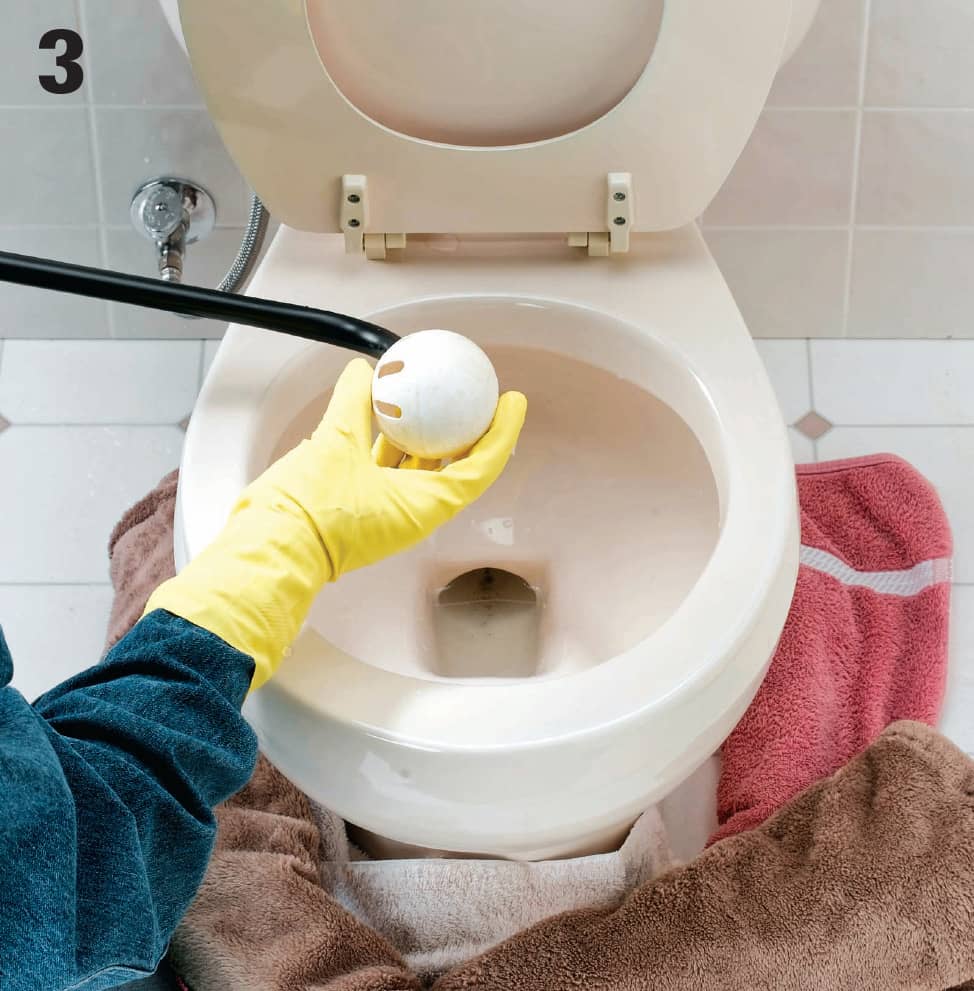
Fully retract the auger until you have recovered the object. This can be frustrating at times, but it is still a much easier task than the alternative—to remove the toilet and go fishing.
 Fixing Toilet Flanges
Fixing Toilet Flanges
If your toilet rocks, it will eventually leak. The rocking means that the bolts are no longer holding the toilet securely to the floor. If you have tightened the bolts and it still rocks, it is possible that a bolt has broken a piece of the flange off and is no longer able to hold. Rocking might also be because an ongoing leak has weakened the floor and it is now uneven. Whatever the reason, a rocking toilet needs to be fixed.
If your flange is connected to cast-iron piping, use a repair flange. This has a rubber compression ring that will seal the new flange to the cast-iron pipe.
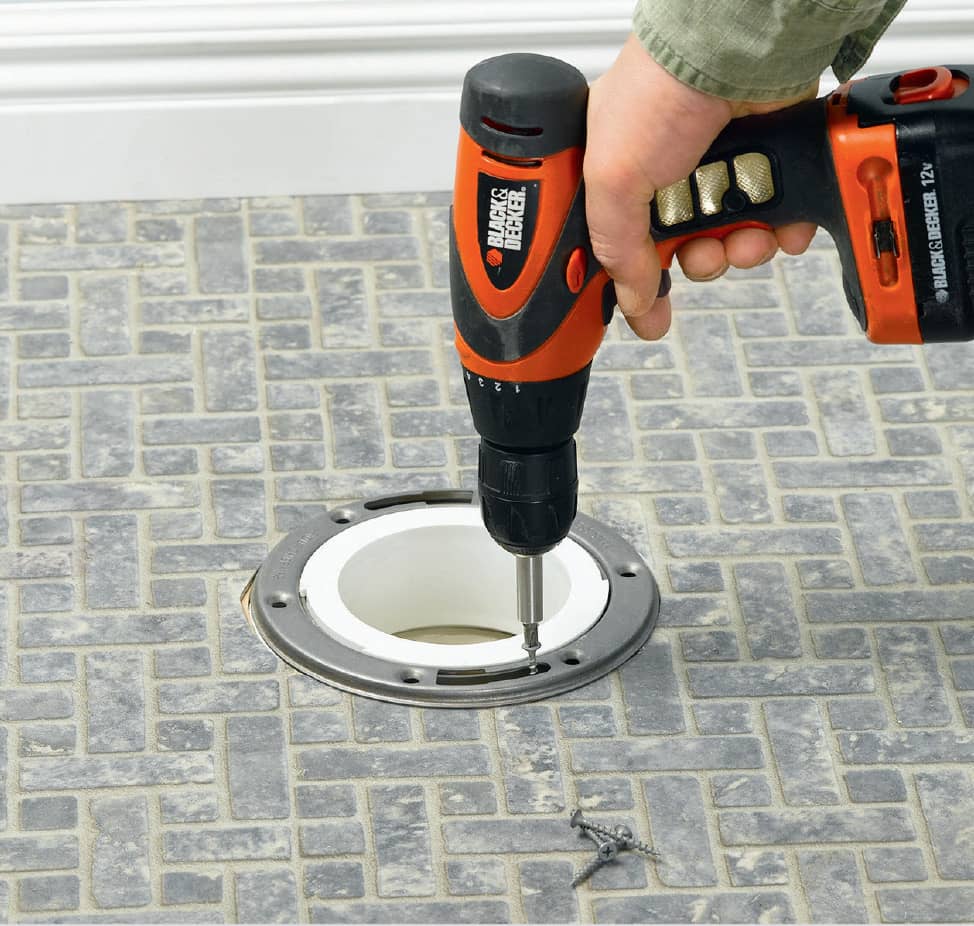
Use a flange repair kit for a quick fix to a broken flange. The new flange piece from the kit is simply screwed to the floor after it has been oriented correctly over the broken flange.
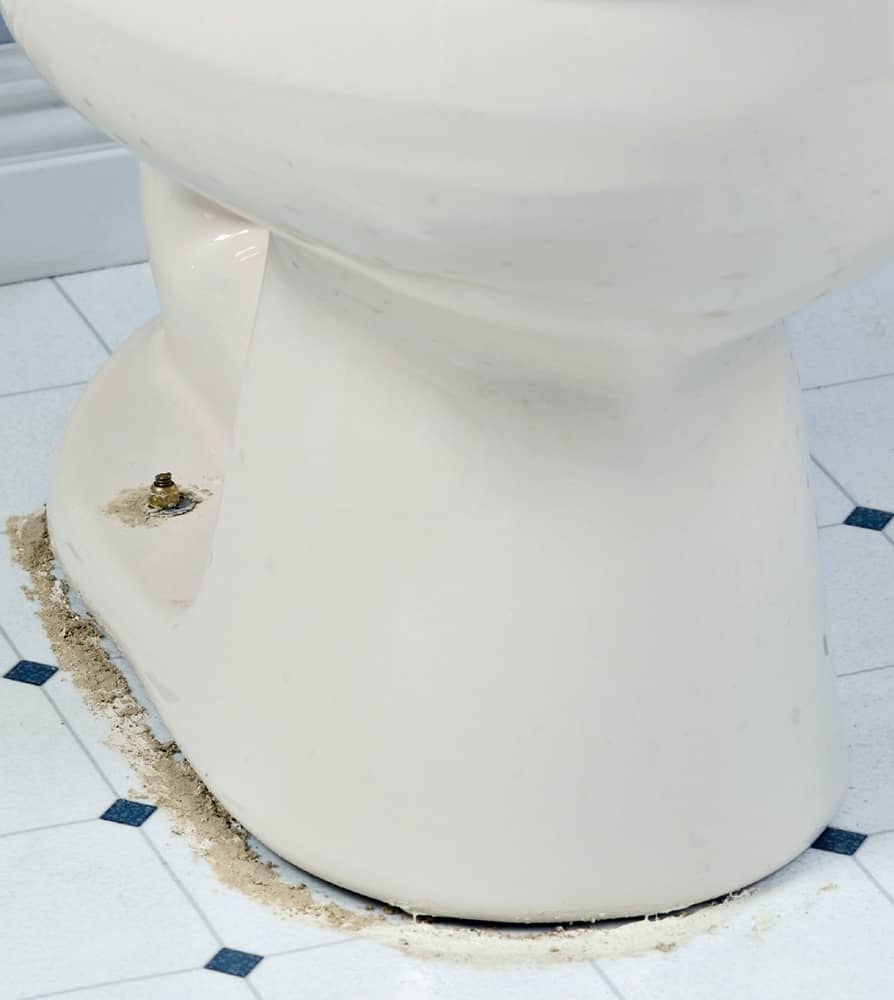
Toilets that rock often only need to have the nuts on the closet bolts tightened. But if you need to tighten the bolts on an ongoing basis, you very likely have a problem with the closet flange.
How to Replace a PVC Closet Flange
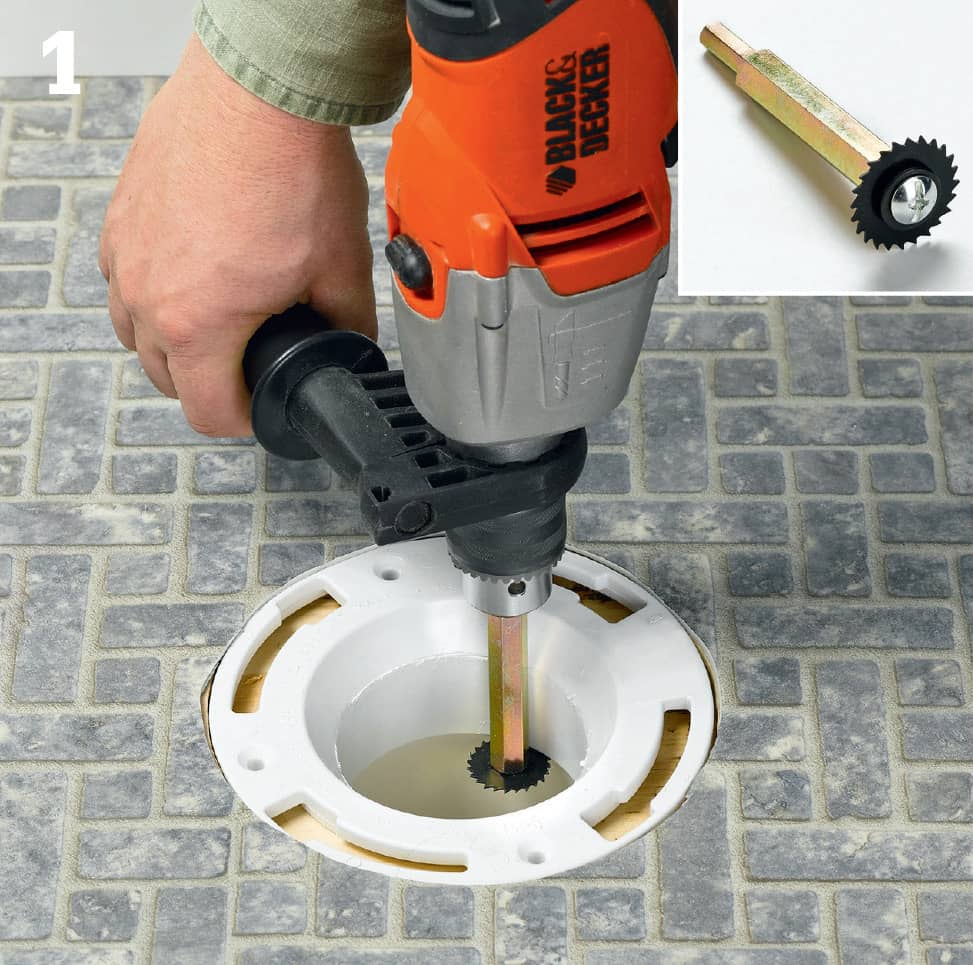
Begin by removing the toilet and wax ring. Cut the pipe just below the bottom of the flange using an internal pipe cutter (inset, available at plumbing supply stores). Remove the flange.
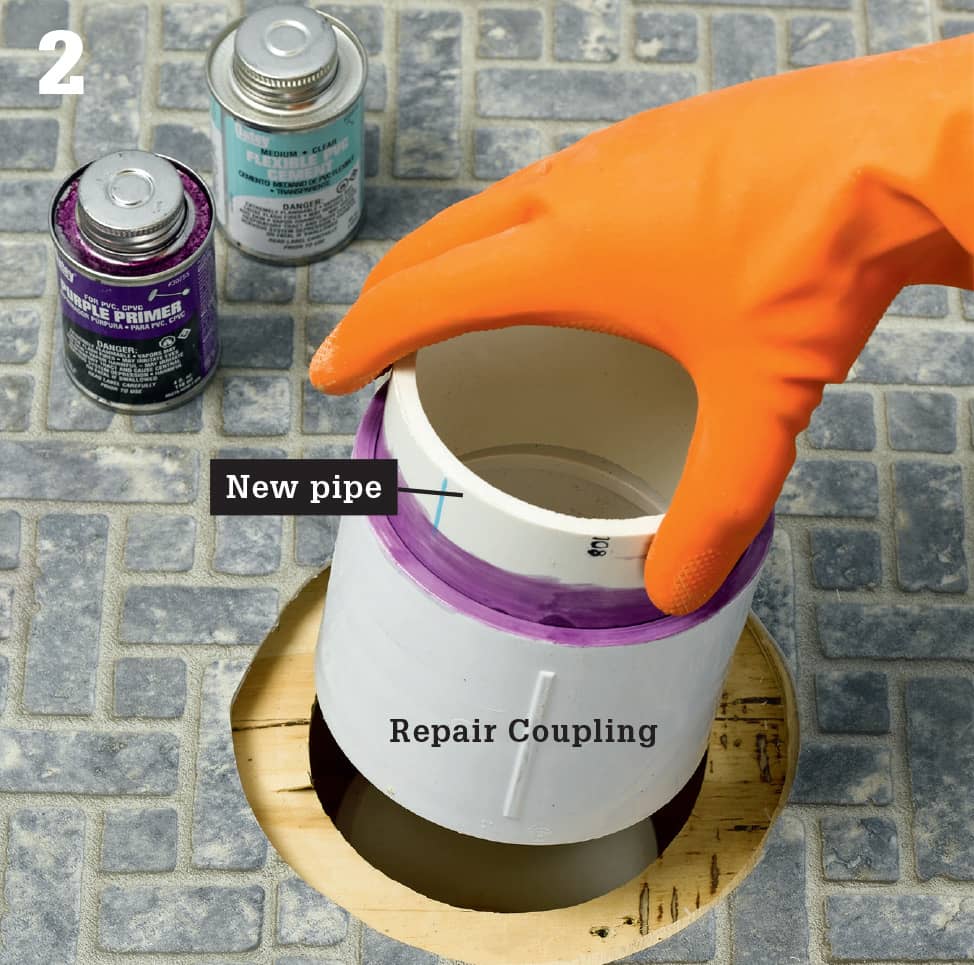
If your flange is attached to a closet bend, you will need to open up the floor around the toilet to get at the horizontal pipe connecting the bend to the stack to make the repair. If it is connected to a length of vertical plastic pipe, use a repair coupling and a short length of pipe to bring the pipe back up to floor level. Cement the new pipe into the repair coupling first and allow it to set. Clean the old pipe thoroughly before cementing.
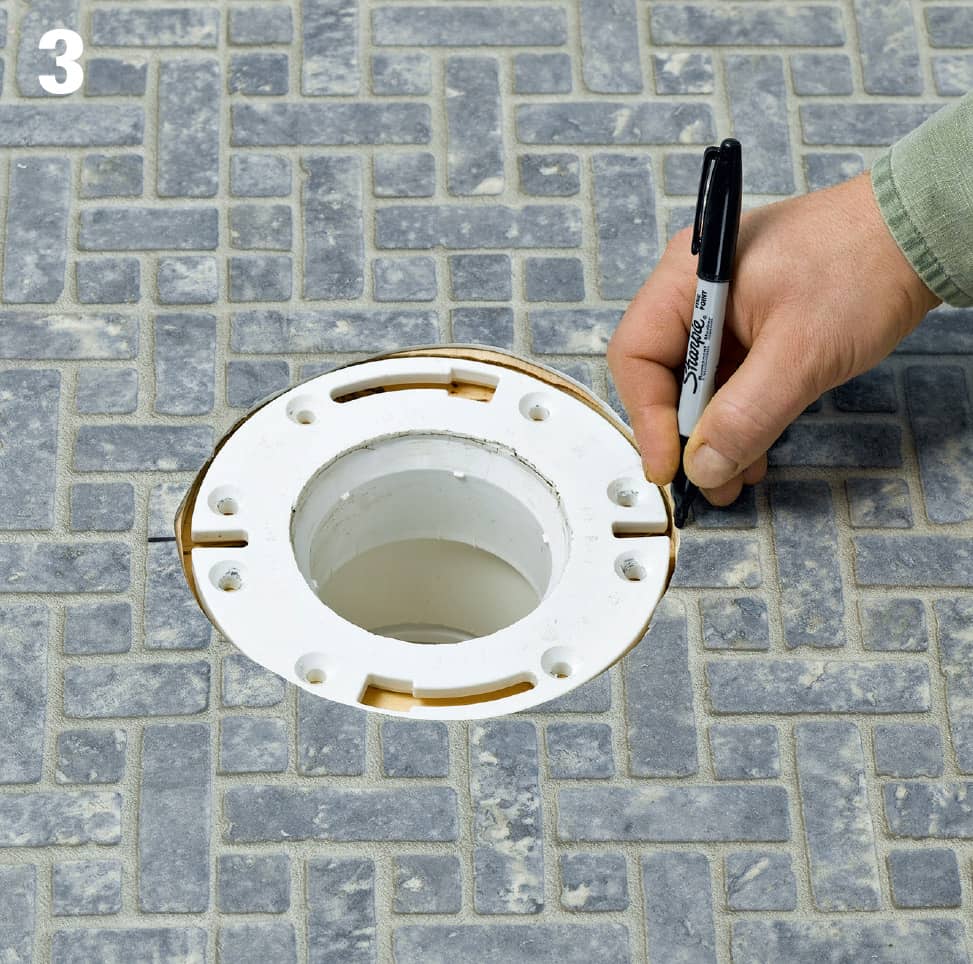
Cut the replacement pipe flush with the floor. Dry-fit the new flange into the pipe. Turn the flange until the side cut-out screw slots are parallel to the wall. (Do not use the curved keyhole slots, as they are not as strong.) Draw lines to mark the location of the slots on the floor.
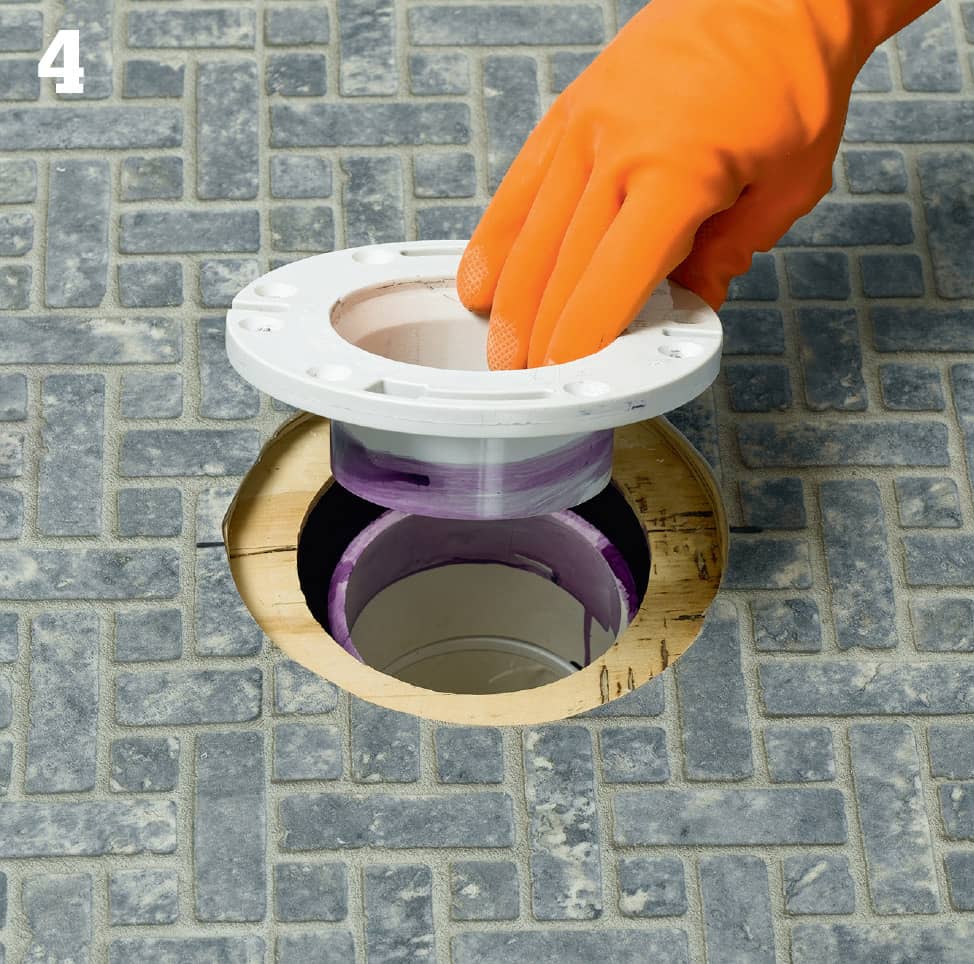
Prime and solvent-cement the pipe and flange, inserting the flange slightly off the marks and twisting it to proper alignment. Secure the flange to the floor with #10 stainless-steel flathead wood screws.
 Fixing Sink Faucets
Fixing Sink Faucets
It’s not surprising that sink faucets leak and drip. Any fitting that contains moving mechanical parts is susceptible to failure. But add to the equation the persistent force of water pressure working against the parts, and the real surprise is that faucets don’t fail more quickly or often. It would be a bit unfair to say that the inner workings of a faucet are regarded as disposable by manufacturers, but it is safe to say that these parts have become more easy to remove and replace.
The older your faucet, the more likely you can repair it by replacing small parts like washers and O-rings. Many newer faucets can be repaired only by replacing the major inner components, like a ceramic disk or a cartridge that encapsulates all the washers and O-rings that could possibly wear out.
The most important aspect of sink faucet repair is identifying which type of faucet you own. In this chapter we show all of the common types and provide instructions on repairing them. In every case, the easiest and most reliable repair method is to purchase a replacement kit with brand-new internal working parts for the model and brand of faucet you own.
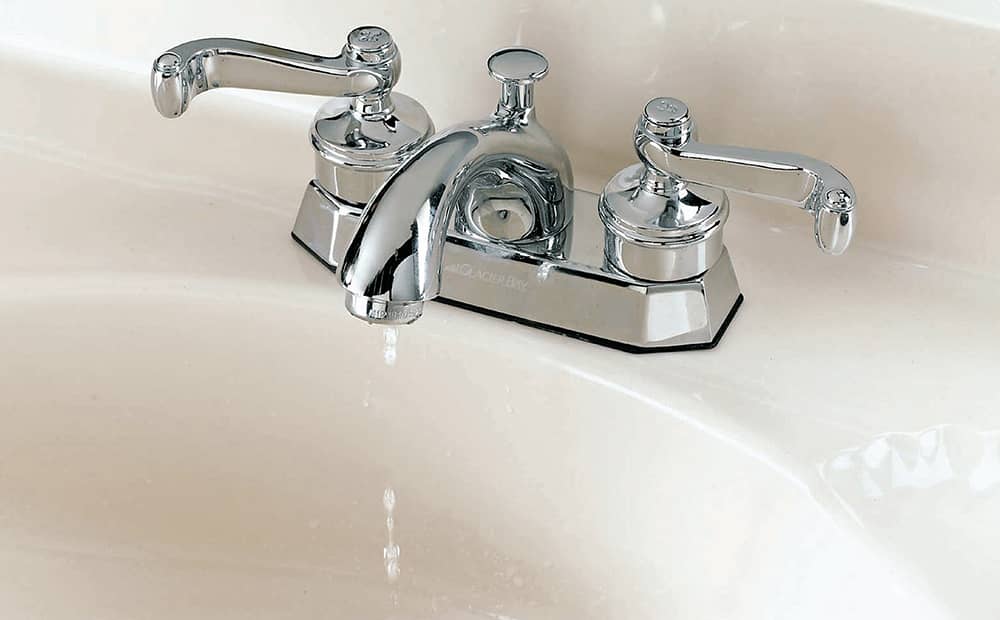
Eventually, just about every faucet develops leaks and drips. Repairs can usually be accomplished simply by replacing the mechanical parts inside the faucet body (the main trick is figuring out which kind of parts your faucet has).
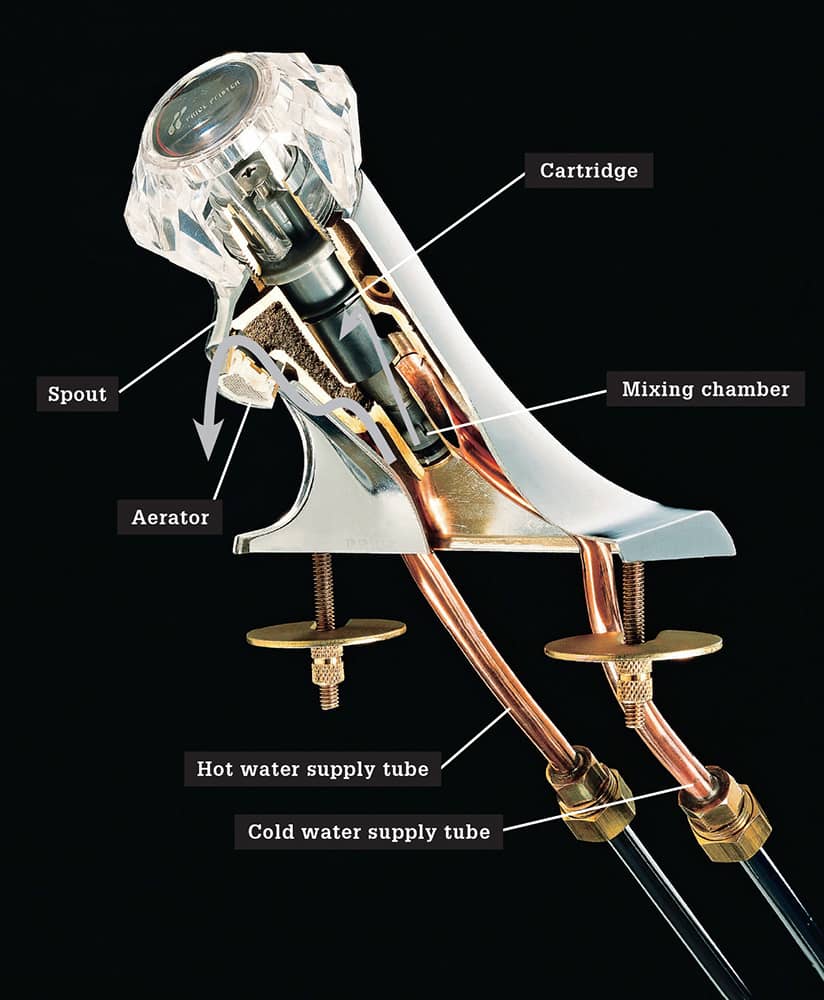
All faucets, no matter the type, have valves that move many thousands of times to open and close hot- and cold-water ports. These valves—or the rubber or plastic parts that rub against other parts when the faucet is being adjusted—wear out in time. Depending on the faucet, you may be able to fix the leak by cleaning or replacing small parts, such as washers or O-rings; or you may need to buy a repair kit and replace a number of parts; or the only solution may be to replace a self-enclosed “cartridge” that contains all the moving parts.
Identifying Your Faucet and the Parts You Need
A leaky faucet is the most common home plumbing problem. Fortunately, repair parts are available for almost every type of faucet, from the oldest to the newest, and installing these parts is usually easy. But if you don’t know your make and model, the hardest part of fixing a leak may be identifying your faucet and finding the right parts. Don’t make the common mistake of thinking that any similar-looking parts will do the job; you’ve got to get exact replacements.
There are so many faucet types that even experts have trouble classifying them into neat categories. Two-handle faucets are either compression (stem) or washerless two-handle. Single-handle faucets are classified as mixing cartridge; ball; disc; or disc/cartridge.
A single-handle faucet with a rounded, dome-shaped cap is often a ball type. If a single-handle faucet has a flat top, it is likely a cartridge or a ceramic disc type. An older two-handle faucet is likely of the compression type; newer two-handle models use washerless cartridges. Shut off the water, and test to verify that the water is off. Dismantle the faucet carefully. Look for a brand name: it may be clearly visible on the baseplate, or may be printed on an inner part, or it may not be printed anywhere. Put all the parts into a reliable plastic bag and take them to your home center or plumbing supply store. A knowledgeable salesperson can help you identify the parts you need.
If you cannot find what you are looking for at a local store, check online faucet sites or the manufacturers’ sites; they often have step-by-step instruction for identifying what you need. Note that manufacturers’ terminology may not match the terms we use here. For example, the word “cartridge” may refer to a ceramic-disc unit.
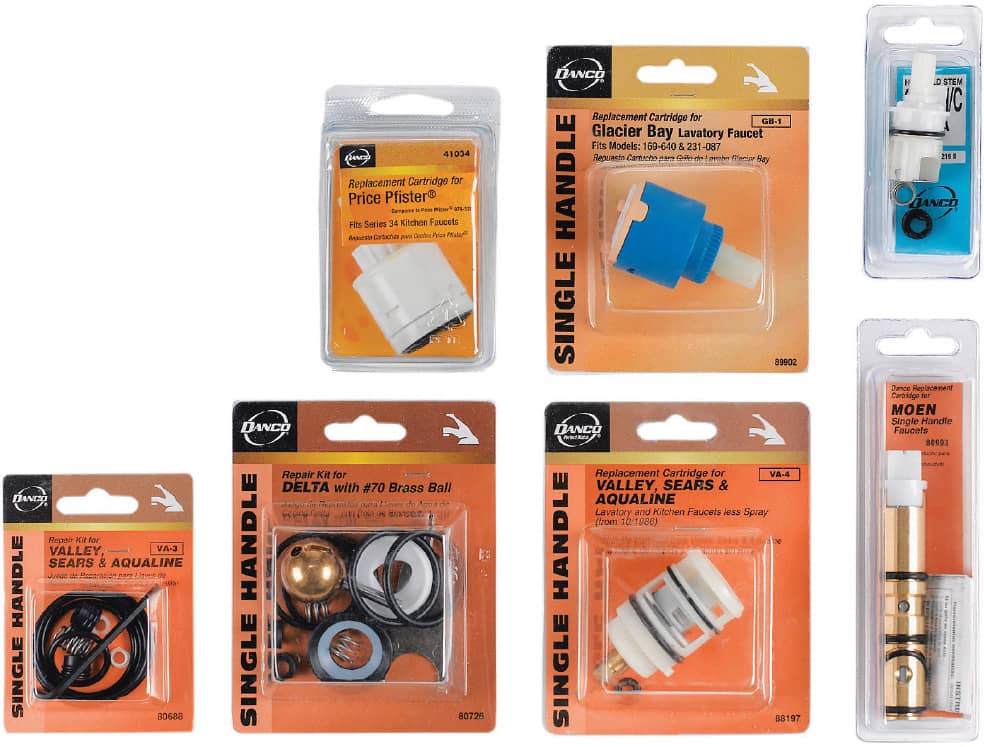
Most faucets have repair kits, which include all the parts you need, and sometimes a small tool as well. Even if some of the parts in your faucet look fine, it’s a good idea to install the parts provided by the kit, to ensure against future wear.
Compression Faucets
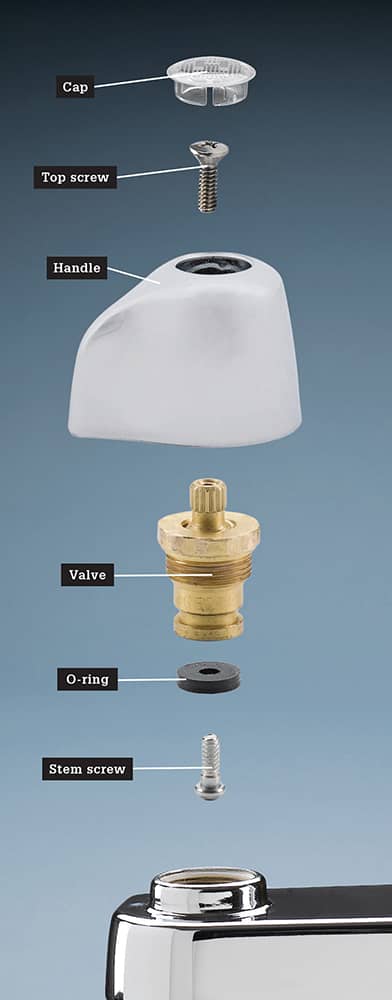
A compression faucet has a stem assembly that includes a retaining nut, threaded spindle, O-ring, stem washer, and stem screw. Dripping at the spout occurs when the washer becomes worn. Leaks around the handle are caused by a worn O-ring.
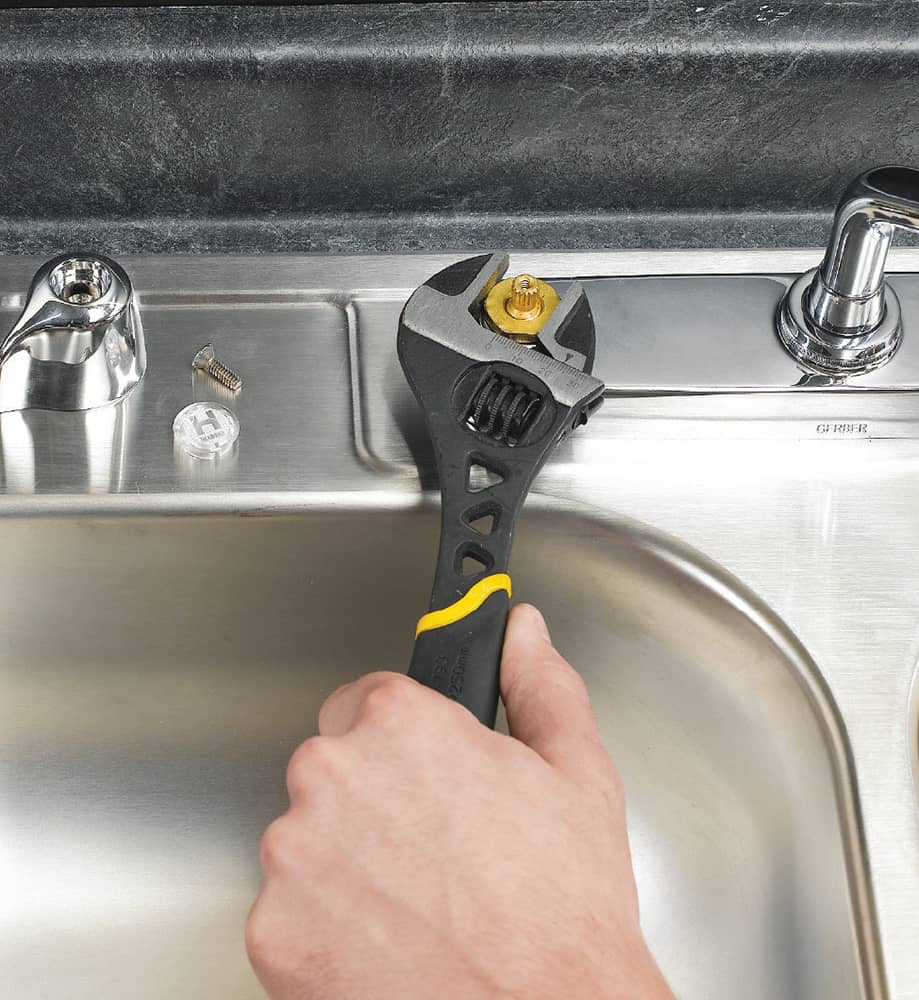
Pry off the cap on top of the handle and remove the screw that holds the cap onto the stem. Pull the handle up and out. Use an adjustable wrench or pliers to unscrew the stem and pull it out.
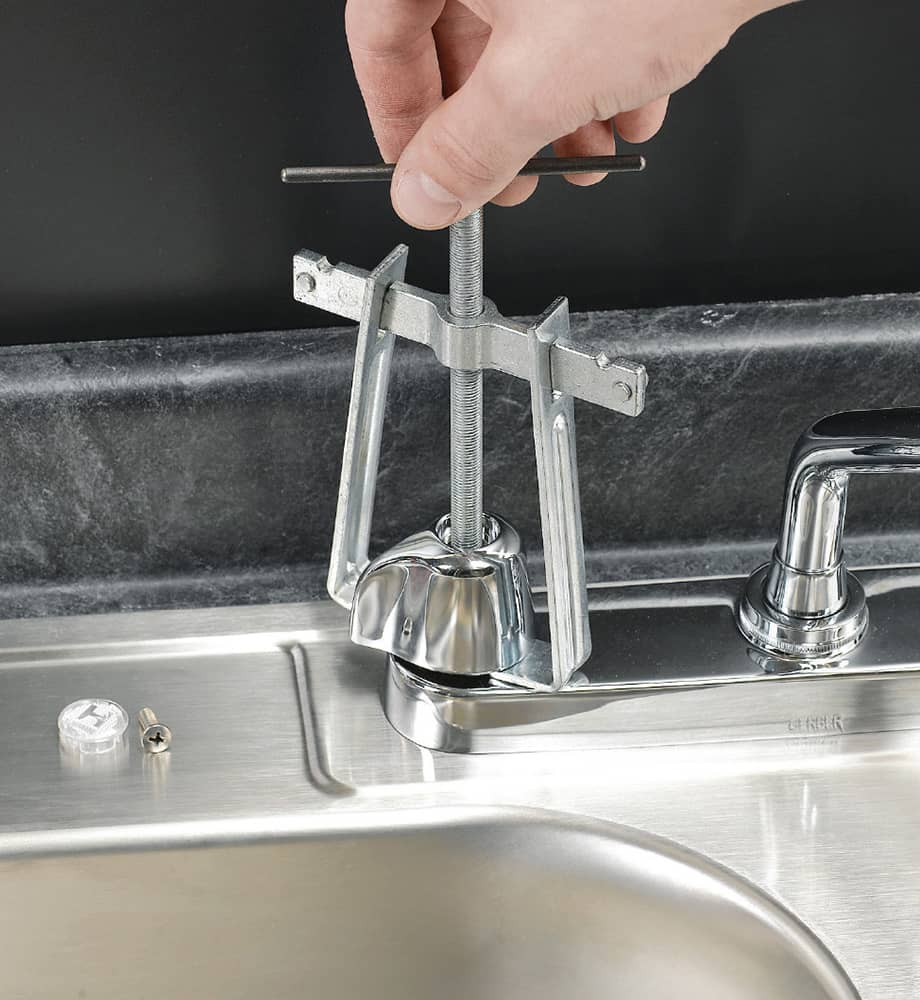
If the handle is stuck, try applying mineral cleaner from above. If that doesn’t work, you may need to buy a handle puller. With the cap and the hold-down screw removed, position the wings of the puller under the handle and tighten the puller to slowly pull the handle up.
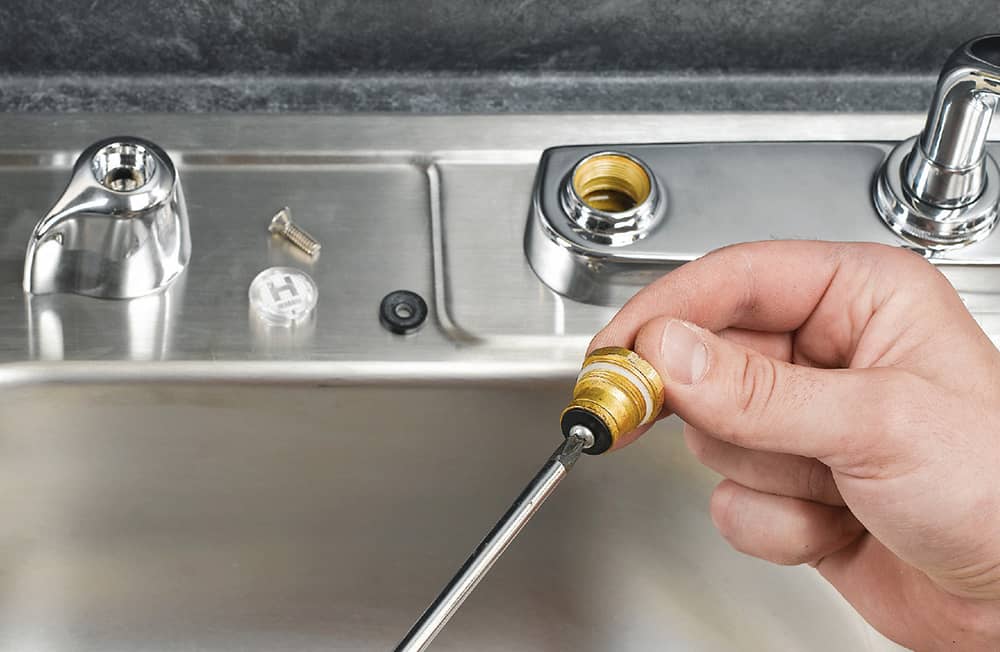
Remove the screw that holds the rubber washer in place, and pry out the washer. Replace a worn washer with an exact replacement—one that is the same diameter, thickness, and shape.
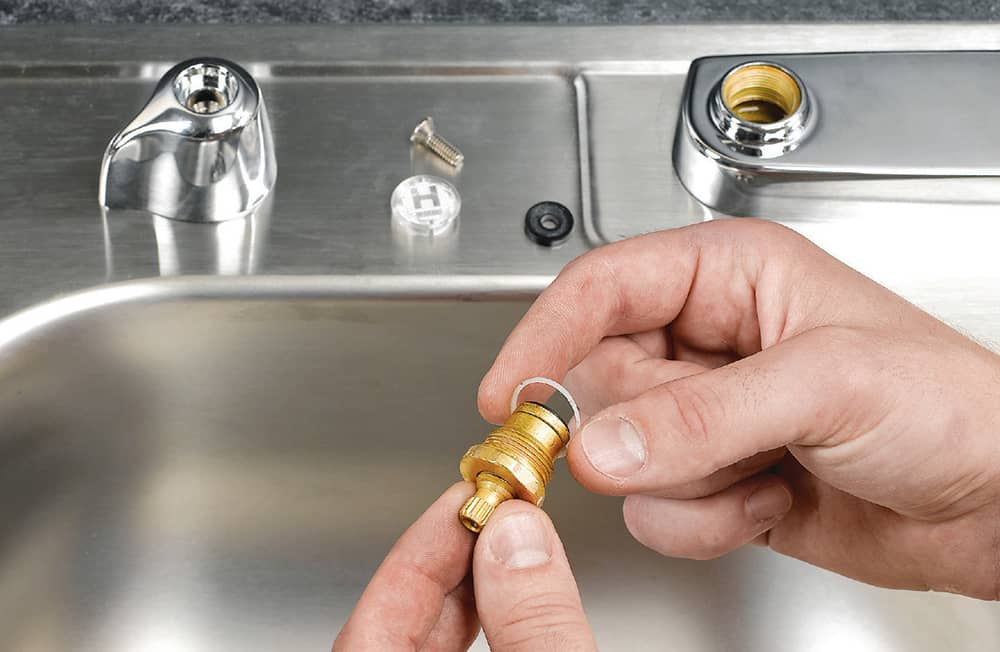
Replace any O-rings. A worn O-ring can cause water to leak out the handle. Gently pry out the old O-ring and reinstall an exact replacement. Apply plumber’s grease to the rubber parts before reinstalling the stem.
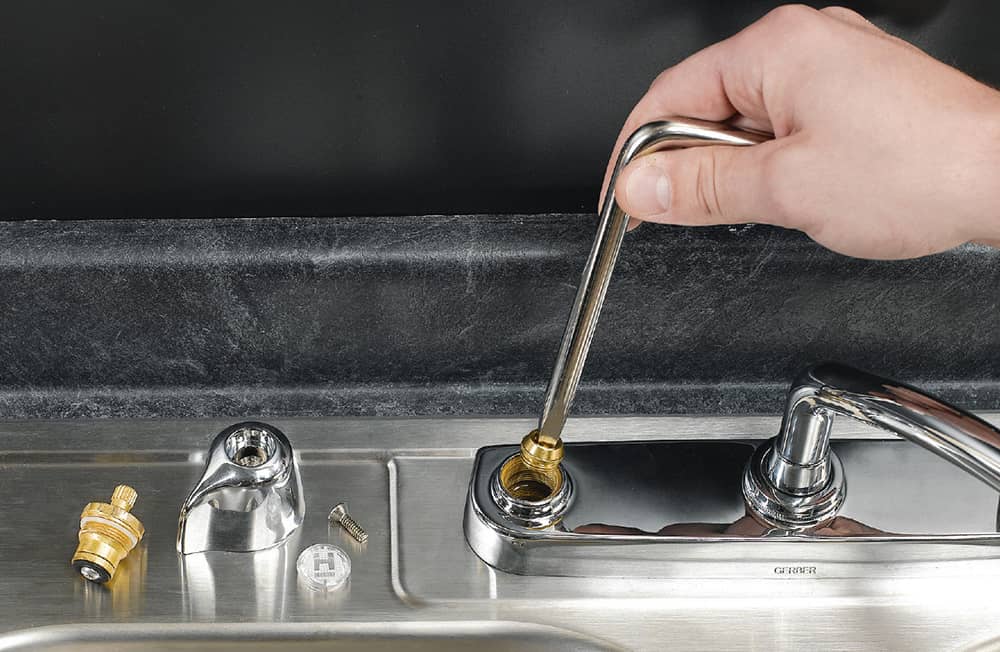
If washers wear out quickly, the seat is likely worn. Use a seat wrench to unscrew the seat from inside the faucet. Replace it with an exact duplicate. If replacing the washer and O-ring doesn’t solve the problem, you may need to replace the entire stem.
Washerless Two-handle Faucet
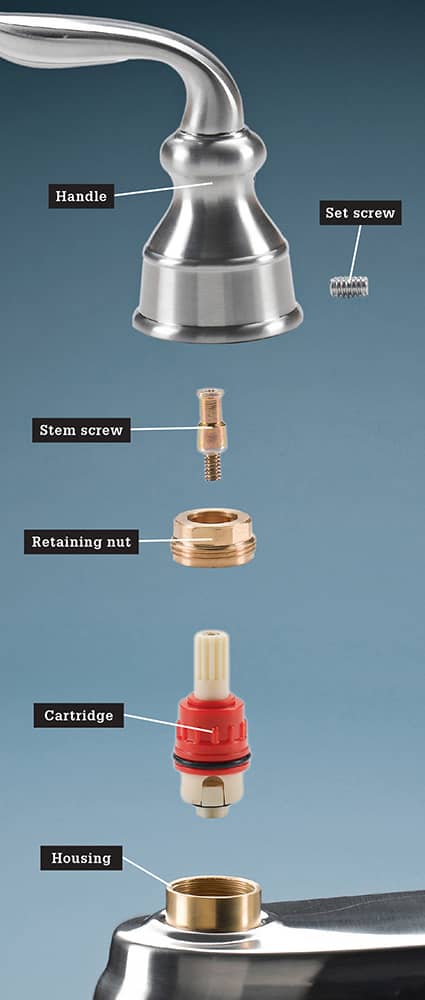
Almost all two-handle faucets made today are “washerless.” Instead of an older-type compression stem, there is a cartridge, usually with a plastic casing. Many of these cartridges contain ceramic discs, while others have metal or plastic pathways. No matter the type of cartridge, the repair is the same; instead of replacing small parts, you simply replace the entire cartridge.
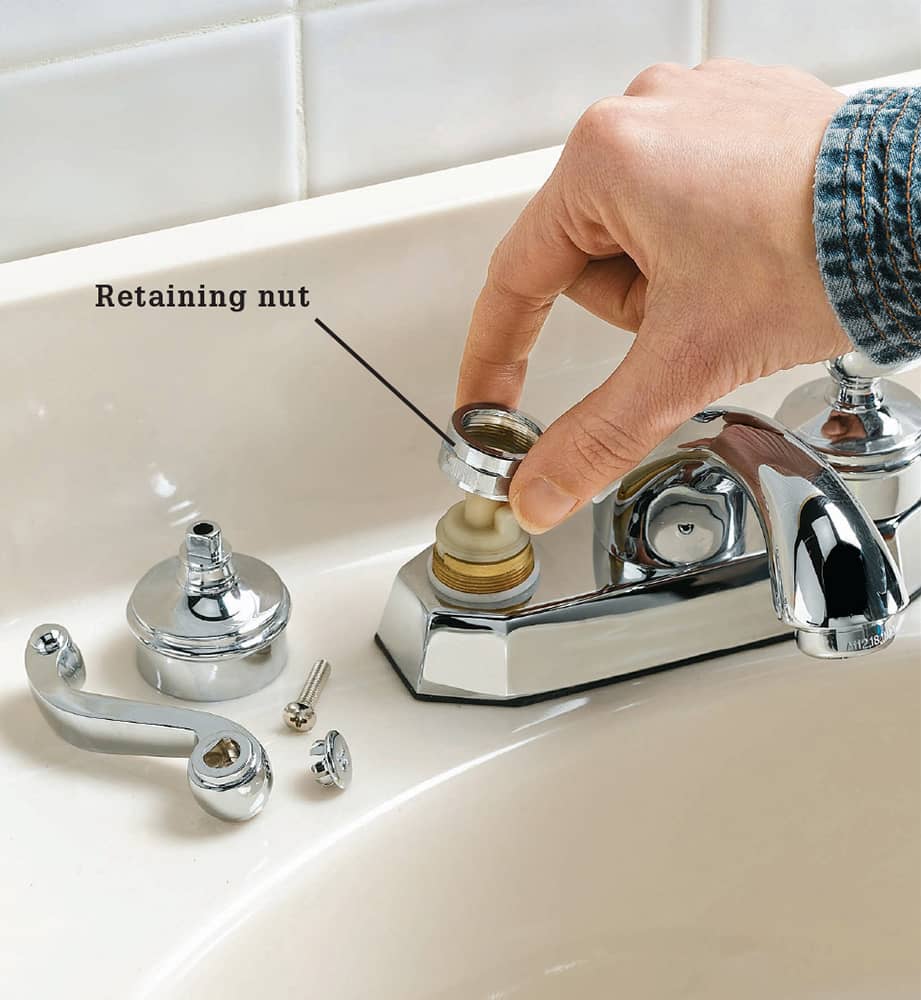
Remove the faucet handle and withdraw the old cartridge. Make a note of how the cartridge is oriented before you remove it. Purchase a replacement cartridge.
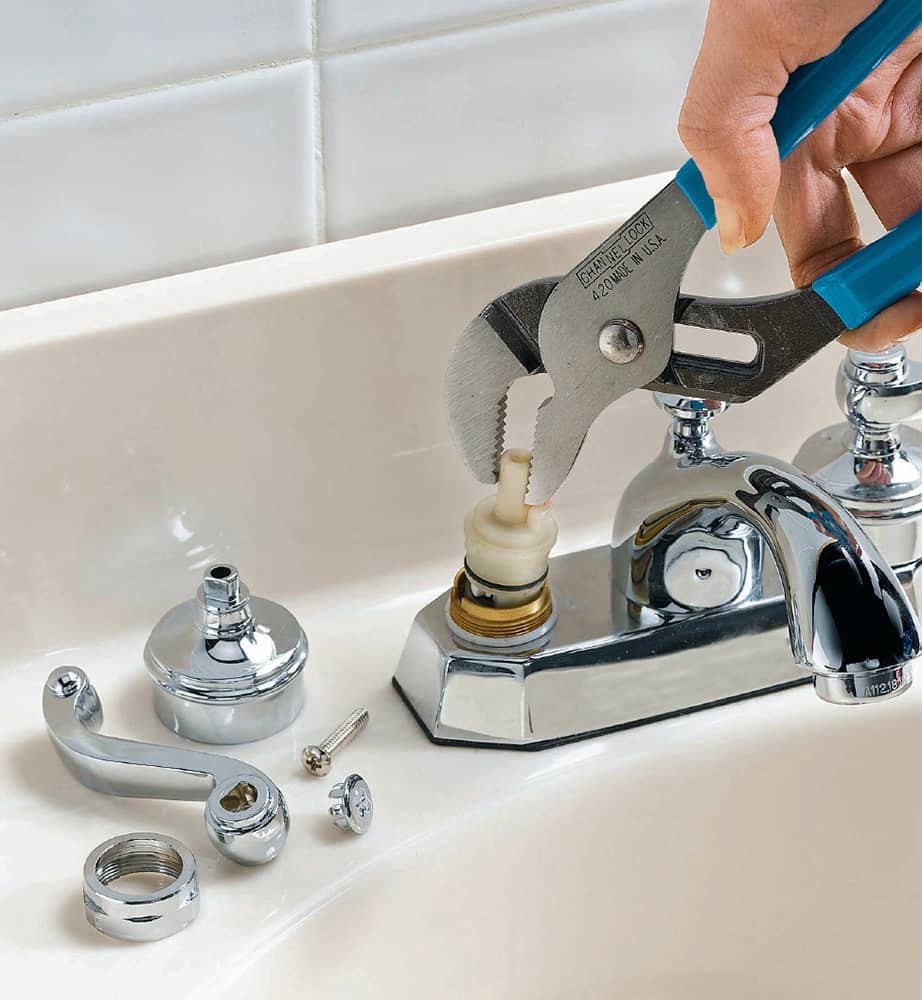
Install the replacement cartridge. Clean the valve seat first and coat the valve seat and O-rings with faucet grease. Be sure the new cartridge is in the correct position, with its tabs seated in the slotted body of the faucet. Re-assemble the valve and handles.
One-Handle Cartridge Faucets
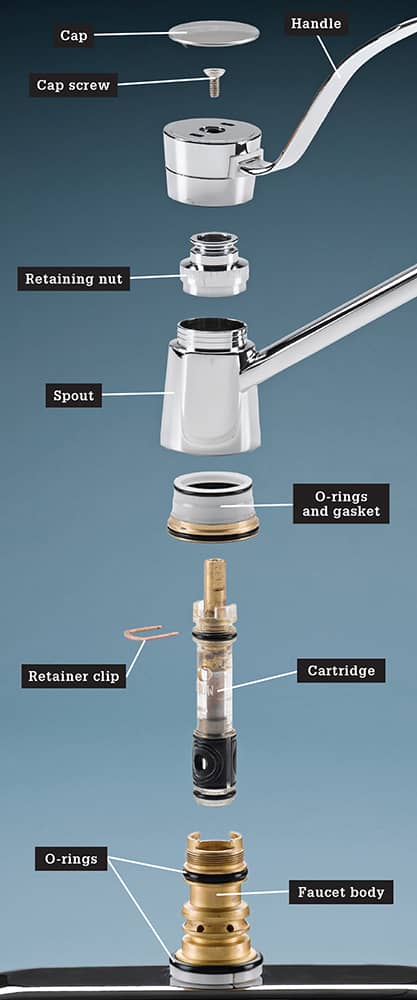
Single-handle cartridge faucets like this work by moving the cartridge up and down and side to side, which opens up pathways to direct varying amounts of hot and cold water to the spout. Moen, Price-Pfister, Delta, Peerless, Kohler, and others make many types of cartridges, some of which look very different from this one.
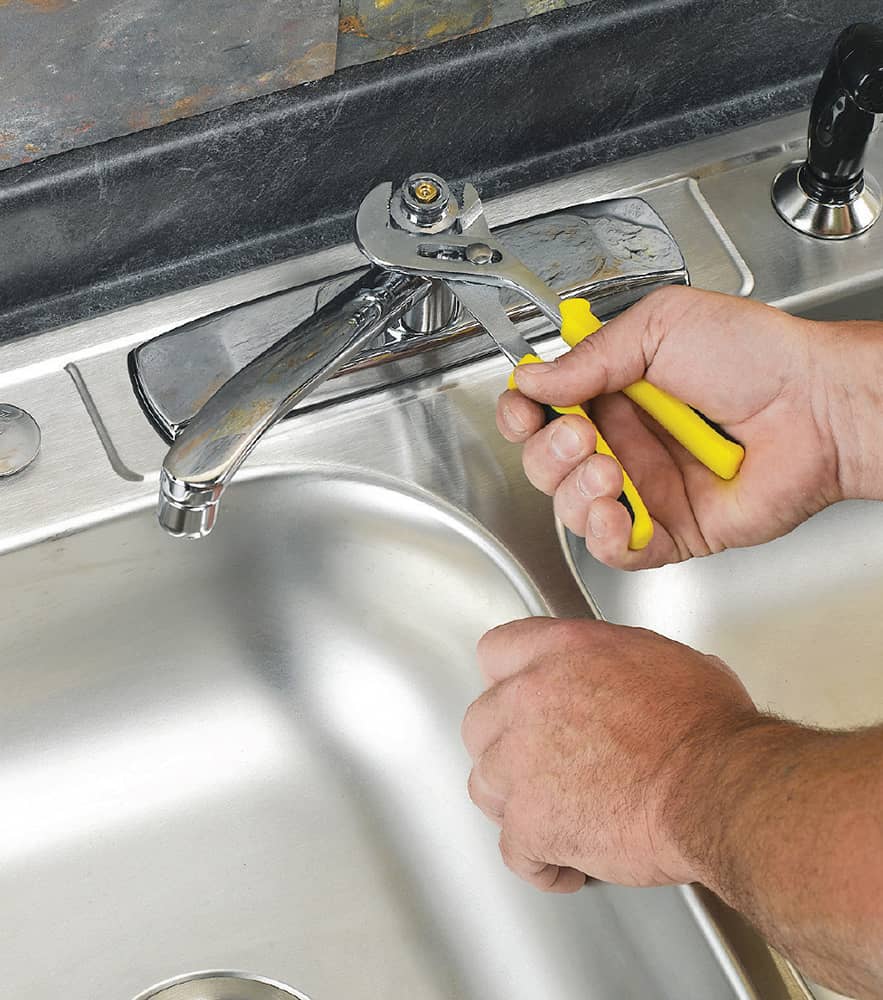
To remove the spout, pry off the handle’s cap and remove the screw below it. Pull the handle up and off. Use a crescent wrench to remove the pivot nut.
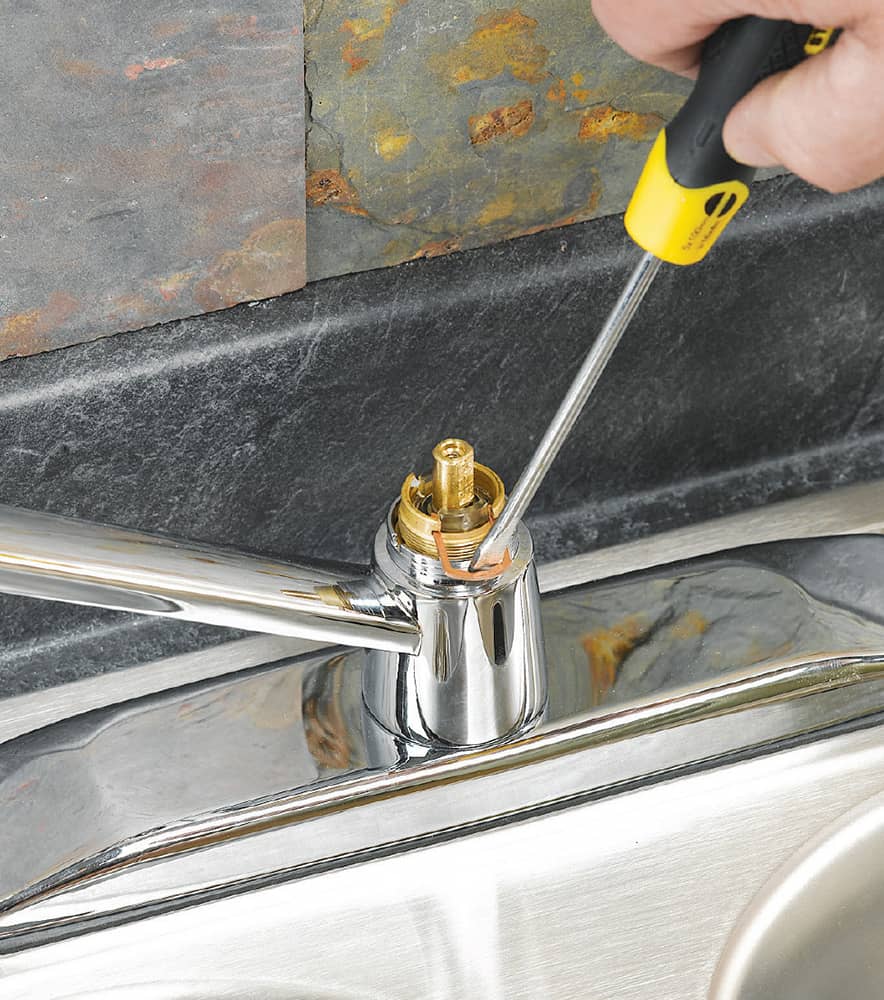
Lift out the spout. If the faucet has a diverter valve, remove it as well. Use a screwdriver to pary out the retainer clip, which holds the cartridge in place.
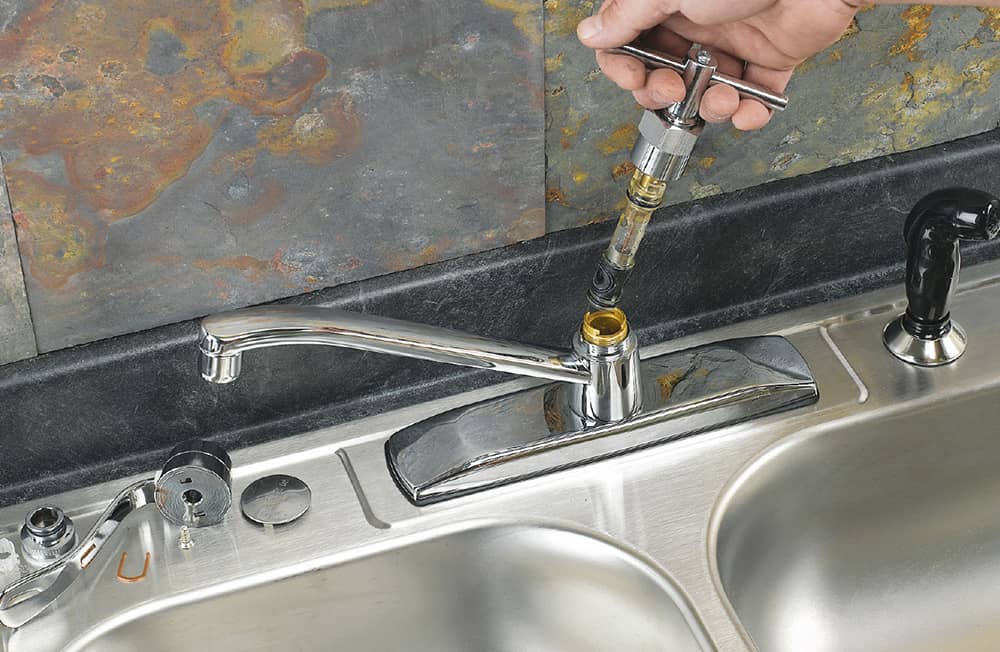
Remove the cartridge. If you simply pull up with pliers, you may leave part of the stem in the faucet body. If that happens, replace the cartridge and buy a stem puller made for your model.
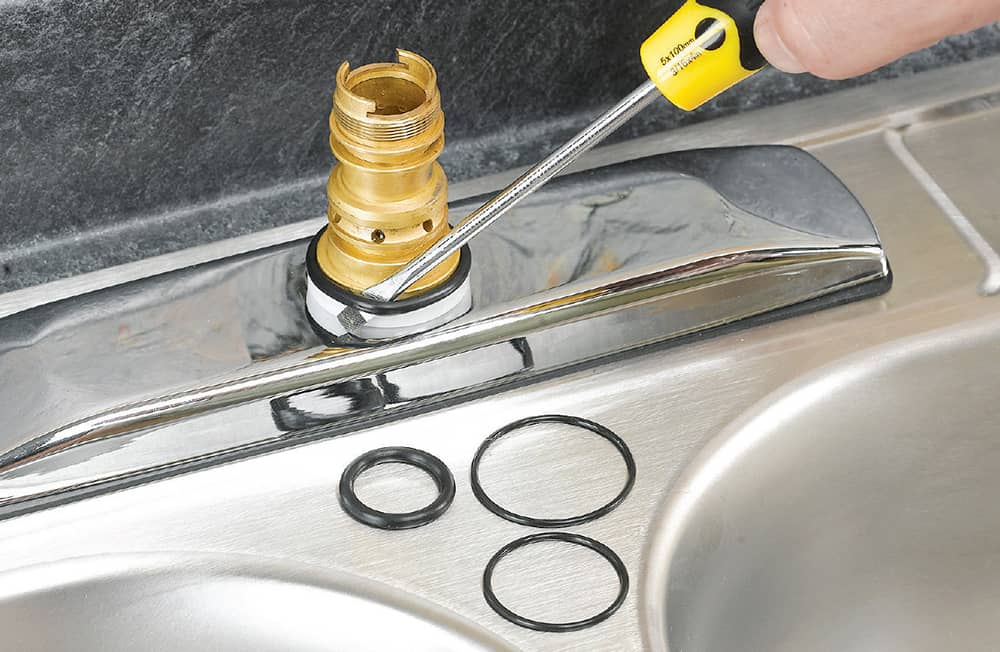
Gently pry out and replace all O-rings on the faucet body. Smear plumber’s grease onto the new replacement cartridge and the new O-rings, and reassemble the faucet.
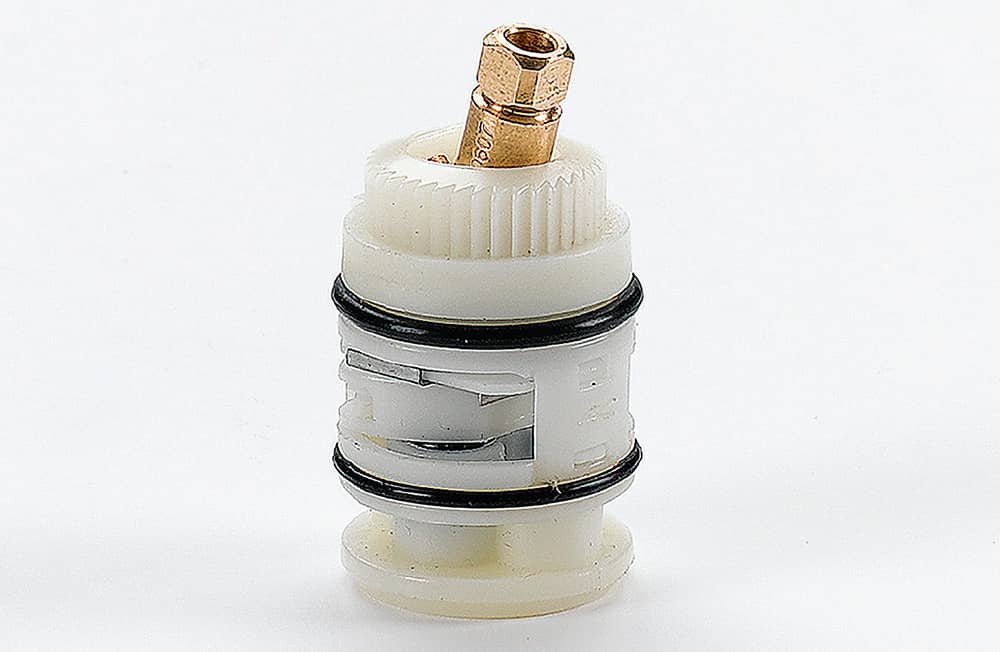
Here is one of many other types of single-handle cartridges. In this model, all the parts are plastic except for the stem, and it’s important to note the direction in which the cartridge is aligned. If you test the faucet and the hot and cold are reversed, disassemble and realign the cartridge.
Ball Faucets
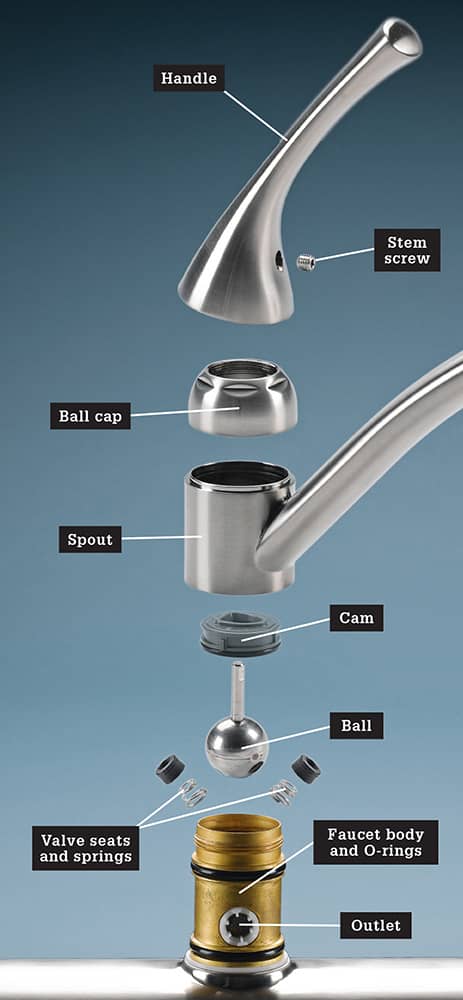
The ball-type faucet is used by Delta, Peerless, and a few others. The ball fits into the faucet body and is constructed with three holes (not visible here)—a hot inlet, a cold inlet, and the outlet, which fills the valve body with water that then flows to the spout or sprayer. Depending on the position of the ball, each inlet hole is open, closed, or somewhere in-between. The inlet holes are sealed to the ball with valve seats, which are pressed tight against the ball with springs. If water drips from the spout, replace the seats and springs. Or go ahead and purchase an entire replacement kit and replace all or most of the working parts.
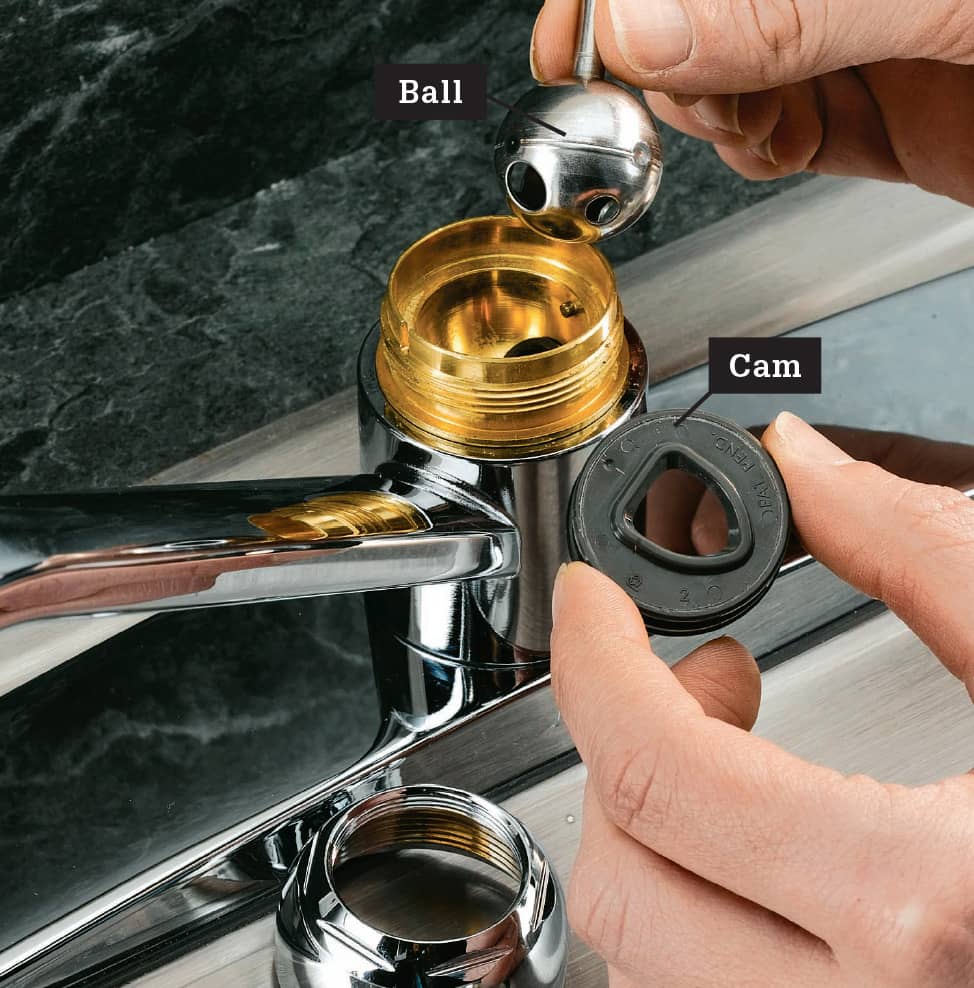
Remove the old ball and cam after removing the faucet handle and ball cap. Some faucets may require a ball faucet tool to remove the handle. Otherwise, simply use a pair of channel-type pliers to twist off the ball cap.
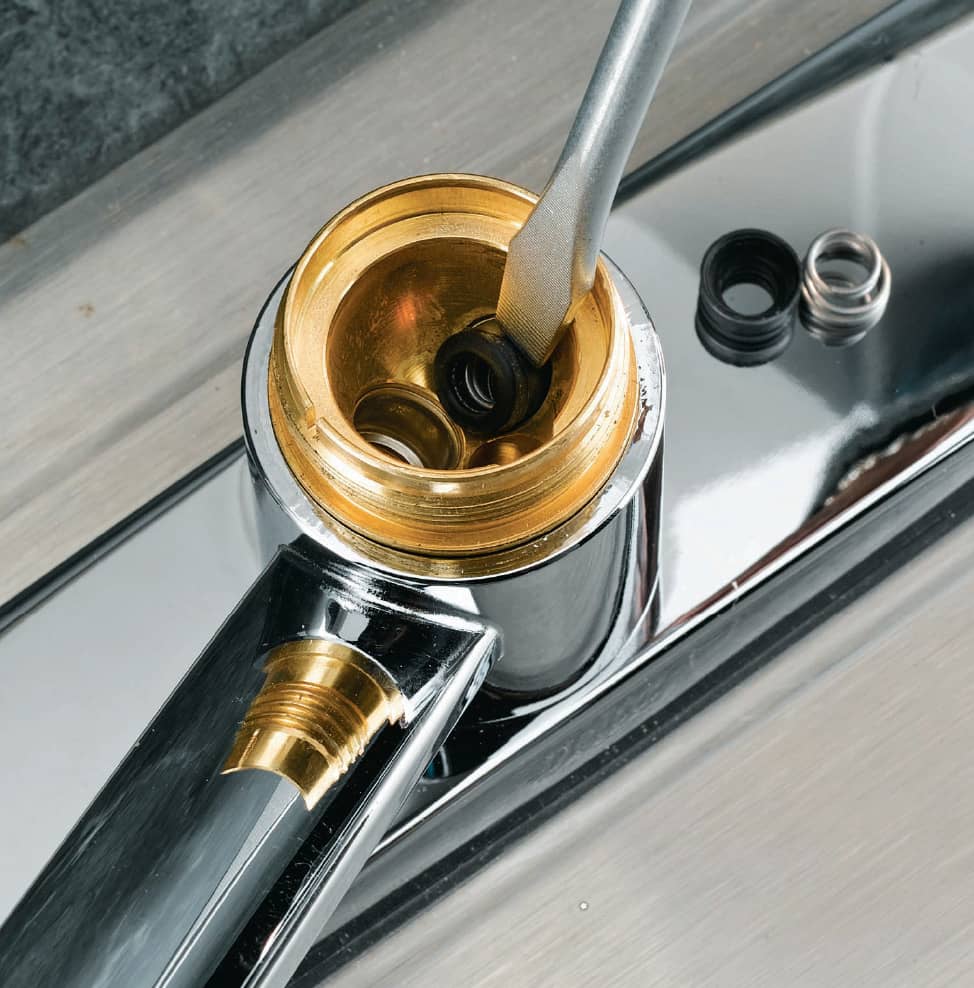
Pry out the neoprene valve seals and springs. Place thick towels around the faucet. Slowly turn on the water to flush out any debris in the faucet body. Replace the seals and springs with new parts. Also replace the O-rings on the valve body. You may want to replace the ball and cam, too, especially if you’re purchasing a repair kit. Coat all rubber parts in faucet grease, and reassemble the faucet.
Disc Faucets
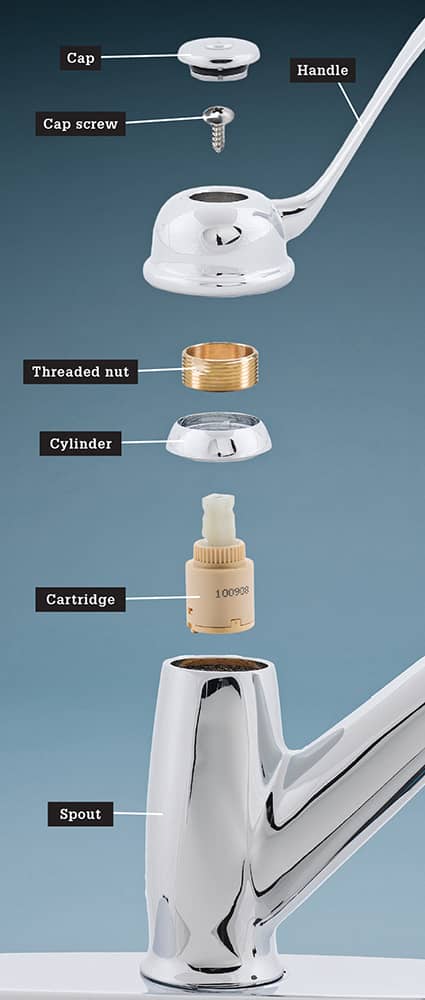
Disc-type faucets are the most common single-handle faucets currently being made. A pair of ceramic discs encased in a cylinder often referred to as a “cartridge” rub together as they rotate to open ports for hot and cold water. The ceramic discs do wear out in time, causing leaks, and there is only one solution—replace the disc unit (or “cartridge”). This makes for an easy—through comparatively expensive—repair.
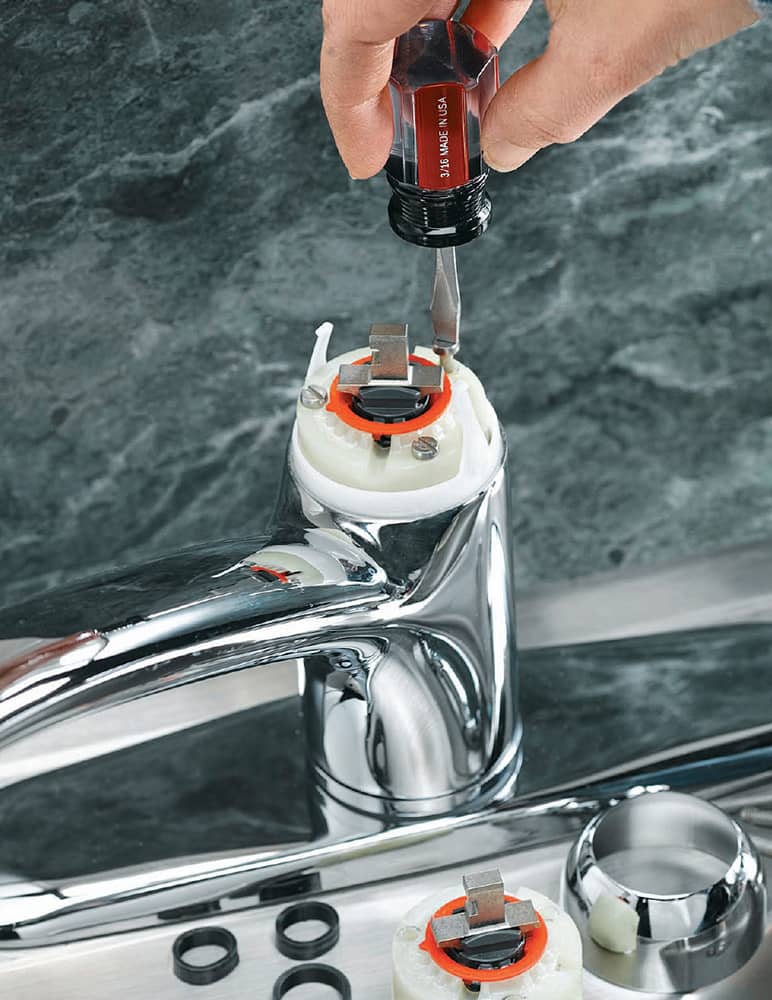
Replace the cylinder with a new one, coating the rubber parts with faucet grease before installing the new cylinder. Make sure the rubber seals fit correctly in the cylinder openings before you install the cylinder. Assemble the faucet handle.
 Replacing Kitchen Sink Sprayers
Replacing Kitchen Sink Sprayers
If water pressure from a sink sprayer seems low, or if water leaks from the handle, it is usually because lime buildup and sediment have blocked small openings inside the sprayer head. To fix the problem, first take the sprayer head apart and clean the parts. If cleaning the sprayer head does not help, the problem may be caused by a faulty diverter valve. The diverter valve inside the faucet body shifts water flow from the faucet spout to the sprayer when the sprayer handle is pressed. Cleaning or replacing the diverter valve may fix water pressure problems.
Whenever making repairs to a sink sprayer, check the sprayer hose for kinks or cracks. A damaged hose should be replaced.
If water pressure from a faucet spout seems low, or if the flow is partially blocked, take the spout aerator apart and clean the parts. The aerator is a screw-on attachment with a small wire screen that mixes tiny air bubbles into the water flow. Make sure the wire screen is not clogged with sediment and lime buildup. If water pressure is low throughout the house, it may be because galvanized steel water pipes are corroded. Corroded pipes should be replaced with copper.
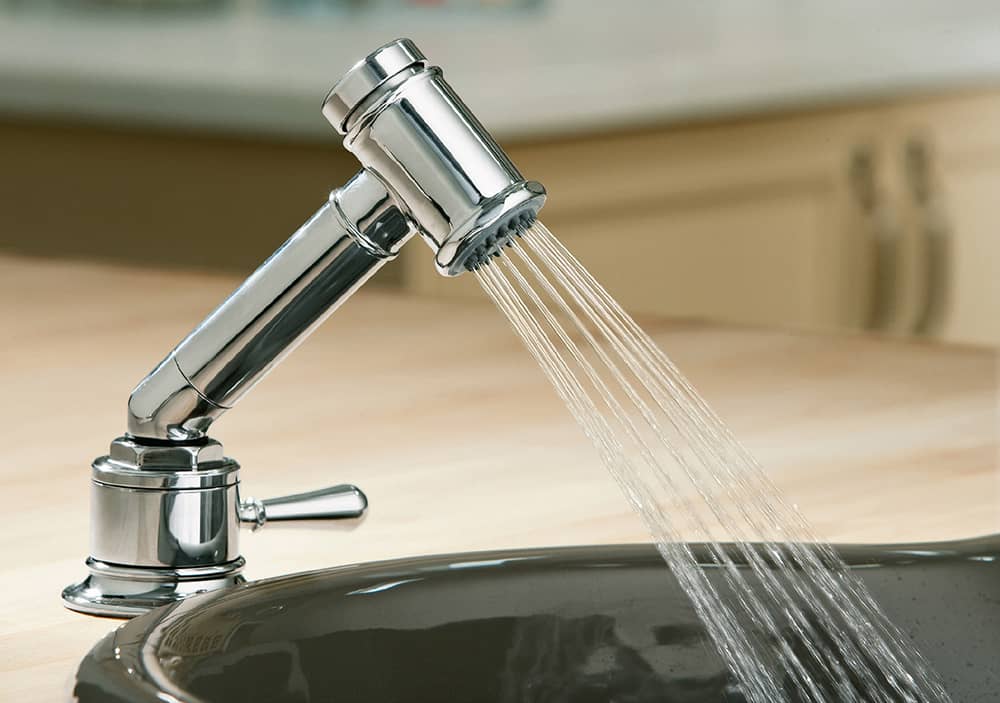
Kitchen sprayers are very convenient and, in theory, quite simple. Yet, they break down with surprising regularity. Fixing or replacing one is an easy job, however.
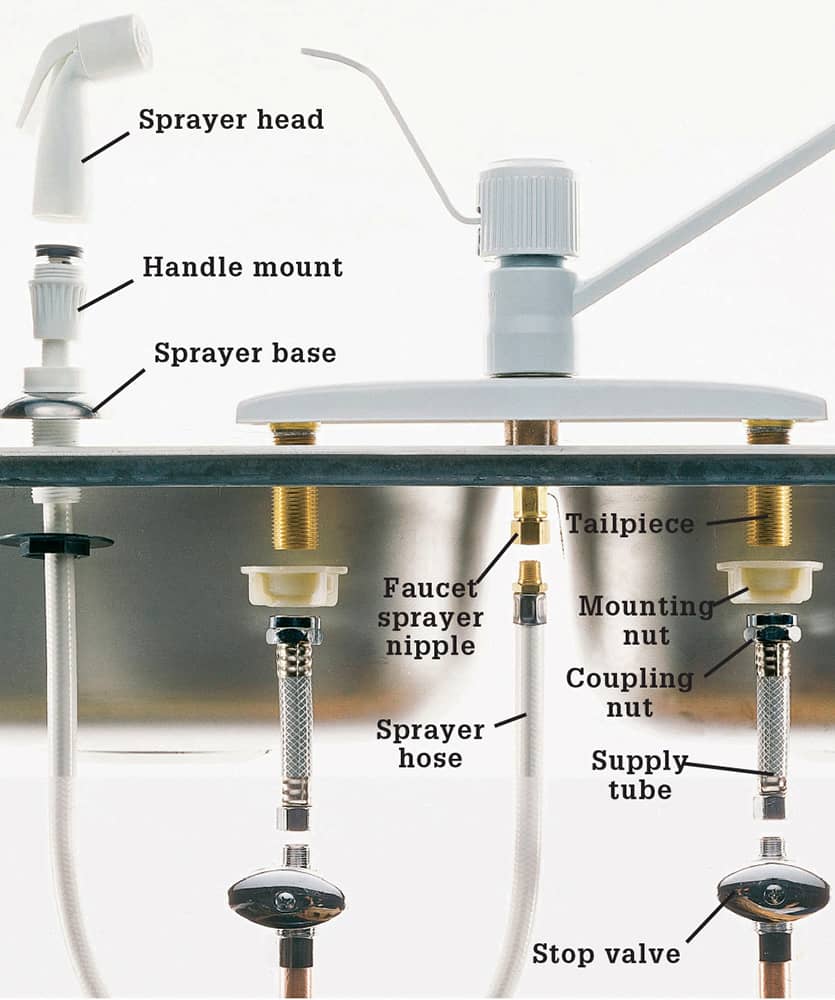
The standard sprayer hose attachment is connected to a nipple at the bottom of the faucet valve. When the lever of the sprayer is depressed, water flows from a diverter valve in the faucet body out to the sprayer. If your sprayer stream is weak or doesn’t work at all, the chances are good that the problem lies in the diverter valve.
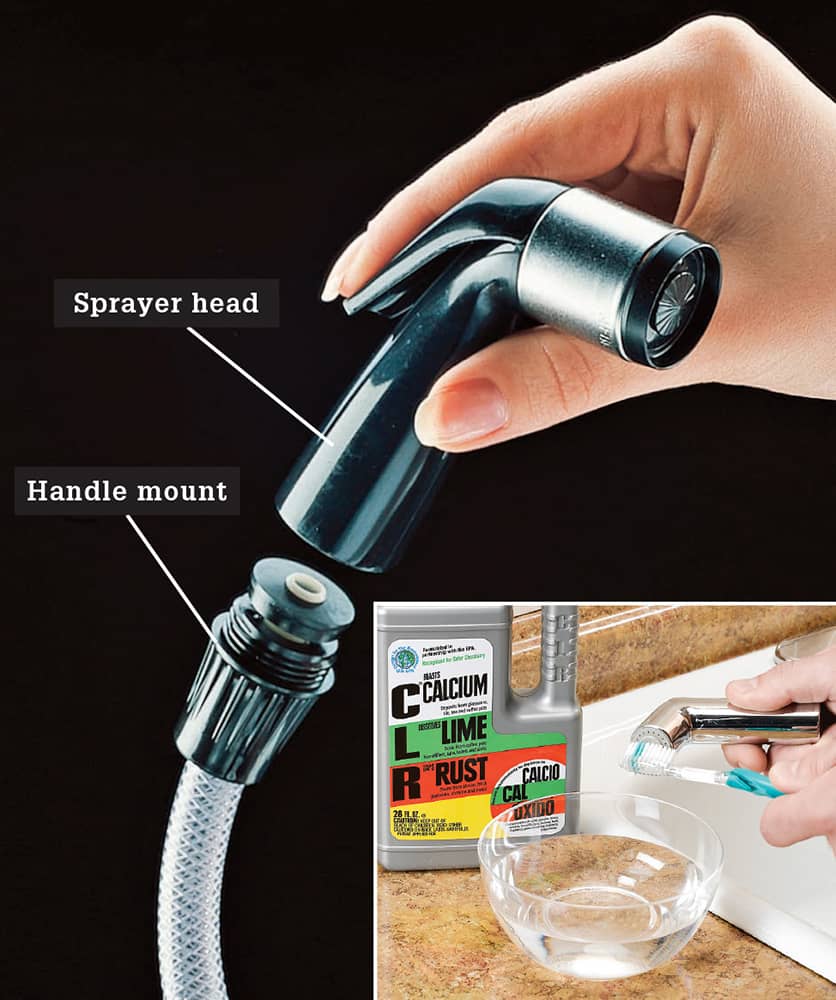
Sprayer heads can be removed from the sprayer hose, usually by loosening a retaining nut. A sprayer’s head can get clogged with minerals. Unscrew the sprayer from the hose and remove any parts at its tip. Soak it in mineral cleaner, and use a small brush to open any clogged orifices.
How to Repair a Sprayer
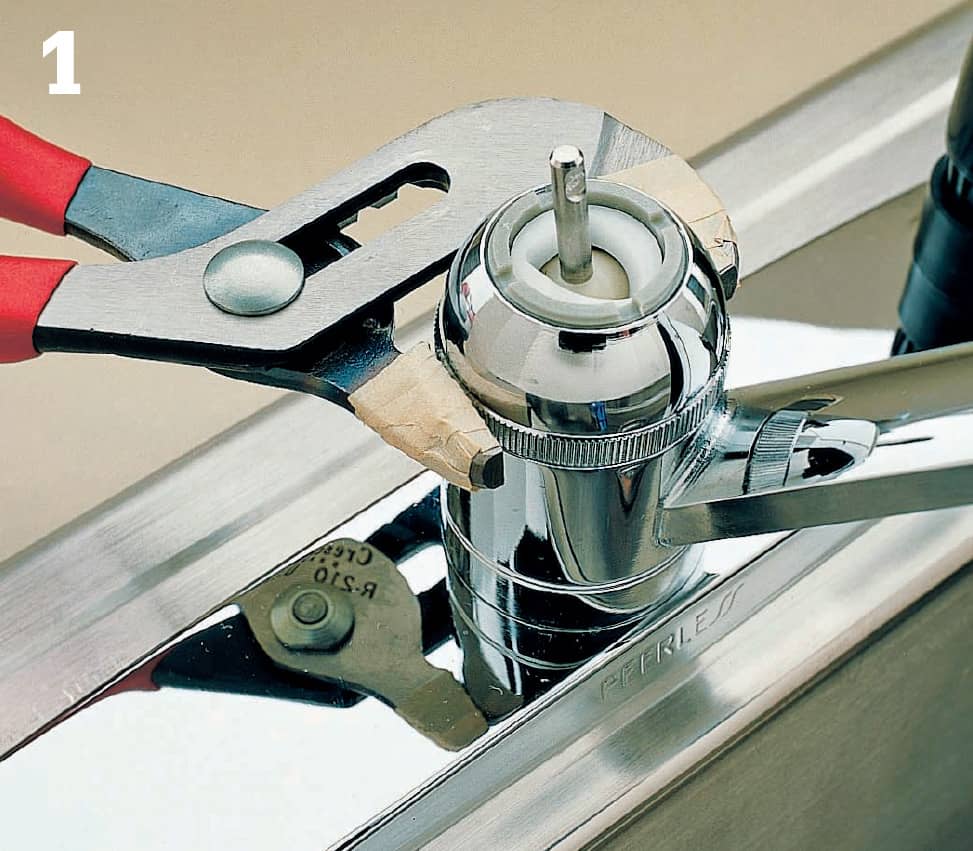
Shut off the water at the stop valves and remove the faucet handle to gain access to the faucet parts. Disassemble the faucet handle and body to expose the diverter valve. Ball-type faucets like the one shown here require that you also remove the spout to get at the diverter.
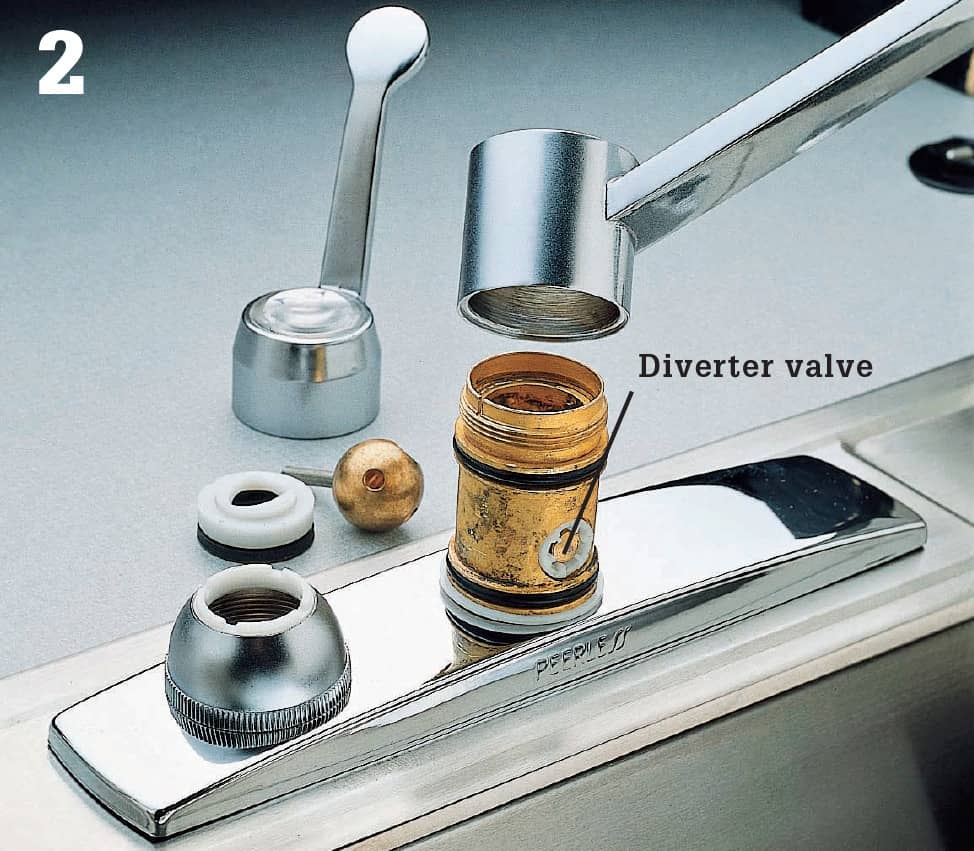
Locate the diverter valve, seen here at the base of the valve body. Because different types and brands of faucets have differently configured diverters, do a little investigating beforehand to try and locate information about your faucet. The above faucet is a ball type.
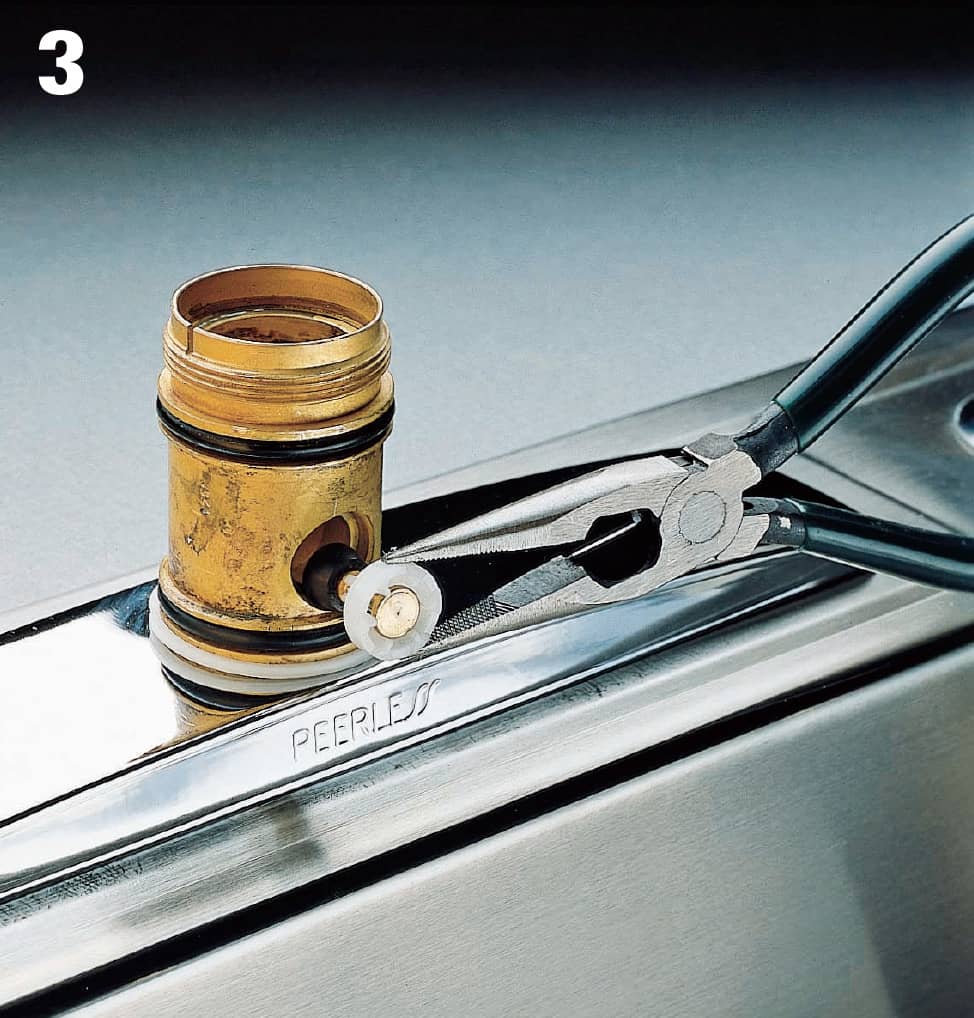
Pull the diverter valve from the faucet body with needlenose pliers. Use a toothbrush dipped in white vinegar to clean any lime buildup from the valve. If the valve is in poor condition, bring it to the hardware store and purchase a replacement.
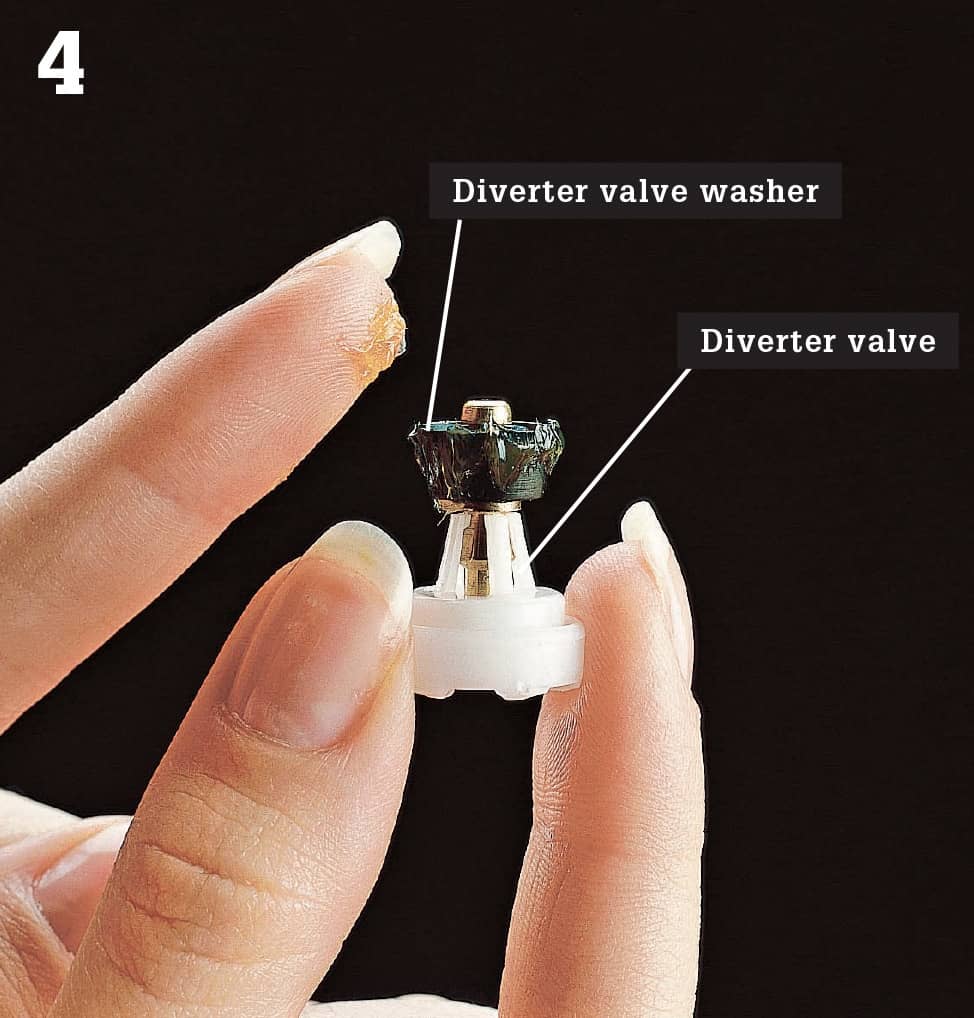
Coat the washer or O-ring on the new or cleaned diverter valve with faucet grease. Insert the diverter valve back into the faucet body. Reassemble the faucet. Turn on the water and test the sprayer. If it still isn’t functioning to your satisfaction, remove the sprayer tip and run the sprayer without the filter and aerator in case any debris has made its way into the sprayer line during repairs.
How to Replace a Kitchen Sprayer
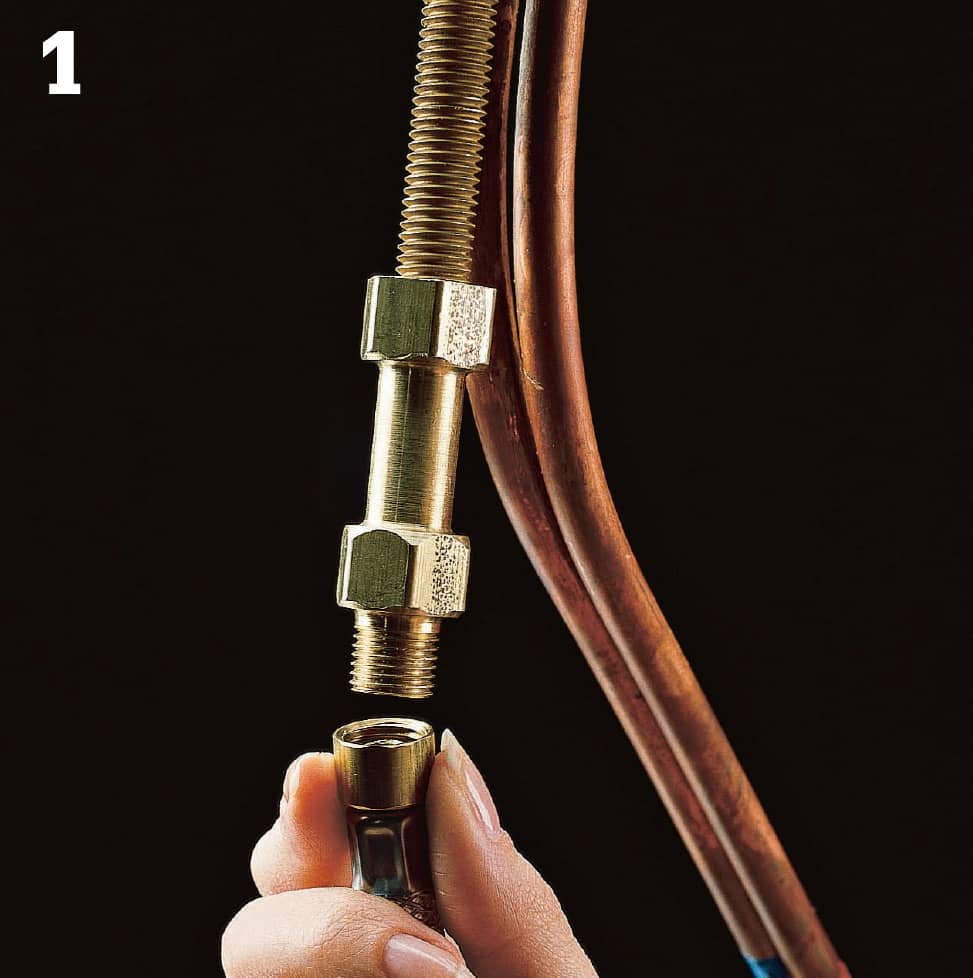
To replace a sprayer hose, start by shutting off the water at the shutoff valves. Clear out the cabinet under your sink and put on eye protection. Unthread the coupling nut that attaches the old hose to a nipple or tube below the faucet spout. Use a basin wrench if you can’t get your channel-type pliers on the nut.
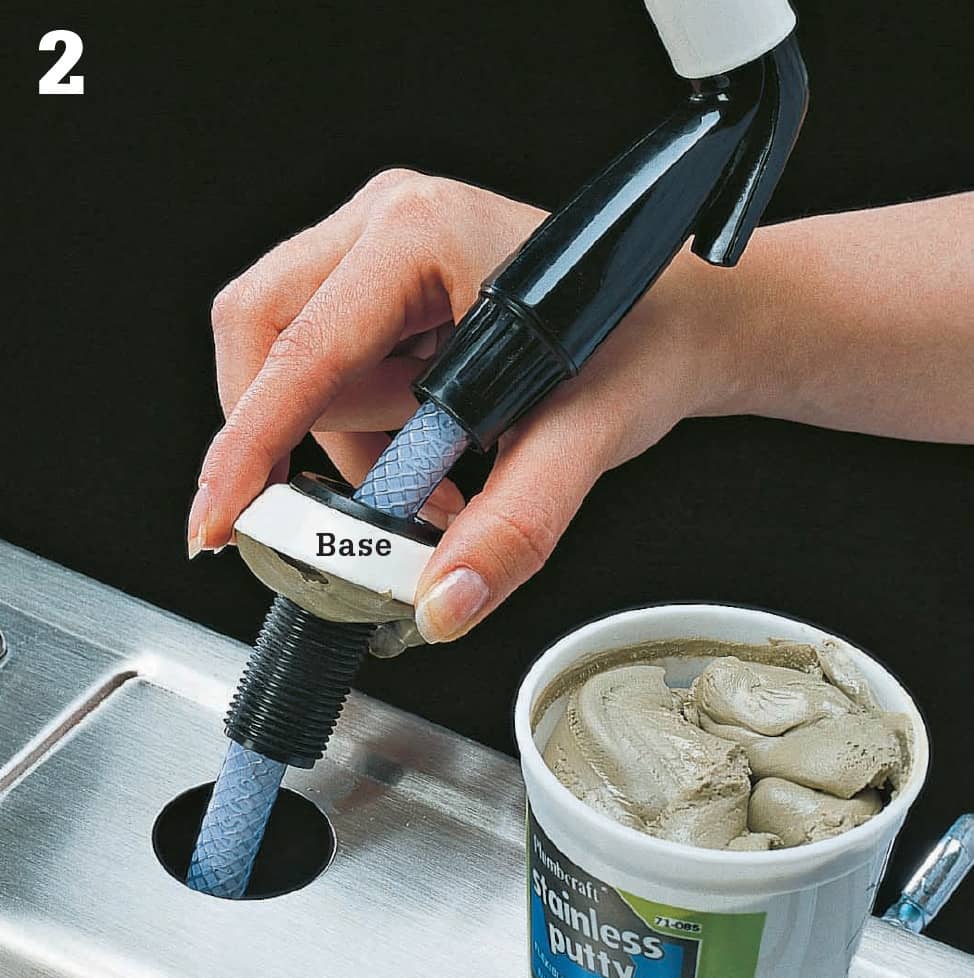
Unscrew the mounting nut of the old sprayer from below and remove the old sprayer body. Clean the sink deck and then apply plumber’s putty to the base of the new sprayer. Insert the new sprayer tailpiece into the opening in the sink deck.
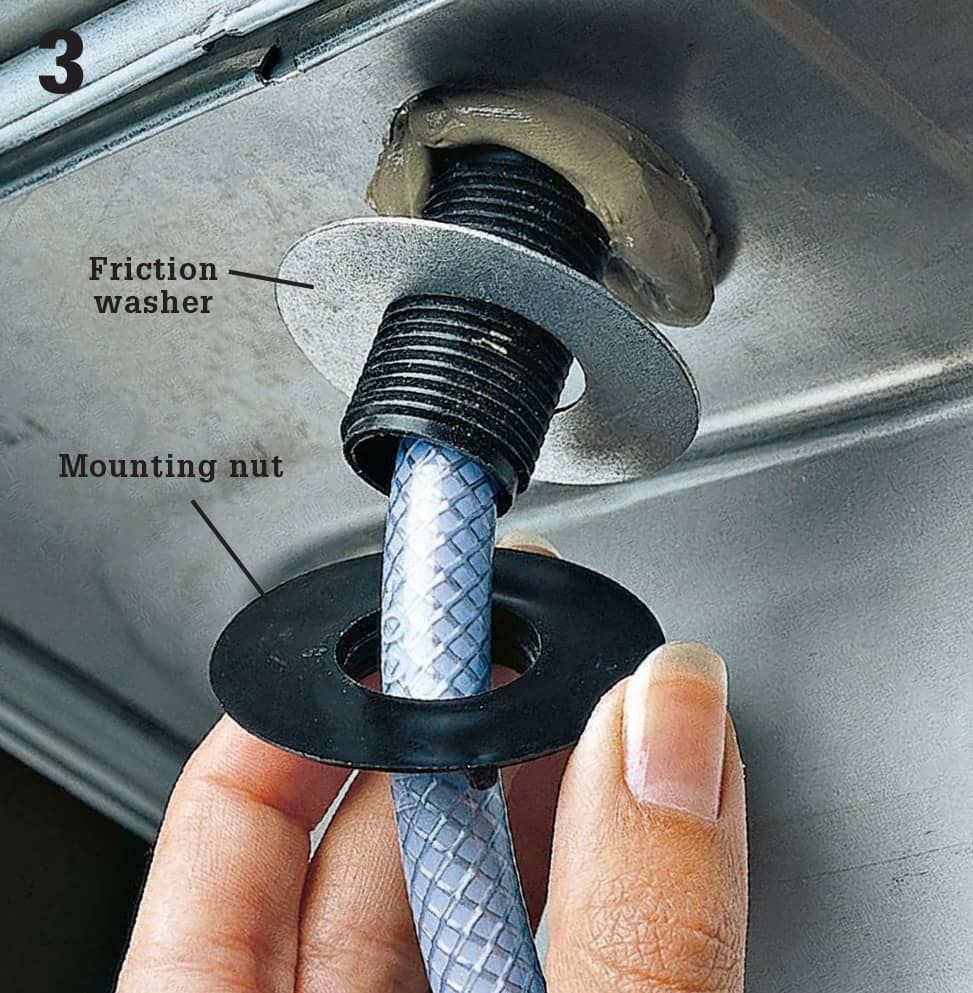
From below, slip the friction washer up over the sprayer tailpiece. Screw the mounting nut onto the tailpiece and tighten with a basin wrench or channel-type pliers. Do not overtighten. Wipe away any excess plumber’s putty.
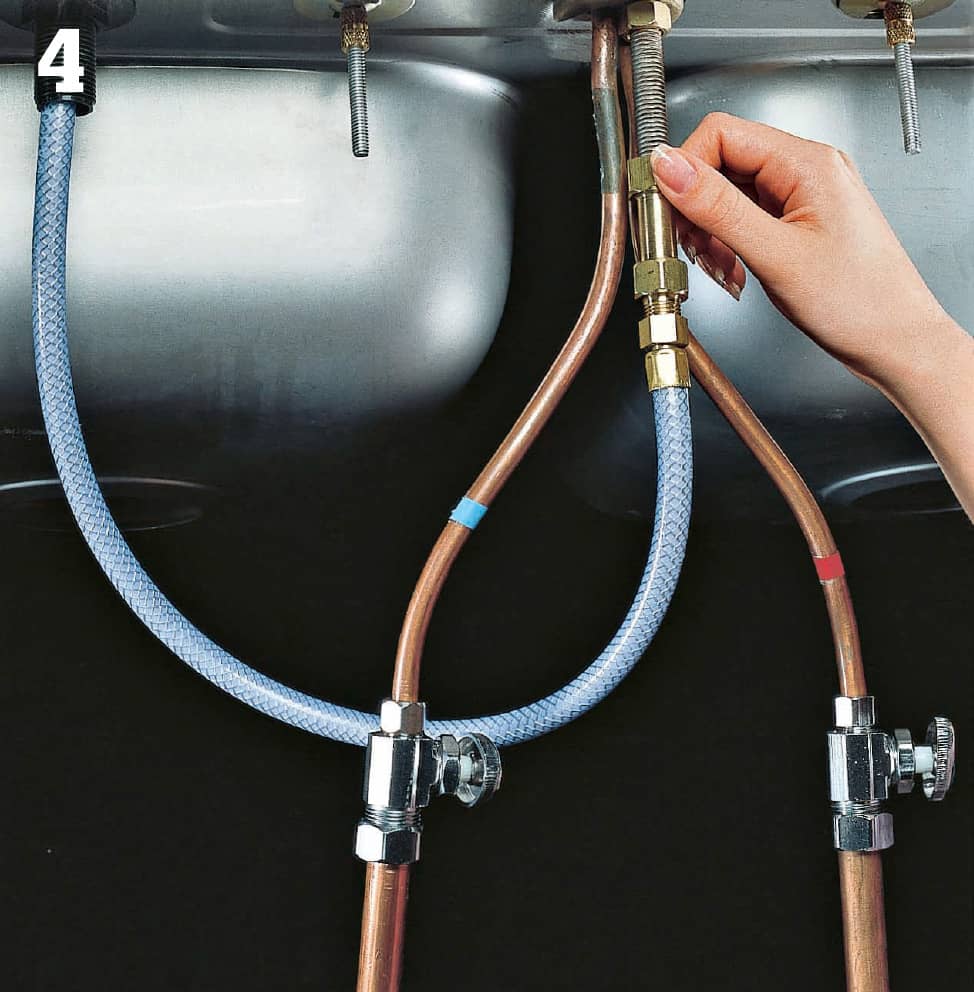
Screw the coupling for the sprayer hose onto the hose nipple underneath the faucet body. For a good seal, apply pipe joint compound to the nipple threads first. Tighten the coupling with a basin wrench, turn on the water supply at the shutoff valves, and test the new sprayer.
How to Remove an Old Faucet
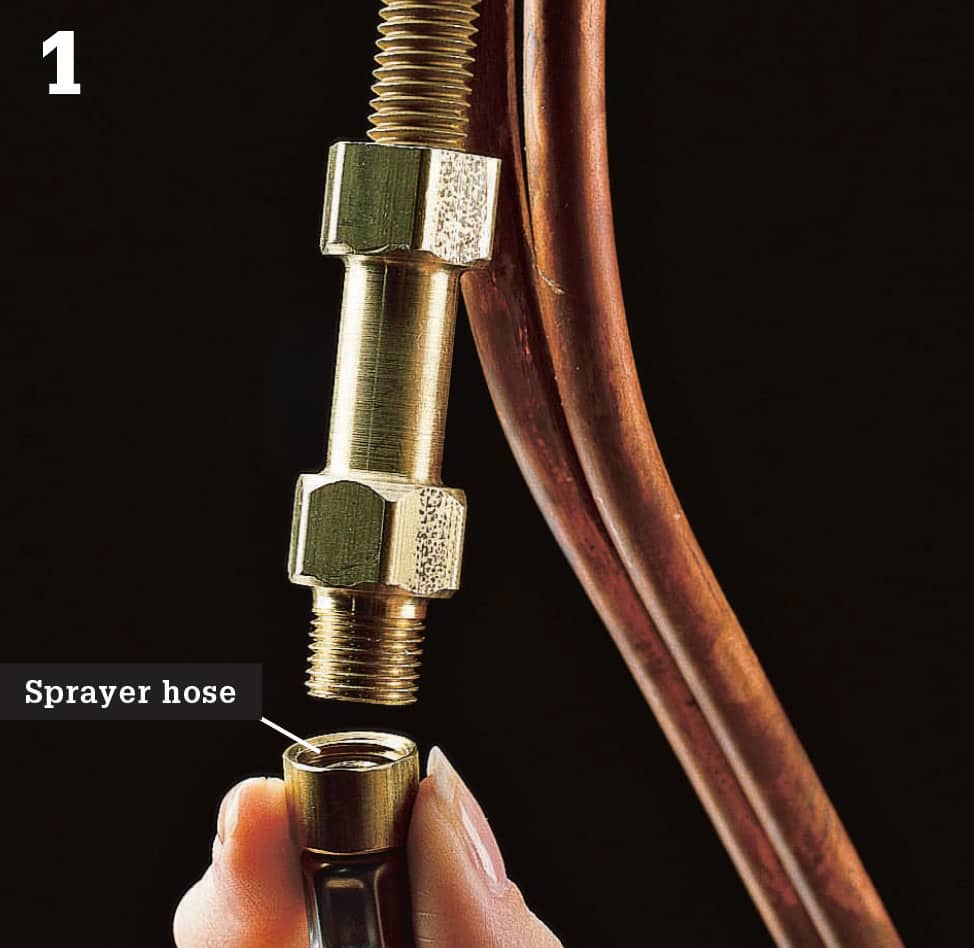
To remove the old faucet, start by clearing out the cabinet under the sink and laying down towels. Turn off the hot and cold stop valves and open the faucet to make sure the water is off. Detach the sprayer hose from the faucet sprayer nipple and unscrew the retaining nut that secures the sprayer base to the sink deck. Pull the sprayer hose out through the sink deck opening.
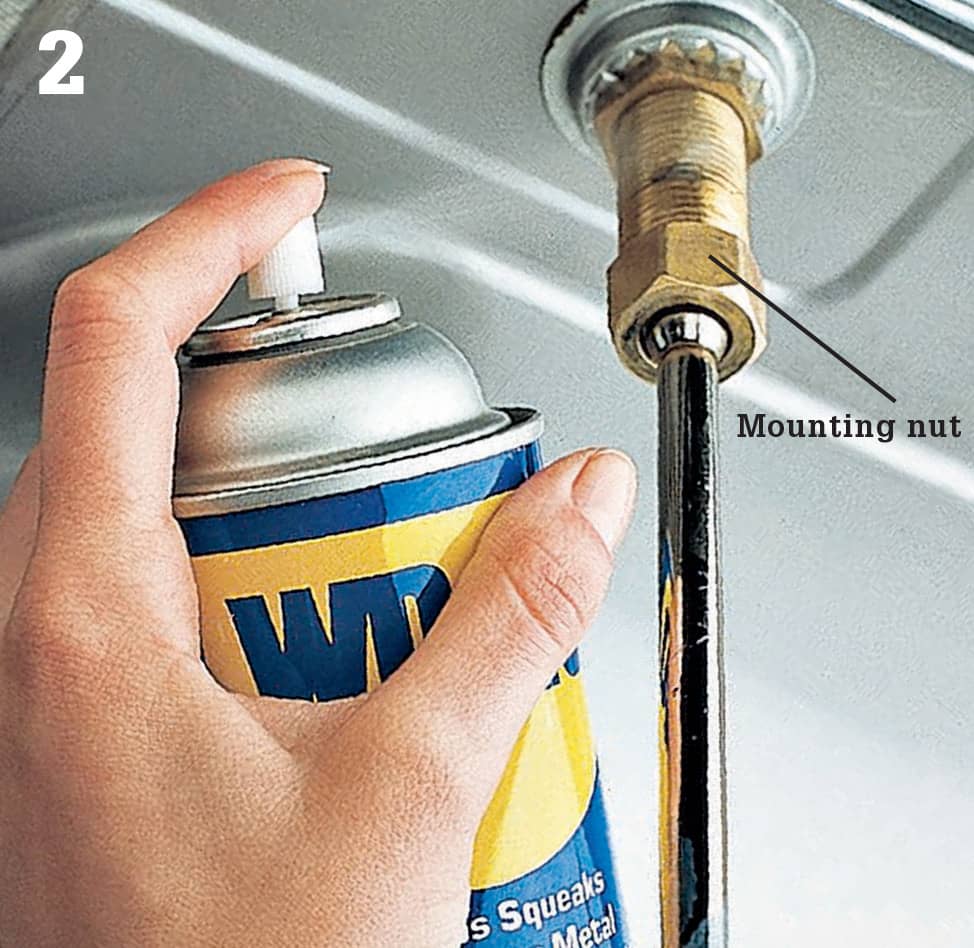
Spray the mounting nuts that hold the faucet or faucet handles (on the underside of the sink deck) with penetrating oil for easier removal. Let the oil soak in for a few minutes. If the nut is rusted and stubbornly stuck, you may need to drill a hole in its side, then tap the hole with a hammer and screwdriver to loosen it.
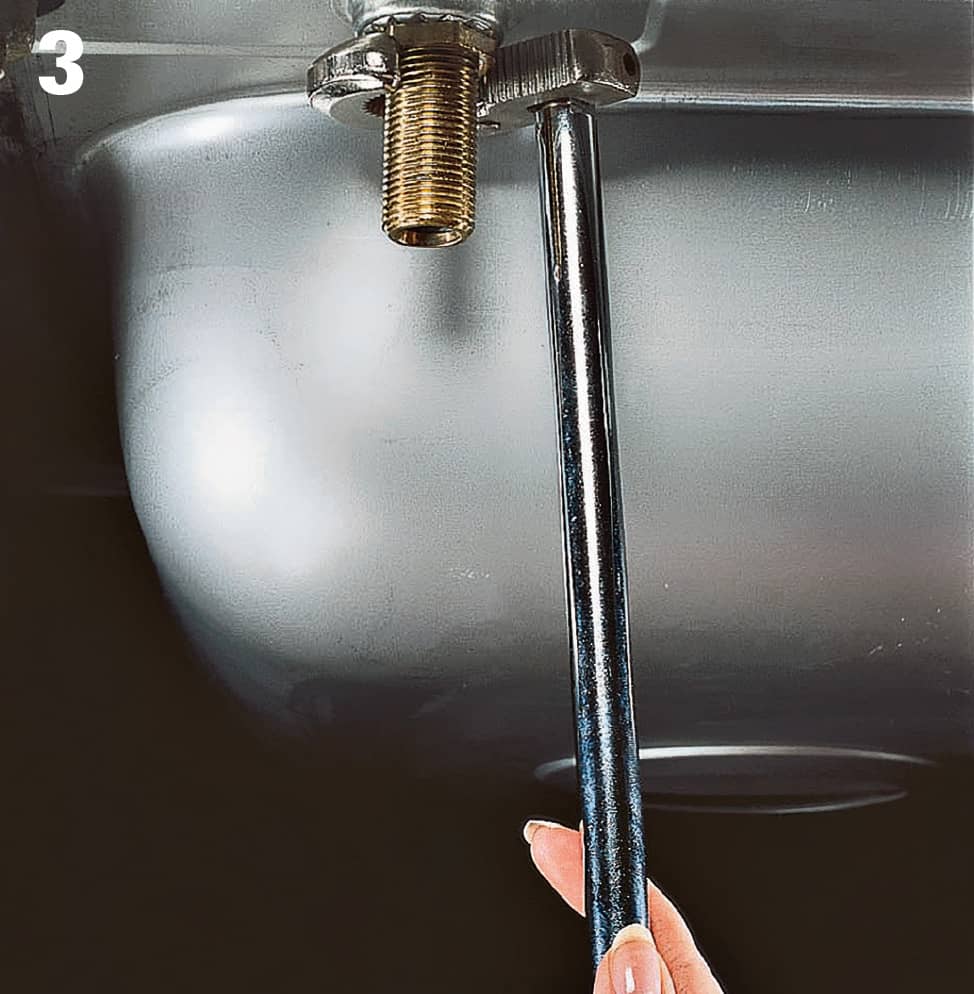
Unhook the supply tubes at the stop valves. Don’t reuse old chrome supply tubes. If the stops are missing or unworkable, replace them. Then remove the coupling nuts and the mounting nuts on the tailpieces of the faucet with a basin wrench or channel-type pliers.
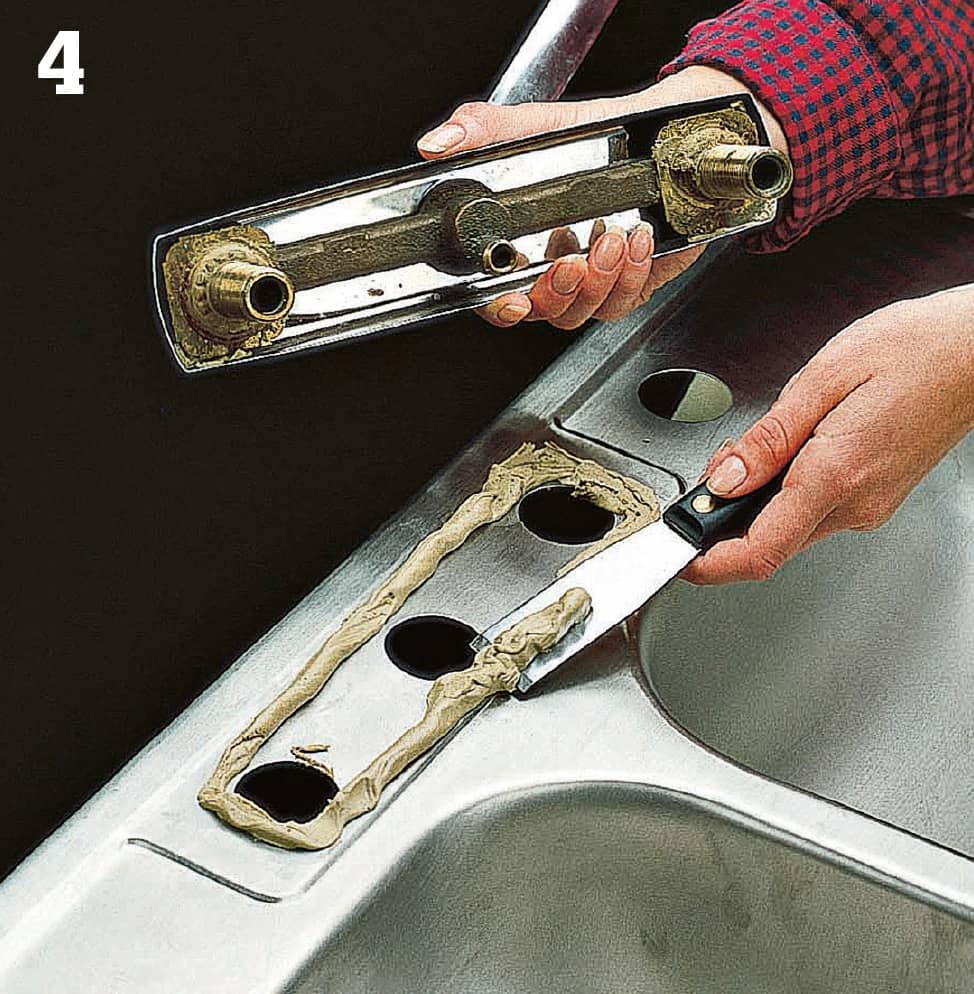
Pull the faucet body from the sink. Remove the sprayer base if you wish to replace it. Scrape off any putty or caulk with a putty knife and clean off the sink with a scouring pad and a nonabrasive cleaner.
How to Install a Pullout Kitchen Sink Faucet
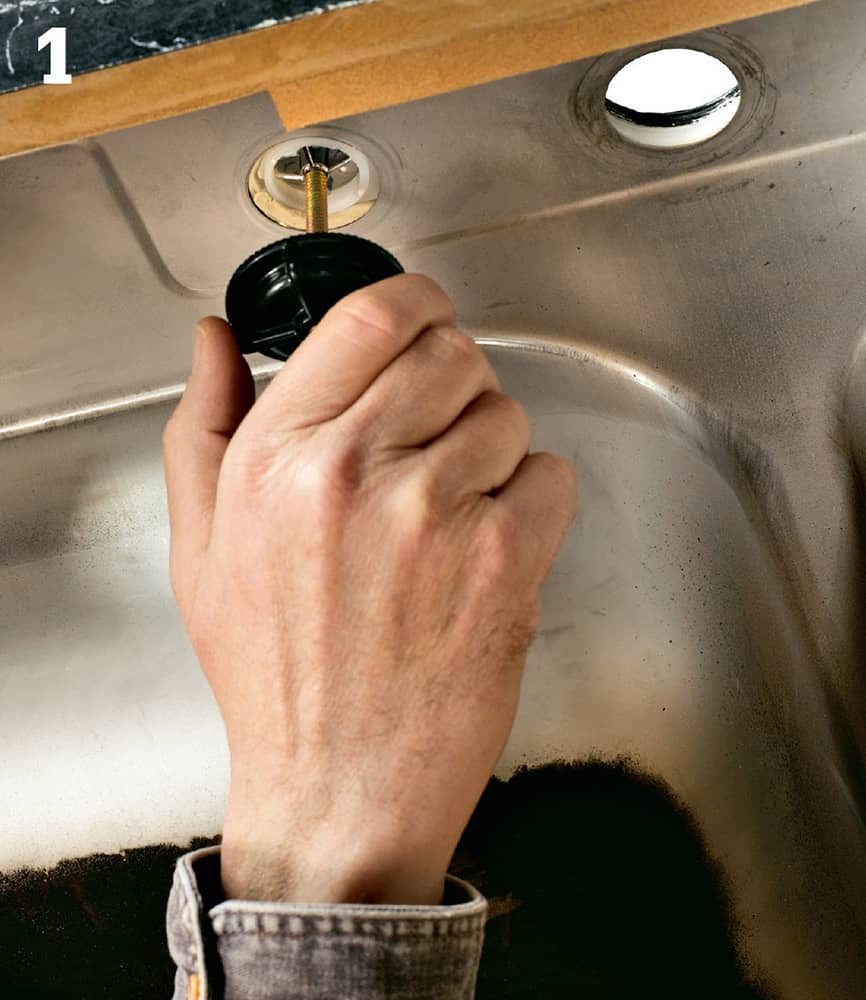
Install the base plate (if your faucet has one) onto the sink flange so it is centered. Have a helper hold it straight from above as you tighten the mounting nuts that secure the base plate from below. Make sure the plastic gasket is centered under the base plate. These nuts can be adequately tightened by hand.
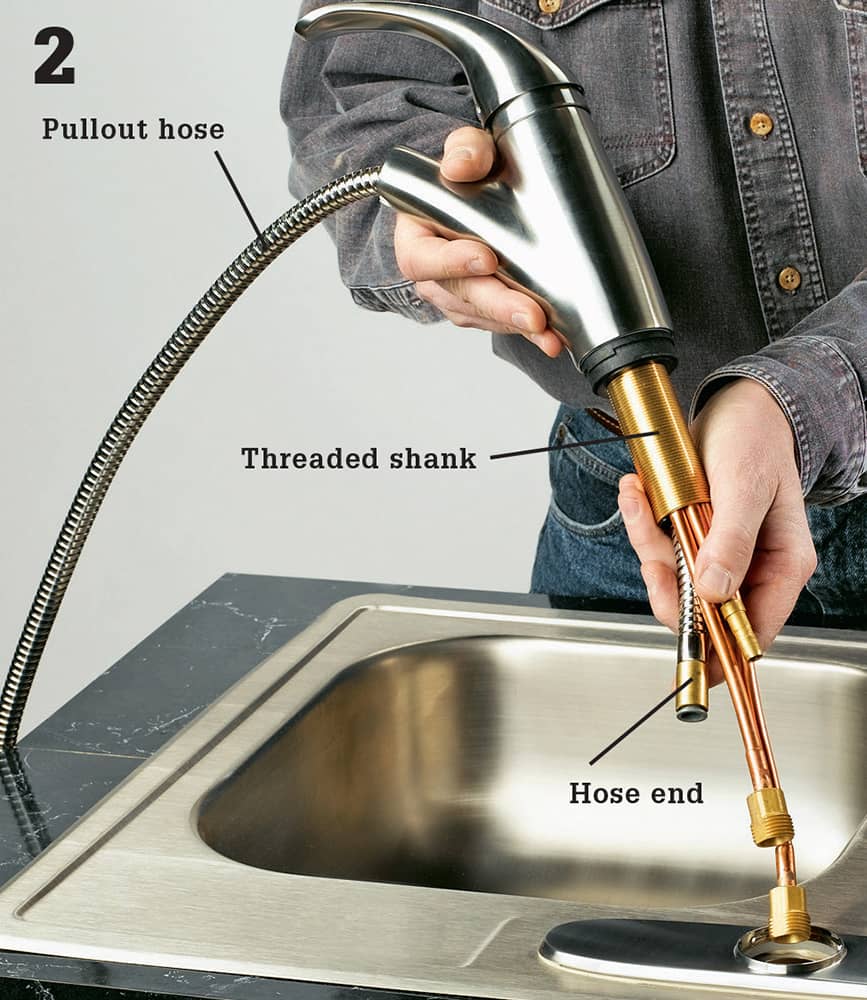
Retract the pullout hose by drawing it out through the faucet body until the fitting at the end of the hose is flush with the bottom of the threaded faucet shank. Insert the shank and the supply tubes down through the top of the deck plate.
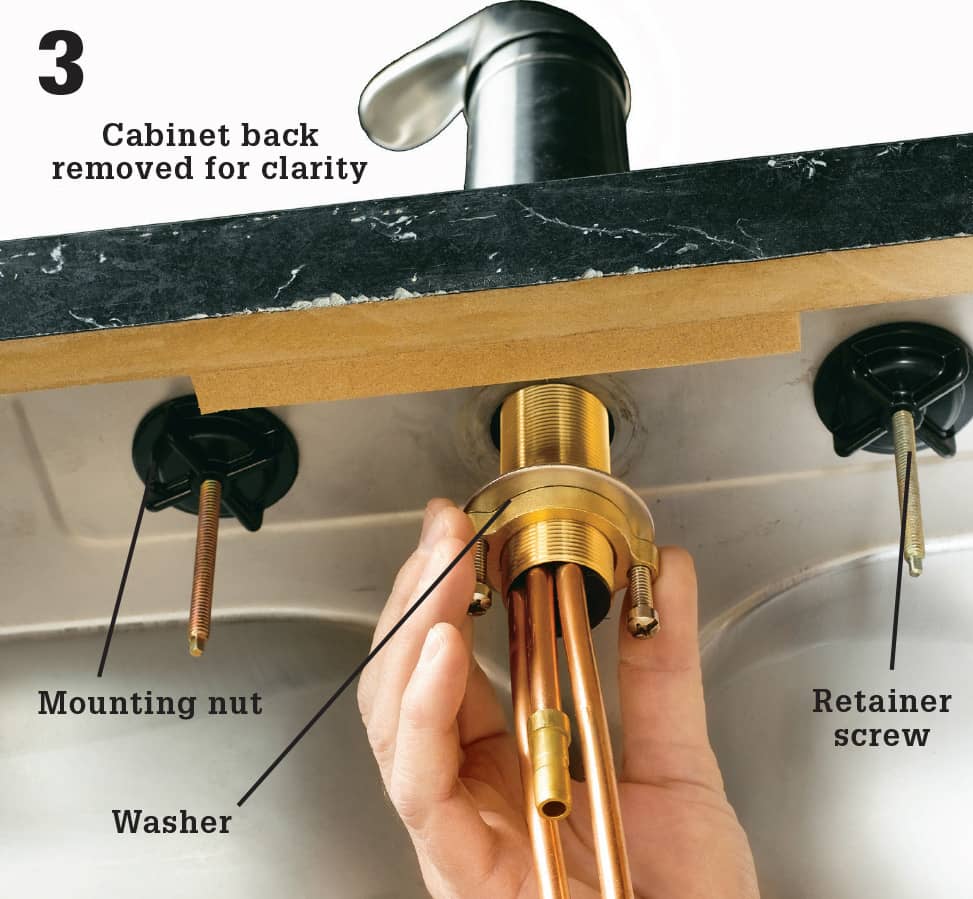
Slip the mounting nut and washer over the free ends of the supply tubes and pullout hose, then thread the nut onto the threaded faucet shank. Hand tighten. Tighten the retainer screws with a screwdriver to secure the faucet.
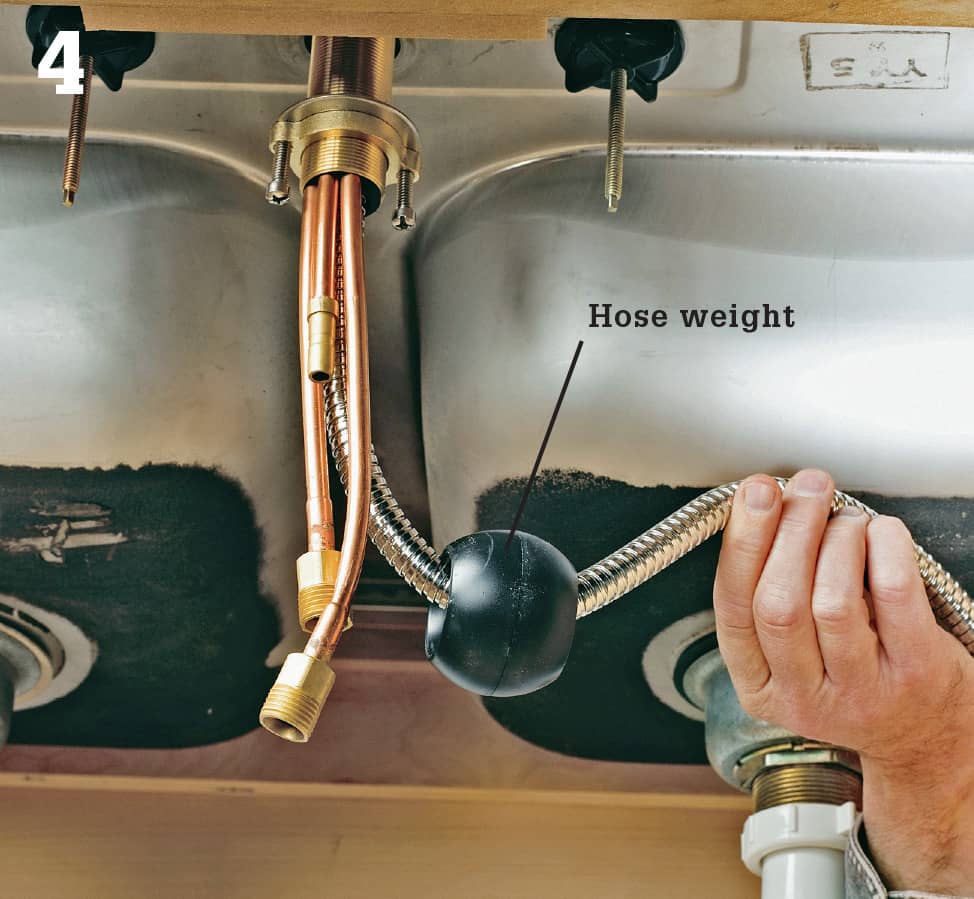
Slide the hose weight onto the pullout hose (the weight helps keep the hose from tangling and it makes it easier to retract).
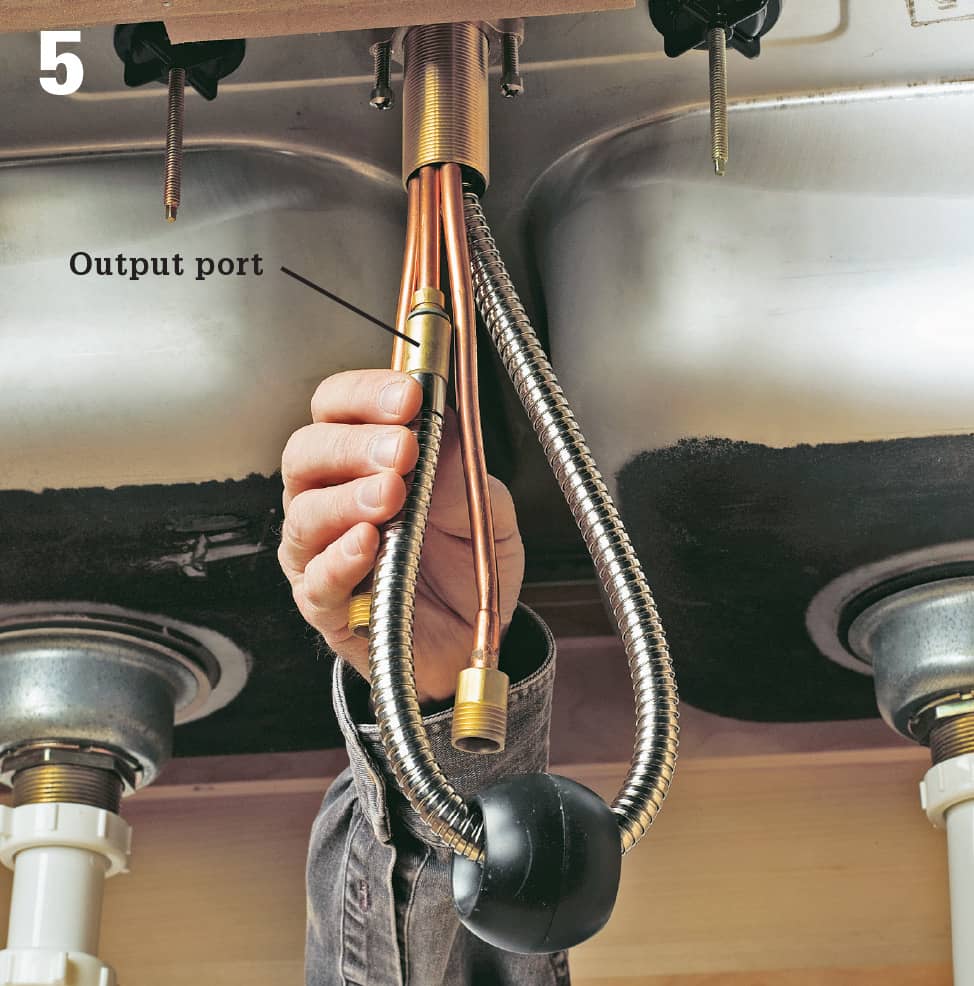
Connect the end of the pullout hose to the outlet port on the faucet body using a quick connector fitting.
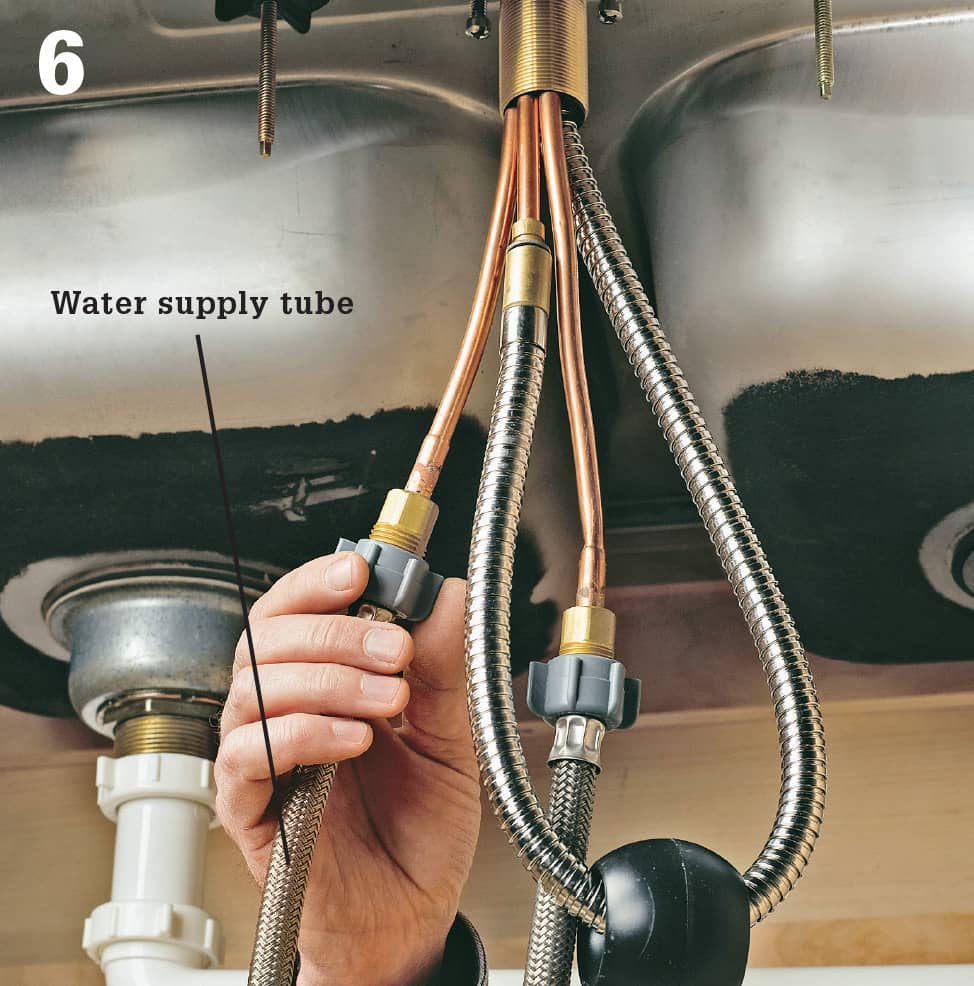
Hook up the water supply tubes to the faucet inlets. Make sure the tubes are long enough to reach the supply risers without stretching or kinking.
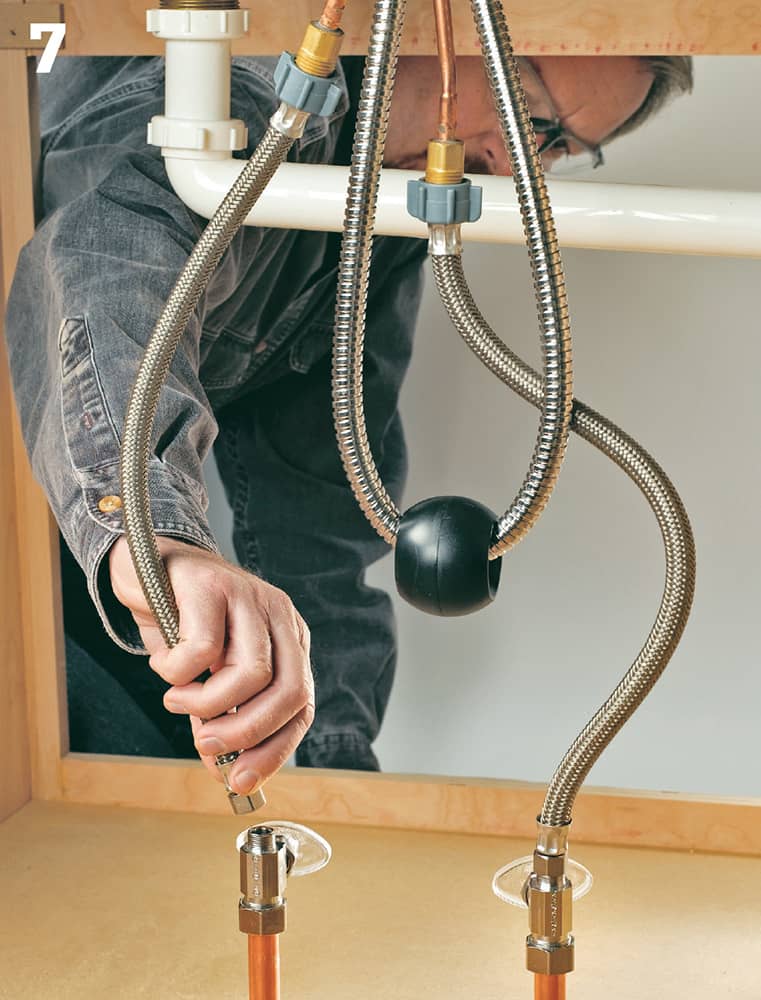
Connect the supply tubes to the supply risers at the stop valves. Make sure to get the hot lines and cold lines attached correctly.
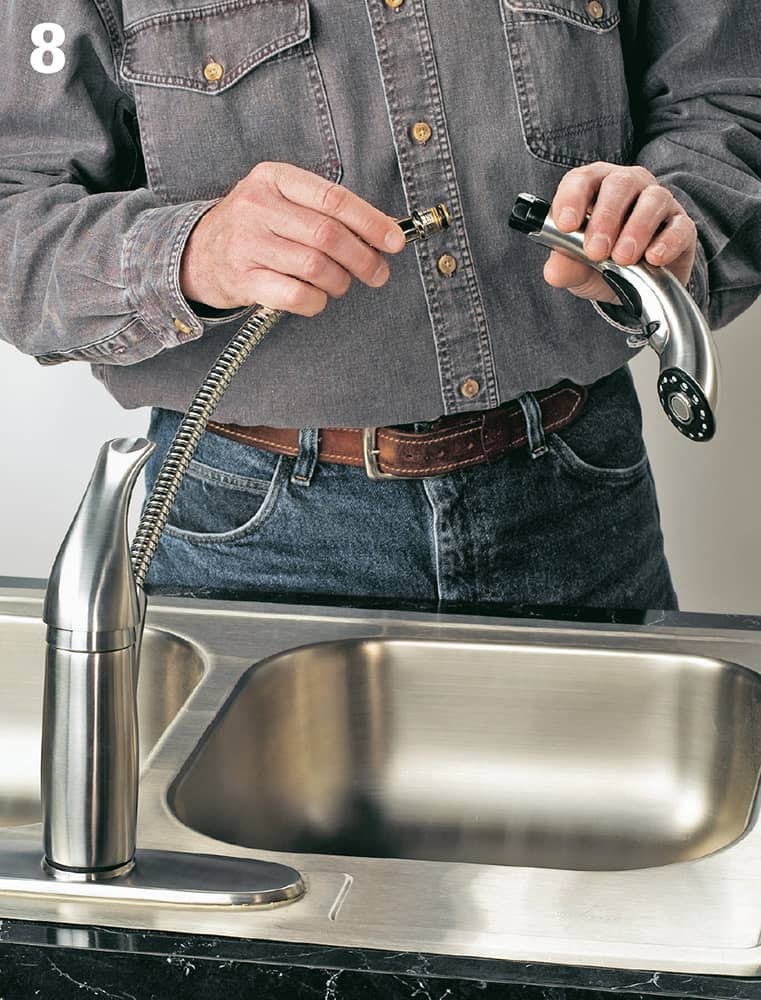
Attach the spray head to the end of the pullout hose and turn the fitting to secure the connection. Turn on the water supply and test. TIP: Remove the aerator in the tip of the spray head and run hot and cold water to flush out any debris.
 Fixing Kitchen Drains & Traps
Fixing Kitchen Drains & Traps
Kitchen traps, also called sink drains or trap assemblies, are made of 1 1/2-inch pipes (also called tubes), slip washers, and nuts, so they can be easily assembled and disassembled. Most plastic types can be tightened by hand, with no wrench required. Pipes made of chromed brass will corrode in time, and rubber washers will crumble, meaning they need to be replaced. Plastic pipes and plastic washers last virtually forever. All traps are liable to get bumped out of alignment; when this happens, they should be taken apart and reassembled.
A trap’s configuration depends on how many bowls the sink has, whether or not you have a food disposer and/or a dishwasher drain line, and local codes. On this page we show three of the most common assembly types. Tee fittings on these traps often have a baffle, which reduces the water flow somewhat. Check local codes to make sure your trap is compliant.
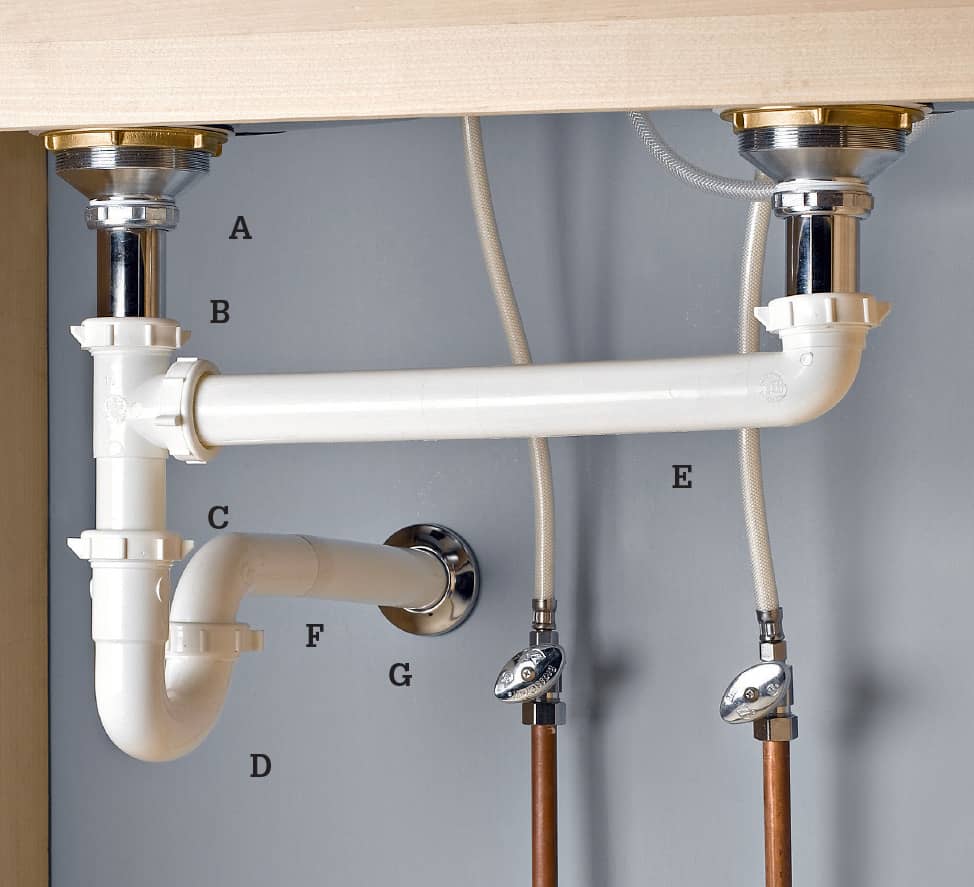
Kitchen sink drains include a strainer body (A), tailpiece (B), waste tee (C), P-trap (D), outlet drain line (E), trap arm (F), and wall stubout with coupling (G).
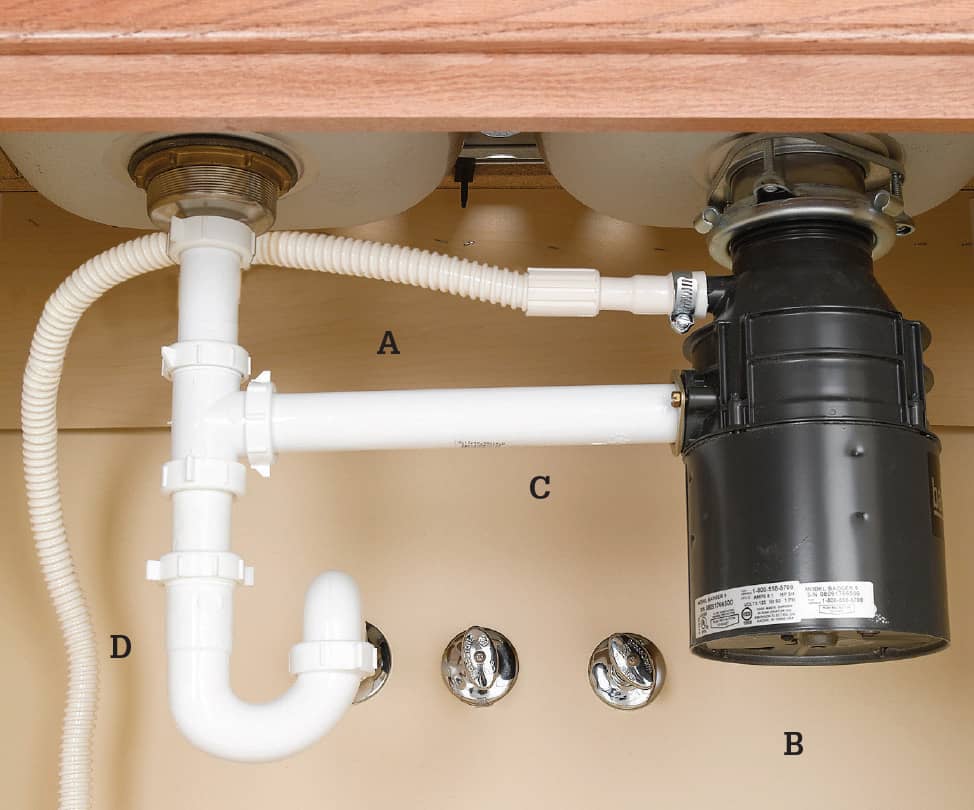
In this arrangement, the dishwasher drain hose (A) attaches to the food disposer (B), and a trap arm (C) leads from the disposer to the P-trap (D).
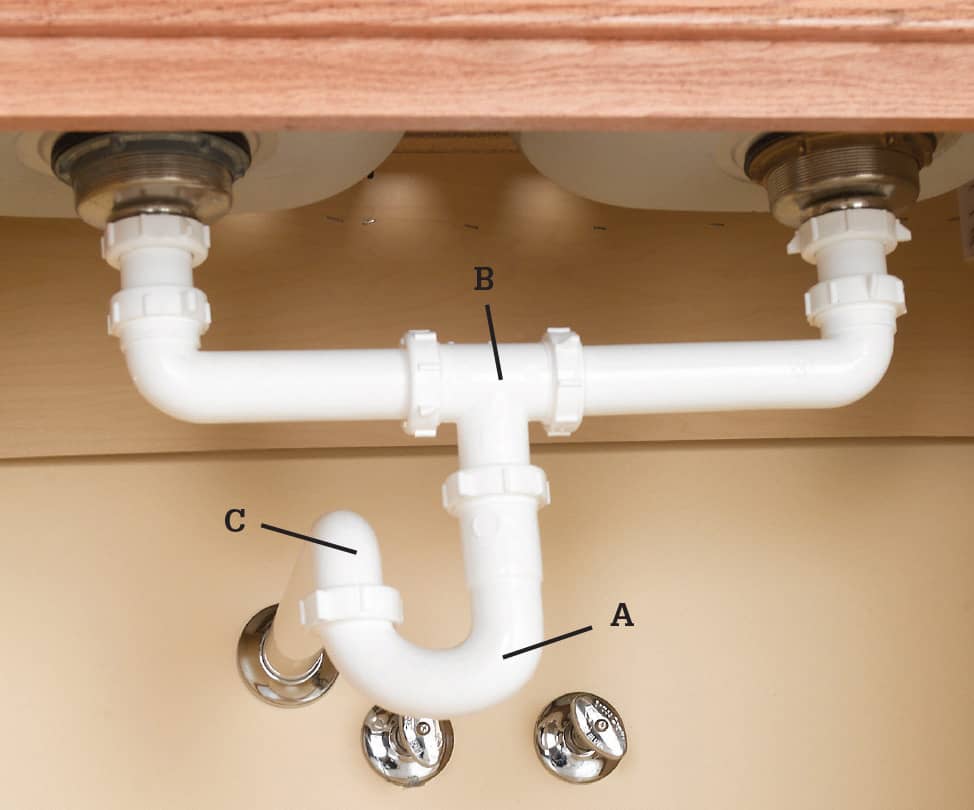
A “center tee” arrangement has a single P-trap (A) that is connected to a waste tee (B) and the trap arm (C).
How to Hook Up a Kitchen Sink Drain
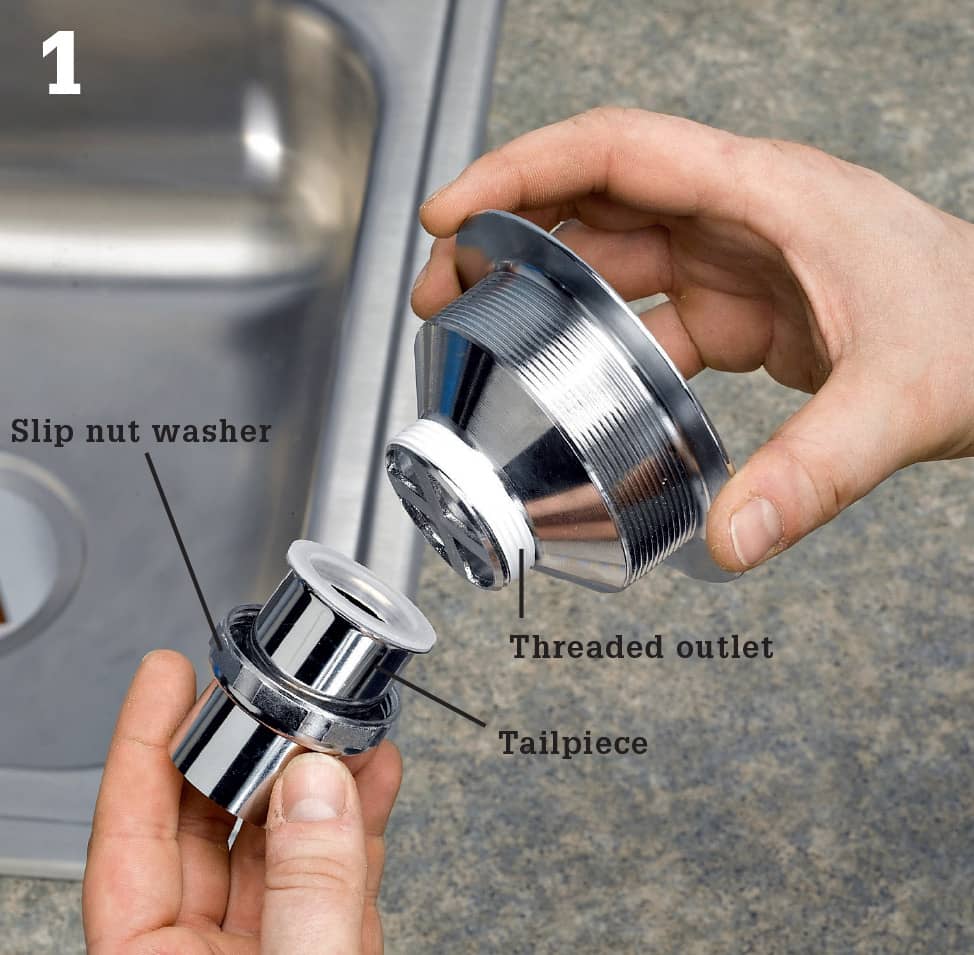
If you are replacing the sink strainer body, remove the old one and clean the top and bottom of the sink deck around the drain opening with mineral spirits. Attach the drain tailpiece to the threaded outlet of the strainer body, inserting a nonbeveled washer between the parts if your strainer kits include one. Lubricate the threads or apply Teflon tape so you can get a good, snug fit.
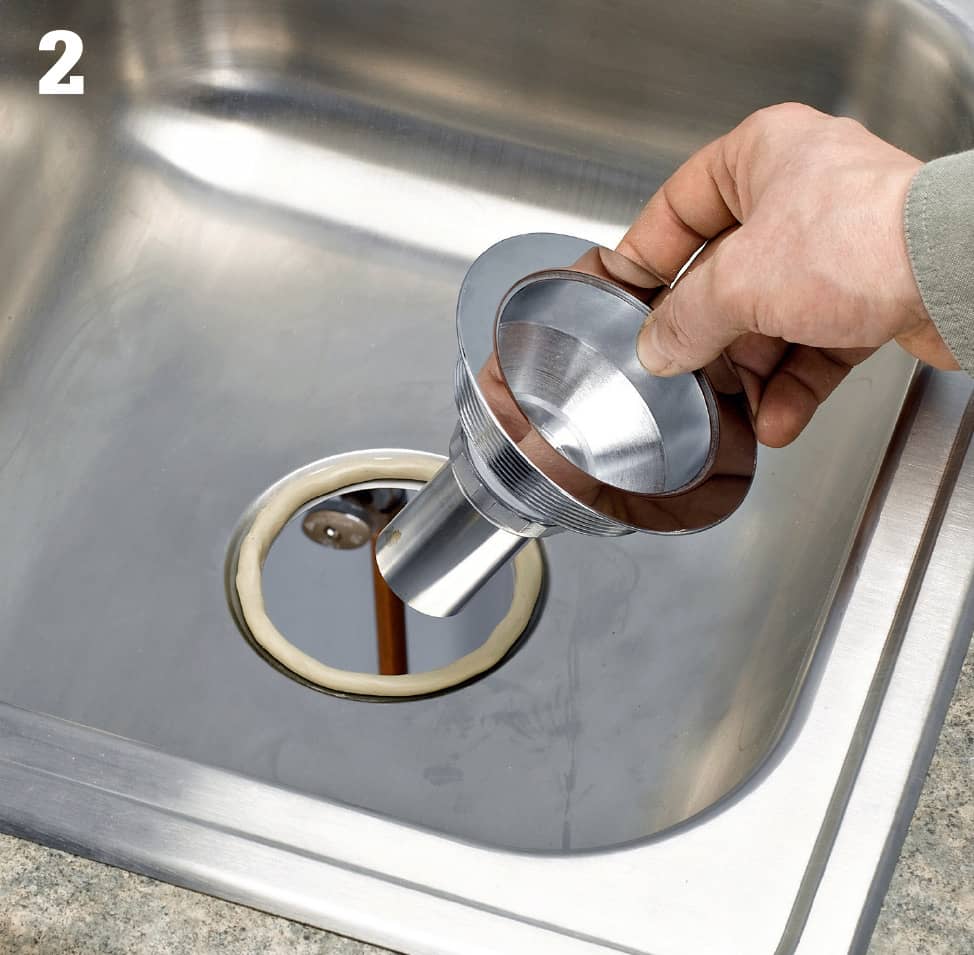
Apply plumber’s putty around the perimeter of the drain opening and seat the strainer assembly into it. Add washers below as directed and tighten the strainer locknut with a spud wrench (see photo, previous page) or by striking the mounting nubs at the top of the body with a flat screwdriver.
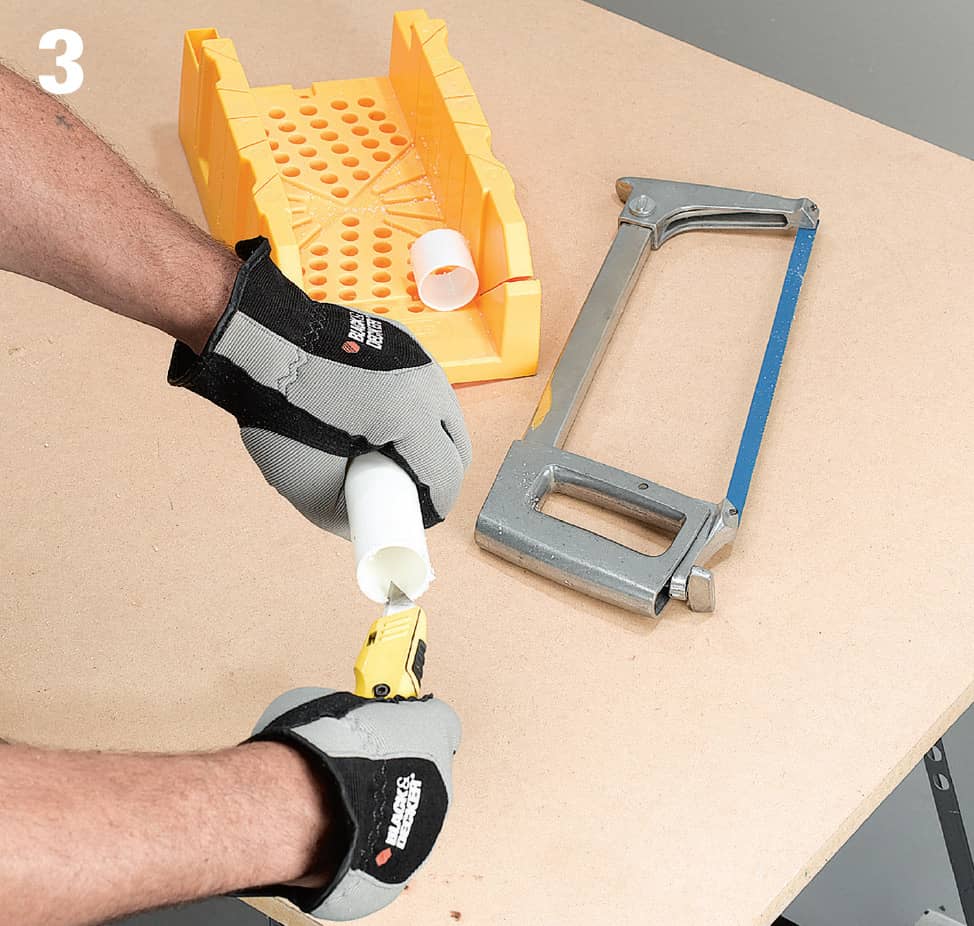
You may need to cut a trap arm or drain tailpiece to length. Cut metal tubing with a hacksaw. Cut plastic tubing with a handsaw, power miter saw, or a hand miter box and a backsaw or hacksaw. You can use a tubing cutter for any material. Deburr the cut end of plastic tubing with a utility knife.
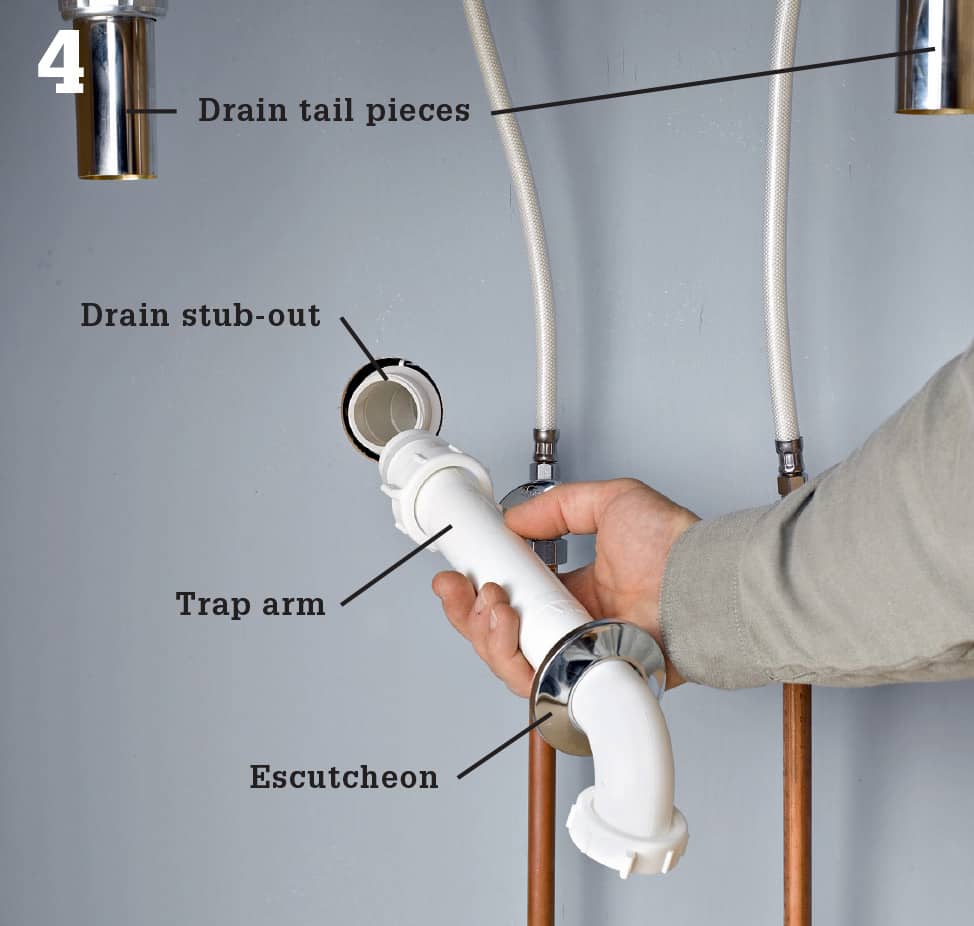
Attach the trap arm to the male-threaded drain stubout in the wall, using a slip nut and beveled compression washer. The outlet for the trap arm should point downward. NOTE: The trap arm must be lower on the wall than any of the horizontal lines in the set-up, including lines to dishwasher, disposer, or the outlet line to the second sink bowl.
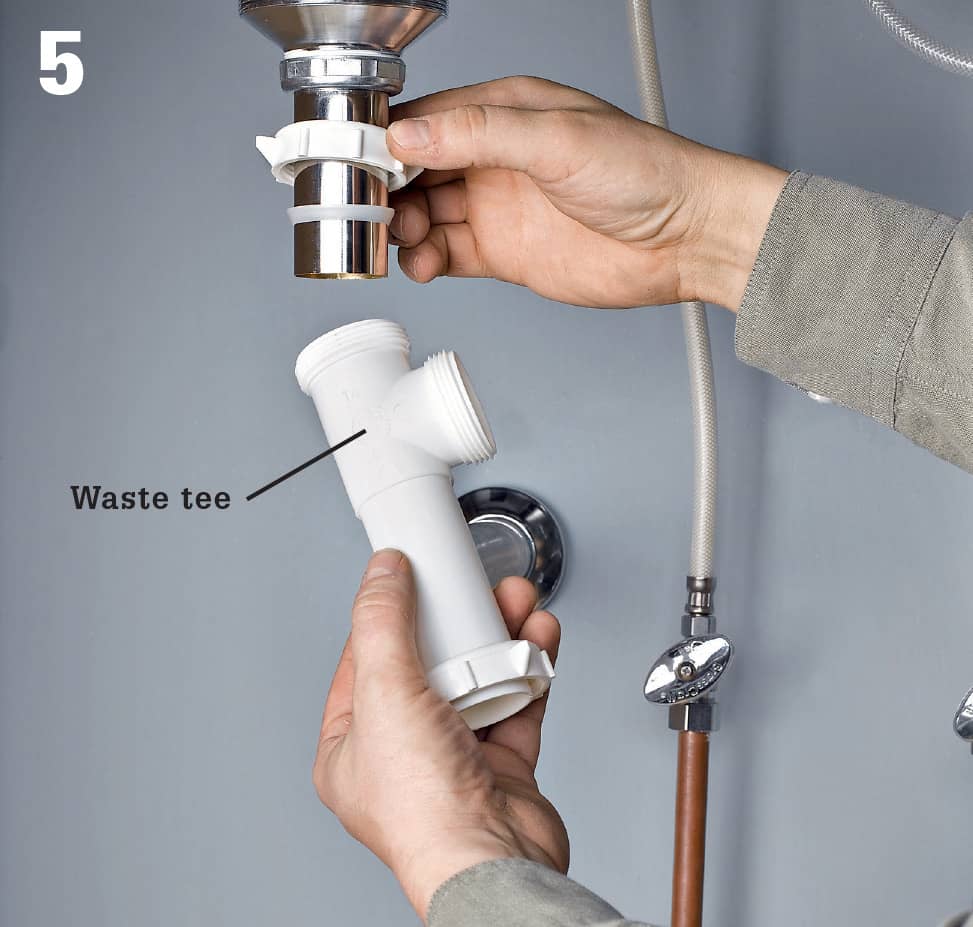
Attach a waste tee fitting to the drain tailpiece, orienting the opening in the fitting side so it will accept the outlet drain line from the other sink bowl. If the waste tee is higher than the top of the trap arm, remove it and trim the drain tailpiece.
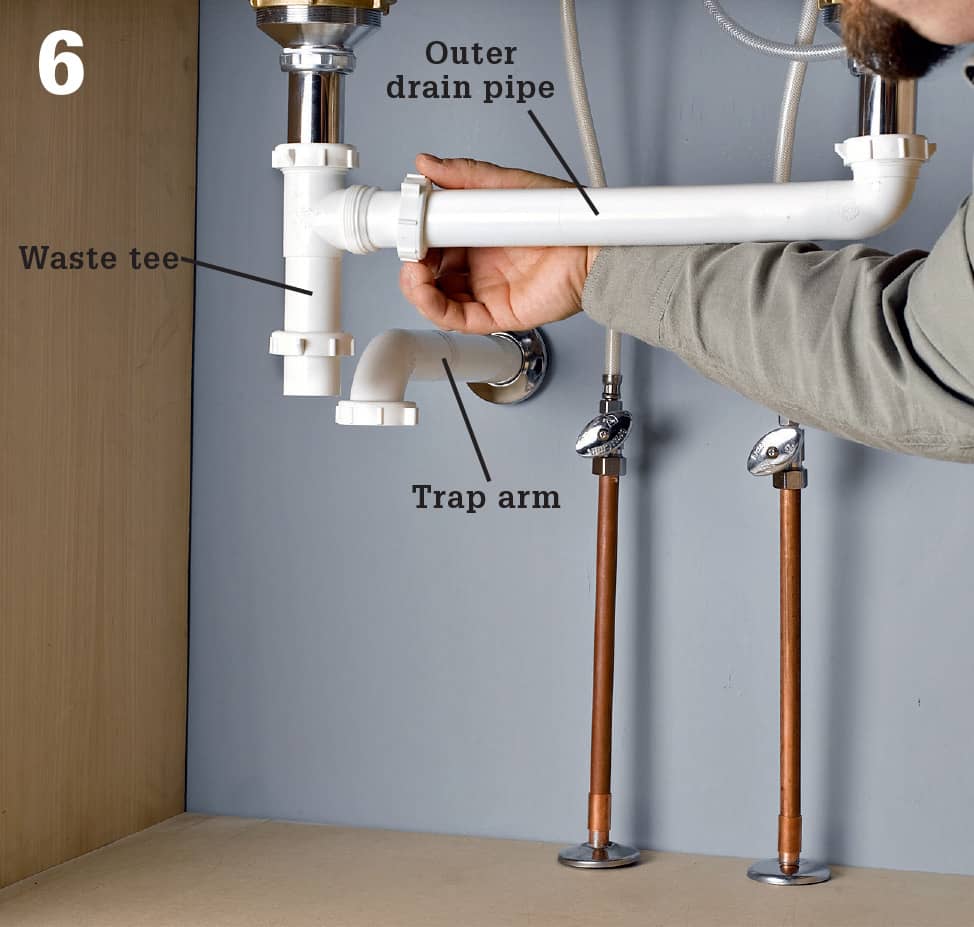
Join the short end of the outlet drain pipe to the tailpiece for the other sink bowl and then attach the end of the long run to the opening in the waste tee. The outlet tube should extend into the tee 1/2"—make sure it does not extend in far enough to block water flow from above.
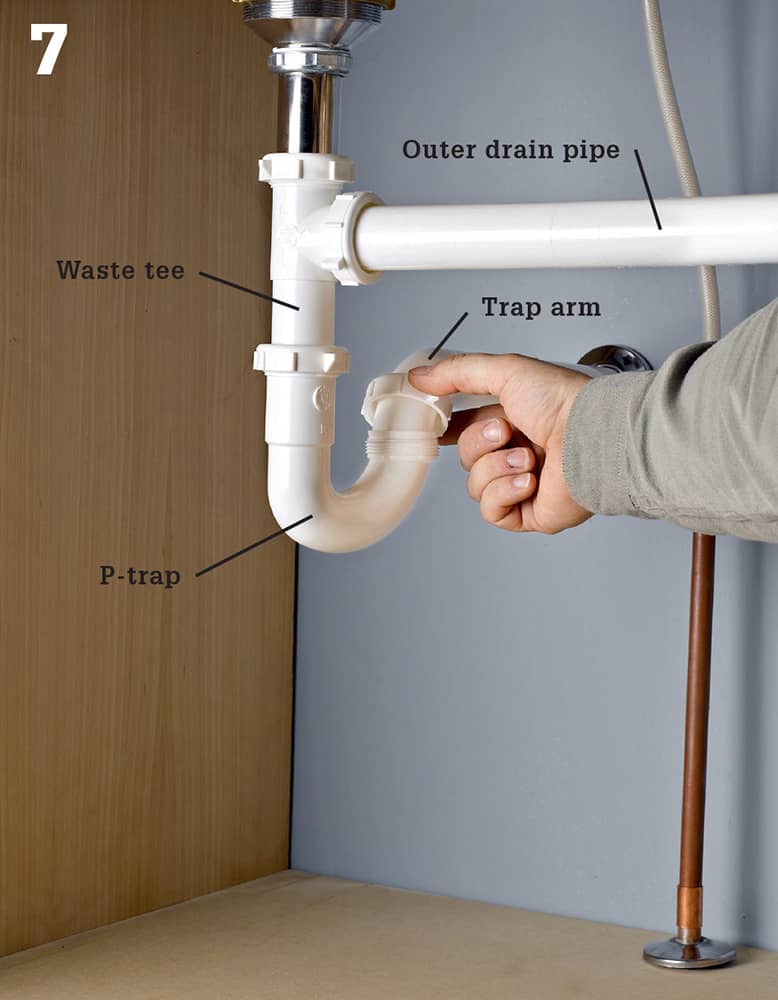
Attach the long leg of a P-trap to the waste tee and attach the shorter leg to the downward-facing opening of the trap arm. Adjust as necessary and test all joints to make sure they are still tight, and then test the system.
 Fixing Tub/Shower Faucets & Showerheads
Fixing Tub/Shower Faucets & Showerheads
Tub and shower faucets have the same basic designs as sink faucets, and the techniques for repairing leaks are the same as described in the faucet repair section of this book (pages 340 to 349). To identify your faucet design, you may have to take off the handle and disassemble the faucet.
When a tub and shower are combined, the showerhead and the tub spout share the same hot and cold water supply lines and handles. Combination faucets are available as three-handle, two-handle, or single-handle types (next page). The number of handles gives clues as to the design of the faucets and the kinds of repairs that may be necessary.
With combination faucets, a diverter valve or gate diverter is used to direct water flow to the tub spout or the showerhead. On three-handle faucet types, the middle handle controls a diverter valve. If water does not shift easily from tub to showerhead, or if water continues to run out the spout when the shower is on, the diverter valve probably needs to be cleaned and repaired (pages 351 to 352).
Two-handle and single-handle types use a gate diverter that is operated by a pull lever or knob on the tub spout. Although gate diverters rarely need repair, the lever occasionally may break, come loose, or refuse to stay in the up position. To repair a gate diverter set in a tub spout, replace the entire spout.
Tub and shower faucets and diverter valves may be set inside wall cavities. Removing them may require a deep-set ratchet wrench.
If spray from the showerhead is uneven, clean the spray holes. If the showerhead does not stay in an upright position, remove the head and replace the O-ring.
To add a shower to an existing tub, install a flexible shower adapter. Several manufacturers make complete conversion kits that allow a shower to be installed in less than one hour.
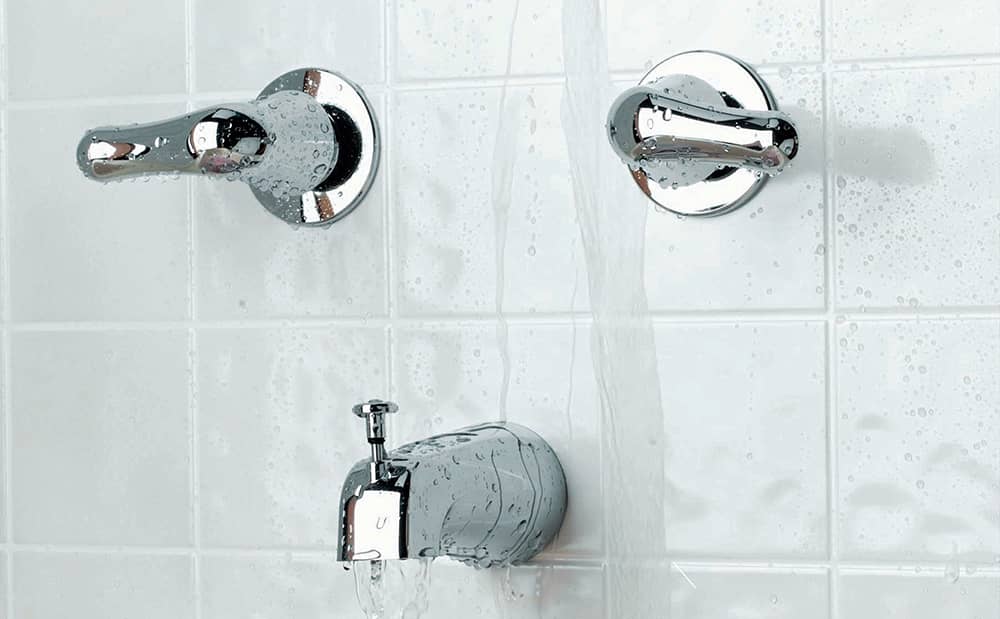
Tub/shower plumbing is notorious for developing drips from the tub spout and the showerhead. In most cases, the leak can be traced to the valves controlled by the faucet handles.
Tub & Shower Combination Faucets

Three-handle faucet (page 364) has valves that are either compression or cartridge design.

Two-handle faucet (page 366) has valves that are either compression or cartridge design.

Single-handle faucet (page 368) has valves that are cartridge, ball-type, or disc design.
Fixing Three-handle Tub & Shower Faucets
A three-handle faucet type has two handles to control hot and cold water, and a third handle to control the diverter valve and direct water to either a tub spout or a shower head. The separate hot and cold handles indicate cartridge or compression faucet designs.
If a diverter valve sticks, if water flow is weak, or if water runs out of the tub spout when the flow is directed to the showerhead, the diverter needs to be repaired or replaced. Most diverter valves are similar to either compression or cartridge faucet valves. Compression-type diverters can be repaired, but cartridge types should be replaced.
Remember to turn off the water before beginning work.
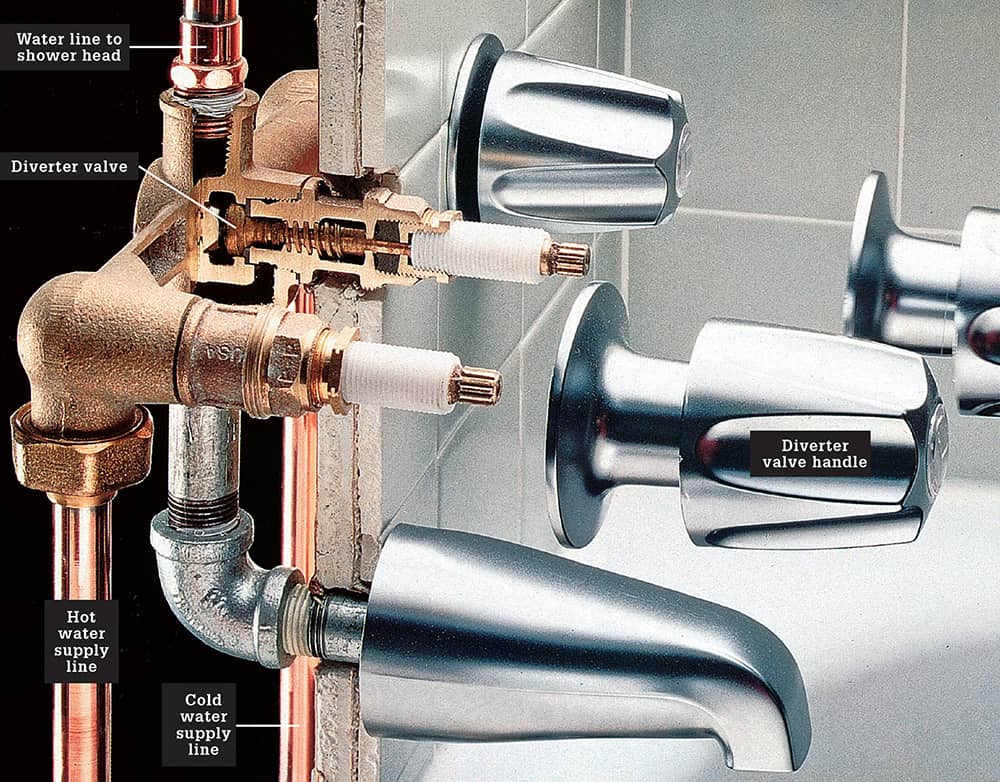
A three-handle tub/shower faucet has individual controls for hot and cold water plus a third handle that operates the diverter valve.
How to Repair a Compression Diverter Valve
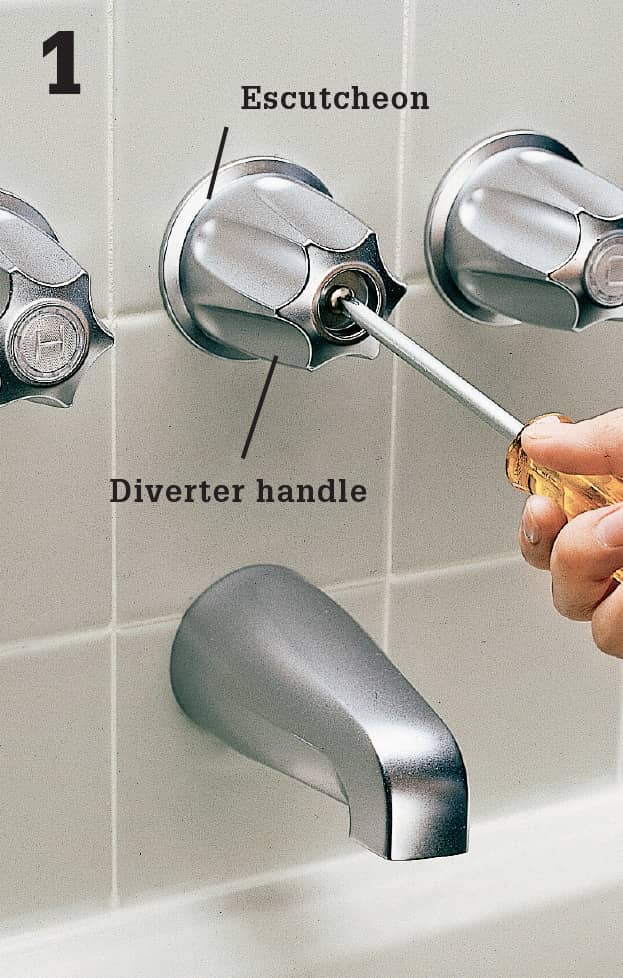
Remove the diverter valve handle with a screwdriver. Unscrew or pry off the escutcheon.
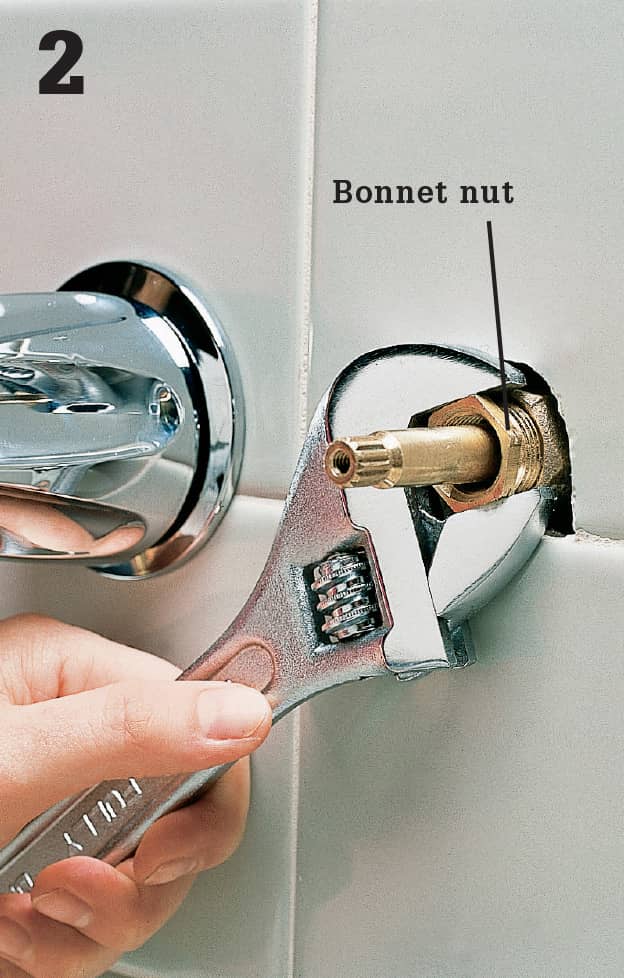
Remove bonnet nut with an adjustable wrench or channel-type pliers.
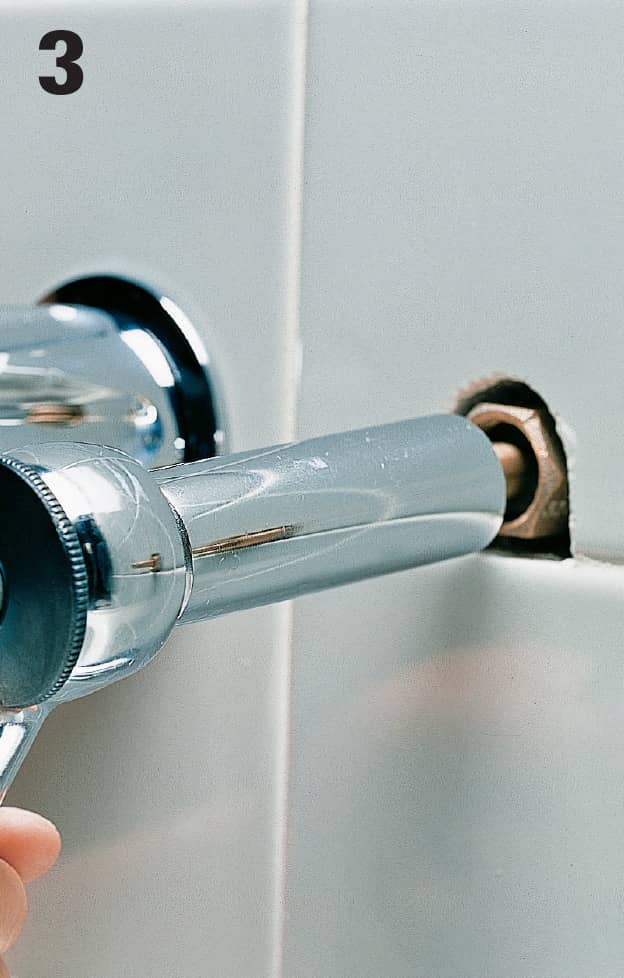
Unscrew the stem assembly, using a deep-set ratchet wrench. If necessary, chip away any mortar surrounding the bonnet nut.
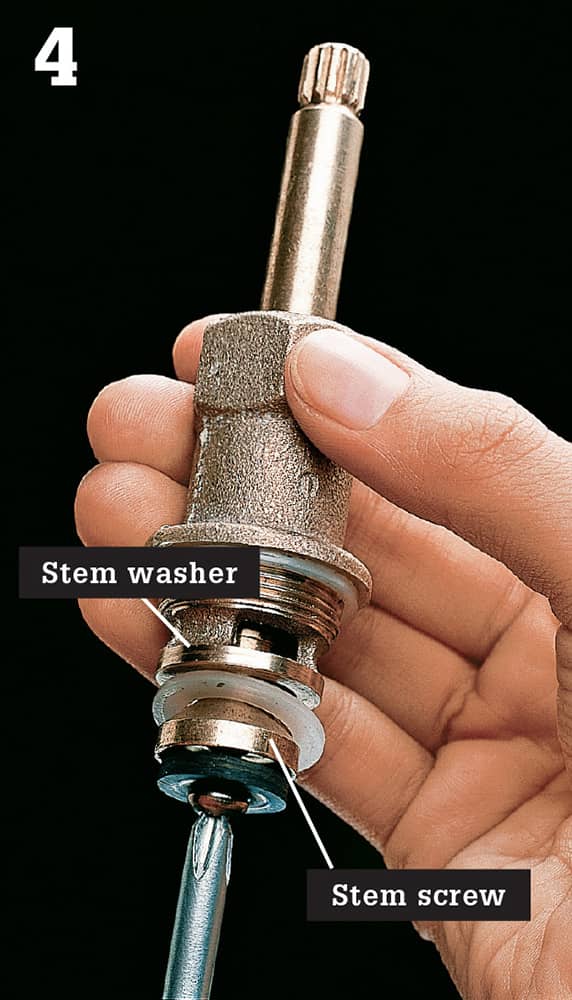
Remove brass stem screw. Replace stem washer with an exact duplicate. If stem screw is worn, replace it.
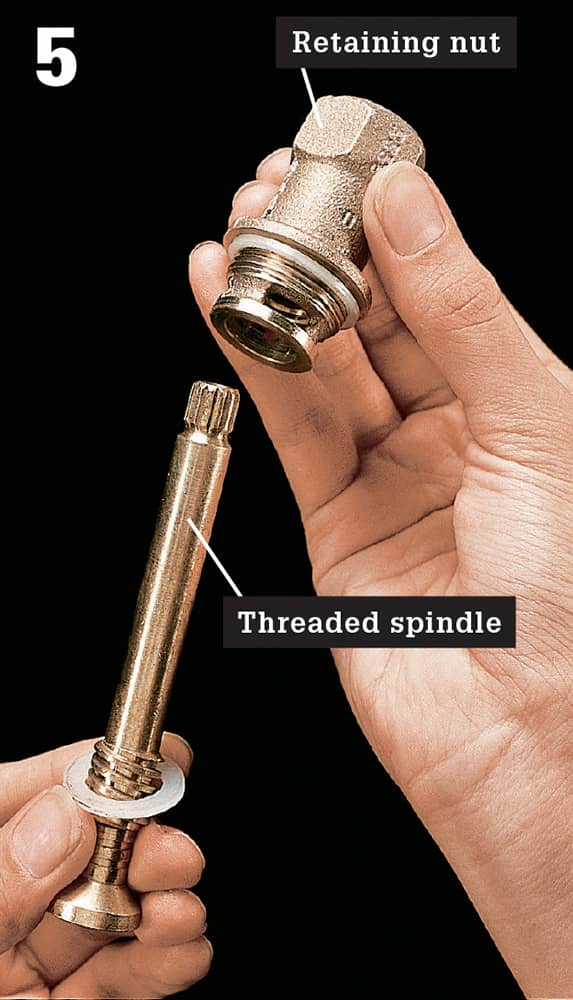
Unscrew the threaded spindle from the retaining nut.
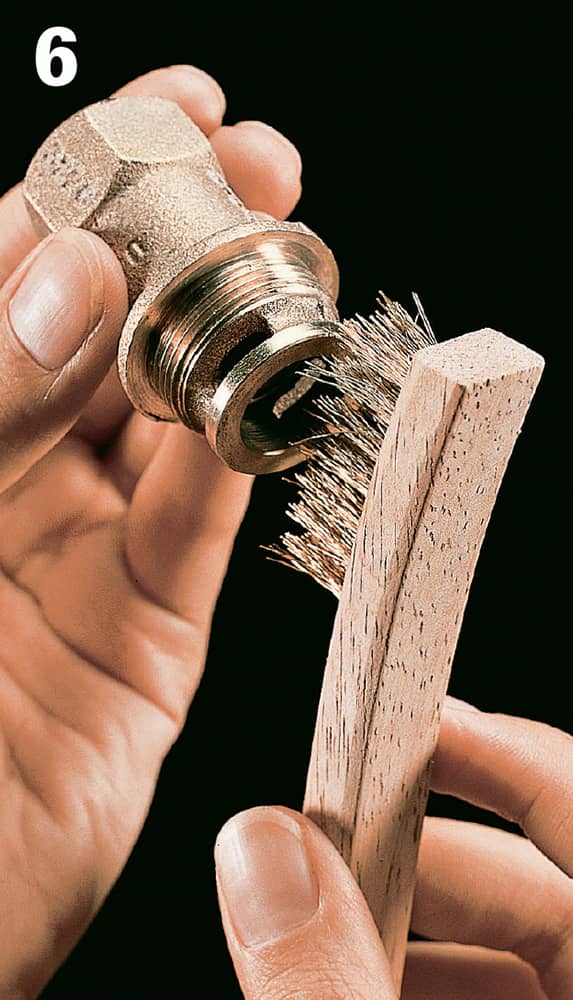
Clean sediment and lime buildup from nut, using a small wire brush dipped in vinegar. Coat all parts with faucet grease and reassemble diverter valve.
Fixing Two-handle Tub & Shower Faucets
Two-handle tub and shower faucets are either cartridge or compression design. Because the valves of two-handle tub and shower faucets may be set inside the wall cavity, a deep-set socket wrench may be required to remove the valve stem.
Two-handle tub and shower designs have a gate diverter. A gate diverter is a simple mechanism located in the tub spout. A gate diverter closes the supply of water to the tub spout and redirects the flow to the shower head. Gate diverters seldom need repair. Occasionally, the lever may break, come loose, or refuse to stay in the up position.
If the diverter fails to work properly, replace the tub spout. Tub spouts are inexpensive and easy to replace.
Remember to turn off the water before beginning any work.
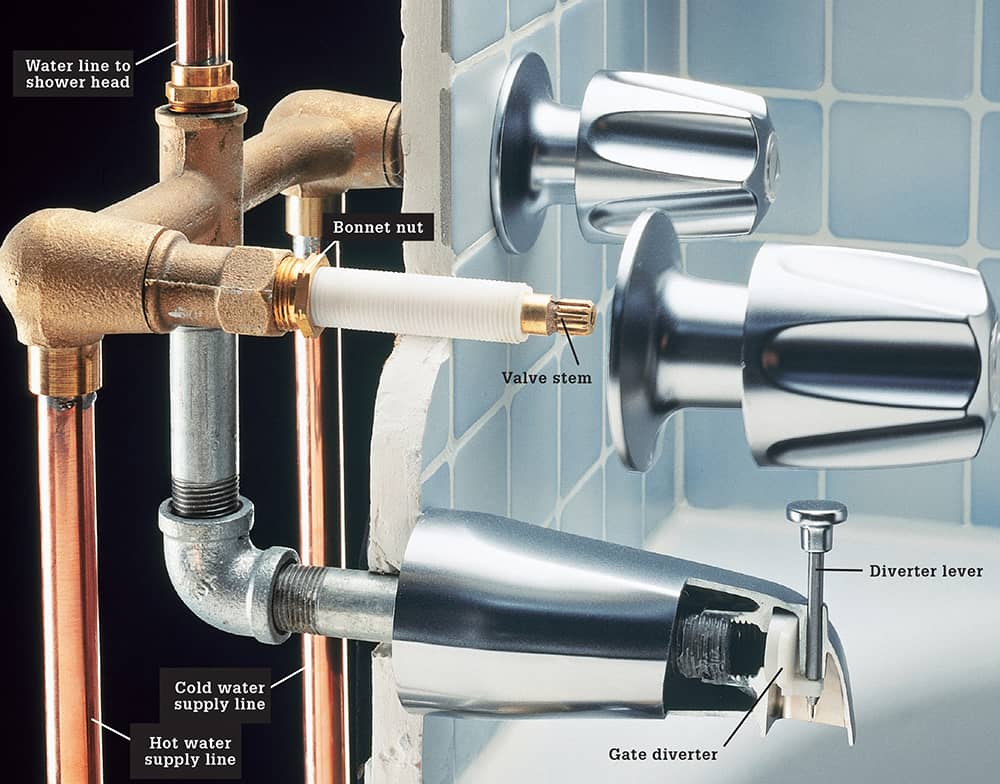
A two-handle tub/shower faucet can operate with compression valves, but more often these days they contain cartridges that can be replaced. Unlike a three-handled model, the diverter is a simple gate valve that is operated by a lever.
How to Remove a Deep-set Faucet Valve
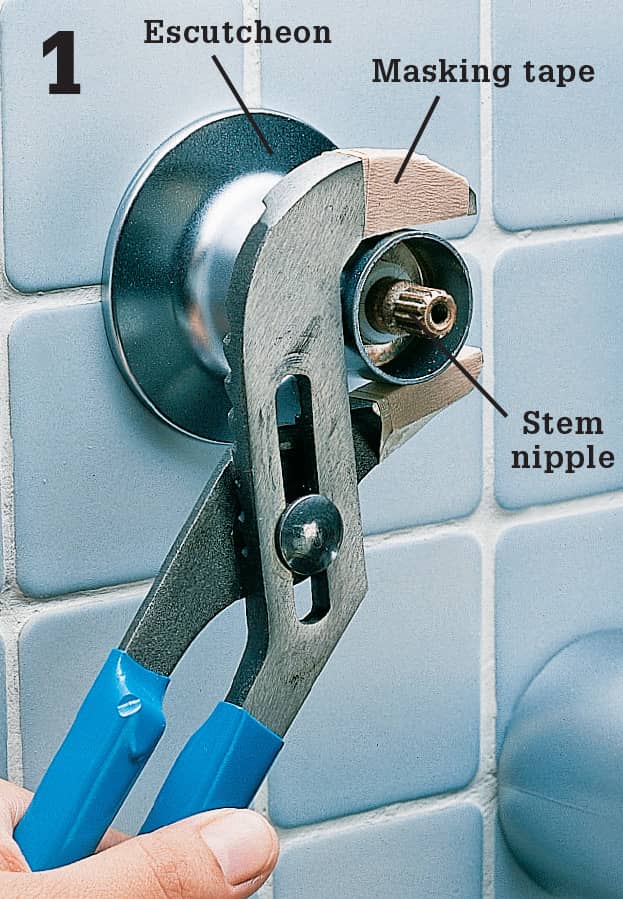
Remove handle and unscrew the escutcheon with channel-type pliers. Pad the jaws of the pliers with masking tape to prevent scratching the escutcheon.
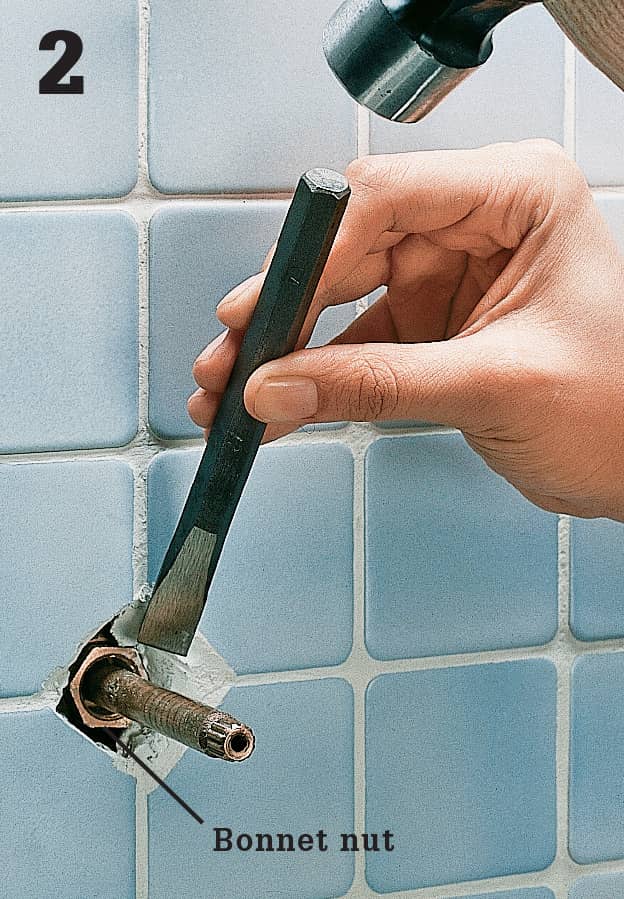
Chip away any mortar surrounding the bonnet nut using a ball-peen hammer and a small cold chisel.
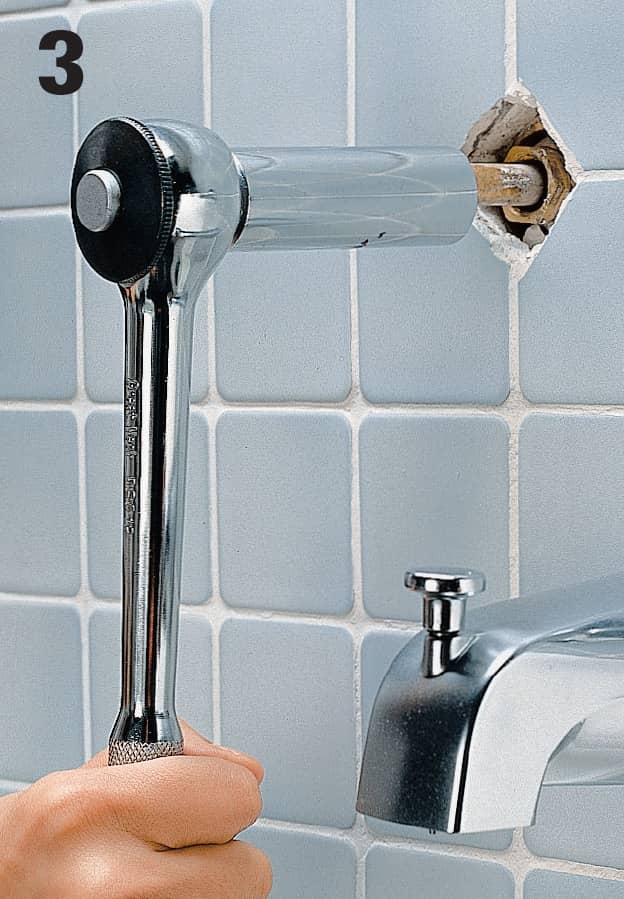
Unscrew the bonnet nut with a deep-set ratchet wrench. Remove the bonnet nut and stem from the faucet body.
Fixing Single-handle Tub & Shower Faucets
A single-handle tub and shower faucet has one valve that controls both water flow and temperature. Single-handle faucets may be ball-type, cartridge, or disc designs.
If a single-handle control valve leaks or does not function properly, disassemble the faucet, clean the valve, and replace any worn parts. Repairing a single-handle cartridge faucet is shown on the opposite page.
Direction of the water flow to either the tub spout or the showerhead is controlled by a gate diverter. Gate diverters seldom need repair. Occasionally, the lever may break, come loose, or refuse to stay in the up position. Remember to turn off the water before beginning any work; the shower faucet shown here has built-in shutoff valves, but many other valves do not. Open an access panel in an adjoining room or closet, behind the valve, and look for two shutoffs. If you can’t find them there, you may have to shut off intermediate valves or the main shutoff valve.
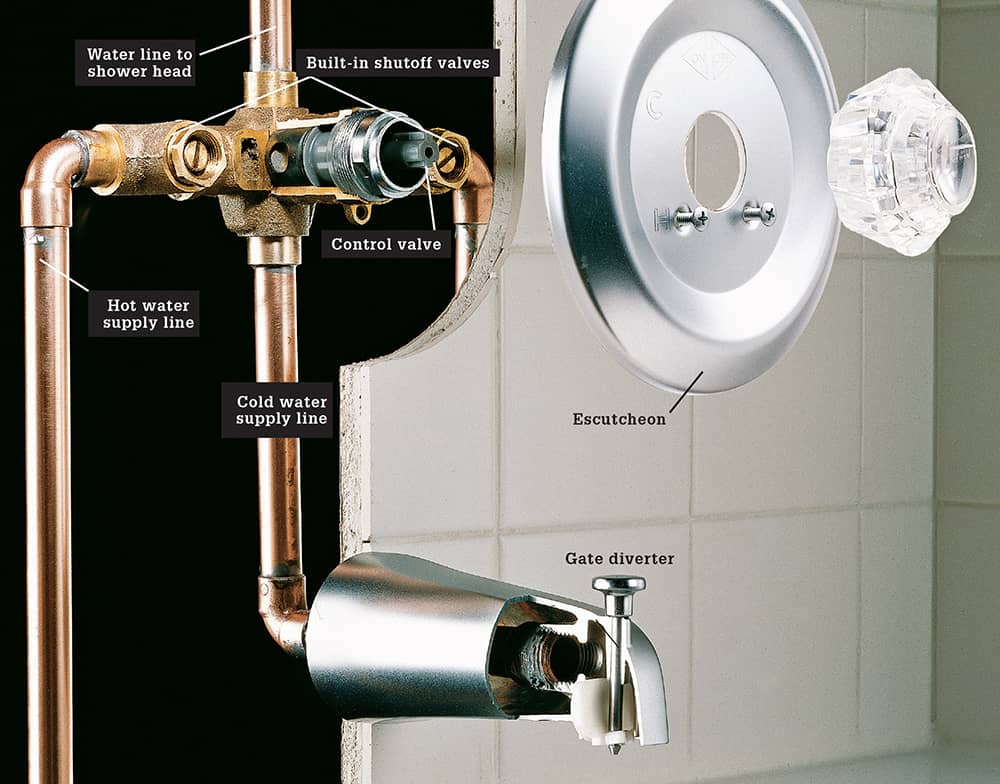
A single-handle tub/shower faucet is the simplest type to operate and to maintain. The handle controls the mixing ratio of both hot and cold water, and the diverter is a simple gate valve.
How to Repair a Single-handle Cartridge Tub & Shower Faucet
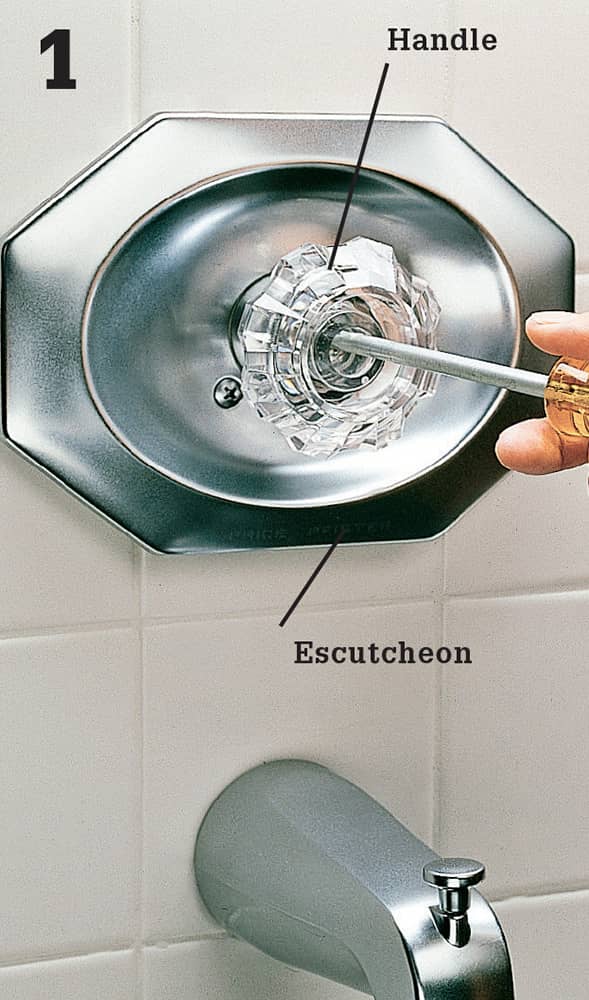
Use a screwdriver to remove the handle and escutcheon.
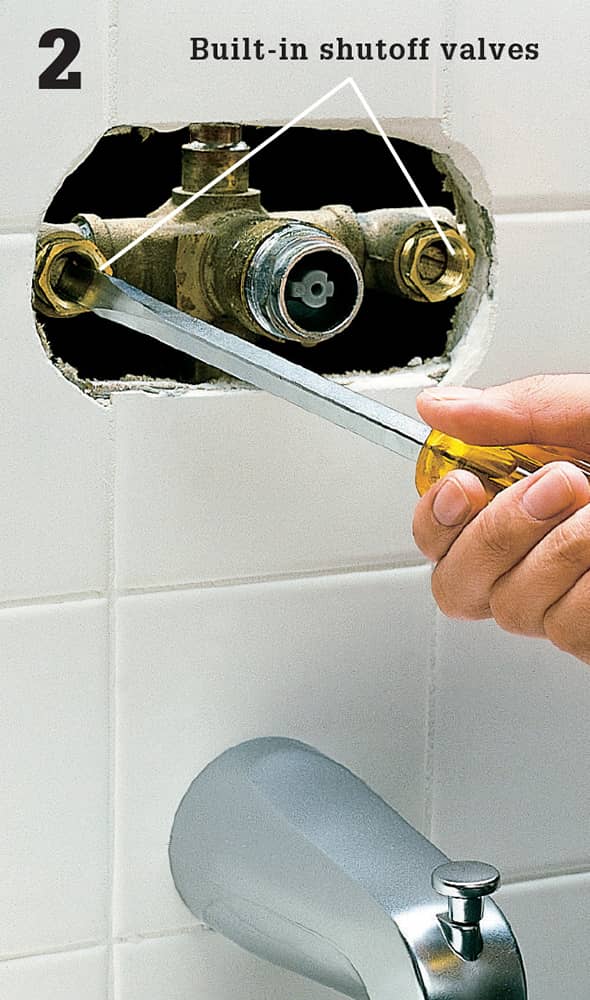
Turn off water supply at the built-in shutoff valves or the main shutoff valve.
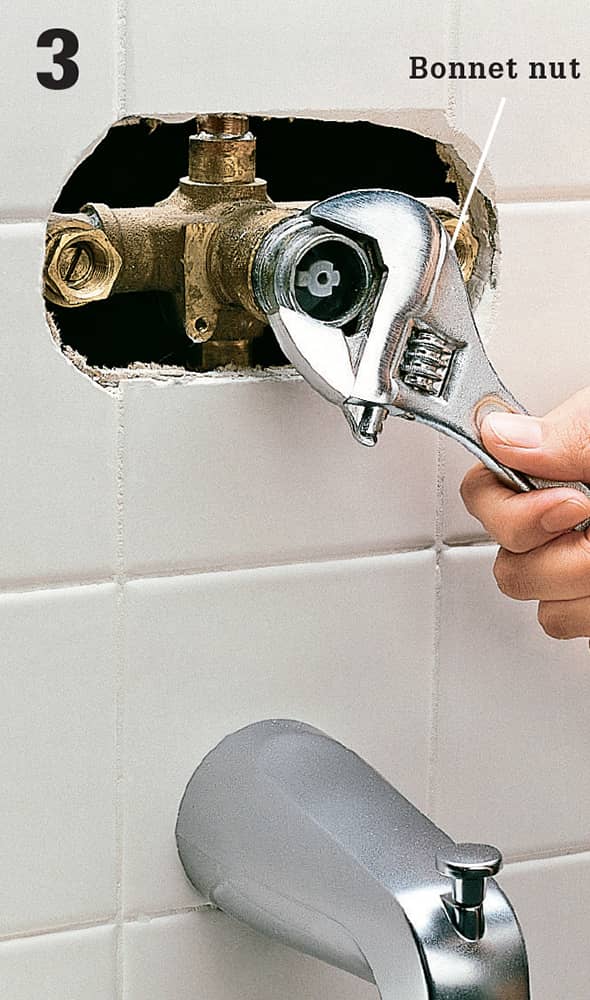
Unscrew and remove the retaining ring or bonnet nut using adjustable wrench.
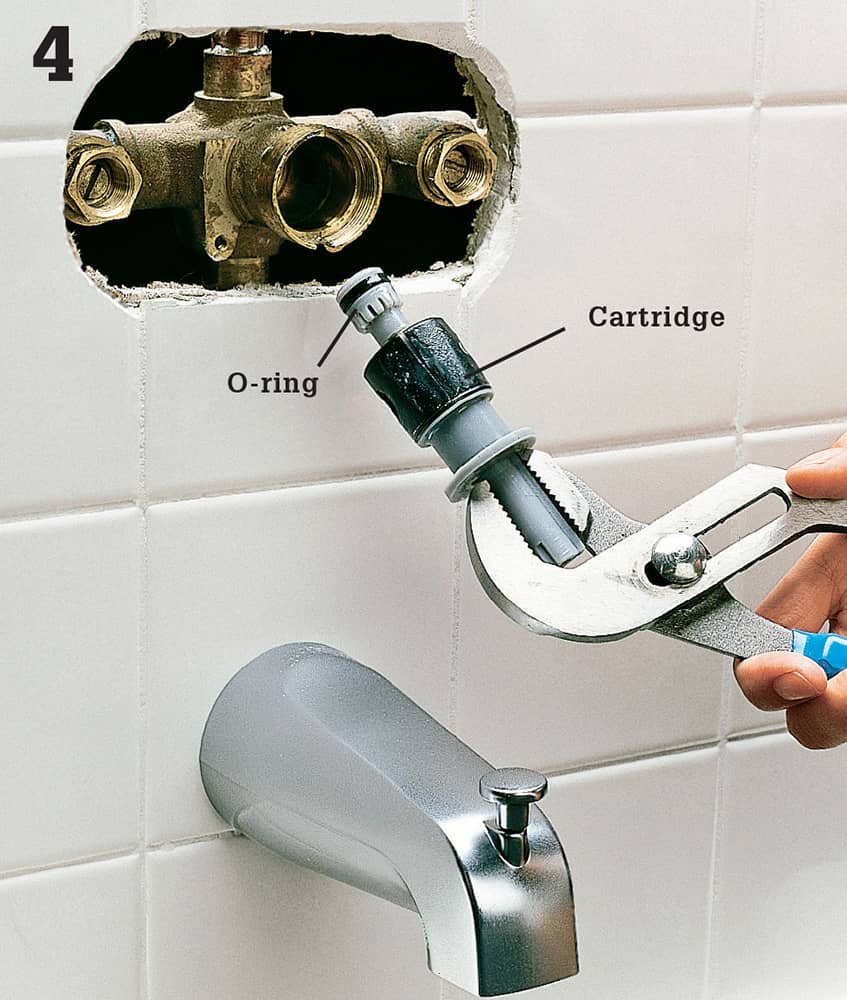
Remove the cartridge assembly by grasping the end of the valve with channel-type pliers and pulling gently.
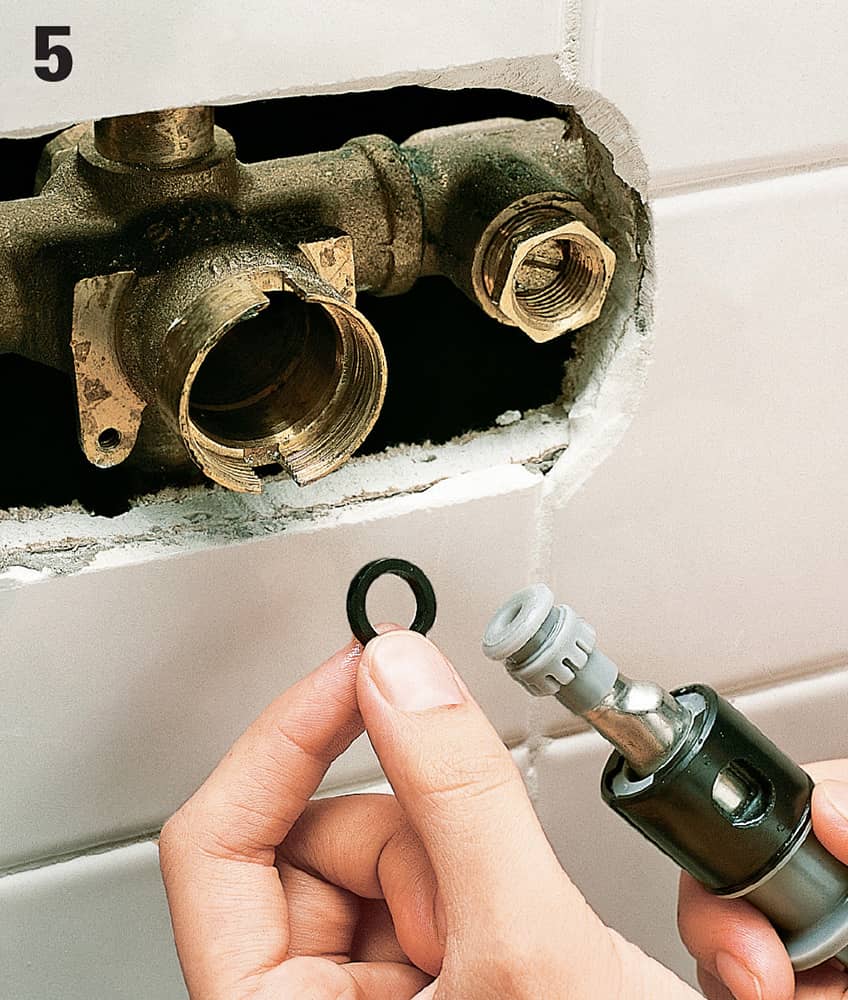
Flush the valve body with clean water to remove sediment. Replace any worn O-rings. Reinstall the cartridge and test the valve. If the faucet fails to work properly, replace the cartridge.
Single-Handle Tub & Shower Faucet with Scald Control
In many plumbing systems, if someone flushes a nearby toilet or turns on the cold water of a nearby faucet while someone else is taking a shower, the shower water temperature can suddenly rise precipitously. This is not only uncomfortable; it can actually scald you. For that reason, many one-handle shower valves have a device, called a “balancing valve” or an “anti-scald valve,” that keeps the water from getting too hot.
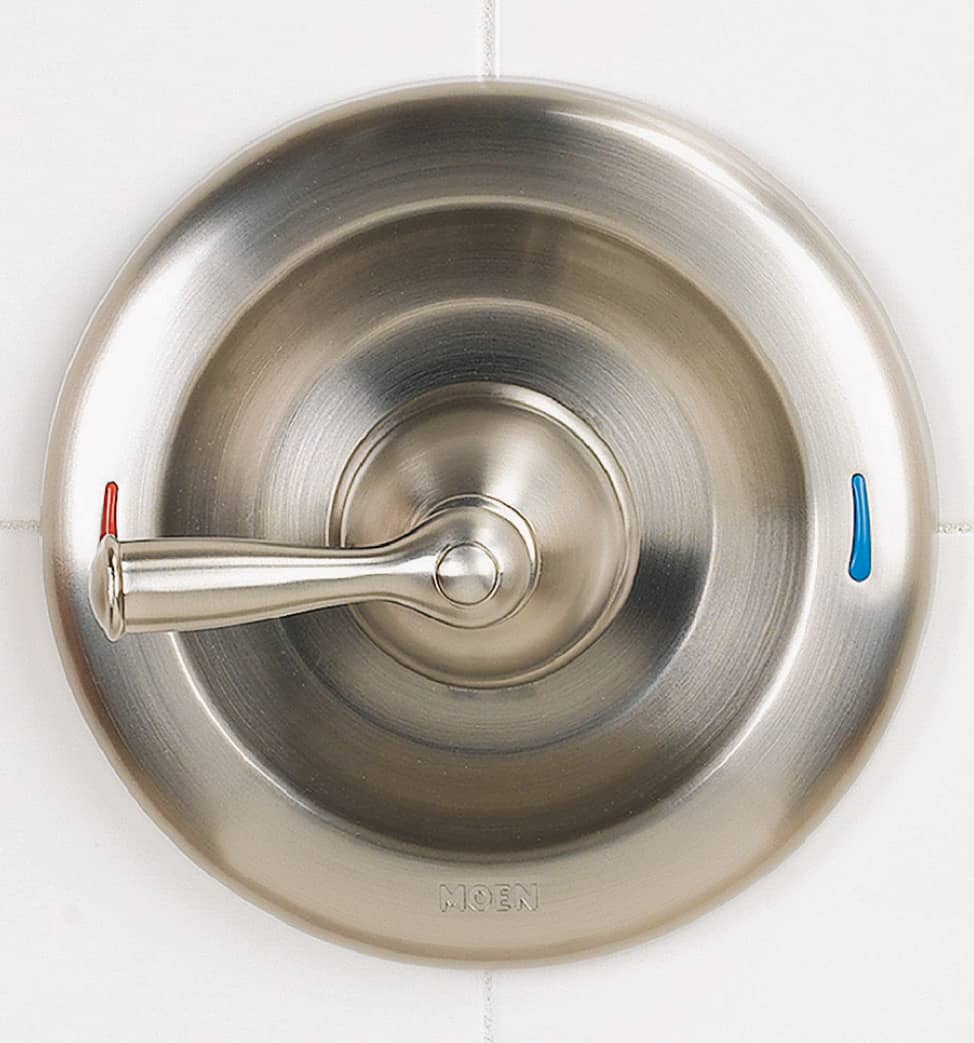
The temperature of your shower may drastically rise to dangerous scalding levels if a nearby toilet is flushed. A shower fixture equipped with an anti-scald valve prevents this sometimes dangerous situation.
How to Adjust the Shower’s Temperature
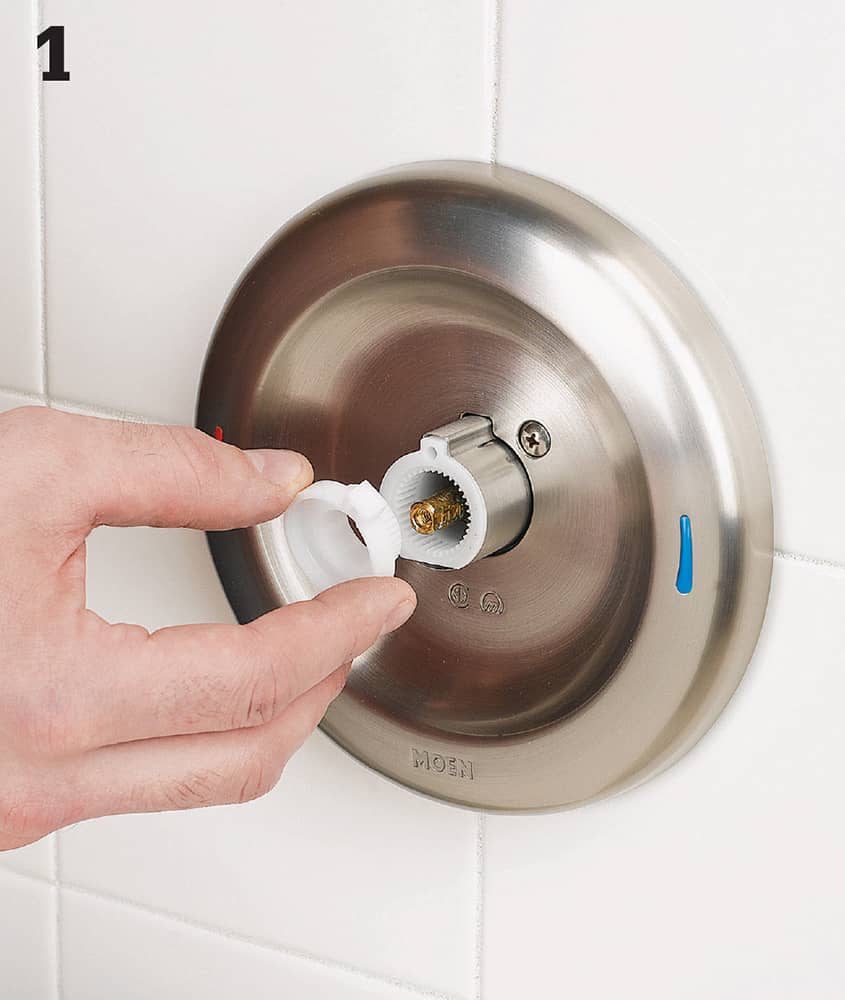
To reduce or raise the maximum temperature, remove the handle and escutcheon. Some models have an adjustment screw, others have a handle that can be turned by hand.
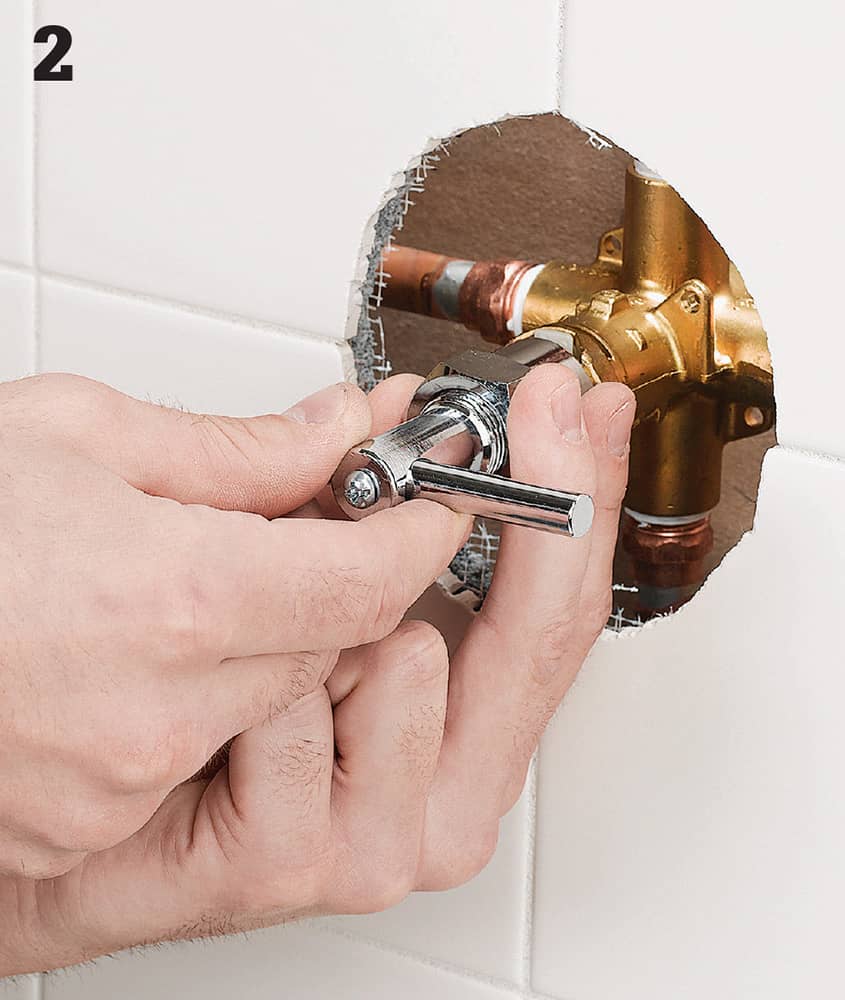
To remove a balancing valve, you may need to buy a removal tool made for your faucet. Before replacing, slowly turn on water to flush out any debris; use a towel or bucket to keep water from entering inside the wall.
Fixing & Replacing Showerheads
If spray from the showerhead is uneven, clean the spray holes. The outlet or inlet holes of the showerhead may get clogged with mineral deposits. Showerheads pivot into different positions. If a showerhead does not stay in position, or if it leaks, replace the O-ring that seals against the swivel ball.
A tub can be equipped with a shower by installing a flexible shower adapter kit. Complete kits are available at hardware stores and home centers.
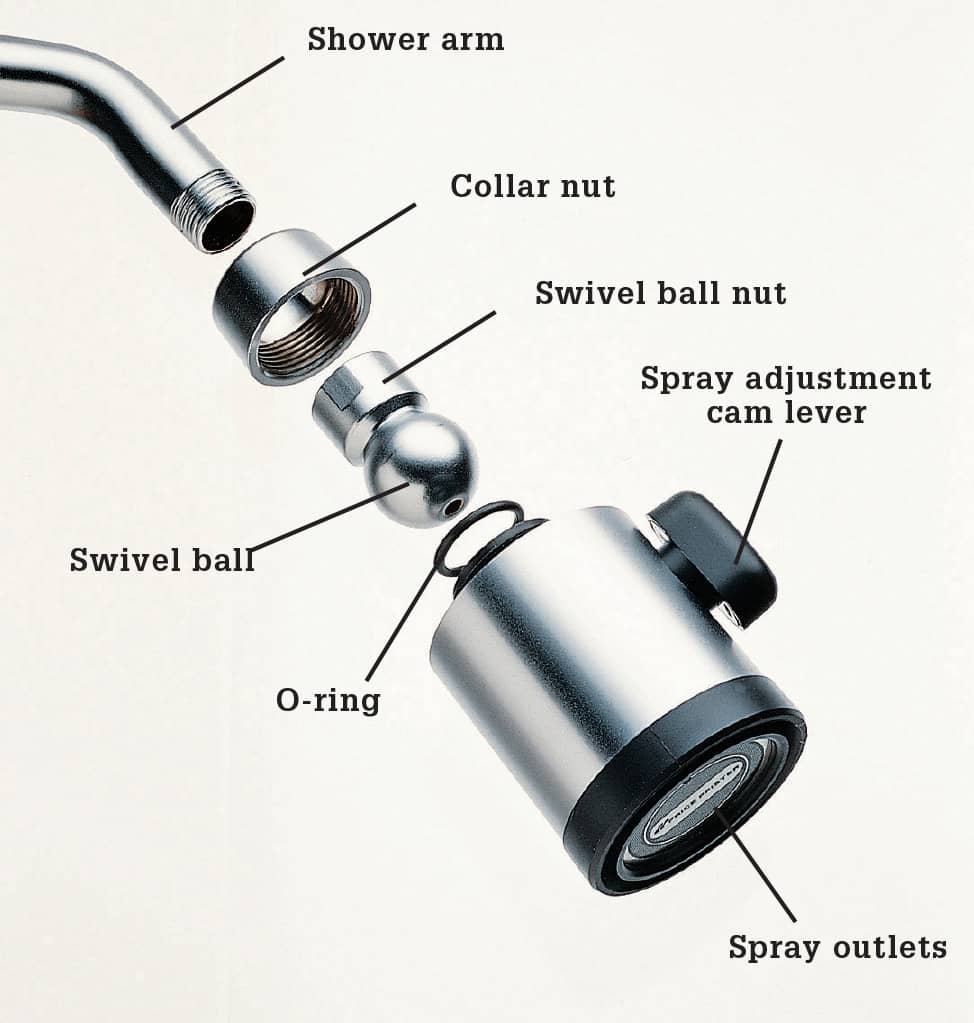
A typical showerhead can be disassembled easily for cleaning and repair. Some showerheads include a spray adjustment cam lever that is used to change the force of the spray.
How to Clean & Repair a Showerhead
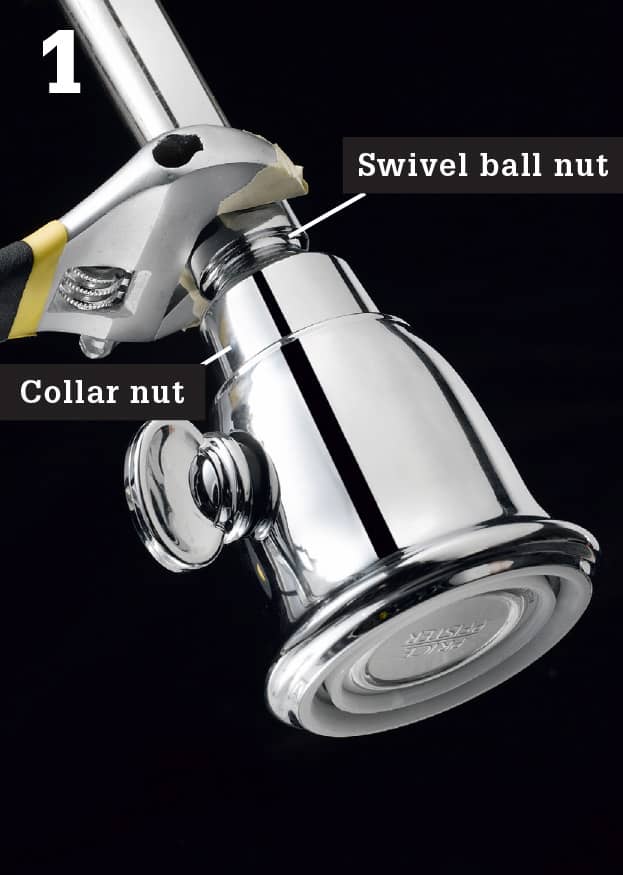
Unscrew the swivel ball nut, using an adjustable wrench or channel-type pliers. Wrap jaws of the tool with masking tape to prevent marring the finish. Unscrew collar nut from the showerhead.
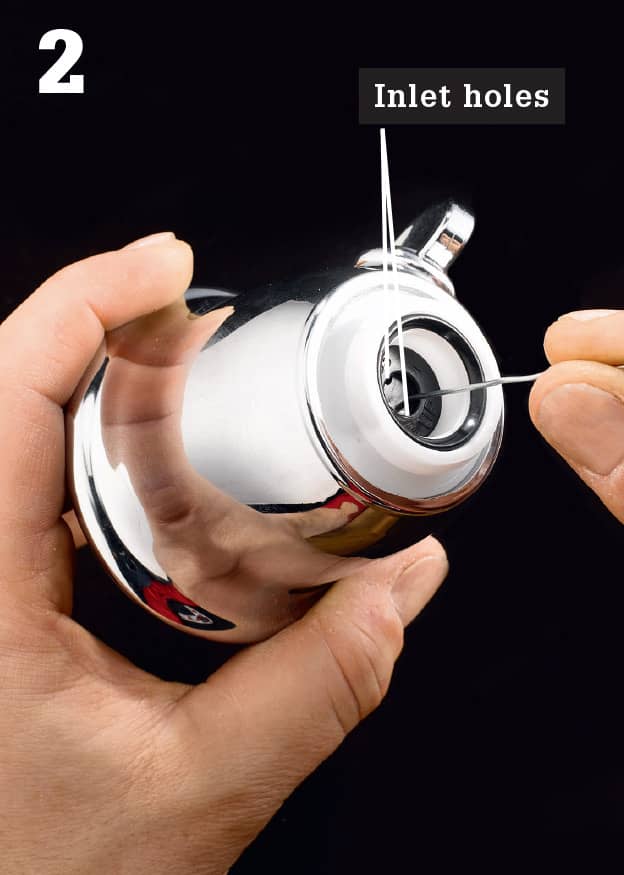
Clean outlet and inlet holes of showerhead with a thin wire. Flush the head with clean water.
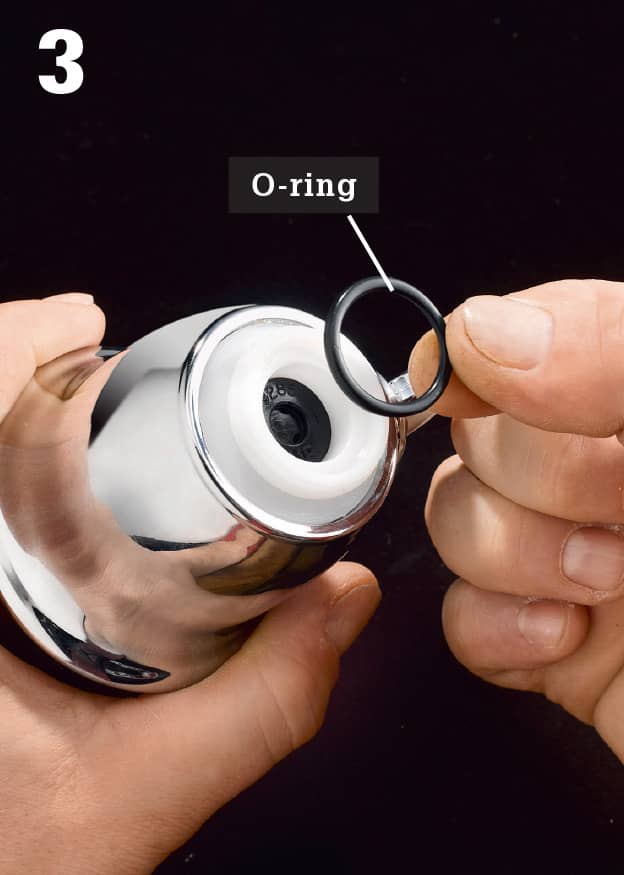
Replace the O-ring, if necessary. Lubricate the O-ring with faucet grease before installing.
 Fixing Tub/Shower Drains
Fixing Tub/Shower Drains
Tub or shower not draining? First, make sure it’s only the tub or shower. If your sink is plugged, too, it may be a coincidence or it may be that a common branch line is plugged. A sure sign of this is when water drains from the sink into the tub. This could require the help of a drain cleaning service.
If the toilet also can’t flush (or worse, water comes into the tub when you flush the toilet), then the common drain to all your bathroom fixtures is plugged. Call a drain cleaning service. If you suspect the problem is only with your tub or shower, then read on. We’ll show you how to clear drainlines and clean and adjust two types of tub stopper mechanisms. Adjusting the mechanism can also help with the opposite problem: a tub that drains when you’re trying to take a bath.
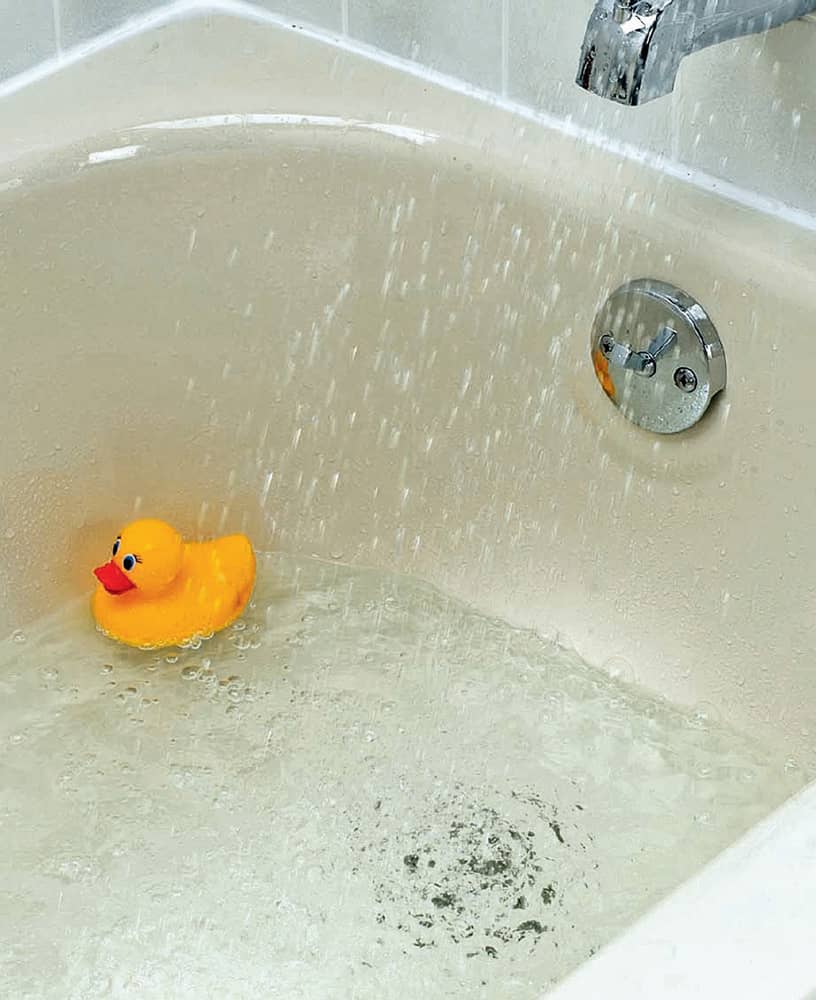
As with bathroom sinks, tub and shower drain pipes may become clogged with soap and hair. The drain stopping mechanisms can also require cleaning and adjustment.
How to Fix a Plunger-Type Drain
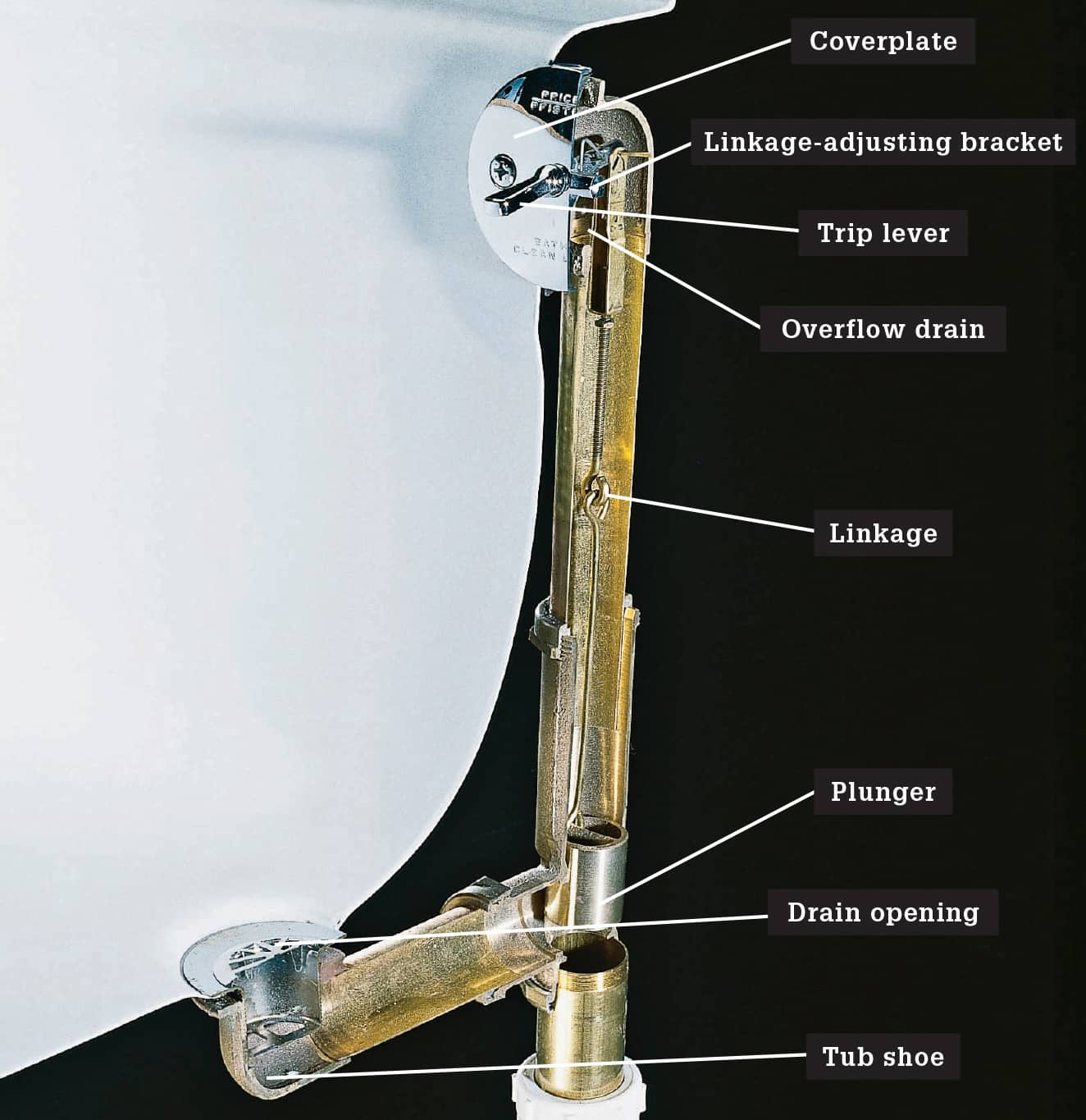
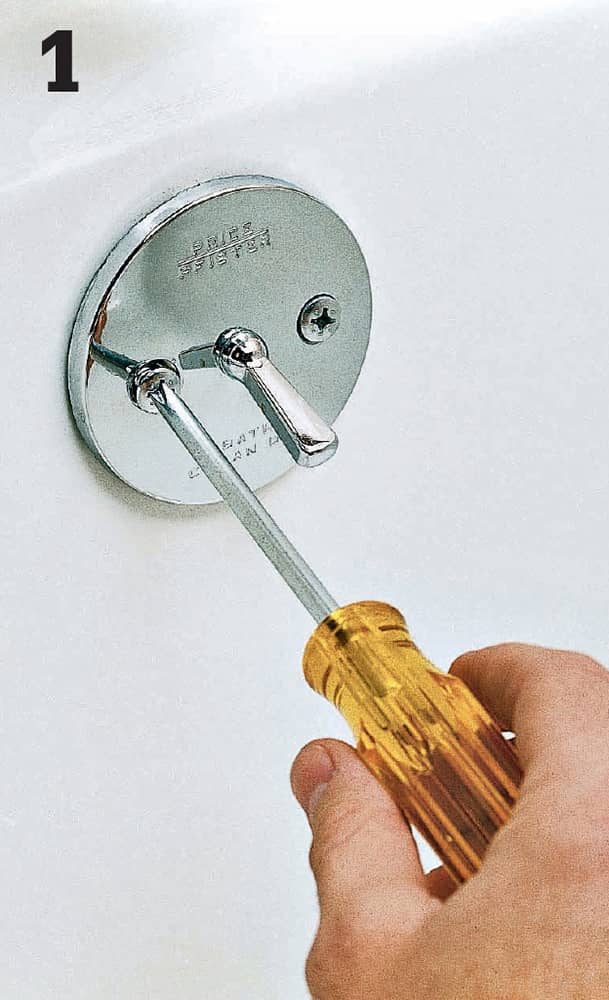
A plunger-type tub drain has a simple grate over the drain opening and a behind-the-scenes plunger stopper. Remove the screws on the overflow coverplate with a slotted or Phillips screwdriver. Pull the coverplate, linkage, and plunger from the overflow opening.
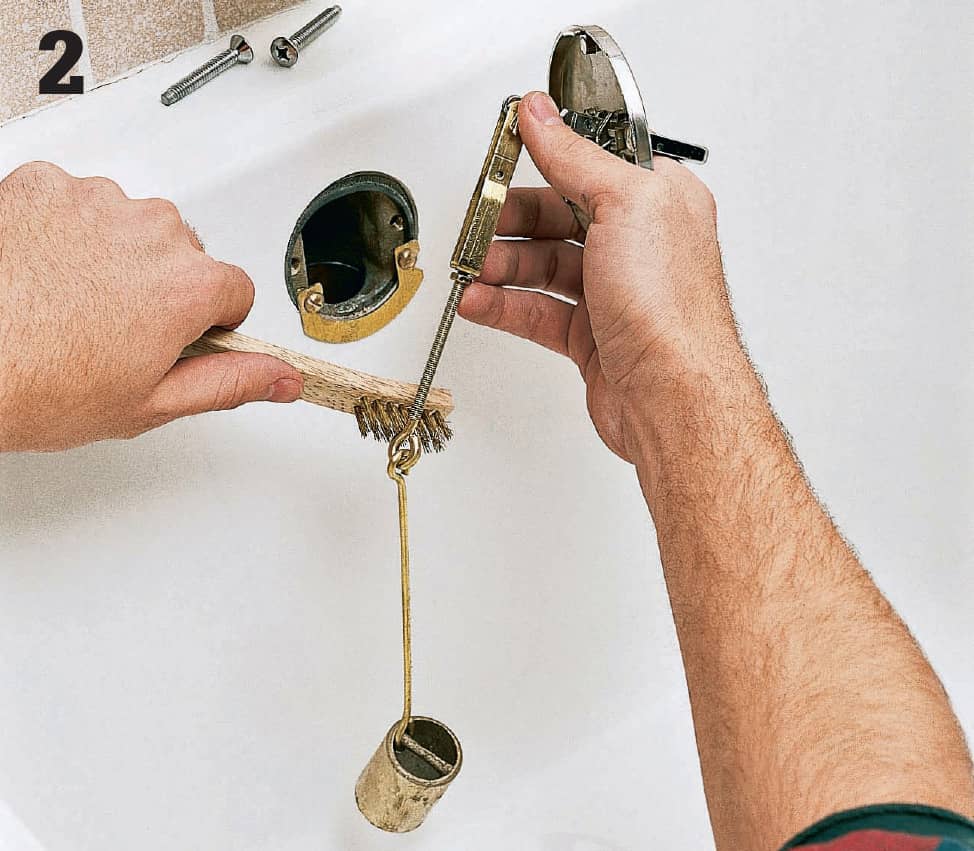
Clean hair and soap off the plunger with a scrub brush. Mineral buildup is best tackled with white vinegar and a toothbrush or a small wire brush.
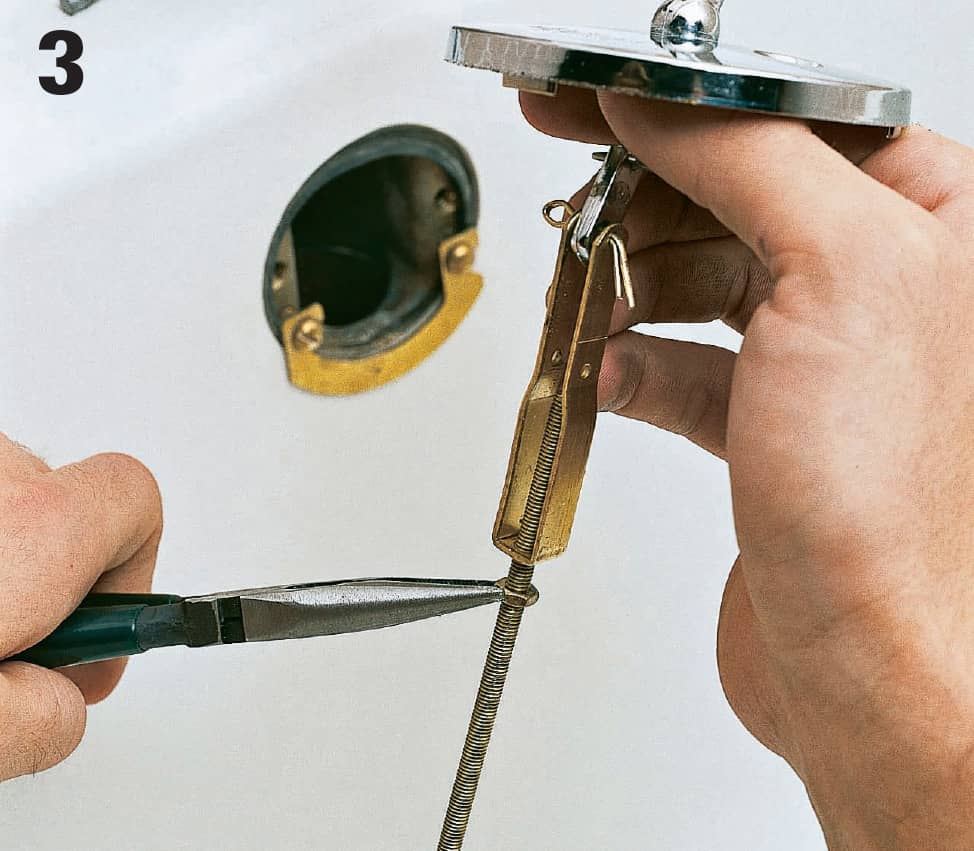
Adjust the plunger. If your tub isn’t holding water with the plunger down, it’s possible the plunger is hanging too high to fully block water from the tub shoe. Loosen the locknut with needlenose pliers, then screw the rod down about 1/8". Tighten the locknut down. If your tub drains poorly, the plunger may be set too low. Loosen the locknut and screw the rod in 1/8" before retightening the locknut.
How to Fix a Pop-up Drain
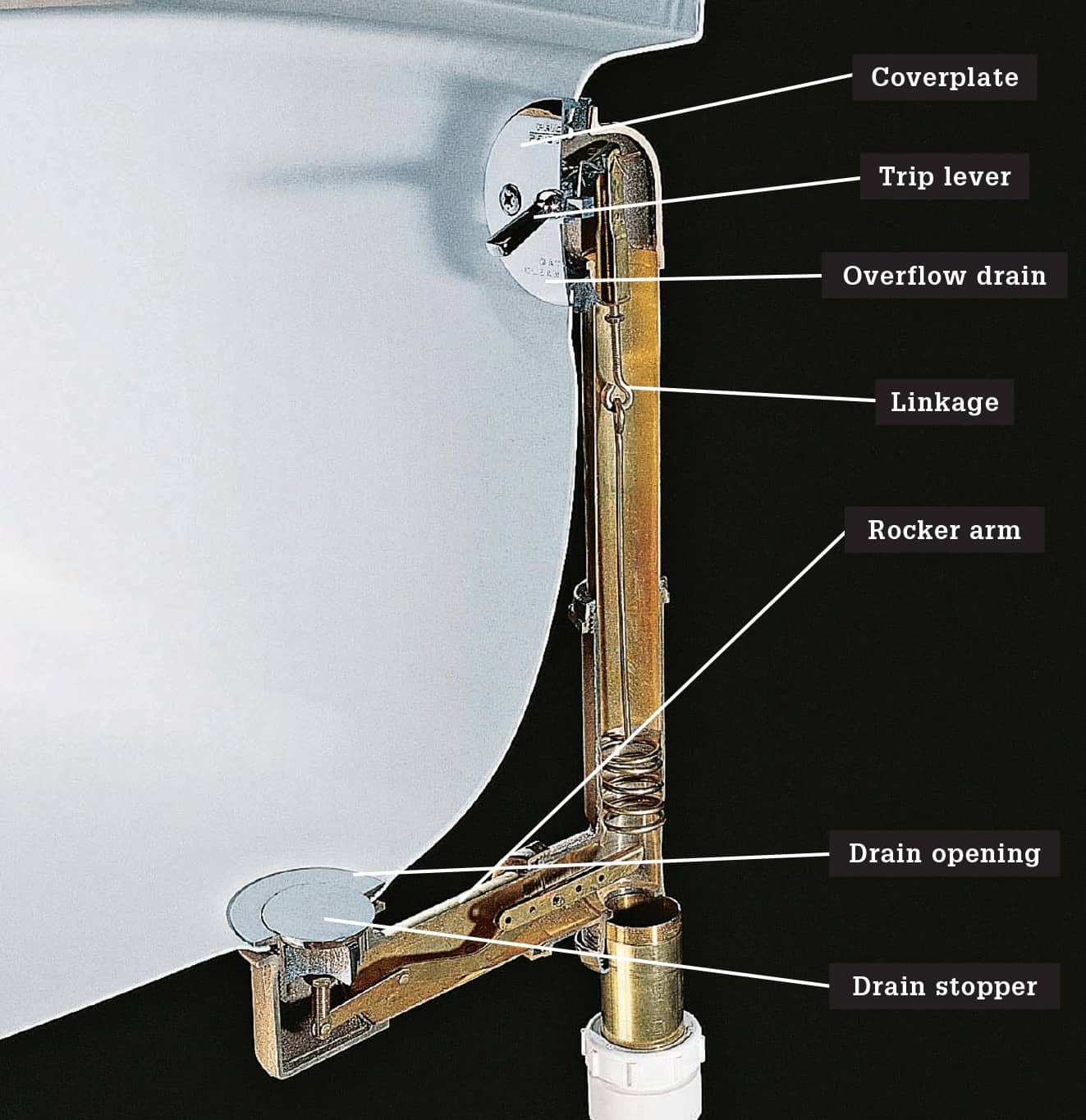
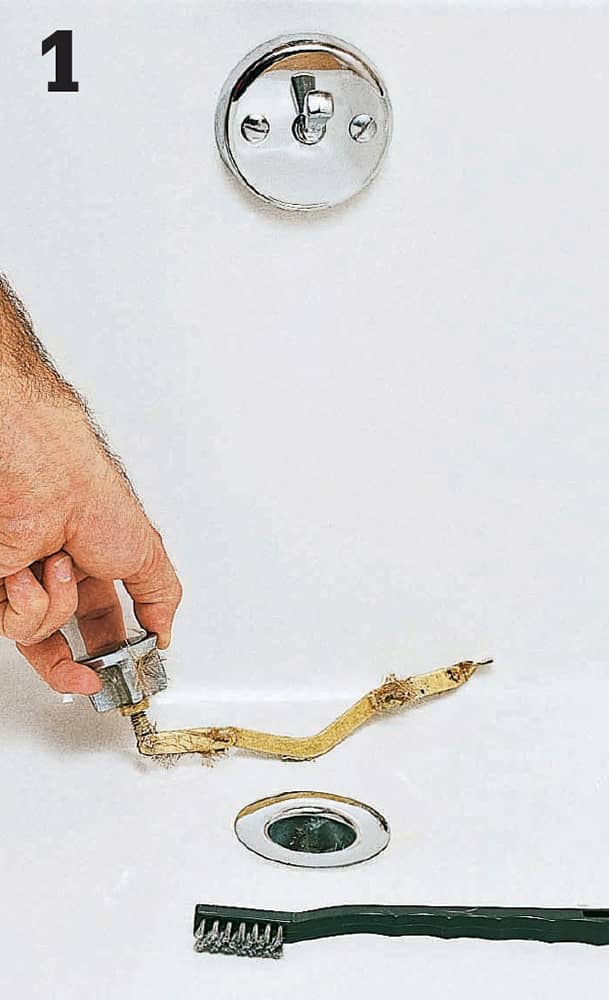
Raise the trip lever to the open position. Pull the stopper and rocker arm assembly from the drain. Clean off soap and hair with a dishwashing brush in a basin of hot water. Clean off mineral deposits with a toothbrush or small wire brush and white vinegar.
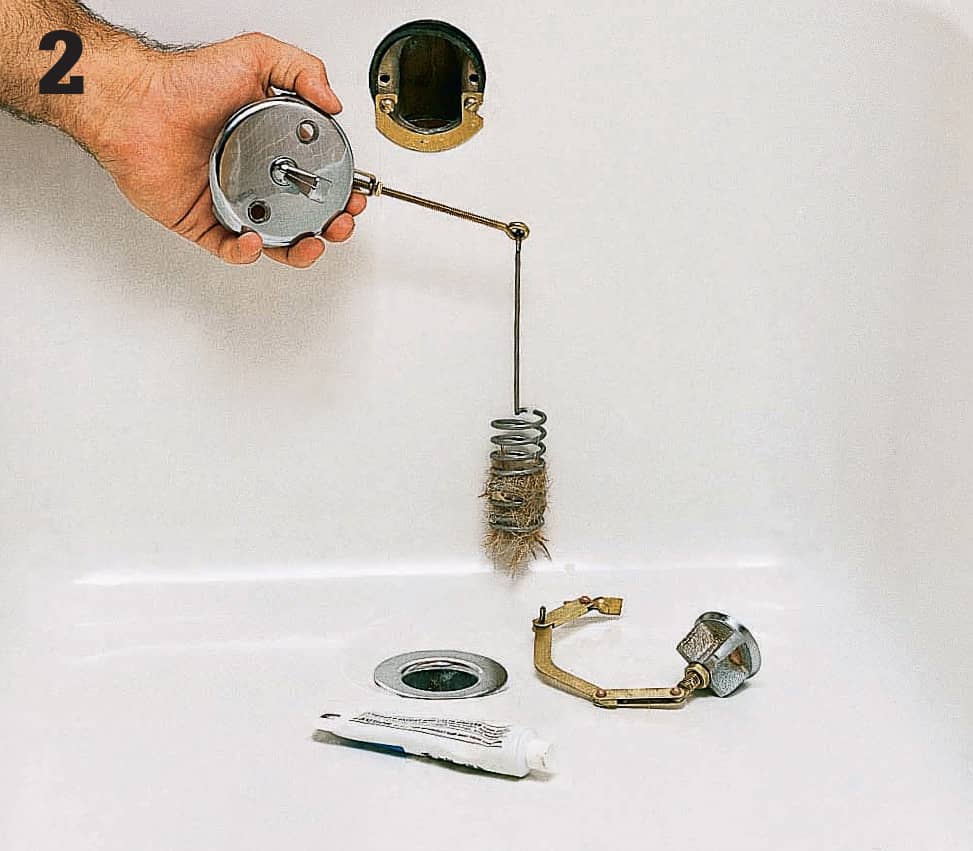
Remove the screws from the cover plate. Pull the trip lever and the linkage from the overflow opening. Clean off soap and hair with a brush in a basin of hot water. Remove mineral buildup with white vinegar and a wire brush. Lubricate moving parts of the linkage and rocker arm mechanism with faucet grease.
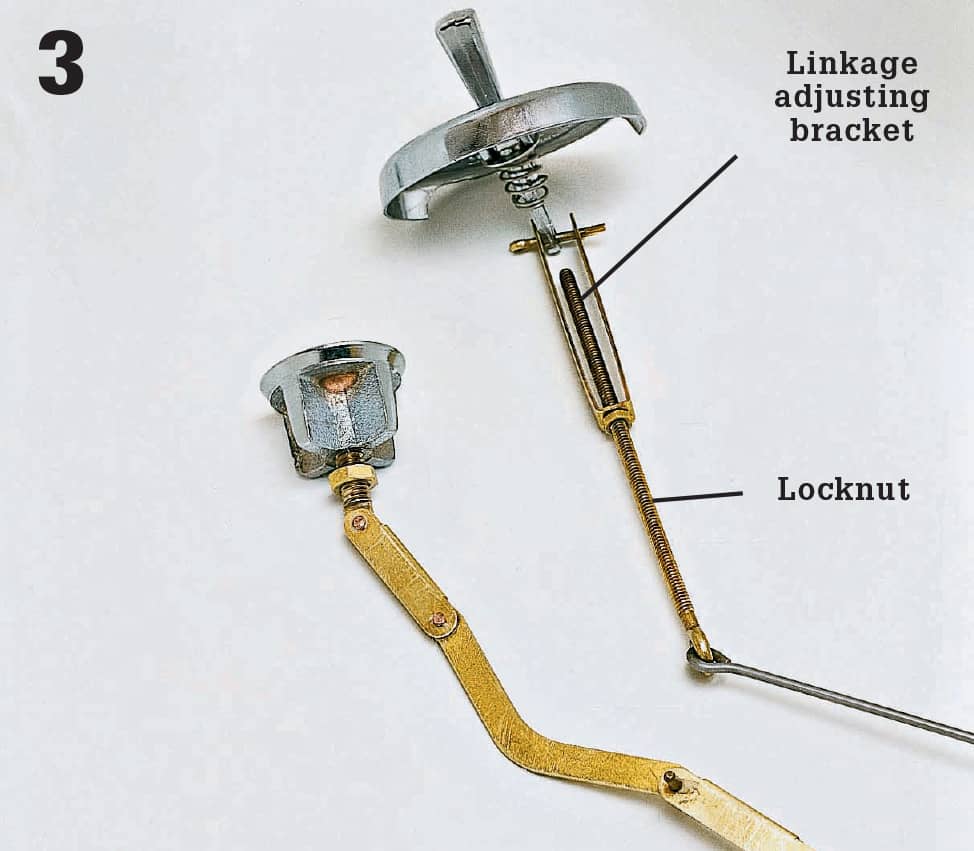
Adjust the pop-up stopper mechanism by first loosening the locknut on the lift rod. If the stopper doesn’t close all the way, shorten the linkage by screwing the rod 1/8" farther into the linkage-adjusting bracket. If the stopper doesn’t open wide enough, extend the linkage by unscrewing the rod 1/8". Tighten the locknut before replacing the mechanism and testing your adjustment.
 Unclogging Sink Drains
Unclogging Sink Drains
Every sink has a drain trap and a fixture drain line. Sink clogs usually are caused by a buildup of soap and hair in the trap or fixture drain line. Remove clogs by using a plunger, disconnecting and cleaning the trap (following page), or using a hand auger (page 373).
Many sinks hold water with a mechanical plug called a pop-up stopper. If the sink will not hold standing water, or if water in the sink drains too slowly, the pop-up stopper must be cleaned and adjusted.
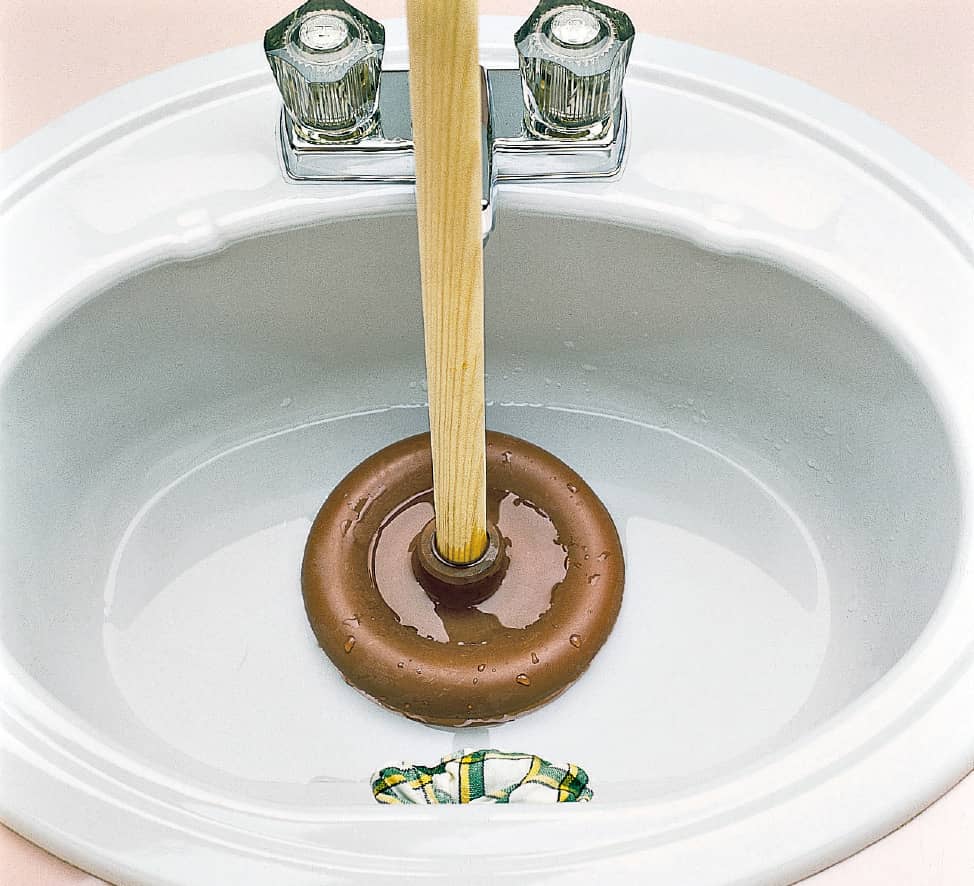
Clogged lavatory sinks can be cleared with a plunger (not to be confused with a flanged force-cup). Remove the pop-up drain plug and strainer first, and plug the overflow hole by stuffing a wet rag into it, allowing you to create air pressure with the plunger.
How to Clear a Sink Trap
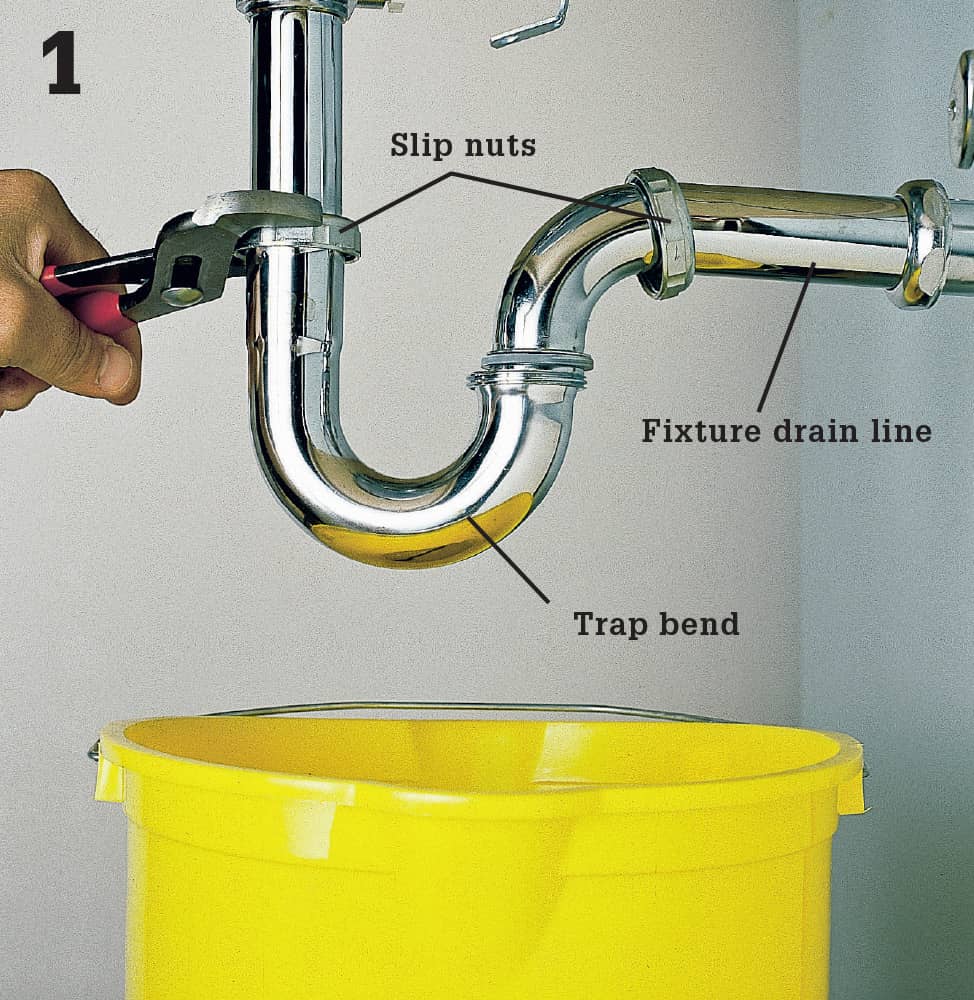
Place bucket under trap to catch water and debris. Loosen slip nuts on trap bend with channel-type pliers. Unscrew nuts by hand and slide away from connections. Pull off trap bend.
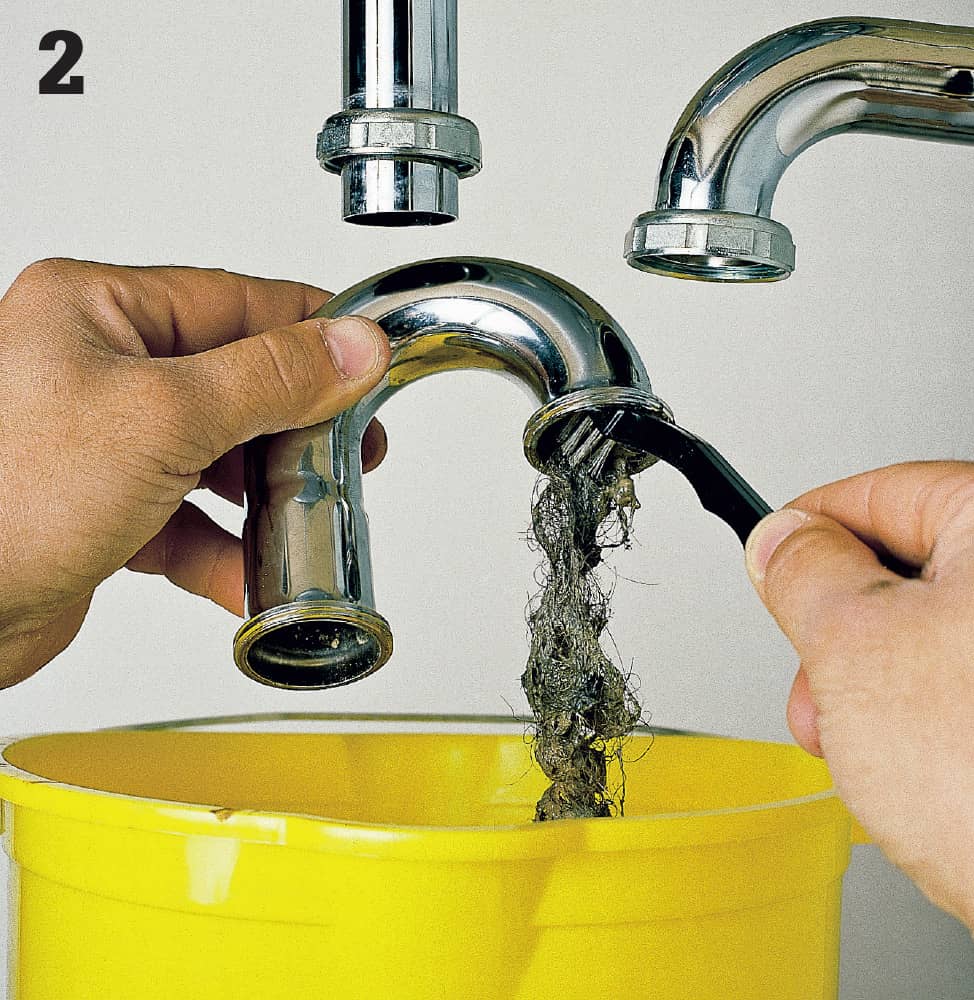
Dump out debris. Clean trap bend with a small wire brush. Inspect slip nut washers for wear and replace if necessary. Reinstall trap bend and tighten slip nuts.
How to Clear a Kitchen Sink
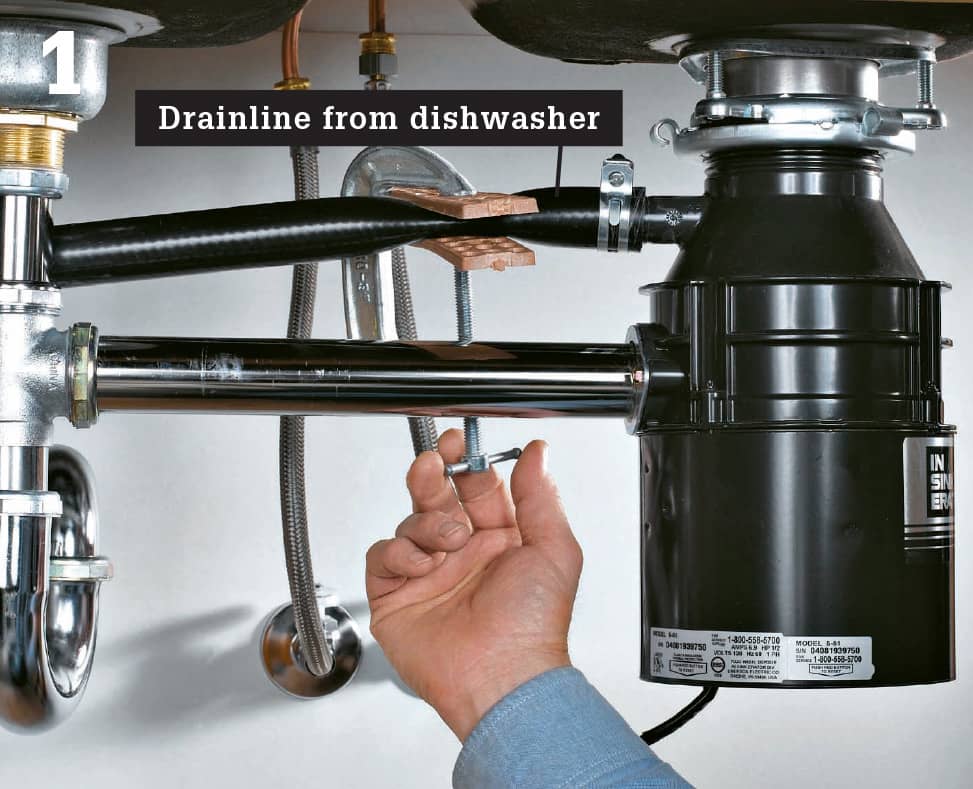
Plunging a kitchen sink is not difficult, but you need to create an uninterrupted pressure lock between the plunger and the clog. If you have a dishwasher, the drain tube needs to be clamped shut and sealed off at the disposer or drainline. The pads on the clamp should be large enough to flatten the tube across its full diameter (or you can clamp the tube ends between small boards).
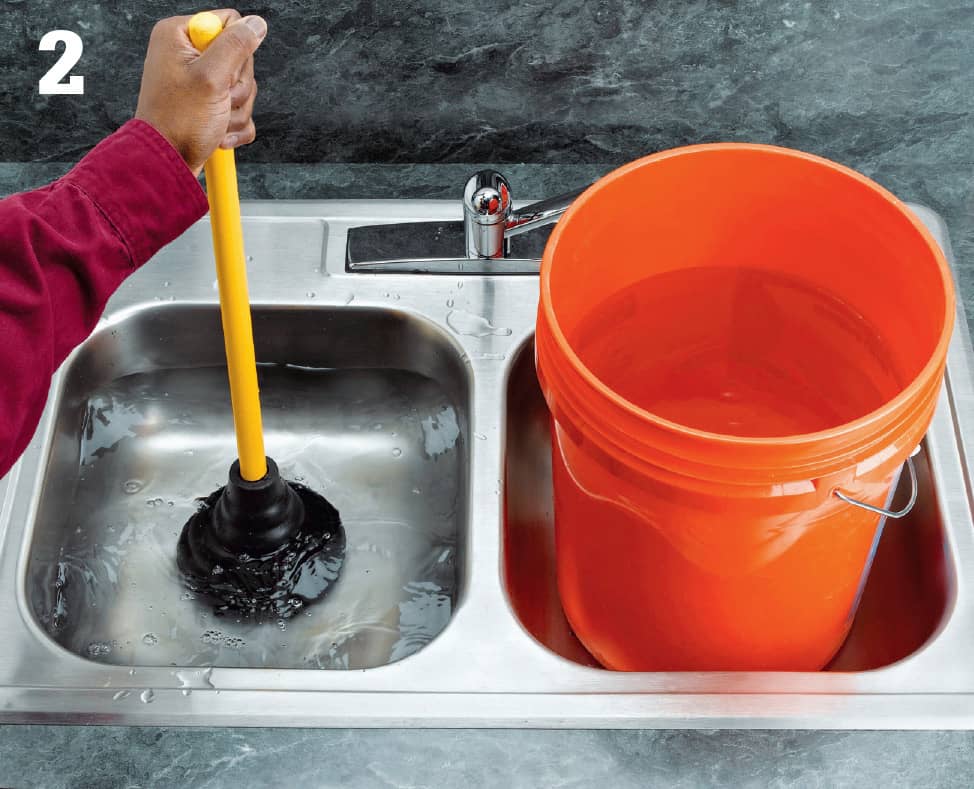
If there is a second basin, have a helper hold a basket strainer plug in its drain or put a large pot or bucket full of water on top of it. Unfold the skirt within the plunger and place this in the drain of the sink you are plunging. There should be enough water in the sink to cover the plunger head. Plunge rhythmically for six repetitions with increasing vigor, pulling up hard on the last repitition. Repeat this sequence until the clog is removed. Flush out a cleared clog with plenty of hot water.
How to Use a Hand Auger at the Trap Arm
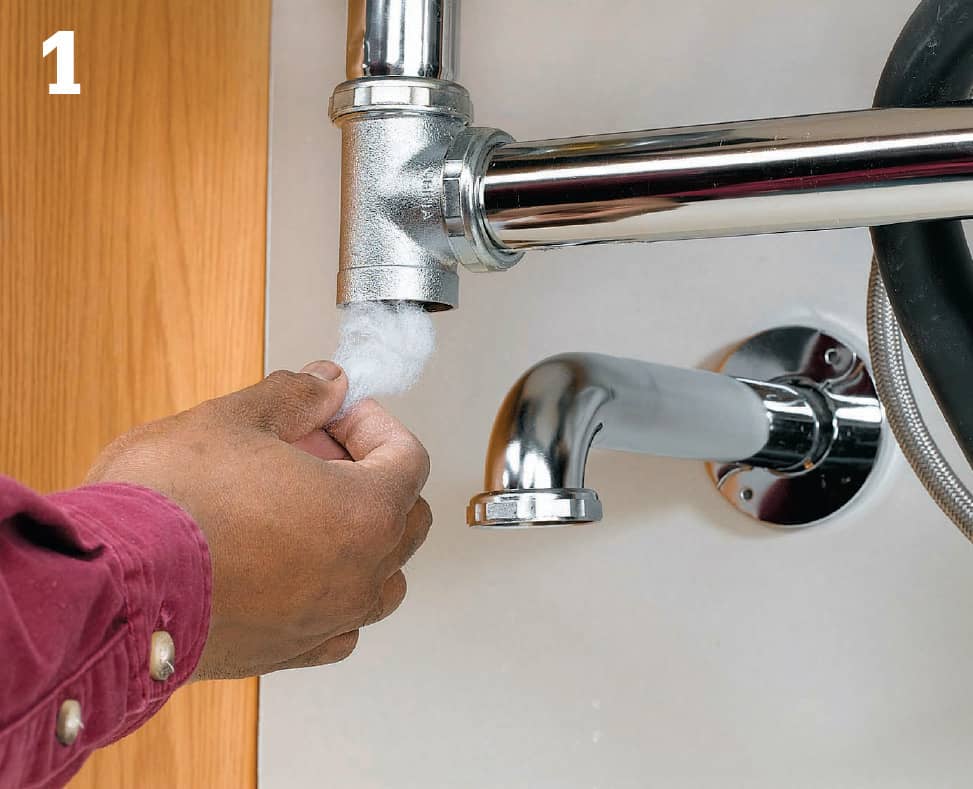
If plunging doesn’t work, remove the trap and clean it out (see previous page). With the trap off, see if water flows freely from both sinks (if you have two). Sometimes clogs will lodge in the tee fitting or one of the waste pipes feeding it. These may be pulled out manually or cleared with a bottlebrush or wire. When reassembling the trap, apply Teflon tape clockwise to the male threads of metal waste pieces. Tighten with your channel-type pliers. Plastic pieces need no tape and should be hand tightened only.
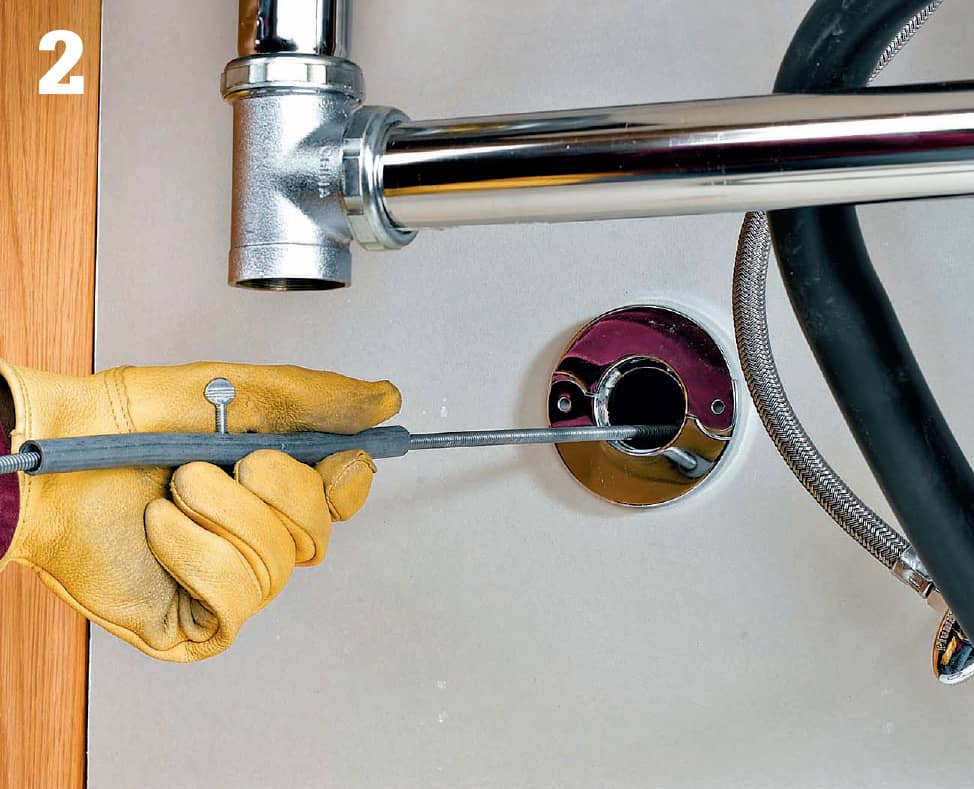
If you suspect the clog is downstream of the trap, remove the trap arm from the fitting at the wall. Look in the fixture drain with a flashlight. If you see water, that means the fixture drain is plugged. Clear it with a hand-crank or drill-powered auger (see page 380).
 Unclogging Branch & Main Drains
Unclogging Branch & Main Drains
If using a plunger or a hand auger does not clear a clog in a fixture drain line, it means that the blockage may be in a branch line, the main waste-vent stack, or the sewer service line.
First, use a hand-crank or drill-powered auger to clear the branch drain line closest to any stopped-up fixtures. Branch drain lines may be serviced through the cleanout fittings located at the end of the branch. Because waste water may be backed up in the drain lines, always open a cleanout with caution. Place a bucket and rags under the opening to catch waste water. Never position yourself directly under a cleanout opening while unscrewing the plug or cover.
If using an auger on the branch line does not solve the problem, then the clog may be located in a main drainage stack. To clear the stack, run an auger cable down through the roof vent. Make sure that the cable of your auger is long enough to reach down the entire length of the stack. If it is not, you may want to rent or borrow another auger. Always use extreme caution when working on a ladder or on a roof.
If no clog is present in the main stack, the problem may be in the sewer service line. Locate the main cleanout, usually a wye-shaped fitting at the bottom of the main stack. Remove the plug and push the cable of a hand auger into the opening.
Some sewer service lines in older homes have a house trap. The house trap is a U-shaped fitting located at the point where the sewer line exits the house. Most of the fitting will be beneath the floor surface, but it can be identified by its two openings. Use a hand auger to clean a house trap.
If the auger meets solid resistance in the sewer line, retrieve the cable and inspect the bit. Fine, hair-like roots on the bit indicate the line is clogged with tree roots. Dirt on the bit indicates a collapsed line.
Use a power auger to clear sewer service lines that are clogged with tree roots. Power augers (page 380) are available at rental centers. However, a power auger is a large, heavy piece of equipment. Before renting, consider the cost of rental and the level of your do-it-yourself skills versus the price of a professional sewer cleaning service. If you rent a power auger, ask the rental dealer for complete instructions.
Always consult a professional sewer cleaning service if you suspect a collapsed line.

Clear a branch drain line by locating the cleanout fitting at the end of the line. Place a bucket underneath the opening to catch waste water, then slowly unscrew the cleanout plug with an adjustable wrench. Clear clogs in the branch drain line with a hand auger.
How to Clear a Branch Drain Line
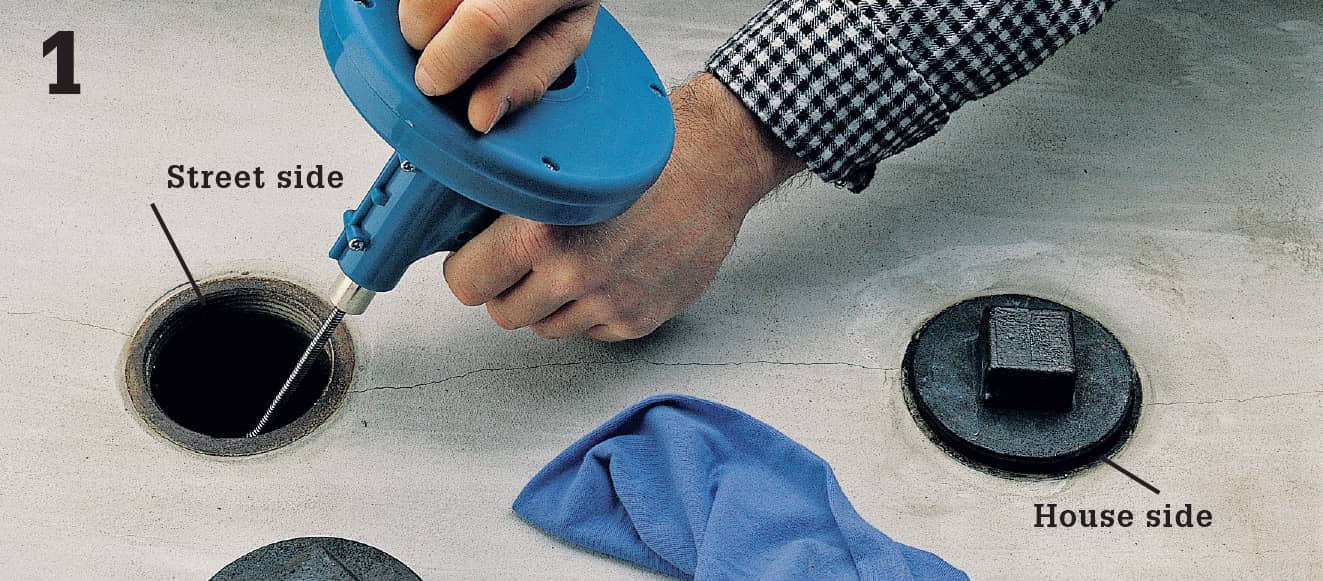
Clear the house trap in a sewer service line using a hand auger. Slowly remove only the plug on the “street side” of the trap. If water seeps out the opening as the plug is removed, the clog is in the sewer line beyond the trap. If no water seeps out, auger the trap. If no clog is present in the trap, replace the street-side plug and remove the house-side plug. Use the auger to clear clogs located between the house trap and main stack.
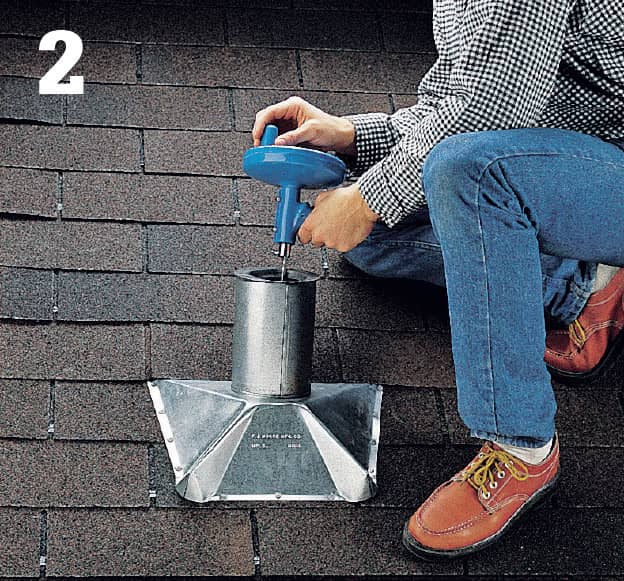
If all else fails, you can try to clear the main drainage stack by running the cable of a hand-crank or drill-powered auger down through the roof vent. Always use extreme caution while working on a ladder or roof.
How to Replace a Main Drain Cleanout Plug
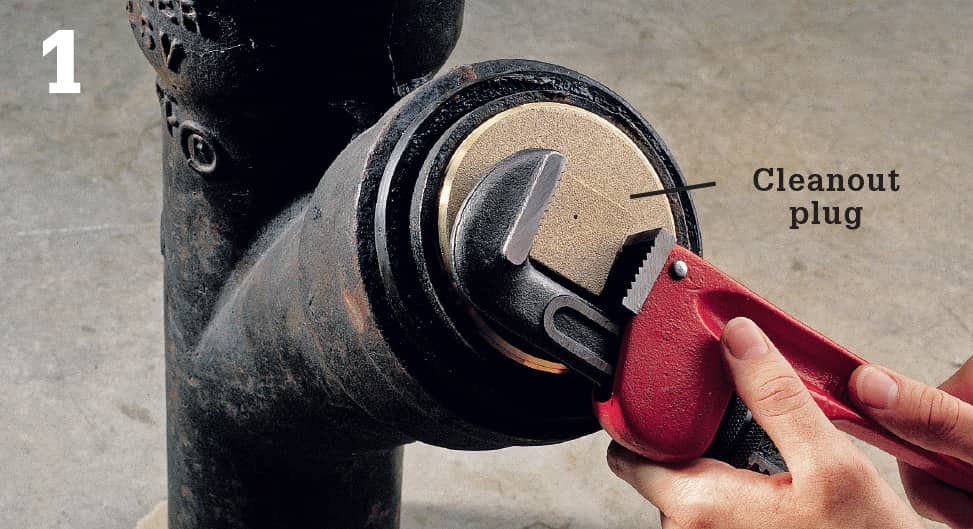
Remove the cleanout plug, using a large wrench. If the plug does not turn out, apply penetrating oil around the edge of the plug, wait 10 minutes, and try again. Place rags and a bucket under fitting opening to catch any water that may be backed up in the line.
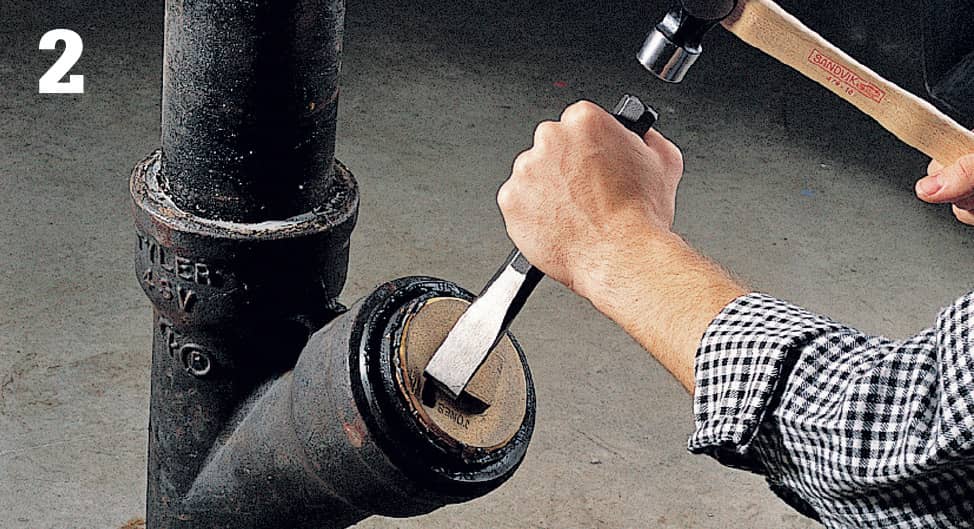
Remove stubborn plugs by placing the cutting edge of a cold chisel on the edge of the plug. Strike the chisel with a ball-peen hammer to move plug counterclockwise. If the plug does not turn out, break it into pieces with the chisel and hammer. Remove all broken pieces.
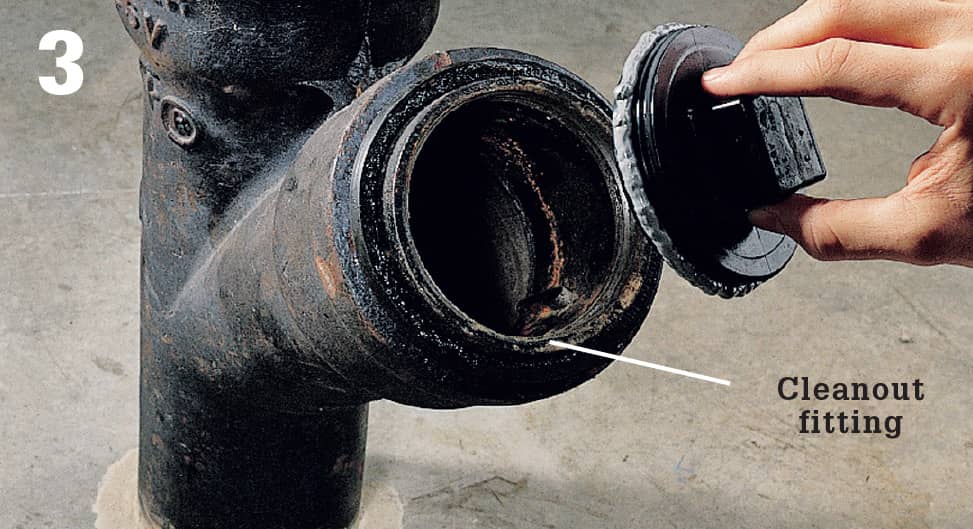
Replace the old plug with a new plug. Apply pipe joint compound to the threads of the replacement plug and screw into the cleanout fitting.
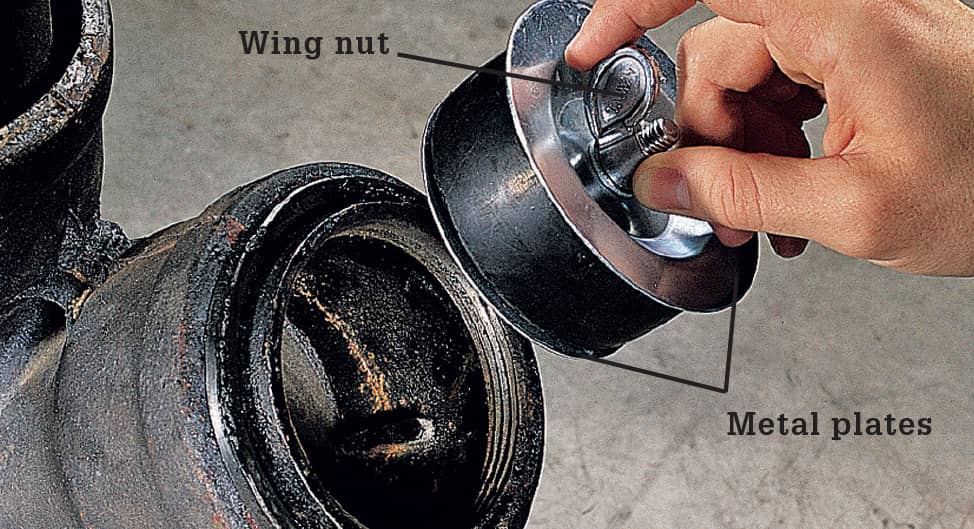
ALTERNATE: Replace the old plug with an expandable rubber plug. A wing nut squeezes the rubber core between two metal plates. The rubber bulges slightly to create a watertight seal.
How to Power-Auger a Floor Drain
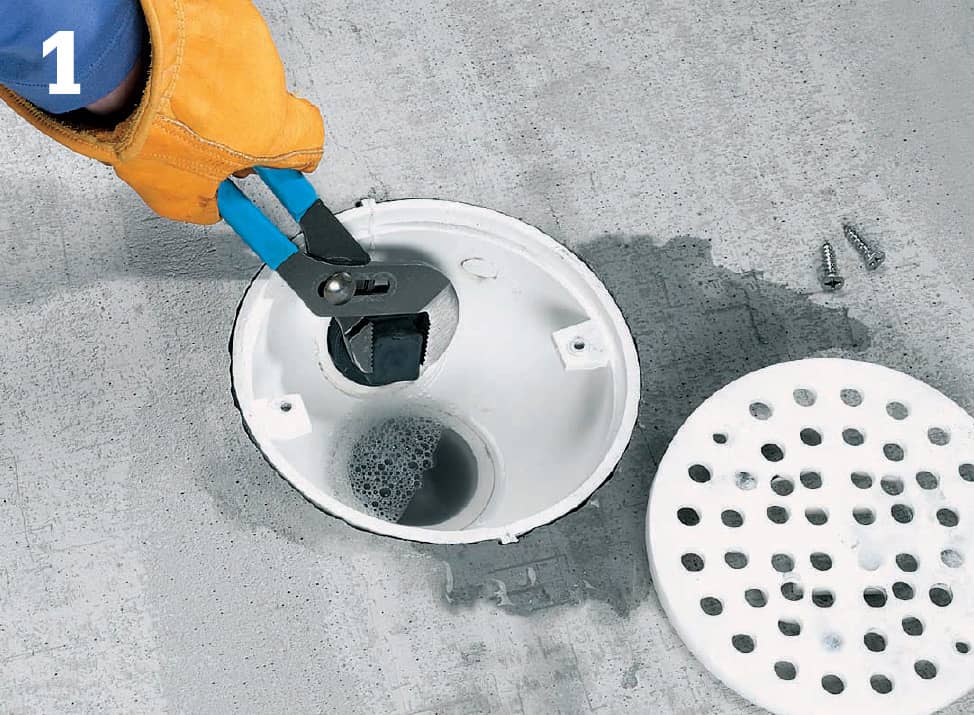
Remove the cover from the floor drain using a slotted or Phillips screwdriver. On one wall of the drain bowl you’ll see a cleanout plug. Remove the cleanout plug from the drain bowl with your largest channel-type pliers. This cleanout allows you to bypass the trap. If it’s stuck, apply penetrating oil to the threads and let it sit a half an hour before trying to free it again. If the wrench won’t free it, rent a large pipe wrench from your home center or hardware store. You can also auger through the trap if you have to.
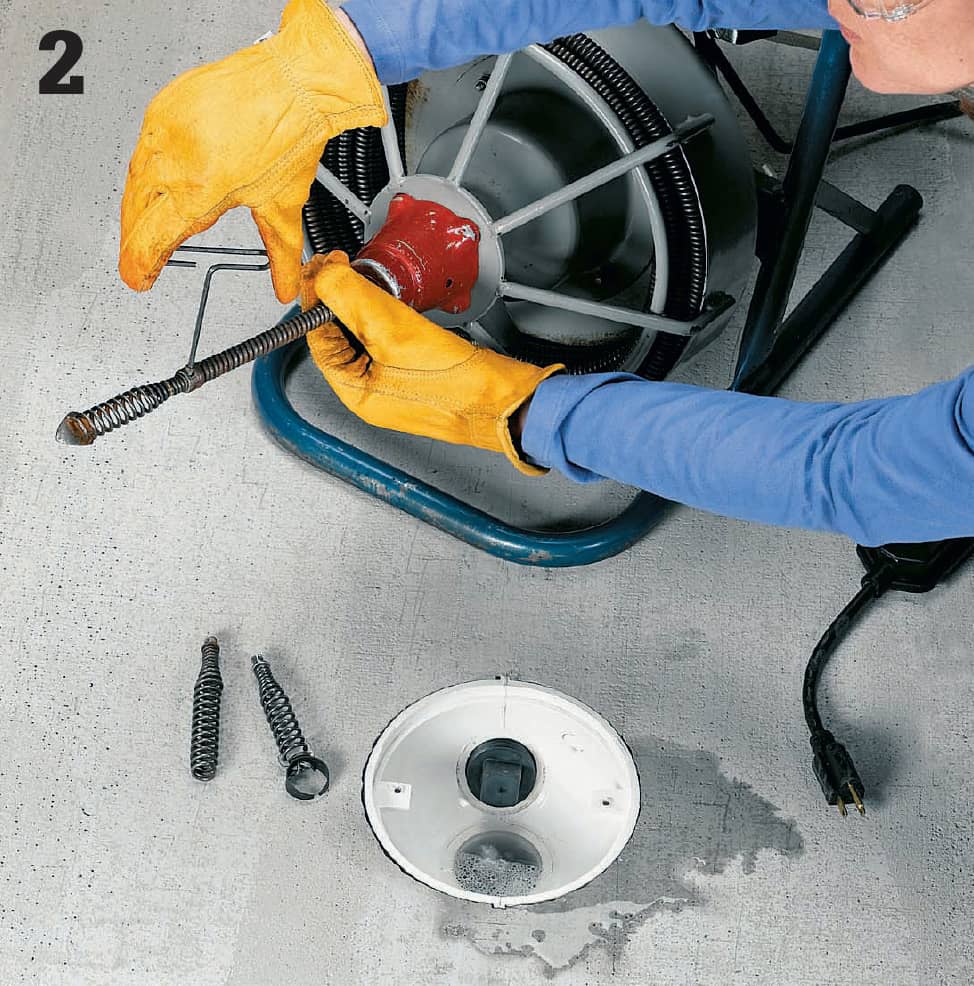
Rent an electric drum auger with at least 50 ft. of 1/2" cable. The rental company should provide a properly sized, grounded extension cord, heavy leather gloves, and eye protection. The auger should come with a spear tool, cutter tool, and possibly a spring tool suitable for a 2" drainline. Attach the spearhead first (with the machine unplugged).
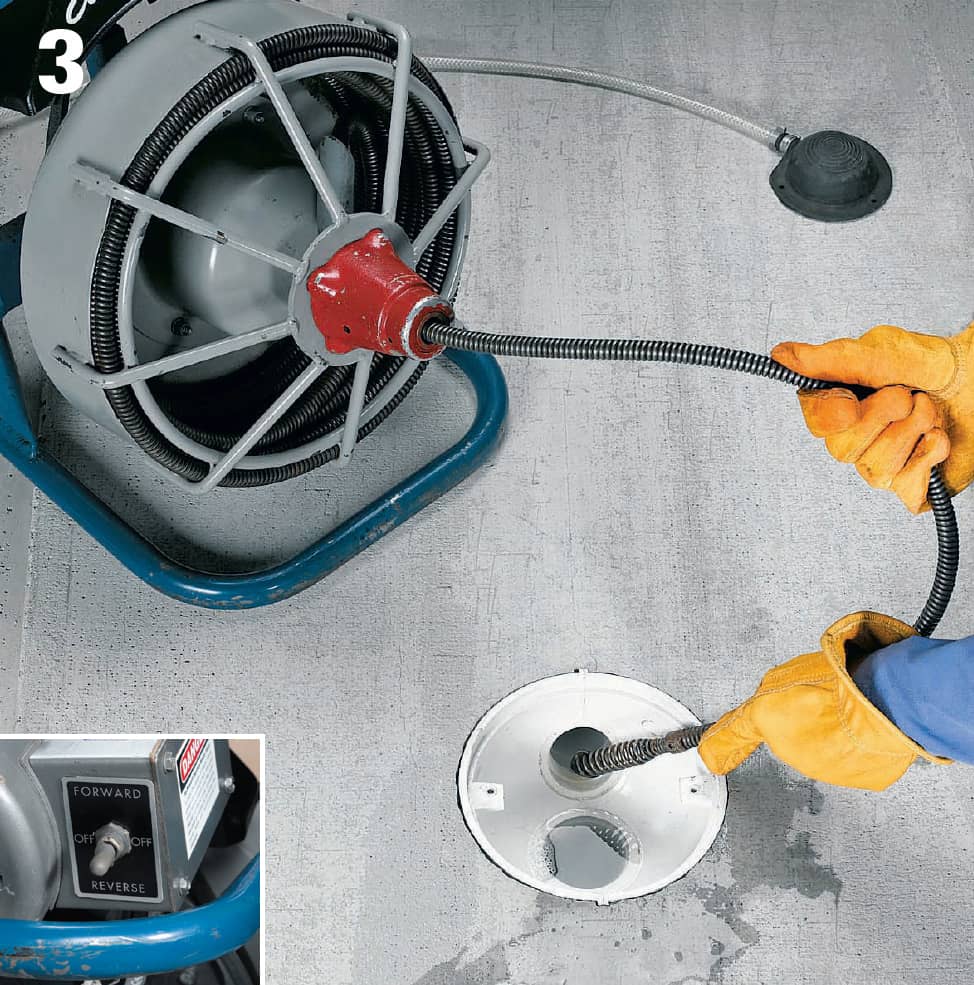
Wear close-fitting clothing and contain long hair. Place the power auger machine in a dry location within 3 ft. of the drain opening. Plug the tool into a grounded, GFI-protected circuit. Wear eye protection and gloves. Position the footswitch where it is easy to actuate. Make sure the FOR/REV switch is in the Forward position (inset photo). Hand feed the cleaning tool and some cable into the drain or cleanout before turning the machine on.
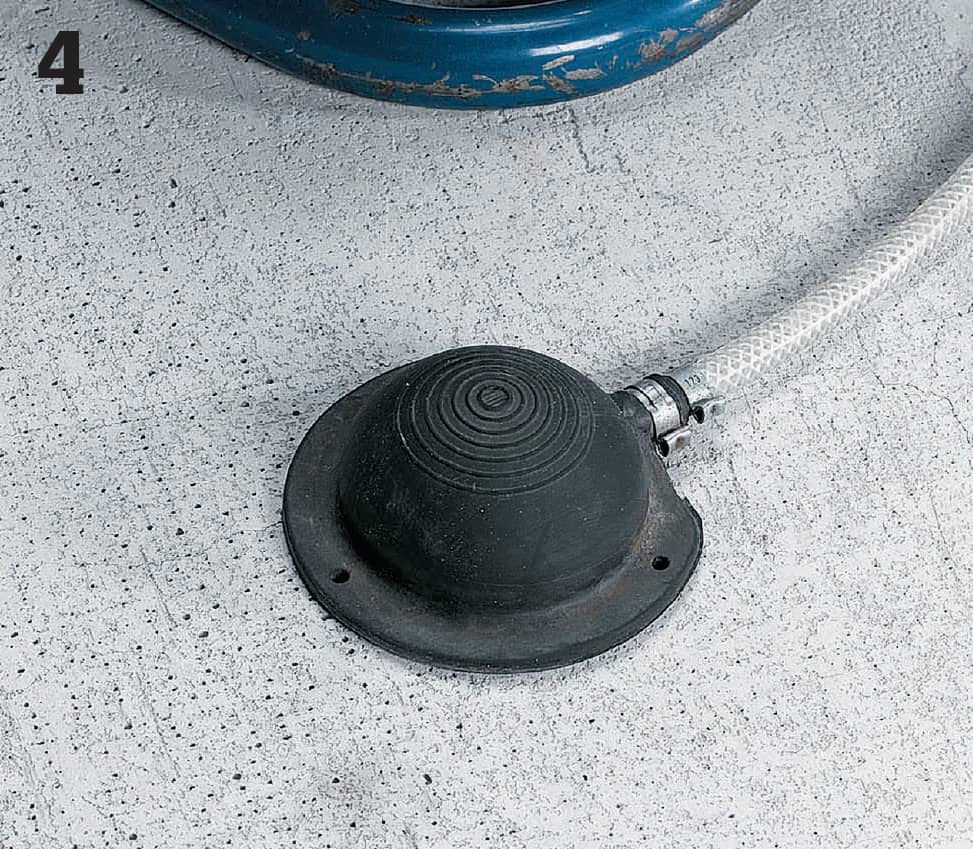
Stationary power augers (as opposed to pistol-grip types) are controlled by a foot pedal called an actuator so you can turn the power on and off hands-free.
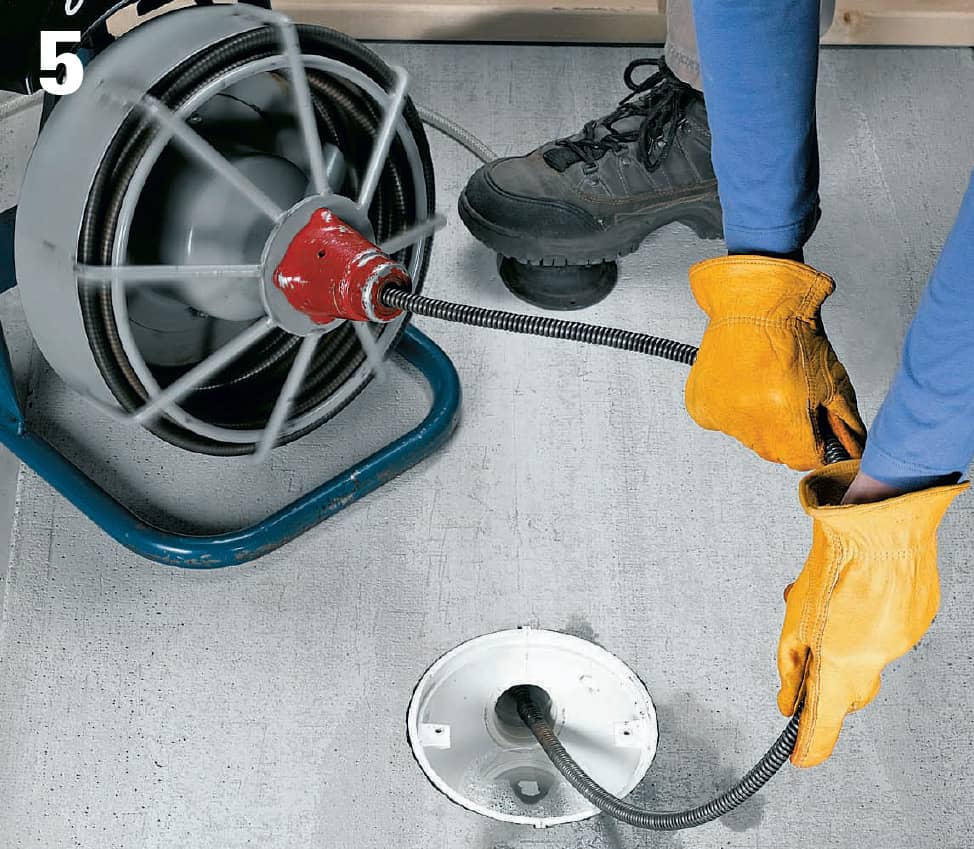
With both gloved hands on the cable, depress the foot actuator to start the machine. Gradually push the rotating cable into the drain opening. If the rotation slows or you cannot feed more cable into the drain, pull back on the cable before pushing it forward again. Don’t force it. The cable needs to be rotating whenever the motor is running or it can kink and buckle. If the cleaning tool becomes stuck, reverse it, back the tool off the obstruction, and switch back to Forward.
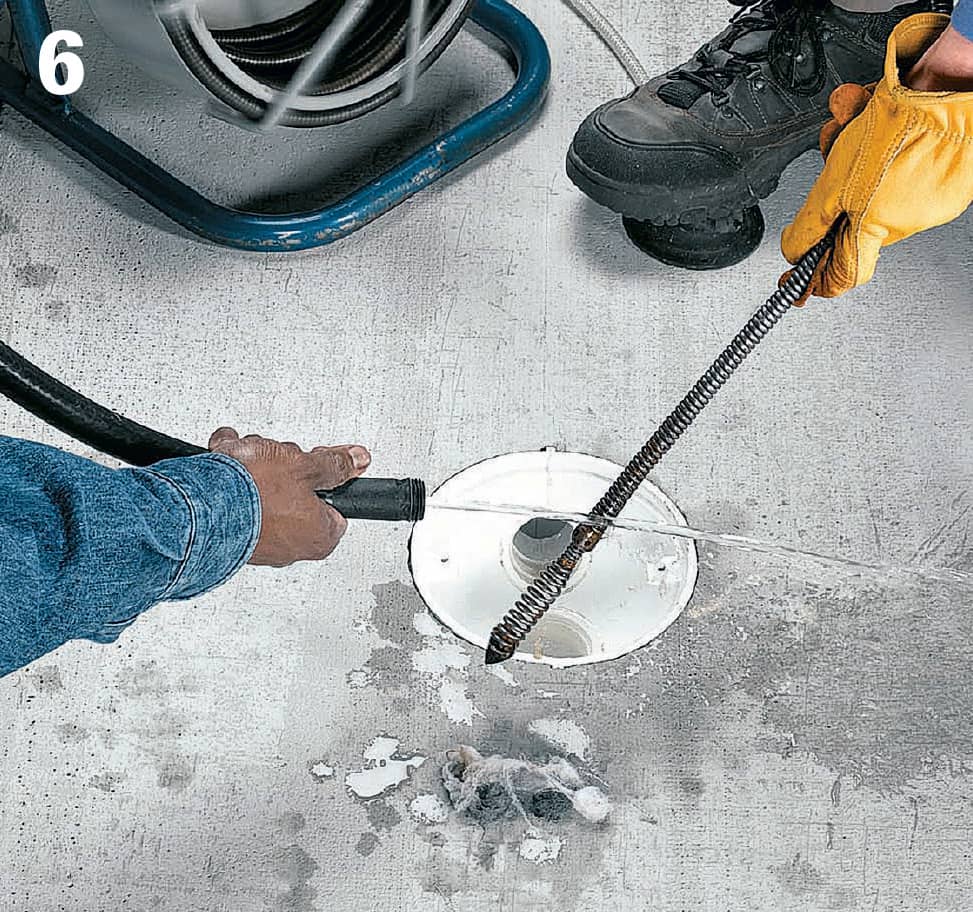
Gradually work through the clog by pulling back on the cable whenever the machine starts to bog down and push it forward again when it gains new momentum. Never let the cable stop turning when the motor is running. When you have broken through the clog or snagged an object, withdraw the cable from the line. Manually pull the cable from the drain line while continuing to run the drum Forward. When the cleaning tool is close to the drain opening, release the foot actuator and let the cable come to a stop before feeding the last 2 or 3 ft. of cable into the drum by hand.
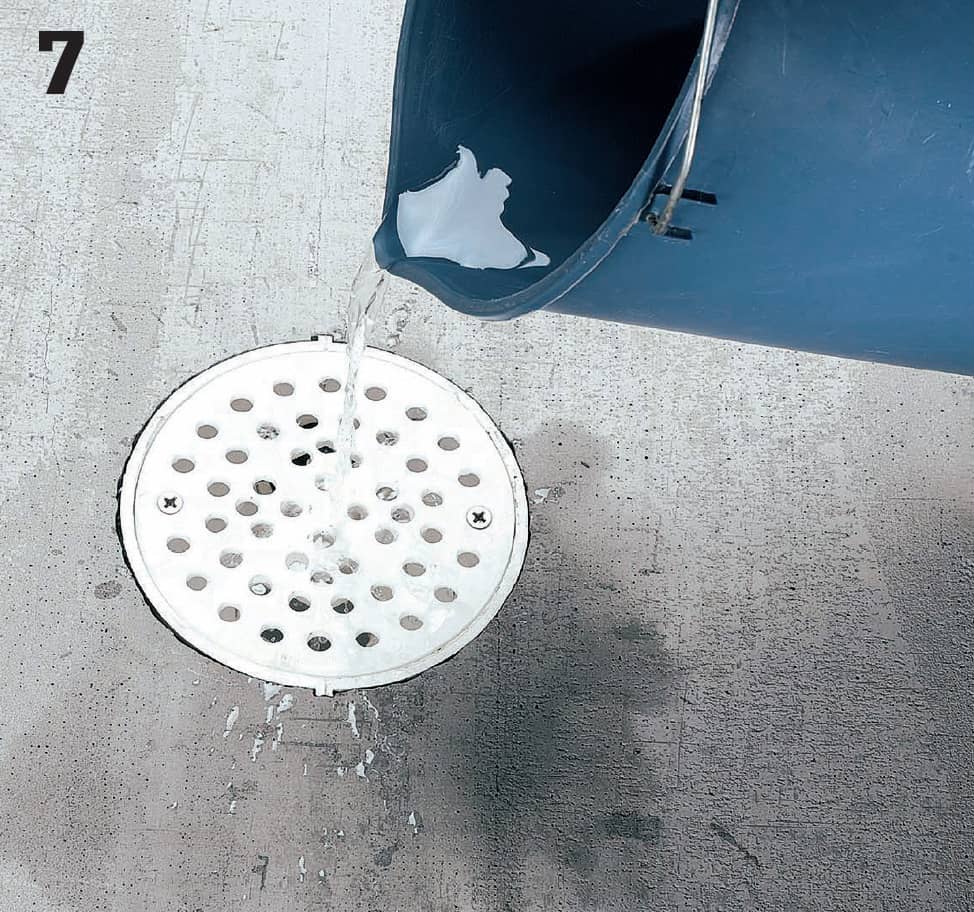
After clearing the drain pipe, run the auger through the trap. Finish cleaning the auger. Wrap Teflon tape clockwise onto the plug threads and replace the plug. Run hot water through a hose from the laundry sink or use a bucket to flush remaining debris through the trap and down the line.
 Tips for Replacing Supply Pipes
Tips for Replacing Supply Pipes
When replacing old water supply pipes, we recommend that you use Type M rigid copper or PEX. Use 3/4" pipe for the main distribution pipes and 1/2" pipes for the branch lines running to individual fixtures.
For convenience, run parallel hot and cold water pipes, between 3" and 6" apart. Use the straightest, most direct routes possible when planning the layout, because too many bends in the pipe runs can cause significant resistance and reduce water flow.
It is best to remove old pipes that are exposed, but pipes hidden in walls can be left in place unless they interfere with the new supply pipes.
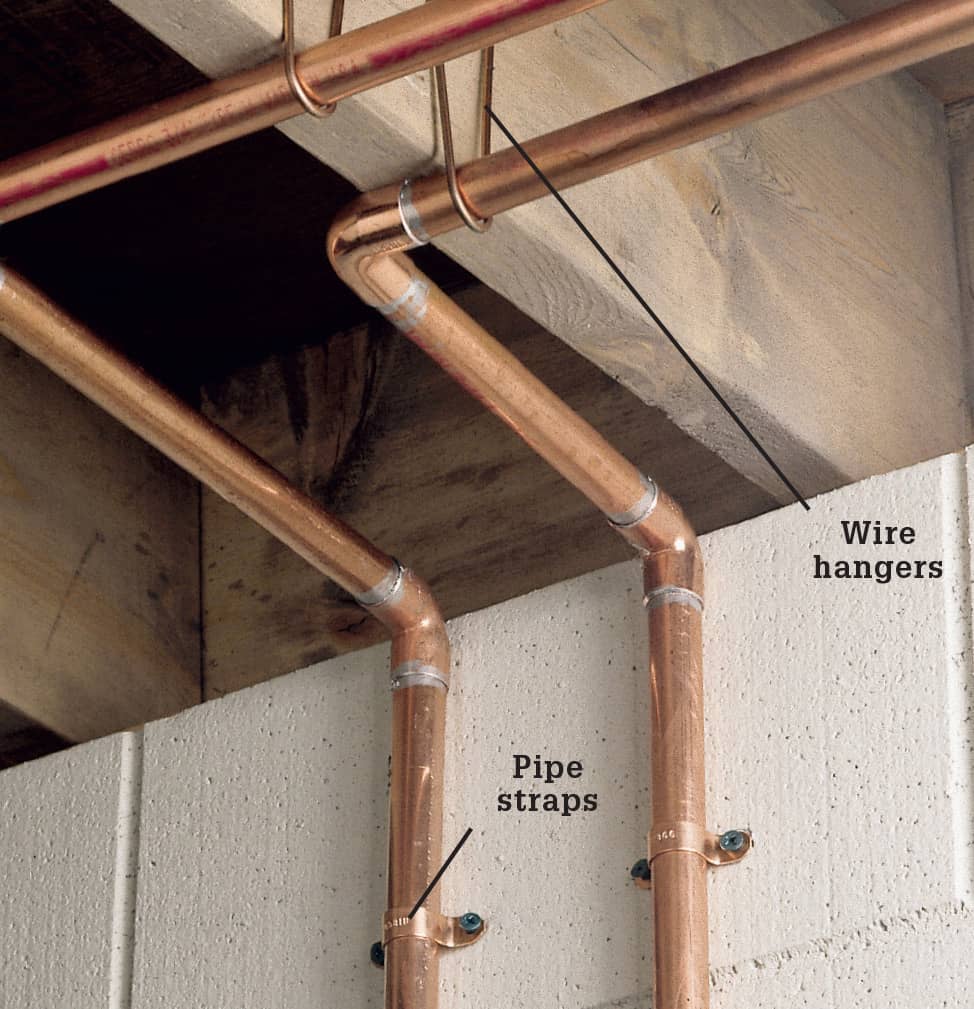
Support copper supply pipes at least every 10 ft. along vertical runs and 6 ft. along horizontal runs (check local codes). Always use copper or plastic support materials with copper; never use steel, which can interact with copper and cause corrosion.
How to Replace Water Supply Pipes
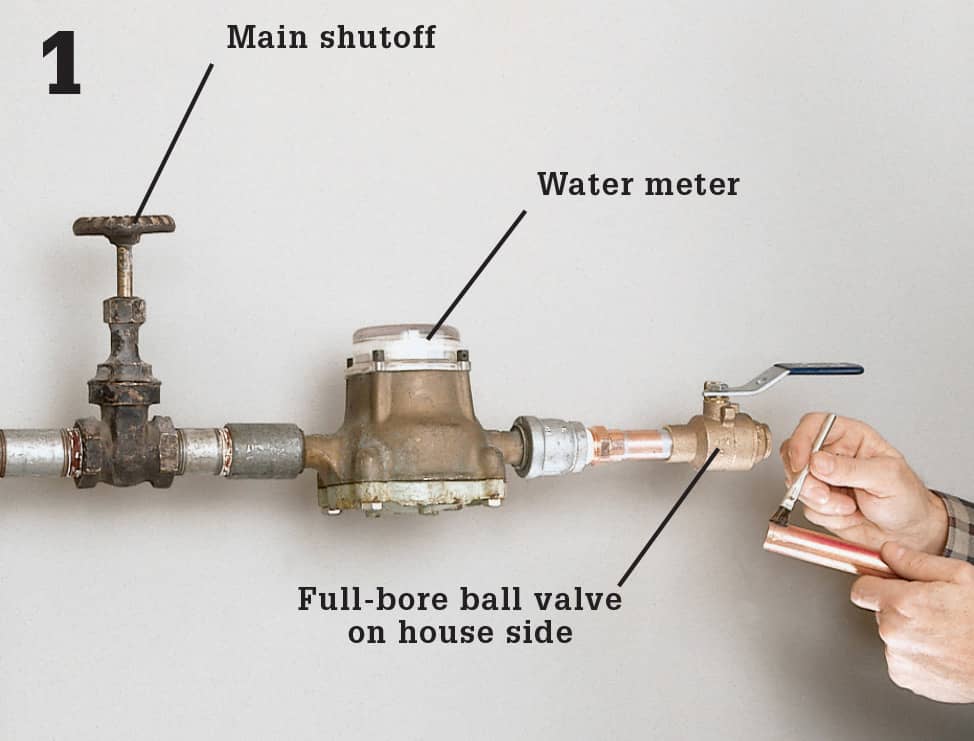
Shut off the water on the street side of the water meter, then disconnect and remove the old water pipes from the house side. Solder a 3/4" male-threaded adapter and full-bore control valve to a short length of 3/4" copper pipe, then attach this assembly to the house side of the water meter. Extend the 3/4" cold-water distribution pipe toward the nearest fixture, which is usually the water heater.
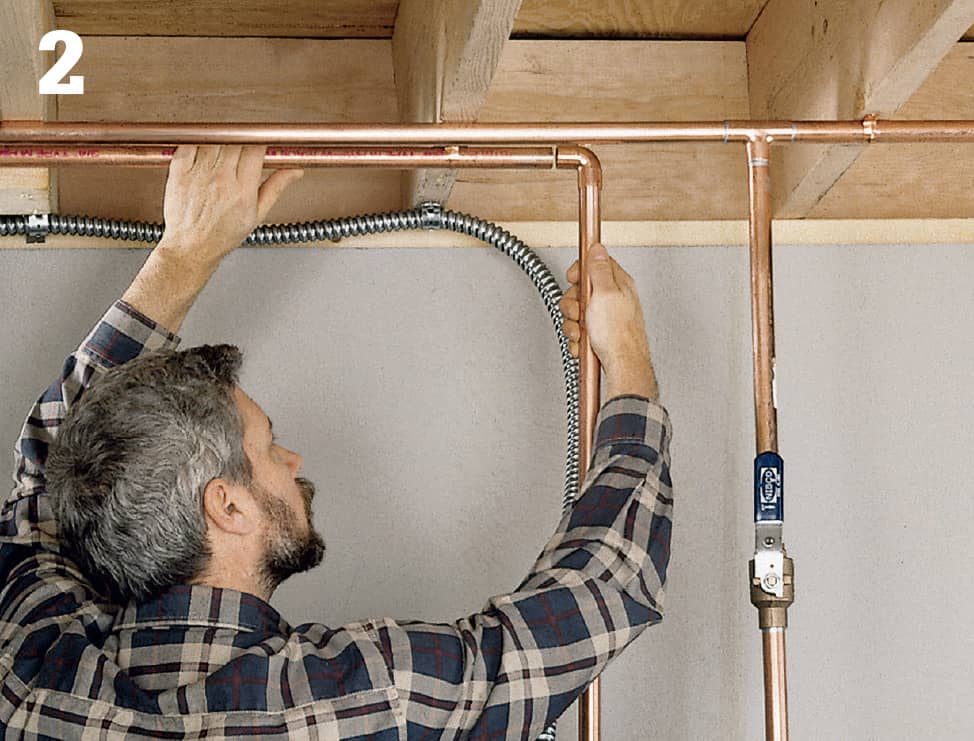
At the water heater, install a 3/4" tee fitting in the cold-water distribution pipe. Use two lengths of 3/4" copper pipe and a full-bore control valve to run a branch pipe to the water heater. From the outlet opening on the water heater, extend a 3/4" hot water distribution pipe. Continue the hot and cold supply lines on parallel routes toward the next group of fixtures in your house.
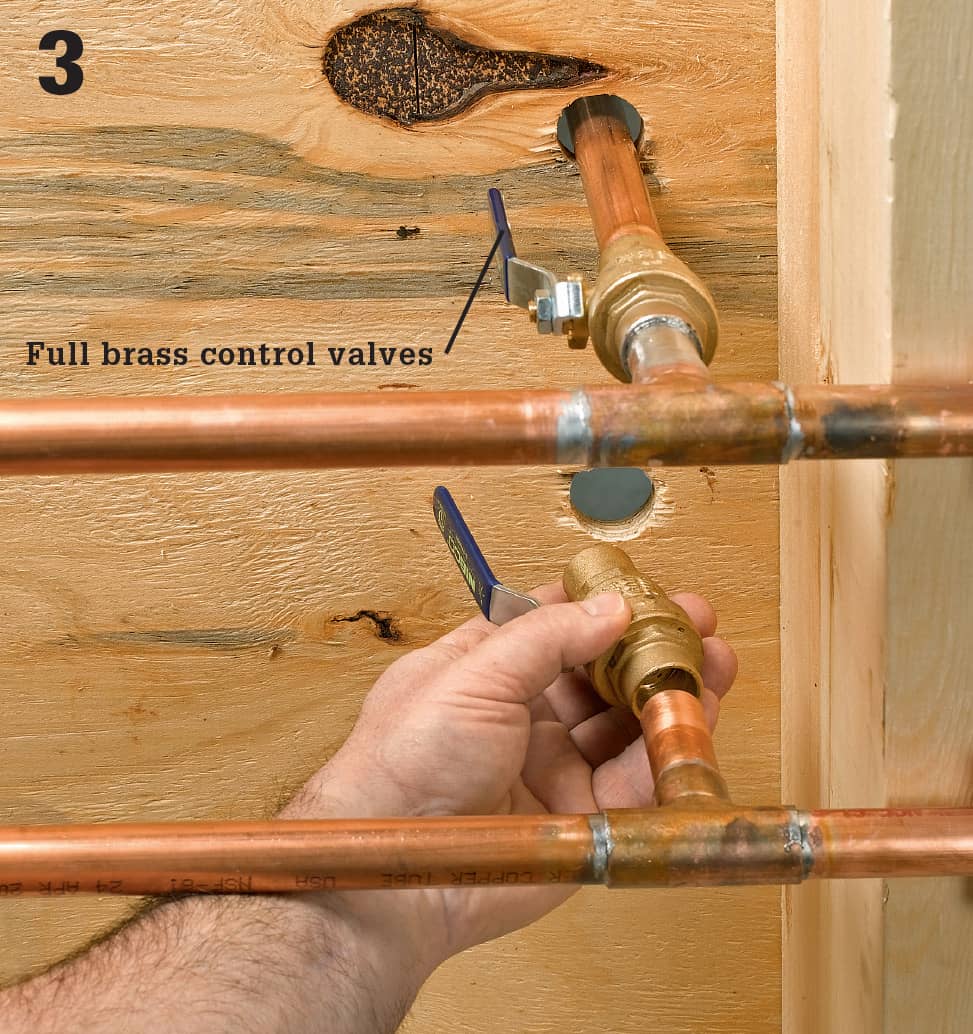
Establish routes for branch supply lines by drilling holes located in stud cavities. Install tee fittings, then begin the branch lines by installing brass control valves. Branch lines should be made with 3/4" pipe if they are supplying more than one fixture; 1/2" if they are supplying only one fixture.
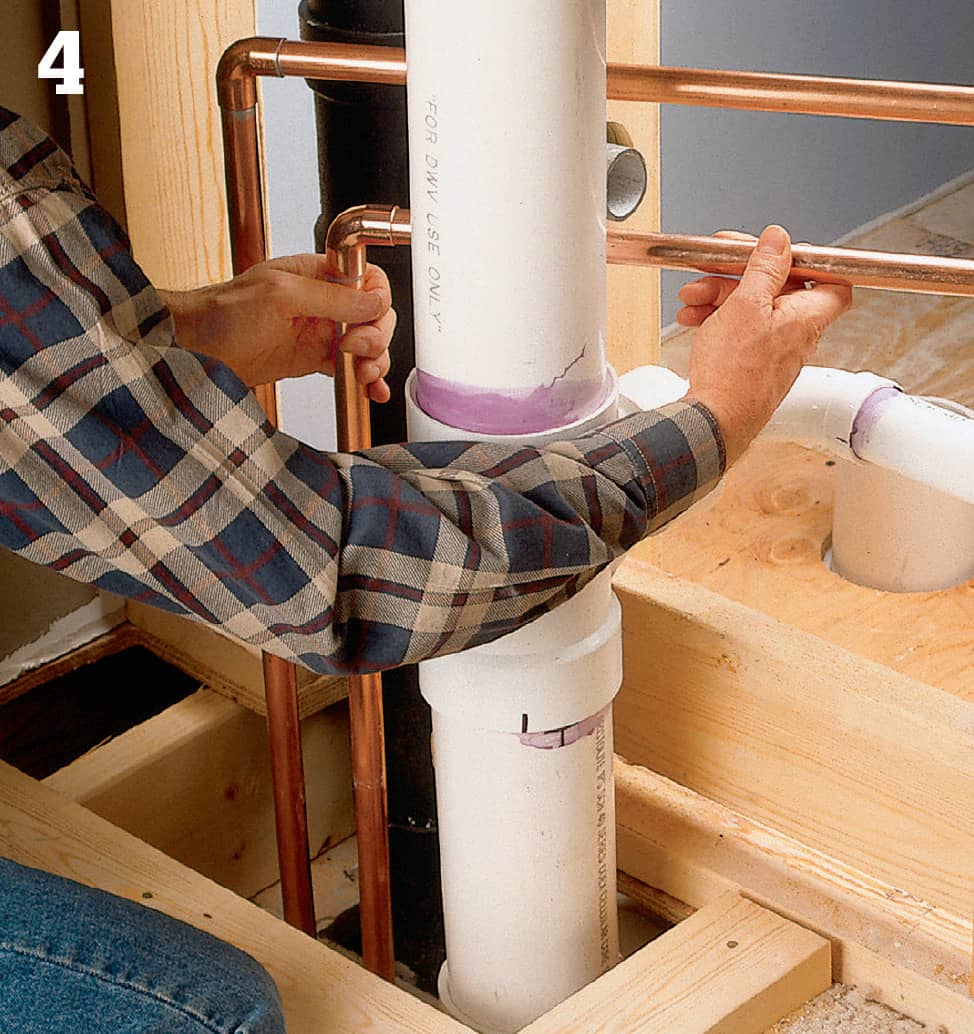
Extend the branch lines to the fixtures. In our project, we ran 3/4" vertical branch lines up through the framed chase to the bathroom. Route pipes around obstacles, such as a main waste-vent stack, by using 45° and 90° elbows and short lengths of pipe.
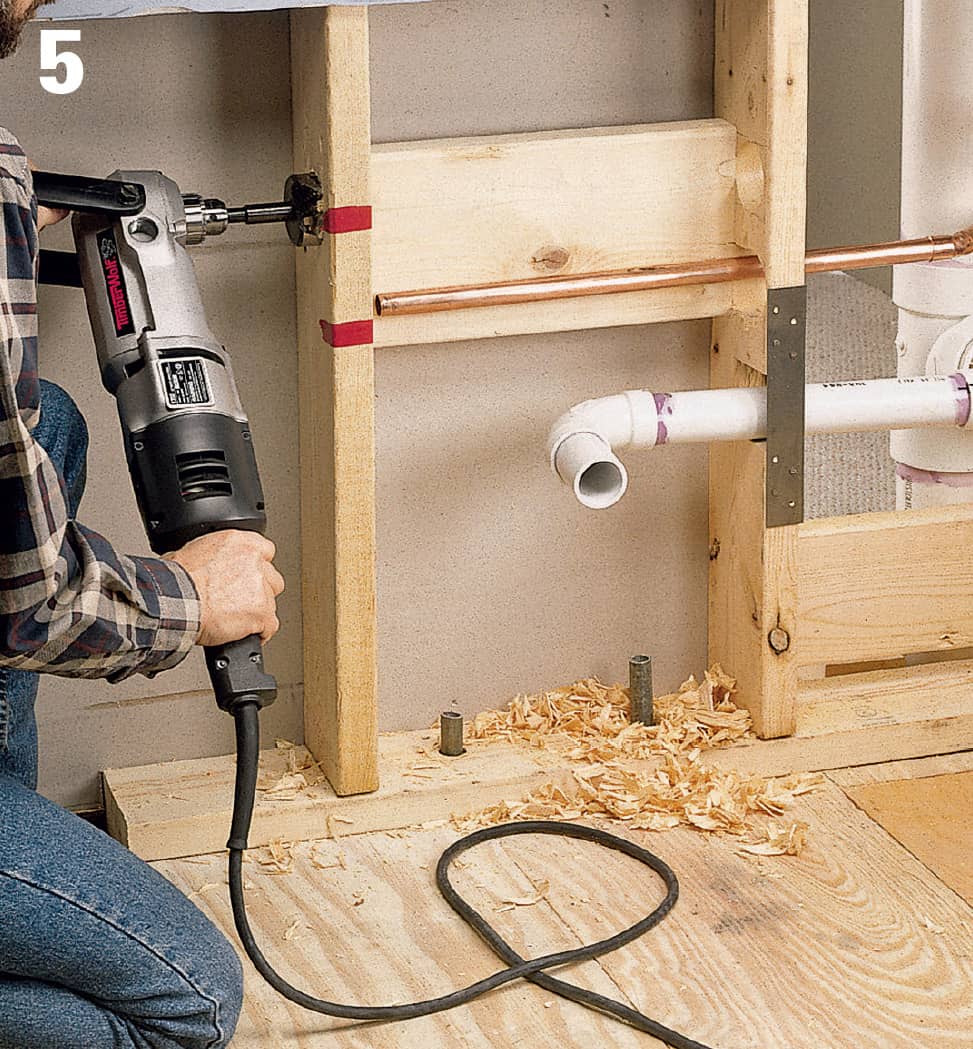
Where branch lines run through studs or floor joists, drill holes or cut notches in the framing members, then insert the pipes. For long runs of pipe, you may need to join two or more shorter lengths of pipe, using couplings as you create the runs.
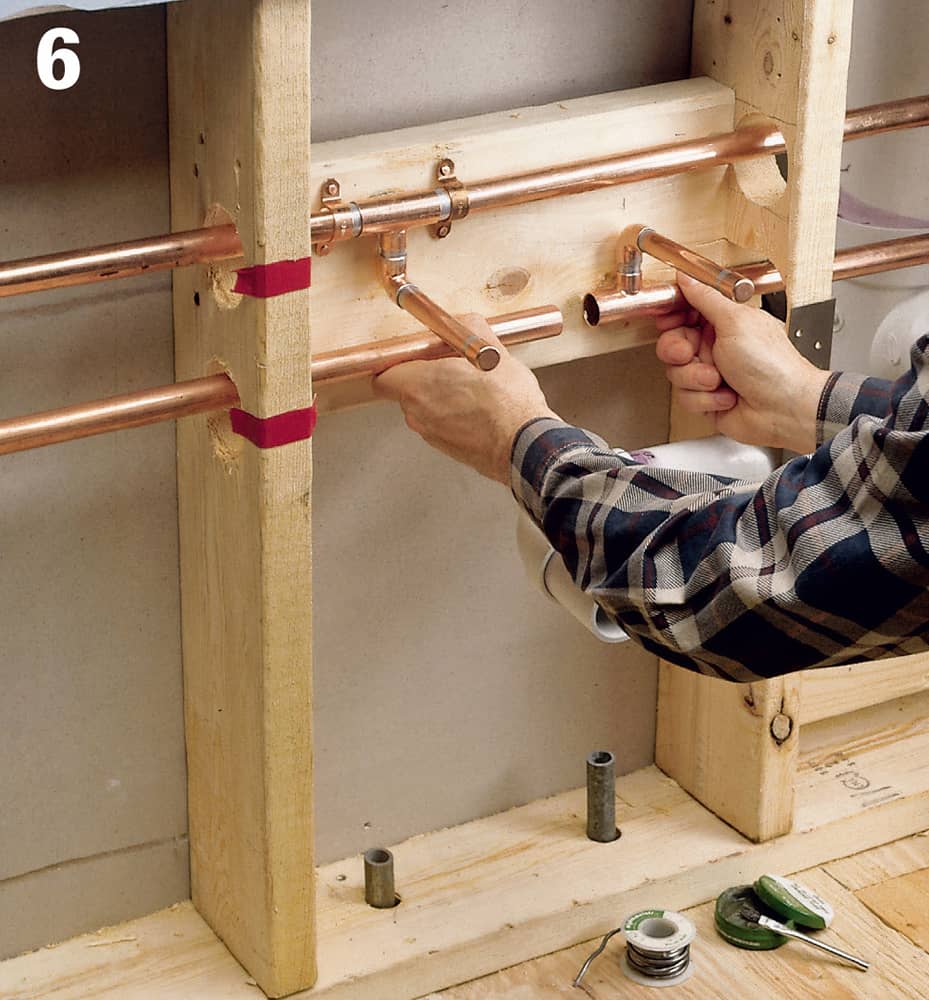
Install 3/4" to 1/2" reducing tee fittings and elbows to extend the branch lines to individual fixtures. In our bathroom, we installed a hot and cold stubout for the bathtub and sink, and a cold-water stubout for the toilet. Cap each stubout until your work has been inspected and the wall surfaces have been completed.
 Quieting Noisy Pipes
Quieting Noisy Pipes
Pipes can make a loud banging noise when faucets are turned off or when valves on washing machines (or other automatic appliances) shut abruptly. The sudden stop of flowing water traps air and creates a shock wave, called water hammer, that slams through the water supply system. Some pipes may knock against wall studs or joists, creating additional noise.
Water hammer can be more than an annoyance. The shockwave can cause damage and eventually failure in pipes and fittings. If a pressure-relief valve on your water heater leaks, it may not be a faulty valve, but a pressure surge in the supply system.
You can eliminate water hammer by installing a simple device called a water hammer arrester in the supply line. Inexpensive point-of-use arresters are small enough to be installed easily near the noisy valve or appliance (the closer the better). They can be positioned horizontally or vertically or at an angle without any change in effectiveness. Unlike with old-style air chambers, water cannot fill a water hammer arrester, so they should be effective for the life of the system.
Pipes that bang against studs or joists can be quieted by cushioning them with pieces of pipe insulation. Make sure pipe hangers are snug and that pipes are well supported.
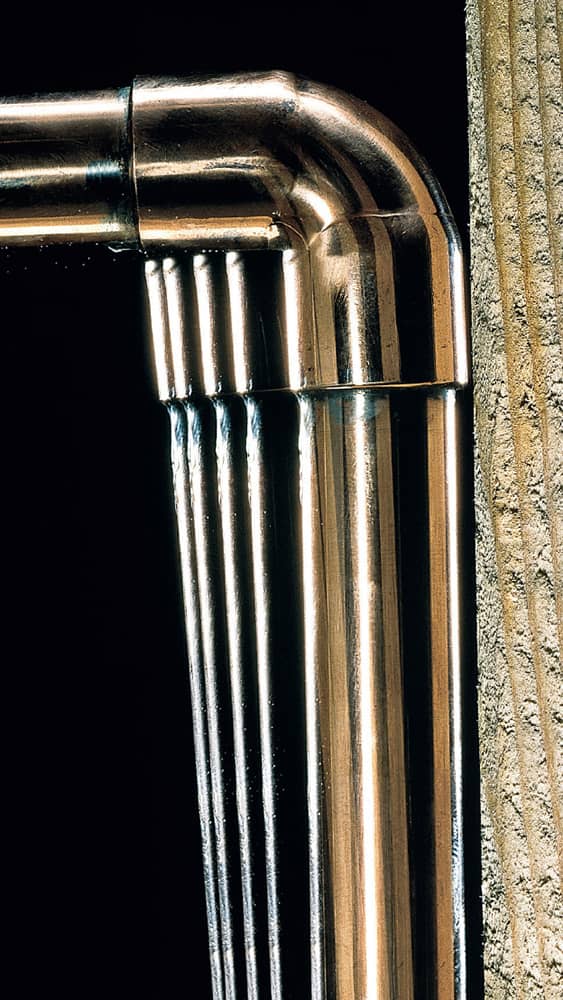
Clattering pipes can be a major annoyance, but they also should alert you of a problem with the supply system.
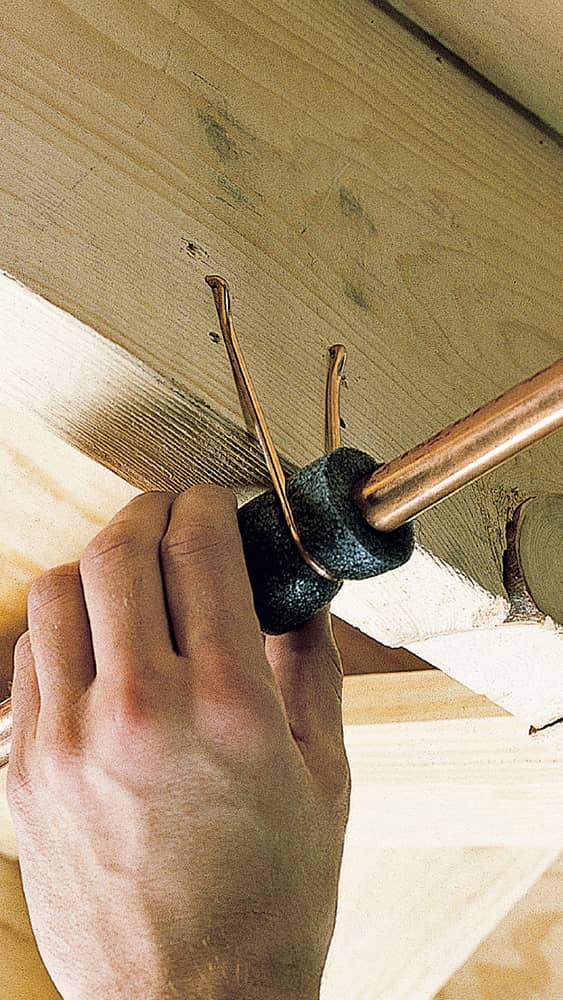
Loose pipes may bang or rub against joist hangers, creating noise. Use pieces of foam rubber pipe insulation to cushion pipes.
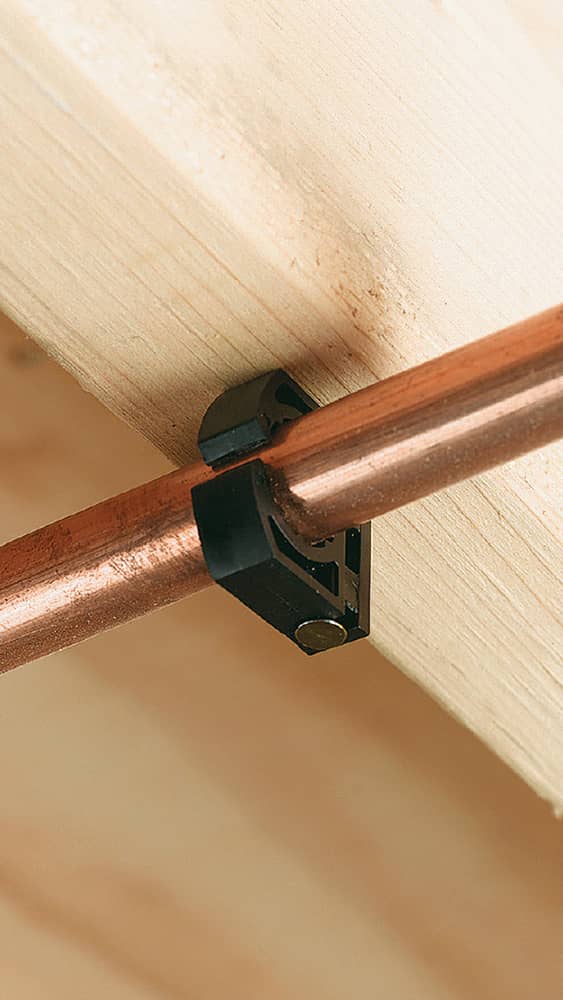
A “Sioux strap” holds pipe away from a framing member. Just snap the strap on and drive a nail.
How to Install a Water Hammer Arrester
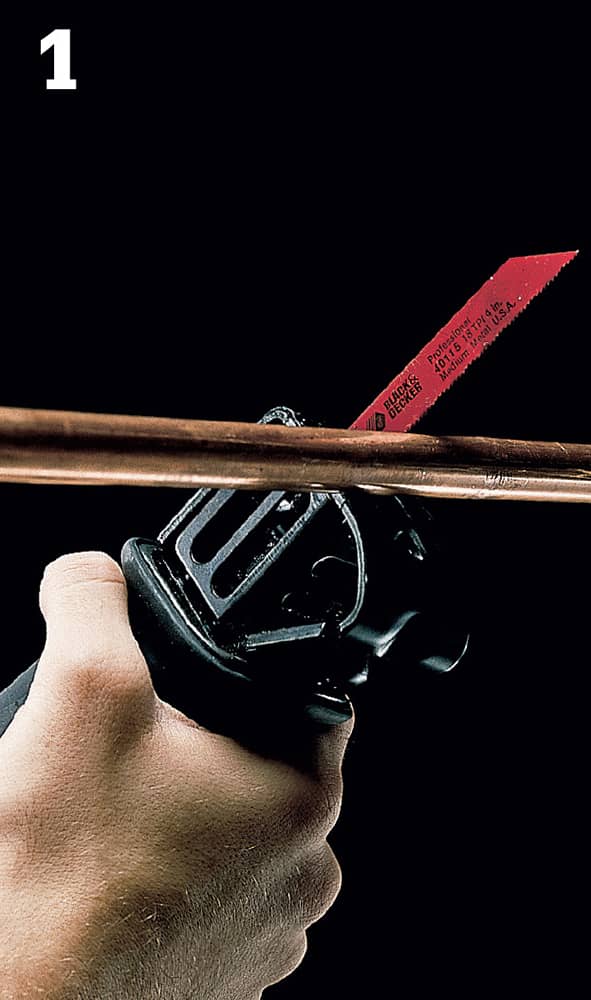
Shut off the water supply and drain the pipes. Use a tubing cutter or reciprocating saw to cut out a section of horizontal pipe long enough for a tee fitting.
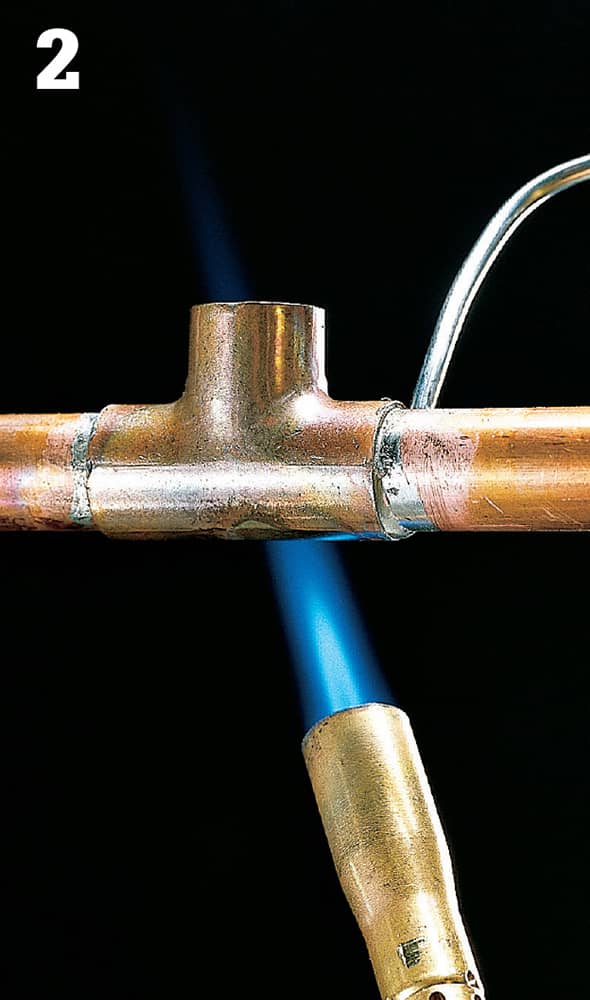
Install a threaded fitting. Use a fitting recommended by the manufacturer of your arrester.
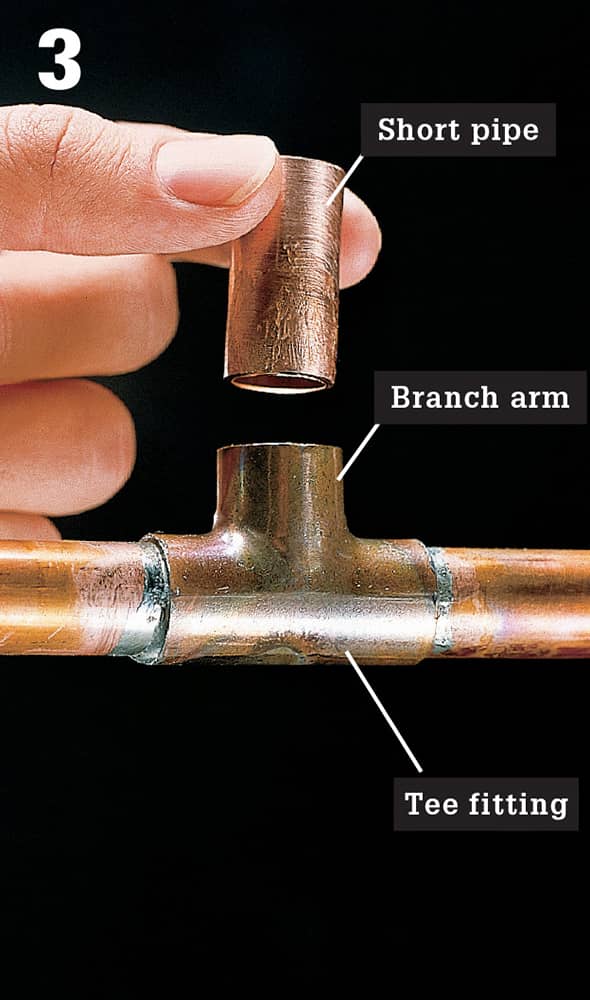
Install a short piece of pipe in the branch arm of the tee fitting. This short pipe will be used to attach a threaded fitting.
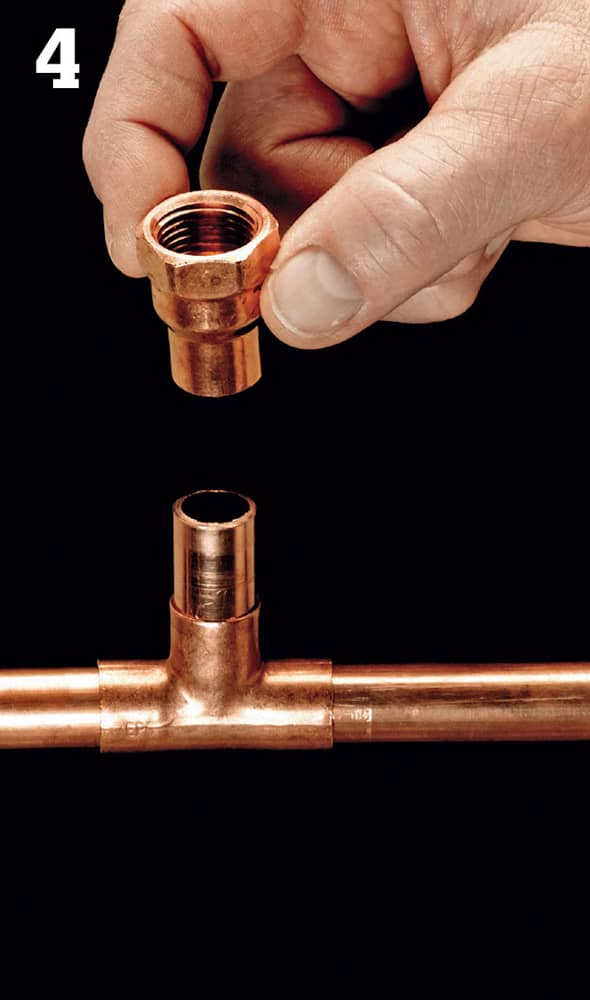
Install a tee fitting as close to the valve as possible.
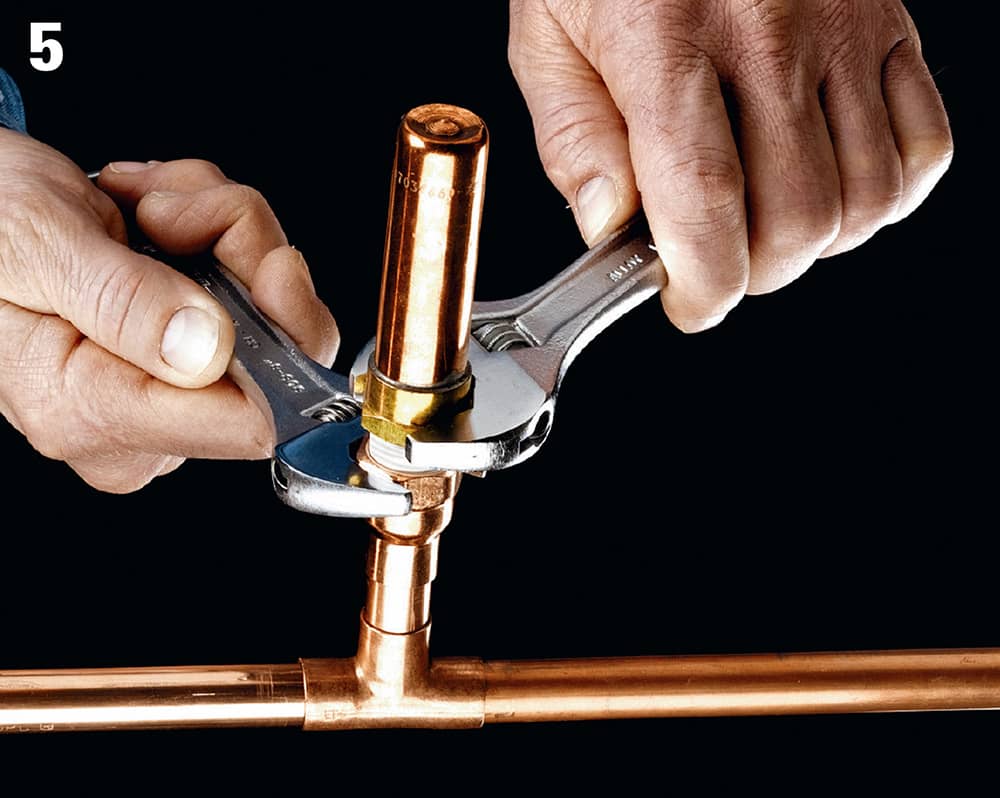
Wrap the threads of the arrester in Teflon tape. Thread the arrester onto the fitting by hand. Tighten by holding the fitting with one adjustable wrench and turning the arrester with the other. Do not overtighten. Turn the water on and check for leaks.

